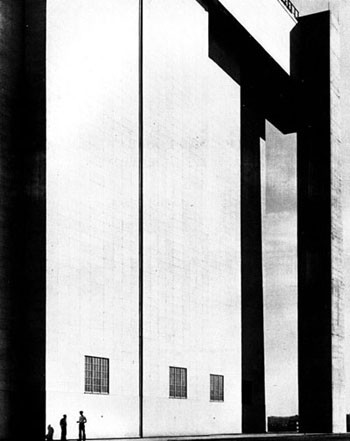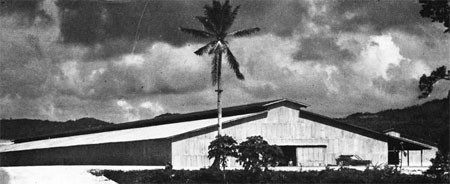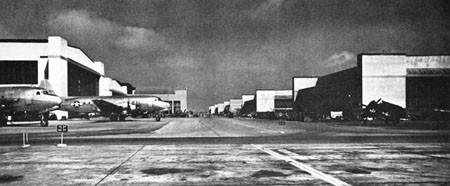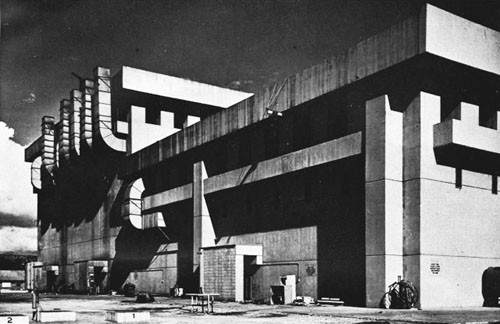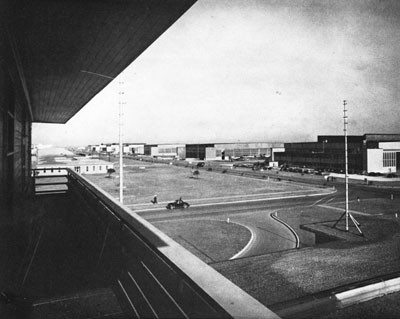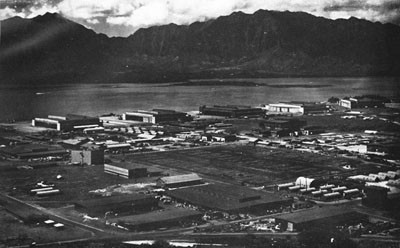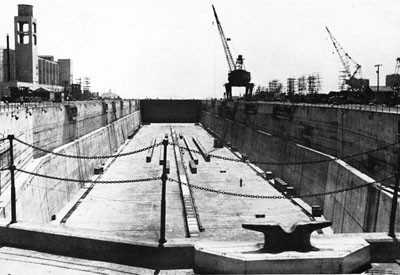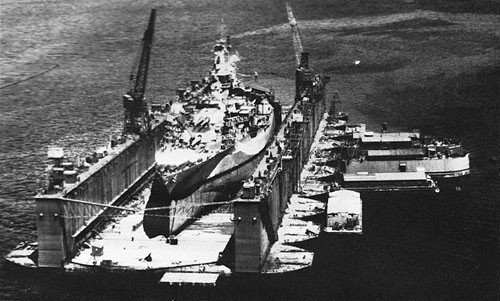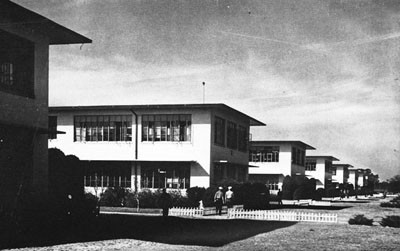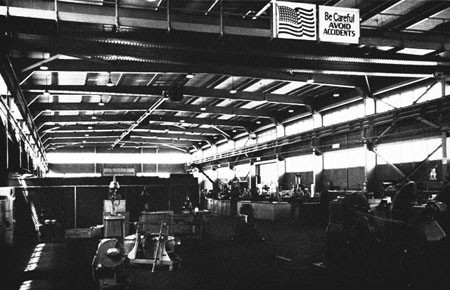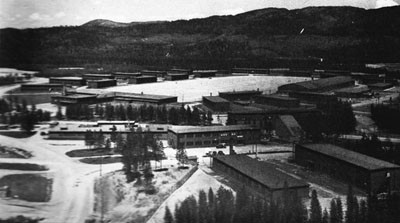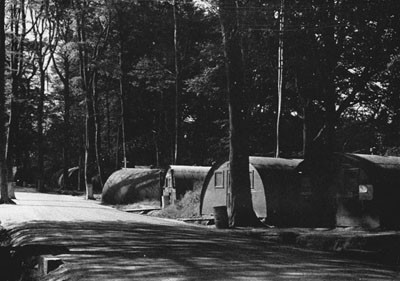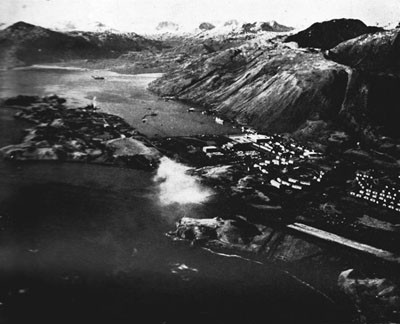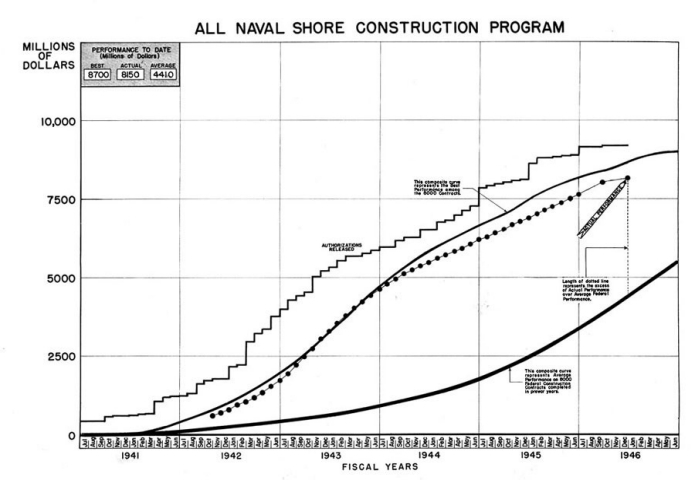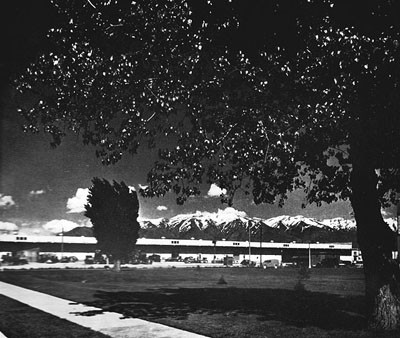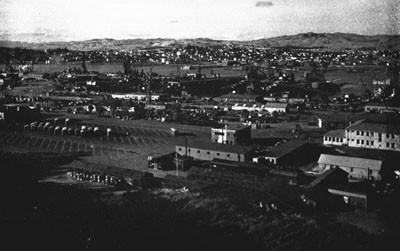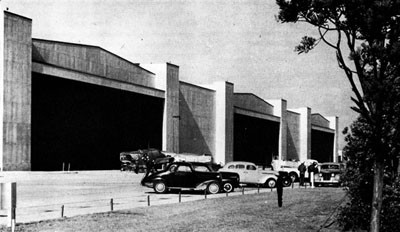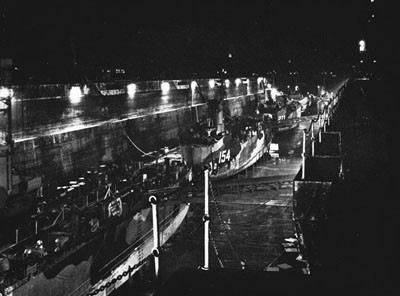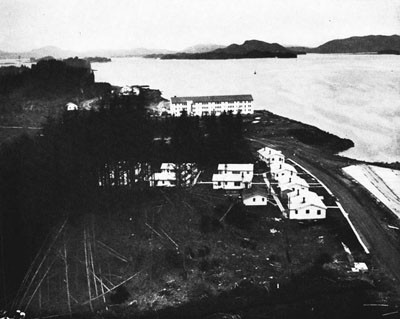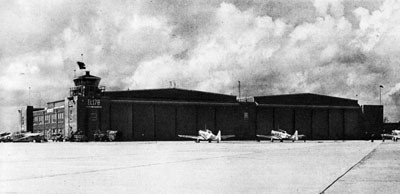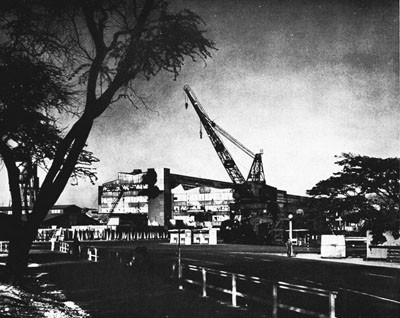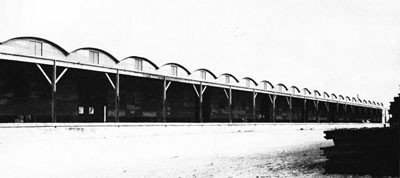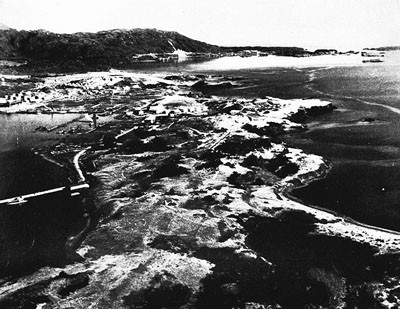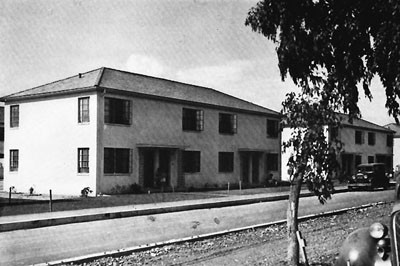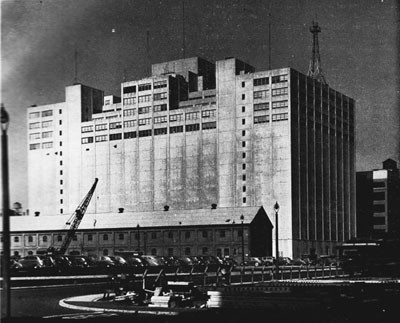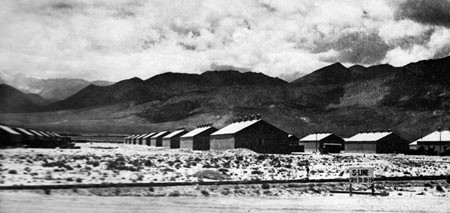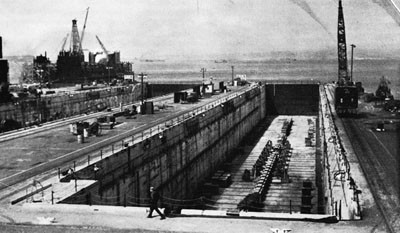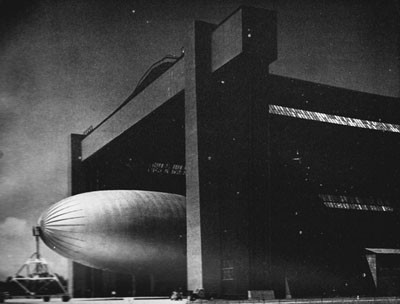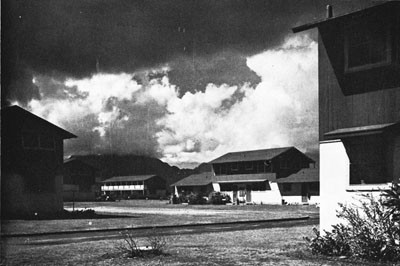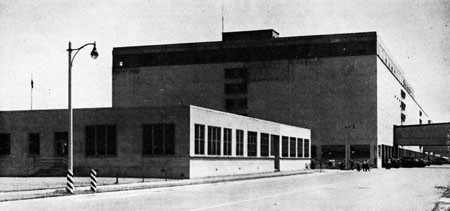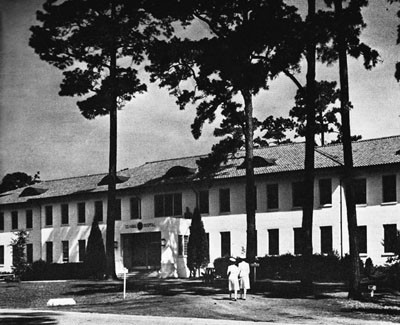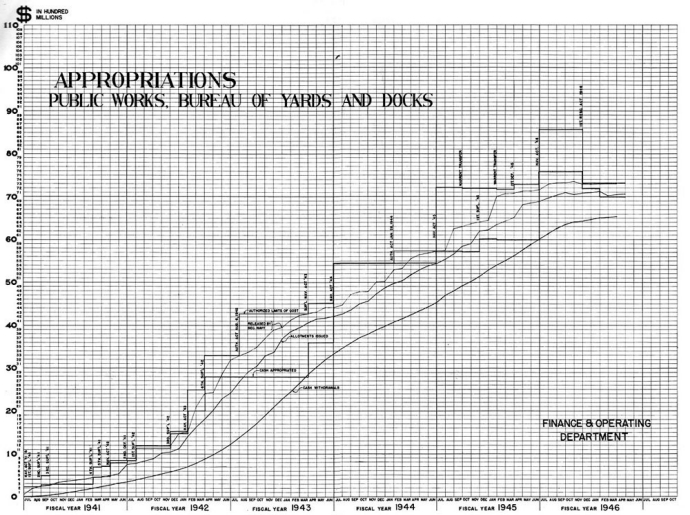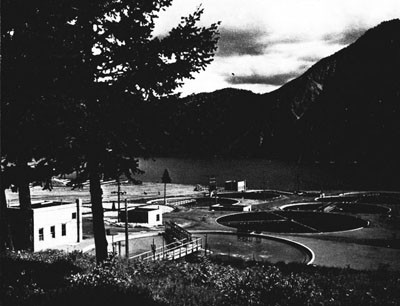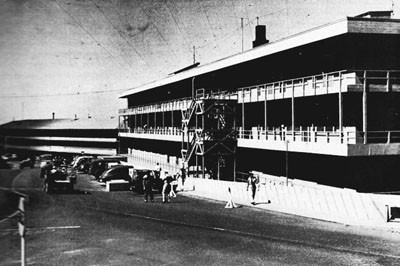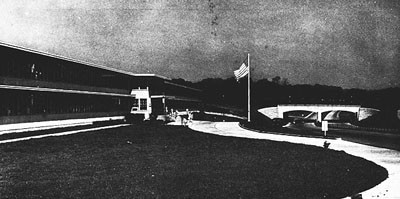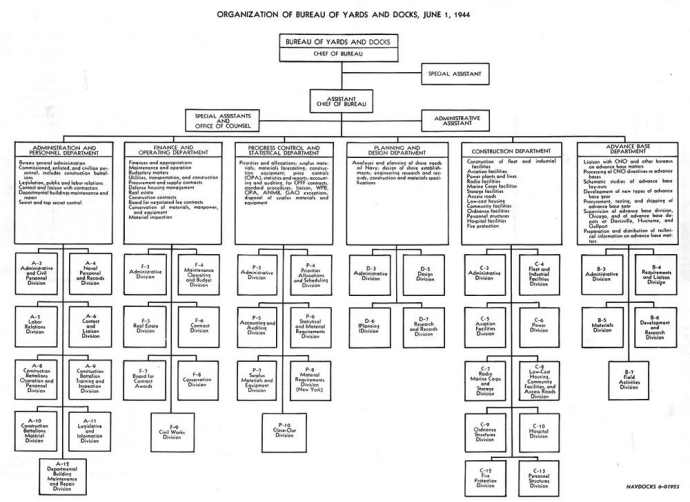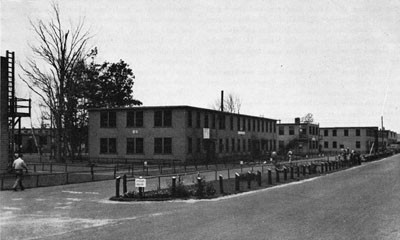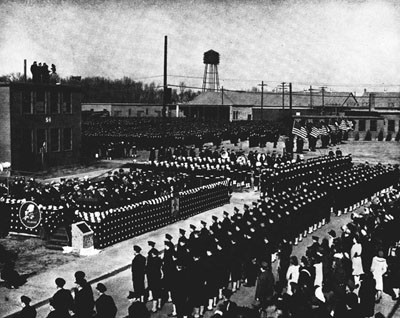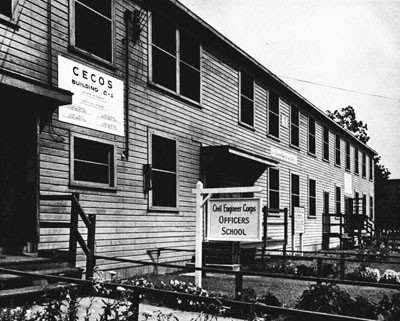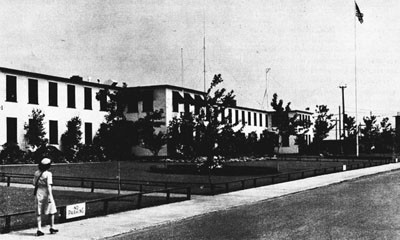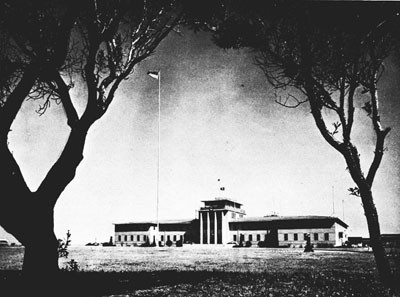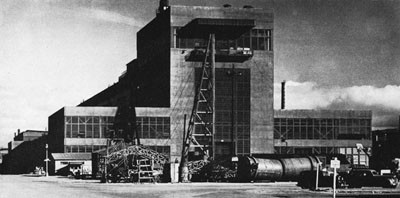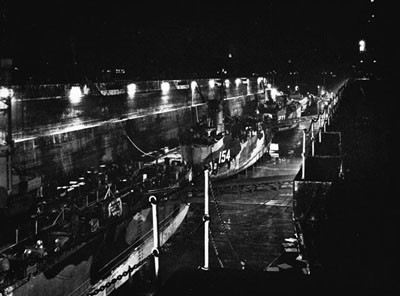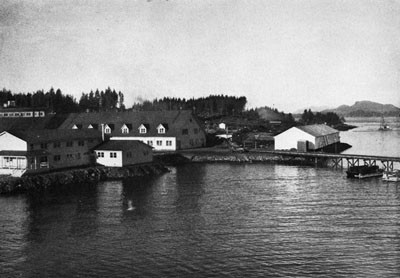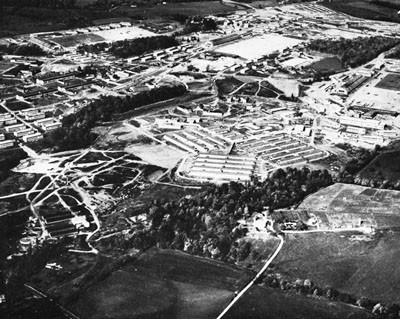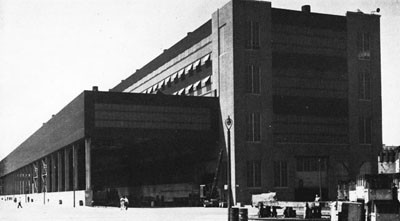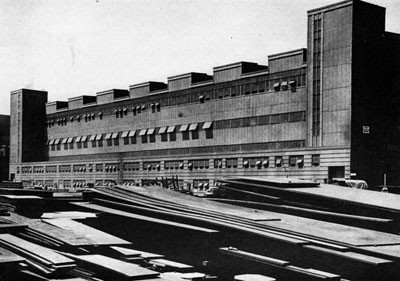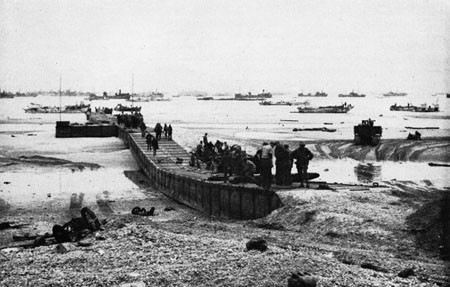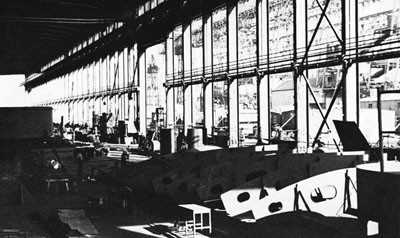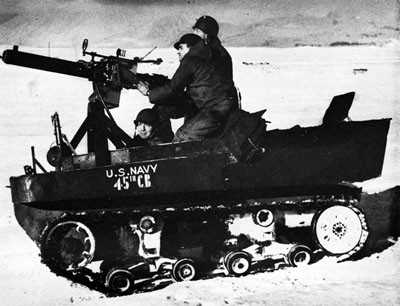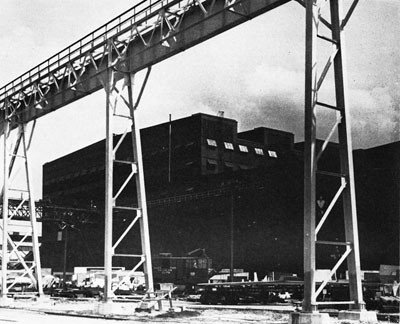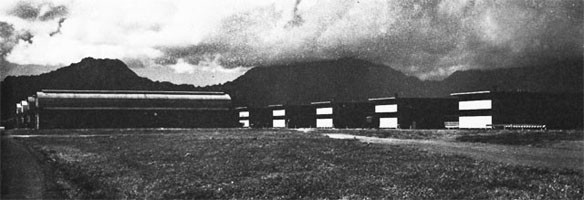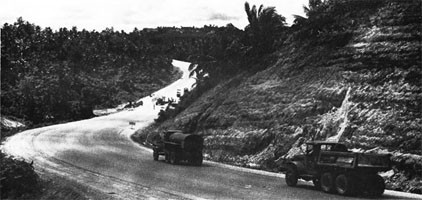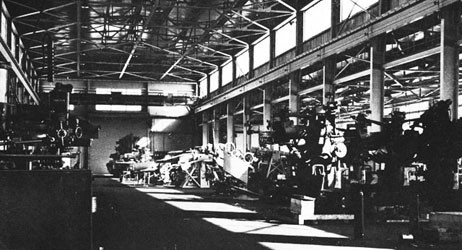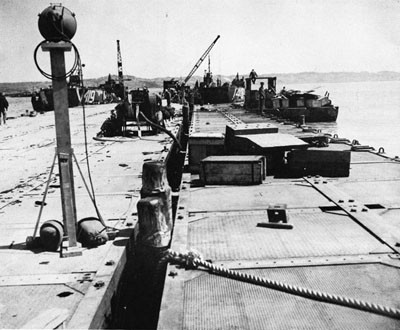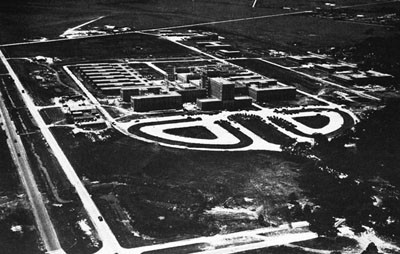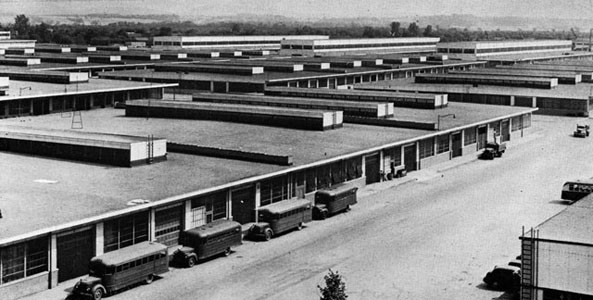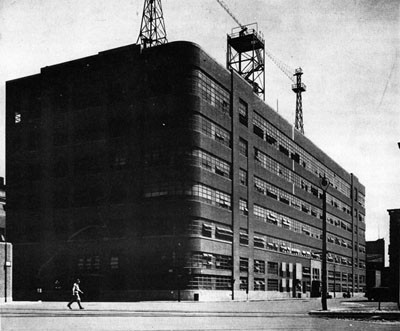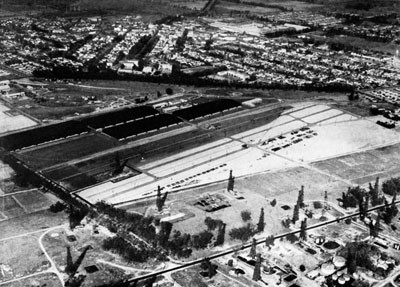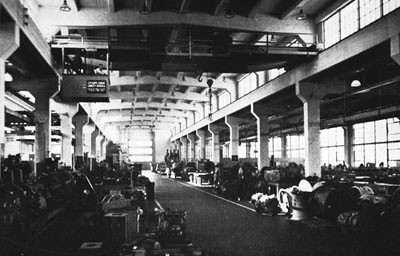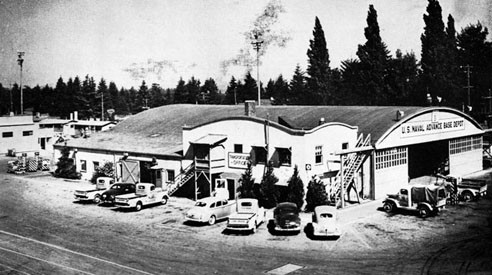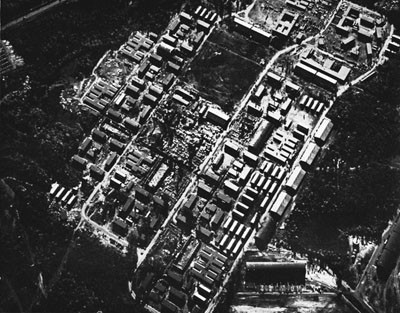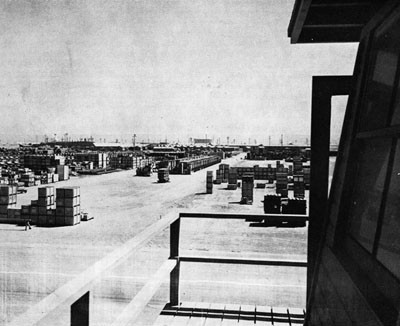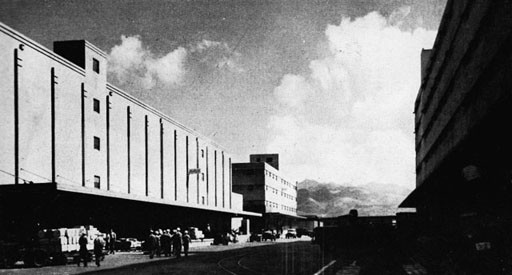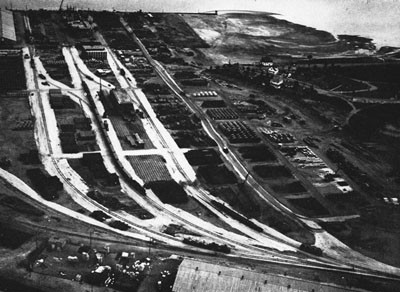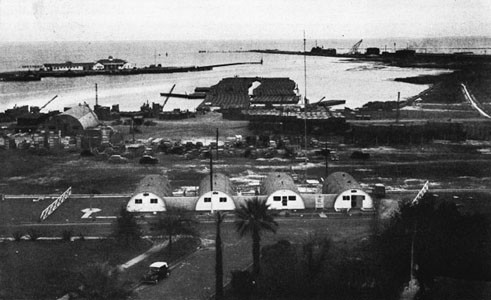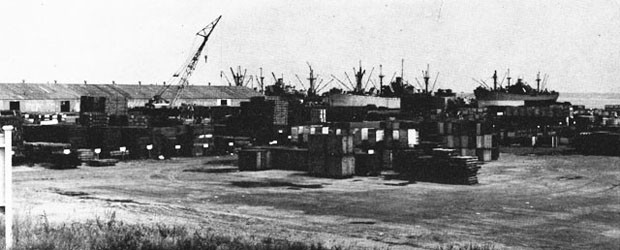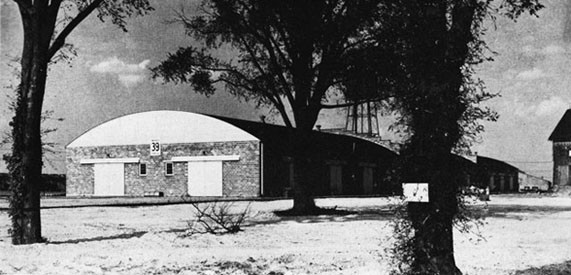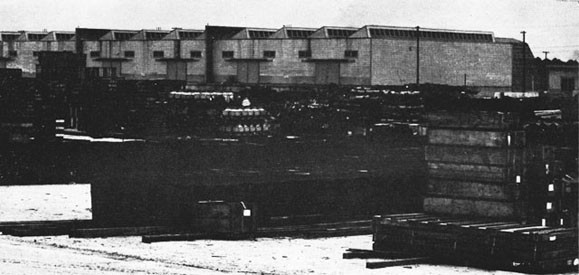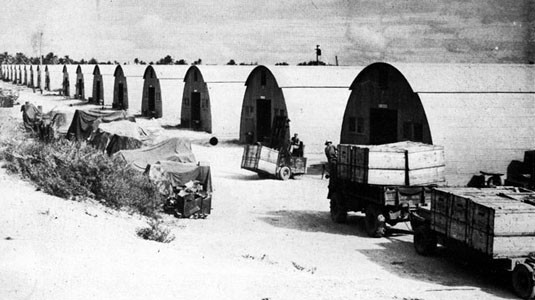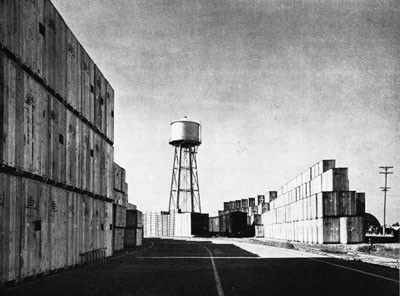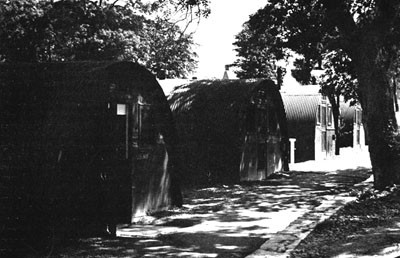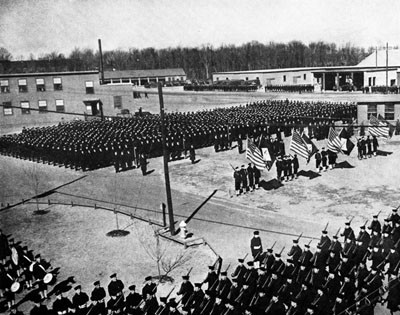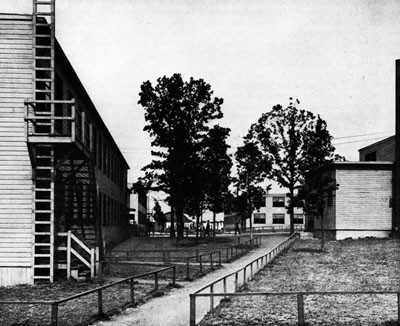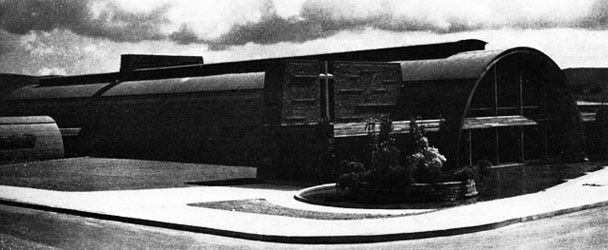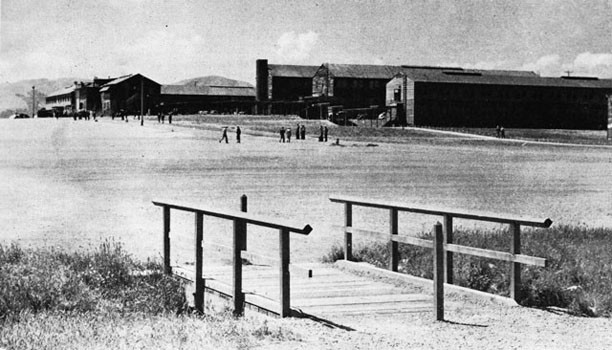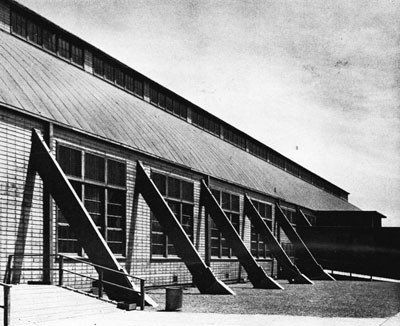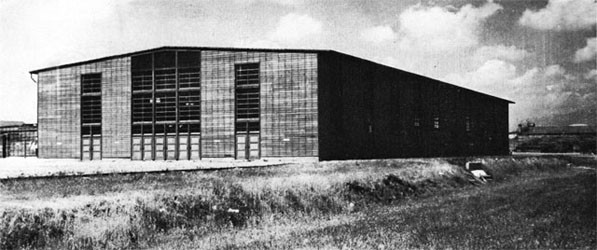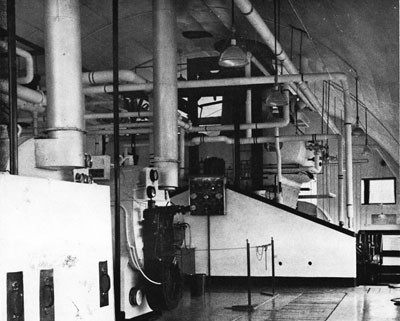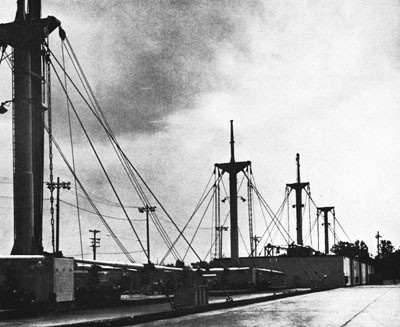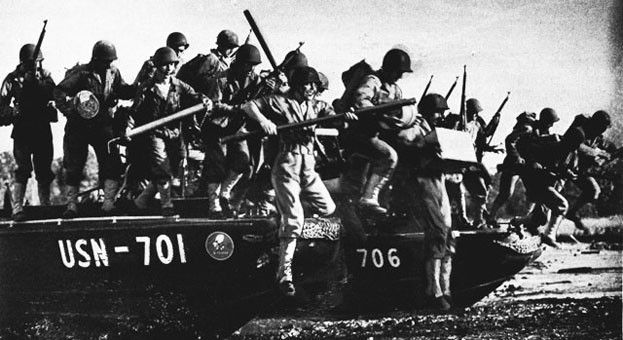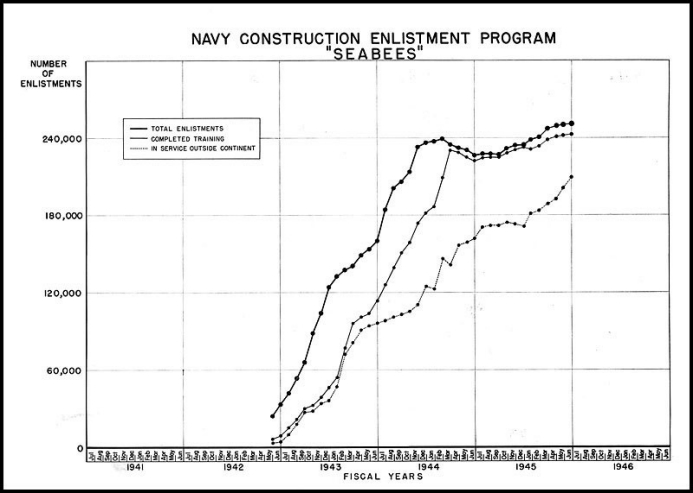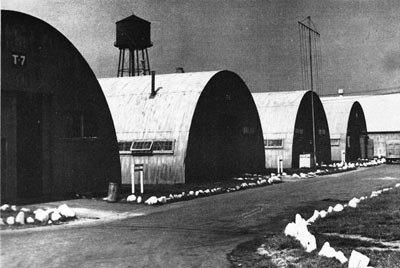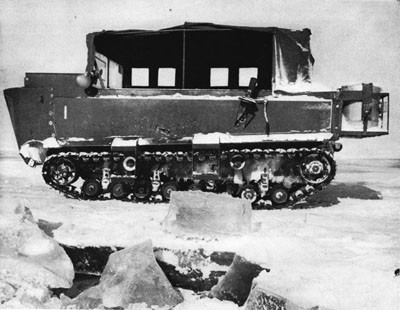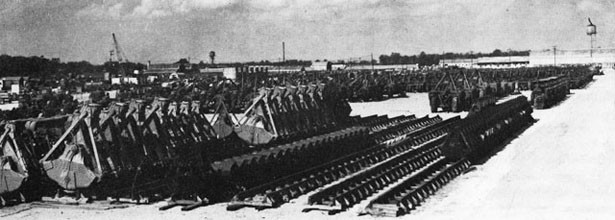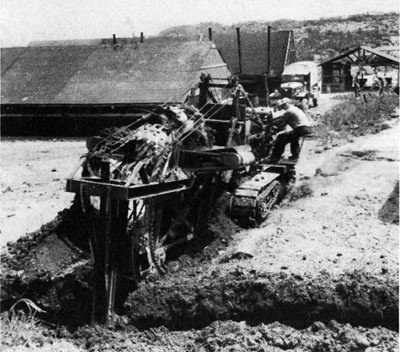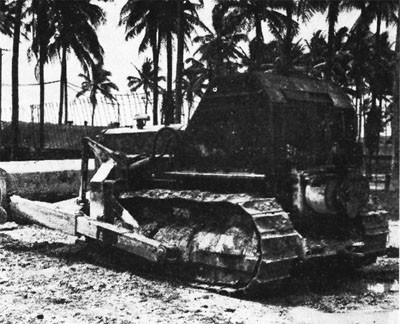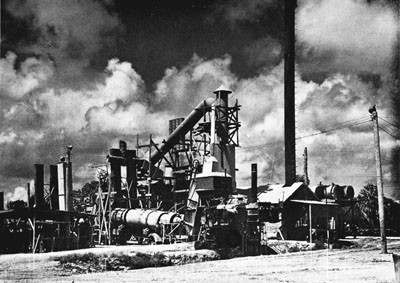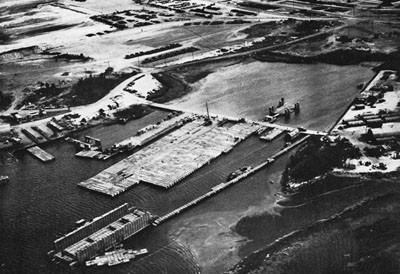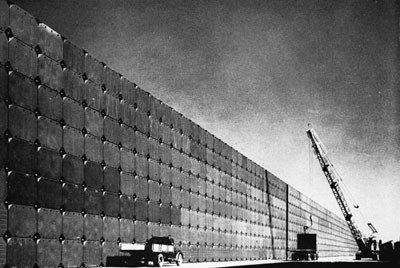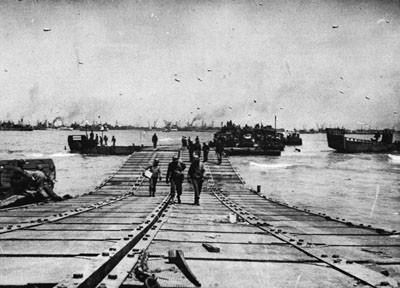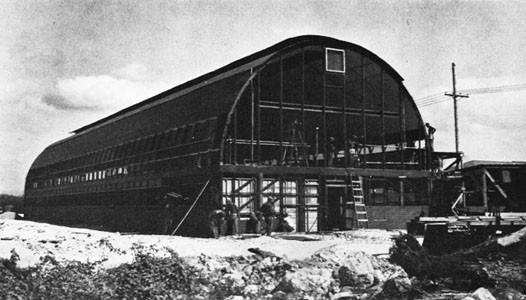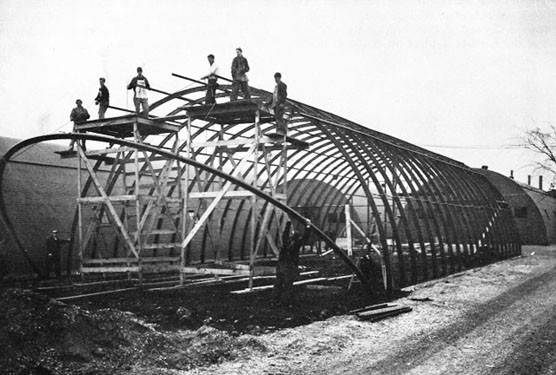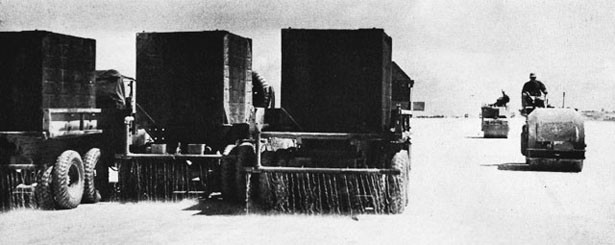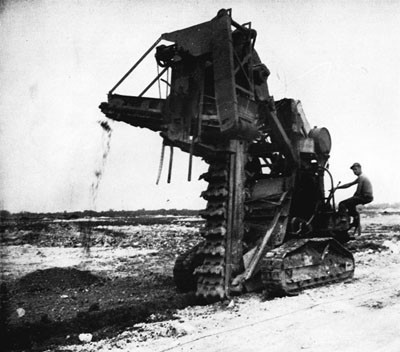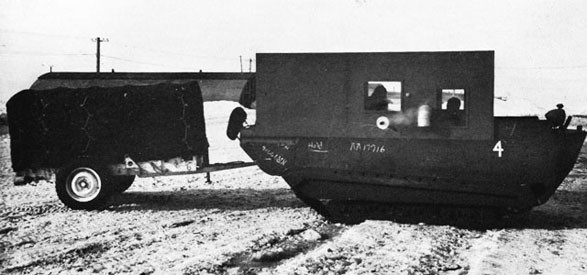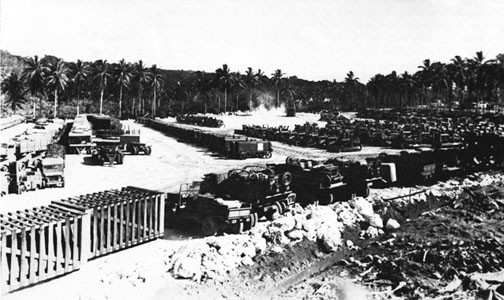United States. 1947. Building the Navy's bases in World War II; history of the Bureau of Yards and Docks and the Civil Engineer Corps, 1940-1946. Washington: U.S. Govt. Print. Off.

The Navy Department Library
Building the Navy's Bases in World War II
Volume I (Part I)
__________________________________________________
UNITED STATES GOVERNMENT PRINTING OFFICE
WASHINGTON
1947
________________________________________________
Navy Department
Washington
3 July 1946
My Dear Admiral,
The record of the Bureau of Yards and Docks and of the Civil Engineer Corps during the war years in
the expansion of the naval shore establishment in the United States and the building of advance bases
overseas which enabled our armed forces to carry the war to the enemy's home waters, by sea and air,
and to conquer him on his own soil, is one which your organization can well be proud.
When the Navy needed men who not only could build but also could take up arms and defend them-
selves and their installations, the Bureau organized the famous Seabees - construction workers, of-
ficered by construction experts and trained in comabt methods - whose motto 'Can Do' was brillantly
proven in action.
I am pleased to learn that the record of these accomplishements, whereby the Feet received support
in degree and kind unprecedented in the history of naval warfare, has been prepared for the information
of the country and for future reference.
James Forrestal
Secretary of the Navy
Rear Admiral John J. Manning (CEC) USN
Chief of the Bureau of Yards and Docks
Navy Department, Washington, D.C.
____________________________
Navy Department
Bureau of Yards and Docks
Washington 25, D.C.
14 June 1946
From: Chief of Bureau
To: Secretary of the Navy
Subj: Report on Activities, Bureau of Yards and Docks, World War II
In accordance with instructions, the accompanying historical report has been prepared, covering the activities of the Bureau of Yards and docks during World War II, as a matter of permanent record and for future guidance.
Since the Bureau's war program antedated the declaration of war, it has been deemed advisable to include a record of the pre-war status of the shore establishment and to narrate the events of the preparatory and national defense emergency periods preceding Pearl Harbor, as well as the activities during the war itself. Similarly, brief summaries of the demobilization period following the signing of surrender terms by Japan have been included to complete the record.
While the report is essentially a record of the work accomplished by the Bureau of Yards and Docks, the Corps of Engineers, the Construction Battalions -- popularly known as the 'Seabees' --, and the many civilian employees, engineering firms and contractors associated with the Bureau's program in futherance of this country's war effort, endeavor has been made to correlate these activities with the broad sequence of events and with the policies and decisions which were the basis for each successive course of action.
Acknowledgement is due the many individuals -- officers, enlisted personnel, and civilian employees -- who have contributed in varying degrees to the compilation and preparation of this report. Individual credit is deemed impracticable because of the large number concerned.
J.J. Manning,
Rear Admiral, (CEC) USN, Chief of Bureau
__________________________________________________
Foreward
World War II was by far the greatest military cataclysm in the history of the world. In the number of men involved, in its demands on the resources of the world, in the scientific and techincal progress it forced, in its three-dimensional scope over the entire globe, and in the intensity of the fighting and savagery toward non-combatants, it was unparalleled.
Victory by the United Nations was achieved only through the consecrated effort of many people, striving with singleness of purpose in many diverse fields of endeavor and in many lands, from the combat heroes to the lowliest worker on the home front.
The United States played a major role in checking and finally subduing the Axis powers after aggresive preparation, initial surprise, and an offensive untrammelled by regard for the accepted rules of warfare had given them a staggering advantage.
The history of the navy's participation in this struggle is in itself a complex of many parts, beginning well before the attack on Pearl Harbor and continuing after the signing of surrender terms in Tokyo Bay. Each part in turn was a colossal and complicated effort, surpassing any standard which had been visualized as possible before the insatiate demands of the war forced its accomplishments.
The record of the Bureau of Yards and Docks, the Corps of Engineers, and the Seabees in this conflict is the story of a small component of the Navy which had a specific mission in support of the Fleet, and which met the challenge of that mission by quick initial action, by meteoric expansion, and by creation of the new means and measures to achieve its objectives. Above all, it had the will and the capacity to get things done.
These accomplishments are recounted as factually and as comprehensively as possible in this History. An effort has been made to correlate the sequence of action by the Bureau with the basic events and major decisions which guided the course of the war effort as a whole.
Manifestly, it has been impossible to describe every particular project in detail or to cover all the features and problems of this vast undertaking without omissions. The work has required painstaking effort on the part of the Historical Division of the Bureau, and the assistance of many individuals -- officers, enlisted personnel, and civilians -- who contributed information, statistics, photographs, and manuscript and cooperated in the preparation of the final text.
It was apparent from the start that it would be impracticable to give credit by name to all the individuals, both within and without the service, who merited recognition for their contribution to the successful accomplishement of the Bureau's war task. Purposely, therefore, the history has been kept as impersonal as possible, and has been made a record of the team work, achieved under the inspiring leadership of Admiral Ben Morcell, (CEC) USN, wartime Chief of the Bureau of Yards and Docks, rather than a citation of individual achievements.
When the average citizen thinks of the Navy, his first thought is of ships and airplanes - and, more especially, of war ships and war planes. The tremendous industrial and administrative plant of the Navy which supports those ships and planes is rarely seen in its true perspective. But a modern navy would soon be unable to put to sea were it not for the activities of its shore facilities, and the effective cruising range of the fleet is in large measure determined by the efficiency and location of its bases of operation.
Behind the fleet and vitally necessary for its continued operation is a great variety of shore establishments. Ships are built or repaired and are given periodic overhauls in the navy yards. Training stations, receiving stations, and other personnel facilities provide for the training and housing of naval personnel when it is not actually at sea. Supply depots located at strategic points and in connection with other facilities provide the procurement, storage, and distribution of all kinds of supplies, food, and clothing. Guns, ammunition, and other types of ordnance material are manufactured, stored, and distributed by gun factories, ammunition plants, and depots. Naval air training stations and air stations train flight personnel and serve as operating and maintenance bases for the air arm. The sick, injured, and wounded are cared for in hospitals and dispensaries. Numerous radio stations provide the communications that link the operating units together.
The operating bases of the fleet bring together all or most of these various functions in one location, where anchorage or mooring facilities make possible the gathering of numbers of ships. It is in such bases that the fleet makes its home and from which it operates. There it can refuel and revictual and make necessary repairs and overhaul. Air bases perform a similar function for aircraft. As such, the location and capacities of fleet and air bases are as important to the strategy of the Navy as are the number and type of ships. Furthermore, the balance between shore facilities and the fleet must be maintained if the fleet is to have the support necessary to enable it to carry out its mission.
During World War II the Navy Department was organized in general along functional lines, with the various bureaus having jurisdiction over various activities and with the office of the Chief of Naval Operations directing the employment of the forces afloat and coordinating the work of the various bureaus as they contributed to that end. The place of the Bureau of Yards and Docks within this framework was defined by Admiral Ben Moreell (CEC) USN, its wartime Chief, as follows:
Primarily the function of the Bureau of Yards and Docks in the Naval Organization is to design and construct all public works and public utilities of the shore establishment, and to maintain and repair the larger part of such works. There are a number of corollaries to such duties, such, for example, as surveys for new stations; investigations for foundation conditions; development of new types of structures peculiarly adapted to the naval service; researches on materials; and, most important, analysis of the capacities of existing naval establishments and the requirements for additions to those establishments.
I would like to emphasize that the officers of the Civil Engineer Corps, who administer the work of the Bureau of Yards and Docks and its field activities, are not strategists; we are not tacticians; we are engineers, planners, estimators, constructors and analysts of shore facilities.1.
In carrying out these duties it devolved upon the Bureau of Yards and Docks, during the period of naval expansion in the late 1930's and during our actual participation in the war, to construct naval public works worth more than $9,000,000,000 both within the continental limits of the United States and at advance bases. This history is the story of how that money was spent and of the organization that carried out this enormous task. The outstanding record of the Bureau in the expansion of the Navy's shore establishment was an indispensable contribution to building the Navy into the greatest sea power in the world; the remarkable achievements
____________________
1. Public Works Authorization Bill, H.R. Com. on Naval Affairs, 76 Cong., 1st Session - 2 February 1939. Hearings, p. 290-291.
--1--
of the Seabees in building and developing advance bases to support the operations of our fleets were a basic factor in bringing the war, especially against Japan, to an early and successful conclusion. Part II of this history discusses the details of construction at the continental shore establishment; Part III tells the story of advance base development by the Seabees.
As an introduction to the story of the expansion of the Navy's shore establishment during the war period it is important to review the methods by which that establishment was planned as well as to review the story of the actual construction of projects. It is also of value to outline the steps that were taken prior to our actual entry into the war to prepare for that eventuality. A navy cannot be created or radically expanded on short notice. Except under the most emergent conditions several years are required
--2--
for the planning and construction of war ships and aircraft, and the actual construction must often be preceded by the construction of manufacturing facilities. In this process, the direct responsibility for determining the program of public works for World War II lay with the various bureaus and with the Chief of Naval Operations. The Bureau of Yards and Docks performed the actual construction of shore facilities. However, in its role of analyst and technical advisor, the Bureau could, and did, exert considerable influence upon plans for public works.
In peace time, the planning of public works had been seriously restricted by budgetary limitations, with a constant backlog of projects carried over from year to year. Each year, the Chief of Naval Operations drew up an estimate of the situation, which outlined the general plan of operation for the coming year. On the basis of this estimate each bureau prepared plans for its activities. Within these plans, public works originated in two ways; either the officers in charge of the Navy's various facilities in the field submitted plans for new projects in their facility, or the chiefs of bureau, cognizant of those activities, planned projects and then directed the officer in the field to make on-the-ground studies and proposals. In either case the project was routed through the commandant of the naval district where it was located. In each naval district, there was a local Shore Station Development Board, composed of the commandant of the district and representatives from each naval activity in the district. The local boards correlated the various projects within the needs of the district itself and submitted the approved projects to the Chief of Naval Operations.
From the various bureaus the projects went to the Bureau of Yards and Docks, which prepared cost estimates and analyzed the projects from a technical viewpoint as to adequacy and relation to other facilities. The next step was a consideration by the Shore Station Development Board of all the projects that had been submitted. The Board then set up a master priority list, giving each project a position relative to its overall importance. A large number of projects, inevitably, were carried over from one year to the next, but new ones were constantly added and the order changed to meet changing needs. On the basis of budgetary estimates, projects were selected from this list by hearings before the Navy's budget officer. The projects then had to be passed on by the Bureau of the Budget and the naval affairs committees of both the House and the Senate before they were authorized. Having achieved this status the projects became eligible for consideration in the budget for the coming year, and each was given fresh consideration for a position on the master priority list. Again it was considered by the Navy's budget officer, the Secretary of the Navy, the Bureau of the Budget, and the committees on appropriation of the House and the Senate before funds were appropriated. At the least, this process required eighteen months, and it was necessary in every major project.
The Shore Station Development Board was established in 1916, with the dual purpose of coordinating the public works programs of the various bureaus and of making general long-range plans to guide the development of the shore establishment. With expenditures for public works held to a minimum, there was a tendency to consider only those needs which were urgent and immediate, and it seemed useless to anticipate anything further, as the prospect of obtaining the necessary approval and funds seemed remote. In 1934, upon passage of the Vinson-Trammell Act to build the fleet up to the limits prescribed by the Washington and London treaties, the Board was reconstituted to consist of a member from each of the bureaus and from the Office of Naval Operations. In view of the newly authorized increase in strength, a set of general priorities was established for future building. The West Coast, Canal Zone, the Hawaiian Islands, the Philippine Islands, and Guam were given an "A" classification; New York, Boston, Philadelphia, and the Chesapeake areas were given "B" rating; under "C" came Key West, Guantanamo, Pensacola, and Charleston; "D" was applied to Great Lakes, Alaska, and Samoa. These classifications were never followed completely, but they furnished a guide and pattern for the work of the Board.
The first major expansion of the Navy after the first World War was authorized two months after Hitler overran Austria, by the Vinson Bill of May 17, 1938, which provided for an increase of 20 percent in ships and an increase of the Navy's aircraft strength to 3,000 planes. Because of testimony presented at the hearings on the bill, that the existing naval air facilities would not accommodate this increase, a section was added to the bill directing
--3--
the Secretary of the Navy to appoint a board, consisting of not less than five officers, "to investigate and report upon the need, for purposes of national defense, for the establishment of additional submarine, destroyer, mine and naval air bases on the coasts of the United States, its territories and possessions." 2 The report of the board was to be given to the Speaker of the House of Representatives during the first session of the following Congress.
The Hepburn Board. - On June 7, 1938, acting Secretary of the Navy Charles Edison appointed a board consisting of Rear Admiral Arthur J. Hepburn, Commandant of the Twelfth Naval District, as senior member, and Rear Admiral Edward J. Marquart, Captain James S. Woods, Captain Arthur L. Bristol, Jr., Captain Ralph Whitman, C.E.C., as members, with Lieutenant Commander William E. Hilbert as recorder.
The board, which became known as the Hepburn Board, made an exhaustive survey of the strategic needs in connection with the naval defense of the United States and of existing facilities for meeting those needs. In an outstanding report submitted to Congress on December 27, 1938, the board recommended the establishment of new air bases and the expansion of existing bases to provide three major air bases on each coast, one in the Canal Zone, and one in Hawaii; with outlying operating bases in the West Indies, Alaska, and our Pacific island possessions. The board also recommended that the naval air training station at Pensacola be greatly enlarged and that possibly an additional air training station be established at Corpus Christi, Texas; new submarine bases be established in Alaska and the mid-Pacific area, and several existing stations be improved or retained. Some additional facilities were suggested for the existing destroyer bases at Philadelphia and San Diego. No new mine bases were considered necessary, but certain deficiencies were noted in existing bases. A general priority schedule was set up, based on the necessity for providing facilities when the ships and aircraft authorized by the Vinson bill would be completed. In addition, there was a list of projects, considered to be of immediate strategic importance, which should be undertaken at the earliest practicable date. These items were: (1) improvement of air facilities at Kaneohe Bay, Hawaii; (2) submarine and air bases at Wake Island, Midway Island, and Guam; (3) air facilities at Johnston Island and Palmyra Island; (4) air and submarine bases at Kodiak and Sitka; (5) air and submarine facilities at San Juan, Puerto Rico.3
In making its studies and formulating its report the Hepburn Board drew upon the great mass of plans and projects that had been developed by the various bureaus of the Navy as being desirable. As Admiral Hepburn testified at the Congressional hearings on his report, "I would say that every item that the board has suggested has been considered in the past some time by one department or another or by the Joint Board involved, and they have been put down as projects to be attained when they can get the money."4 The board performed an invaluable service in taking all these proposals and, within the framework of definite strategic necessities and available facilities, formulating a comprehensive and coordinated plan for development, especially in the field of aircraft.
Although the estimated cost of the program set up by the Hepburn Board report was $326,216,000, the first request for authorization from Congress to initiate the program was for $65,000,000 to cover a three-year program. However, events were moving rapidly, and by the time this program was well under way it had been overshadowed by the need for even greater and more expensive developments. In the general defense program that was to begin a year later, practically all the board's recommendations, except those relating to Guam, were carried out and contributed materially to our position when war actually developed.
Yards and Docks "Bible". - The Vinson-Trammell treaty-strength bill of 1934 and the Vinson 20 percent increase bill of 1938 had provided merely for increases in ships and aircraft, and, aside from a few minor items for replacement of tools and equipment, there was no corresponding increase in our shore facilities. It had been repeatedly called to the attention of Congress that the shore establishment was lagging behind the fleet and, especially with the projected increases, there was real danger that the efficiency of the forces afloat would be impaired by the lack of necessary shore facilities. Although additional funds were being voted for new ships, little was being granted for expansion of the shore facilities which would carry
____________________
2. Public Law No. 528, 75th Congress, 3rd Session, Sec. 10.
3. Report of Hepburn Board, H.R. Document No. 65, 76th Congress, 1st Session.
4. Public Works Authorization Act. H.R. Committee on Naval Affairs Hearings, 76th Congress, 1st Session, 26 January 1939, p. 94.
--4--
on the ship building and maintain the ships when they were built.
On October 31, 1938, Admiral Moreell addressed a memorandum to all project managers and heads of divisions within the Bureau of Yards and Docks, requesting each one to initiate a study within his field and prepare a tabulation of (a) facilities required to bring the establishment up-to-date to meet current needs, and (b) additional facilities necessary to meet the requirements of the ultimate "Vinson Navy." This study, completed on January 1, 1939, became known to the officers in the Bureau as the "BuDocks Bible." It listed additional projects to the extent of $191,095,100 as necessary to meet current needs and a further $138,970,700 to meet the needs of the increases called for in the Vinson Act, for a total of $330,065,000.
The Hepburn Board had recommended the establishment of more than $225,000,000 worth of new bases and about $100,000,000 for expanding the existing air, destroyer, and submarine bases, and mine depots. In these fields, the "Yards and Docks Bible" stipulated approximately $32,000,000. On the other hand, about $145,000,000, or 40 percent of the Yards and Docks program represented needed expansion of the shipbuilding facilities of the industrial navy yards. The Yards and Docks Bible reflected the type of planning that is primarily concerned with the correlation of requests and recommendations originating from the field and from within the various bureaus, always with the problem of a limited budget in mind. With the Hepburn Board report, however, strategic considerations held first place, and it was not bound by the same budgetary limitations.
Shore Station Development Board Reorganization. - In Europe, the war had broken out, and it was obvious that further expansion was in order for the Navy and, whether or not we became involved, there would be a great increase in naval activity. Looking ahead to these problems, Admiral Moreell, on September 28, 1939, addressed a memorandum
--5--
to the Secretary of the Navy, setting forth the problem and pointing out that the existing system of planning developments according to the master priority list was not adequate to meet the current expansion program. The memorandum proposed:
In order to obtain more expert and thorough consideration of development plans and to expedite procedure so that the plans will always be up-to-date and in conformity with the war plans and the current needs of the Navy, a new organization and procedure for the Shore Station Development Board is herein proposed. The basic function of the Development Board is to establish a program which will meet the strategic needs of the Navy, which provides for facilities adequate to accomplish the purpose intended, and which is entirely practicable from the engineering viewpoint. These three main requirements can be designated as (a) strategic, (b) utilitarian, and (c) engineering. To assure the fulfillment of these objectives, the Development Board would consist of three members, a representative of Operations, a representative of the Shore Establishments Division, and a representative of the Bureau of Yards and Docks. These three would compose the permanent full-time Board. When the development program for works coming under the cognizance of a specific Bureau or office is being considered (such, for example, as the Bureau of Medicine and Surgery), a representative of that Bureau would be designated as a "temporary" member of the Board, for that purpose only. Thus the Board would have the advantage of specialist knowledge on the matters under consideration.
By this procedure, there will be prepared a series of development programs for the various types of activities, each program standing on its own merit and representing the best thought as to the desirable future development of that particular activity. These individual programs would not be blended into one priority list as, by so doing, we bring into competition with each other projects which are so unlike as to preclude any basis of competition. For example, how can one compare the value to the Navy of improving the lighting facilities for study purposes at the Naval Academy with a project for a pipe and copper shop
--6--
at the Navy Yard, Pearl Harbor? That is what is being done under present procedure.
The primary purpose of a development plan and a master priority list is to serve as a basis for preparing the Public Works budgets and the authorization bills. I propose that we establish separate development plans for each of the various activities and that the items that are to be included in a Public Works Authorization Bill or in the Public Works budget be selected from those lists by a Board consisting of the Chief of Naval Operations, the Director of the Shore Establishments Division, the Budget Officer of the Navy Department, and the Chief of the Bureau of Yards and Docks, or their representatives. By this means, the Public Works Budget and the Authorization Bills can be prepared so as to carry forward the development of all shore activities, each in proper relation to the others.
By the proposed procedure we will be able to present an up-to-the-minute program for the development of any particular branch of the Navy and for the Navy as a whole and we will have a freedom of action not now obtained with a master priority list. If, after the Public Works budget has been submitted to the Bureau of the Budget, it becomes necessary to effect reductions, a reconsideration of the most effective distribution of available funds would be in order. This is much to be preferred over the present system of arbitrarily eliminating items from the bottom of the priority list.
These recommendations met with the approval of acting Secretary of the Navy Charles Edison, and on December 4, 1939, an order was issued, reorganizing the Shore Station Development Board and redefining its functions. Under the new plan the board was to consist of four permanent members; the Director, Naval Districts Division, Office of Naval Operations, as senior member, and one officer from the Shore Establishments Division, one from the War Plans Division of the Office of Naval Operations, and one from the Bureau of Yards and Docks. The secretary of the board was to be an officer detailed from the Naval Districts Division. In addition, when the program for any particular class of development was being considered, a representative of the sponsoring bureau or office would participate as a temporary member of the board. The permanent and temporary members of the board were to be designated by name by each of the bureaus and offices in order to achieve a continuity of membership.
The purpose of the board was defined thus:
The primary objective of the Shore Station Development Board shall be to plan for maintaining our shore stations in number, location, and equipment, adequate to support the fleet in a constant state of readiness for war, and for the service of the fleet should war come. It is essential, therefore, that the shore development shall be synchronized with the growth of the forces afloat and in the air and with the plans for the utilization of those forces in time of war or national emergency. As a corollary, the development of each "class" of activity should be in balance with that of all other classes, in order that the funds available for shore construction shall be expanded to the greatest advantage of the fleet. 5
There were also to be certain changes in procedure. Eleven classes of facilities were established, each with a corresponding sponsoring bureau or office. Each sponsor bureau or office was to prepare a tentative program for the class it sponsored, based on projects recommended by local development boards, current needs, and prospective needs, to parallel the prospective growth of the forces afloat, or in the air. Consideration should also be given to facilities which would be of vital importance in the early days of an emergency and could not be improvised quickly. From these tentative programs, the board would prepare a series of comprehensive programs, by classes. Instead of a master priority list the various programs would be consolidated into a master shore station development program. From this master program a board consisting of the Chief of Naval Operations, the Director of the Shore Establishment Division, the Senior Member of the Shore Station Development Board, the Chief of the Bureau of Yards and Docks, and the Director, War Plans Division, Office of Naval Operations, would select projects for inclusion in the public works budget or authorization bills.
Under this set-up, the principal responsibility for planning the public works program was divided among the Assistant Secretary of the Navy, in charge of the shore establishment; the Office of Naval Operations, which was responsible for the general operation of the fleet; and the Bureau of Yards and Docks, which was responsible for the actual construction of the shore establishment. The interests of the various bureaus were protected by their participation as temporary members and by the fact that they originated the tentative programs from which the master program was formulated.
Bureau War Plans. - In addition to the efforts on the part of the Bureau of Yards and Docks to develop and participate in some agency charged with the general overall planing for the development of the shore establishment, the Bureau was looking ahead within its own organization to develop plans for meeting the varied technical problems with which it would be faced in case of war. This was
____________________
5. Sec Nav letter to Director, Naval Districts Division, Office of Naval Operations, 4 December 1939.
--7--
especially true in the field of advance base construction. In the summer of 1939, studies were begun to develop mobile and standardized equipment that could be prepared in advance and moved rapidly to create a base. Much of the equipment which was contemplated by these plans was not currently available in the commercial market, and it was necessary for the Bureau to work out basic designs and specifications. Example of this work were the floating drydocks, pontoons, portable housing, portable power plants, stills for producing fresh water from sea water, and other equipment which made possible the rapid advance of our forces into the western Pacific. In cooperation with the other bureaus, also, the Bureau of Yards and Docks was developing plans for standardized structures such as barracks, warehouses, aircraft hangars, and ammunition magazines, which were to be of great value in facilitating the rapid expansion of the shore establishment.
The European war that had begun in September 1939 had flared into violent activity in the spring of 1940 with the invasion of Norway and Denmark, and then, in rapid succession, by the invasion of the Low Countries and the fall of France on June 22. The response of Congress had been immediate. An 11-percent increase in the Navy had been authorized on June 14, and immediately thereafter a bill was enacted creating a "two-ocean" Navy - involving a further increase of 70 percent in the forces afloat and bringing the aircraft program to 15,000 planes. At the same time, the regular Naval Appropriation Act for 1941, approved June 11, 1940, and the First Supplemental National Defense Appropriation Act for 1941, approved June 26, 1940, provided $97,640,362 and $202,654,000, respectively, for public works to expand the shore establishment. These steps constituted the beginning of the war program.
The public works budget for the fiscal year ending June 30, 1941 had been put together during the summer of 1939 and was based on the current master priority list. However, before it was presented to Congress, a number of projects based on the more immediate needs arising from the expansion program had been added. Since the regular budget had been prepared so long previously, supplementary appropriations were immediately prepared to get the defense program moving with the necessary rapidity. In preparing the First and Second Supplemental National Defense Appropriations, which were passed by Congress in rapid succession on June 26 and September 9, the Navy drew largely upon the master shore station development program for projects to be included; although it was also necessary to go beyond the list, especially in the field of aviation facilities, to meet newly arising demands. In large part, however, the expansion was based on plans for improvement and enlargement that had been developed by local stations during peace time and were not directly integrated into a general plan for expanding the Navy to meet the emergent conditions.
The Greenslade Board. - On August 9, 1940, Admiral Moreell, Chief of the Bureau of Yards and Docks, and Admiral C.W. Fisher, Director, Shore Establishments Division of the Office of Naval Operations, addressed a joint letter to the Secretary of the Navy in which they pointed out that the recent 81-percent increase in ships and 500 percent in planes must be paralled by corresponding increases in the shore establishment; an exhaustive study should be initiated to plan for this expansion in the light of lessons learned from the European war, such as necessity for dispersion of facilities, protection against bombing, etc. It was recommended that a special board be created to give full time to such a study, as the existing Shore Station Development Board was not organized to perform such a task.
The recommendation was accepted by the Secretary of the Navy, and on September 11, 1940, a Board to Survey and Report on the Adequacy and Future Development of the Naval Shore Establishment, consisting of seven officers, with Rear Admiral John W. Greenslade as senior member, was formed "to make a comprehensive study of the shore establishment (naval and commercial) necessary to support the Fleet in peace and war." Commander Kendal B. Bragg (CEC), who represented the Bureau of Yards and Docks on the board, was also the Bureau's representative on the Shore Station Development Board. The Greenslade Board was directed to recommend a program for each class of shore facilities and, so far as practicable, for commercial facilities as well. With the strategic requirements of the fleet in mind, the board was instructed to make recommendations for additional facilities in new locations and as to the expansion, limitation, contraction, abandonment, or conversion of existing shore facilities. The board's report was to include, "in general terms,
--8--
the fundamental characteristics, the size or capacity, and such other descriptive matter as will enable the Shore Station Development Board and other Departmental agencies concerned to prepare such plans and estimates as may be needed to effectuate the Board's recommendations." Attention was called to conditions that had changed since the Hepburn Board's report, among which were the acquisition of areas from Great Britain for use by the United States as naval bases, the international situation, the great increase in the authorized strength of the Navy and its air force, and the trends and developments in warfare.
The Greenslade Board requested plans from the various bureaus and offices of the Navy Department and considered this material from the standpoint of the naval requirements upon the completion of the 81-percent increase in 1946 and the strategic defense of the Western Hemisphere and of our position relative to the western Pacific. While it was engaged in this larger task, the board was given the specific task of recommending sites and facilities for the bases that had been acquired in British possessions as a result of the joint agreement of September 8, 1940. This special report was submitted on November 15, 1940 and proposed facilities that would cost a total of $315,000.000.
In its report, which was submitted to the Secretary of the Navy on January 6, 1941, the board presented in general terms the basic requirements of the shore establishment needed to support the expanded fleet contemplated for 1946. The capacity and fundamental characteristics of various activities were indicated, but the detailed plans were left to the permanent bureaus and offices. The outline for this expansion called for two main home bases on the East Coast in the New York-Boston area and the Delaware-Chesapeake-Charleston area - capable of supporting operations of a major portion of the Fleet; a main operating base capable of supporting a large portion of the Fleet in the Puerto Rico-Virgin Islands area, with a supporting base at Guantanamo, Cuba, and a subsidiary operating base at Trinidad, B.W.I.; with a
--9--
chain of outlying air and light forces bases in Newfoundland, Bermuda, Mayaguana in the Bahamas, Antigua, St. Lucia, and British Guiana. In the Pacific, the board recommended main bases in the Puget Sound area, San Francisco area, Hawaiian Islands, and the Philippines; a main training area at San Pedro-San Diego; a subsidiary operating base in the Canal Zone; and outlying air, submarine, and light forces bases at Unalaska, Kodiak, and Sitka, in Alaska; Samoa, Johnston, and Palmyra islands; and a subsidiary operating base at Guam. Also recommended was a chain of section bases for patrol craft on both coasts and in the Gulf of Mexico. The important differences in strategic plan between this report and the report of the Hepburn Board were that the Greenslade Board proposed a more definite extension of our Pacific frontier to the Philippines and urged that arrangements be made for the use of the British base at Singapore by our forces; in the Atlantic the acquisition of a base in Trinidad extended southward the range of the fleet operation and was of great importance in the enlarged concept of hemisphere defense. It should be noted that at this time, there was a real possibility that the Axis powers would seize French North Africa and establish themselves at Dakar.
As to the navy yards, it was proposed that each coast should have repair capacity sufficient to maintain sixty percent of the 1946 Fleet in peace on a single-shift basis. By operating two or three shifts, these facilities could be used to meet any sudden expansion of load. On the East Coast, naval repair capacity was considered adequate, and no further expansion was advocated except to create better-balanced facilities and, where required, to accomplish the heavy shipbuilding tasks that had been assigned. The West Coast was found to have capacity, both existing and projected, barely adequate to meet this requirement. However, since it would be imprudent to concentrate any more activities in limited areas, no further development of Mare
--10--
Island and Puget Sound navy yards, other than to balance existing facilities, was recommended. Instead, further developments were to be made at Pearl Harbor and in the San Pedro-San Diego area. In order to make repair facilities available in case of war, not more than twenty percent of the navy yard capacity was to be used for new shipbuilding. To make this possible, definite encouragement of commercial shipbuilding facilities, especially on the West Coast, was recommended. There were no specific recommendations as to the size or location of other facilities except that all non-industrial facilities be separated geographically from industrial facilities and that they be distributed as far as feasible in different parts of the country.
In commenting on the current expansion, the board gave its general approval, recognizing that the urgency of the need outweighed other considerations. It should be noted that the board was thinking in terms of the operation and maintenance of the projected 1946 fleet and was trying to integrate the facilities, such as shipbuilding, currently being used in the abnormally large construction program, with the more permanent situation that would exist after the program was complete. It was definitely not a plan for emergency wartime expansion, although, as it outlined a plan for the permanent organization of the shore establishment, it could be used as a valuable guide in the planning of the wartime program.
The report of the Greenslade Board was distributed among the various bureaus and offices of the Navy Department for study and comment. On the basis of these comments the Office of Naval Operations made some adjustments to bring the program up-to-date on the newly determined 15,000-plane program and on certain modifications with regard to the bases obtained from Britain. It was then approved by the Secretary of the Navy on May 14, 1941, and issued to the Department with the recommendation that it be used as a general guide by all naval shore facilities planning agencies.
--11--
National Defense Projects. - Most of the major projects in the 1940-41 expansion program that required new locations were started during 1940; the 1941 program consisted largely of expansion of existing facilities and completion of projects already initiated. In this period, the regular appropriation act went through the normal channels and, therefore, reflected the needs as they had been foreseen and planned at least a year previously. World events, however, were not constrained to such a schedule, and to keep abreast of the times it was necessary to accelerate the speed of expansion. Thus, from July 1, 1940, up to our entry into the war, a total of $175,000,000 was provided for public works by regular budgetary methods and about $915,000,000 was appropriated by emergency procedures. Of this latter figure, between one-third and one-half represented projects taken from the master shore-station development program and were essentially permanent additions to the shore establishment. The remainder were projects that were developed to meet the needs of the current expansion and were of a temporary character. While these were all passed upon by the Shore Station Development Board and were subject to further screening by the Navy's Budget Officer and the Bureau of the Budget, they were not an integral part of a general plan but were developed and presented by the various bureaus as their activities were expanded to meet the general increase.
The year and a half prior to Pearl Harbor had been a period of rapid transition from a peacetime to a war economy, and the Navy's public works program had to fit itself into the general picture. Upon passage of the Selective Service Act in 1940, the Army had had to build tremendous new facilities for training purposes. Orders for armament required industrial expansion and the creation of new industrial communities, with attendant housing and other facilities. This burden on the construction industry was accelerated after the passage of the Lend-Lease Act in March 1941. In planning
--12--
the Navy's public works program, the problem of competition for scarce facilities became increasingly important. In general, it became the duty of the Bureau of Yards and Docks to adjust the construction programs of the various bureaus to the amount and geographical distribution of materials and construction capacity. One of the major considerations in the scope of the program during this period was the anticipated availability of facilities for carrying the program through to completion within required time limits. Because of this planning, the actual involvement of this country in the war found the Navy's public works program well up to schedule and prepared for further and more extensive developments.
Prior to December 1941, the planning of public works by the Navy had as its goal the building of a shore establishment to meet the needs of the two-ocean Navy that had been authorized by Congress. This planning found its expression in the recommendations of the Hepburn Board and the Greenslade Board. In addition, there were two types of emergency projects. One included the provision of facilities that were necessary in order to carry out the expansion itself, such as increased shipbuilding and aircraft construction facilities, training facilities for the large number of new recruits, etc., that would not be needed once the program was complete and only replacements were necessary. The other type included facilities required by the war situation, and was represented by the additional section bases that were necessary to support the neutrality patrol, repair facilities for foreign shipping under Lend-Lease, etc. In planning the facilities for these emergency purposes, each bureau, each section of the Office of Naval Operations, each commandant of a naval district or sea frontier worked out the requirements for fulfilling the mission assigned to it by the Chief of Naval Operations.
Wartime Procedures
With the nation plunged into war by the attack on Pearl Harbor, a new type of situation developed. The time schedule for existing planned increases was speeded up to the limit, and at the same time the scope of the program was being doubled or tripled. The expansion of personnel facilities was an example. The enlisted strength of the Navy, which had been 125,000 on June 30, 1939, had been doubled by June 30, 1941, and a further increase to 369,000 was planned for June 30, 1942. Immediately after our entry into the war, however, this figure was increased to 1,000,000 and was to be raised steadily throughout the war. As many of the men involved in the previous increases were still in training, this further expansion called for a tremendous construction of personnel and training facilities. Having been given the task of procuring and training these men, it was the prime responsibility of the Bureau of Navigation (later the Bureau of Naval Personnel) to work out the facilities it would need to fulfill its mission and, in cooperation with the Bureau of Yards and Docks, decide such questions as whether to expand existing stations or to establish new ones, the type of specialized facilities necessary for trade schools, the location of new stations, etc.
Other bureaus would be involved to provide necessary services such as supply, medical dispensaries, etc. The Bureau of Yards and Docks was responsible for coordinating the needs of all participating bureaus in the general plan for the facility and for planning the necessary utilities - central heat, sewage disposal, etc. Then, upon approval by the proper authorities, the Bureau of Yards and Docks had charge of constructing the facility. A similar process was followed for facilities created for each bureau, as described in the following chapters of this history.
During the first months of the war, as the operating-force plan was being constantly revised upward, there was a vast scramble on the part of the Army, the Navy, and industry to obtain the facilities and materials that were necessary for each to carry out its program. It was found that unlimited money did not automatically create an adequate supply of vital materials or productive capacity. It is not the purpose of this chapter to show in detail the way this problem was solved, but it should be pointed out that the entire program of public works was subject to this limitation.
In the spring of 1942, because of the shrinking supply of many critical materials and the increasing difficulty in obtaining labor in the construction industry, the Bureau of Yards and Docks outlined a set of rules for new construction that was designed to conserve scarce materials and manpower. Much of this was later incorporated in a "Joint Directive on Wartime Construction," issued May 20, 1941 by the War Production Board, the Secretary of War, and the Secretary of the Navy. This
--13--
directive specified that buildings should be no more elaborate or extensive than was absolutely essential and that, insofar as possible, substitutes should be found for scarce materials. At the same time the Bureau issued a booklet entitled "A Message on Conservation," describing methods for utilizing substitutes and outlining efficient types of construction. Throughout the war, the Bureau carried on extensive research to develop effective substitutes and more efficient structures.
Shore Station Development Board suspended. - It had been expected, at the time it was reorganized in 1939, that the Shore Station Development Board would act as a general planning agency for naval public works, and in case of war would direct the necessary expansion. Such a function, however, would have required a full-time board and could not properly be handled by a part-time group which met briefly once or twice a week, the members of which were already heavily burdened with their regular duties. For this reason the board was limited to the consideration of individual projects which had already been developed to the point where any extensive modification would cause damaging delay. In view of these circumstances, the Secretary of the Navy on June 10, 1942 suspended the functions of the Shore Station Development Board and all local district development boards,6 and on June 25 established a new procedure for the handling of new projects as follows:
(a) Projects originating in the field shall be forwarded by the interested activity direct to the cognizant Bureau.
(b) If approved, the cognizant Bureau shall forward the project to the Vice Chief of Naval Operations, via the Bureau of Yards and Docks. Projects originating in the Bureaus will be similarly forwarded.
(c) The Bureau of Yards and Docks will obtain clearance from the Assistant Secretary's Office (Shore Establishments Division) and where applicable, preliminary clearance will be obtained from the Office of Defense Transportation, the Army and Navy Munitions Board (Ocean Shipping Section), the War Production Board (Plant Site Board and Facilities Committee) and other interested Governmental agencies. Where Bureaus other than the Bureau with primary cognizance are involved, clearance from these Bureaus will
_____________________
6. Sec Nav ltr, June 10, 1942.
--14--
also be obtained. Projects involving production facilities (public works and civil works) will be cleared through the Office of Procurement and Material.
(d) If approved by the Vice Chief of Naval Operations, the project will be forwarded for final approval to the Secretary of the Navy. Approval by the Secretary of the Navy will constitute authority for the expenditure of funds, or, if funds are not available, for submission to the Director of Budgets and Reports for authorization and appropriation.
For projects located at existing stations, the cognizant Bureau will obtain the comment and recommendation of the Commandant or Commanding Officer of the station. For other projects the cognizant Bureau will, if deemed necessary or desirable, obtain the views of the District Commandant. In any event, the District Commandant will be informed of the prospective development by carbon copy of the forwarding letter in order that he may have an opportunity to register his views.
Endorsement of a project by local authorities and/or Bureaus and Offices of the Navy Department will constitute a certification by the endorser that with respect to the features within his purview, the project complies with the Directive for War Time Construction.7
Changes in project authorization. - This procedure, with minor changes to exempt minor projects, remained in force until May 5, 1944, when a new method was established. Under this system, the Bureau of Yards and Docks had responsibility for seeing that all projects conformed to wartime requirements as to technical and engineering details and location within existing stations; the Vice Chief of Naval Operations was responsible for judging the military and strategic necessity. In practice, except where there was a glaring and obvious departure from necessity, the Vice Chief of Naval Operations accepted the certification of the sponsoring bureau as evidence of compliance.
Although the Bureau of Yards and Docks was essentially a service agency and as such did not have the authority to perform a general overall planning function, it did, by virtue of its technical advice, exert considerable influence on the development of the shore establishment. When a project requiring a new location was under consideration, a site board, composed of representatives of the sponsor bureau and, frequently, of other bureaus having an interest in the project, and of the Bureau of Yards and Docks, would be appointed to make a survey to recommend suitable locations. As technical considerations such as available transportation, condition of the terrain, availability of manpower for both construction and operation, were of vital importance, the advice of the representative of the Bureau of Yards and Docks carried considerable weight. Likewise, when a project originated in the field, approval had to be obtained from the local public works officer or the district public works officer as to whether or not there was adequate room at the station for the new project, the local labor supply was adequate, and other factors were favorable. This was, however, often a veto power rather than a positive one and, of course, could not reach directly the bureau which might be assigning the task that made the project necessary. An example of the limit of this kind of influence is found in the fact that from the beginning of the program Admiral Moreell had consistently and repeatedly urged that facilities be dispersed and that, instead of constantly adding to existing stations, with the resultant congestion, the expansion be achieved by establishing new stations in new locations. In spite of this, however, the tendency to add to existing stations persisted, with the result that serious congestion occurred at several points, such as Newport, R.I., and the Norfolk area in Virginia.
Advance Base Planning. - During the early part of 1942 the organization of the Seabees and the development of the advance base program began to achieve sizable proportions. The Seabees were organized and trained by the Bureau of Yards and Docks, but their operations in the field were controlled by the theater commander. Similarly, the commander in the field or the Chief of Naval Operations determined the location and size of advance bases. But the technical planning of equipment and the formulation of standard lists of components was carried on by the Bureau of Yards and Docks in consultation with the Chief of Naval Operations, and a large measure of the remarkable success of the advance bases was directly attributable to this planning and the development of new and novel types of equipment. Among the major construction projects of 1942 were the building of advance base depots at Davisville, R.I., and Port Hueneme, Calif.
During the latter part of 1942, increasing difficulties were developing in the whole war-production-program. The material situation was becoming steadily tighter, and the War Production Board was trying to obtain universal application of its production requirements plan for control of critical supplies. On November 4, 1942, Secretary of the Navy Frank Knox issued a letter to all bureaus and offices of the Navy Department, calling for a
____________________
7. Sec Nav ltr, June 25, 1942.
--15--
reduction in the public works program and a more careful screening of all new projects. This letter gave the basic requirements that were to be observed during the remainder of the war-construction-program. It stated:
3. No facilities project may be initiated until the cognizant bureau has made affirmative findings that the project meets the following criteria:
a. It has a direct and important effect on the conduct of the war.
b. Construction or manufacture must be undertaken immediately to meet the "time requirement" schedule of the project concerned.
c. There are no existing facilities which can be condemned, purchased, leased, rented, converted, or otherwise utilized which will serve the desired purpose even at some decrease in efficiency.
d. All non-essential items and parts have been removed from the project so that not only the project itself but all of its component parts meet the requirements of essentiality for the conduct of the war.
e. All collateral needs such as housing, community facilities (water, sewers, power, hospitals, schools, roads, etc.) storage for finished products, etc., have been evaluated in arriving at a decision as to the practicability of the project.
f. In the case of public or civil works, it has been determined in consultation with the Bureau of Yards and Docks, that:
1. Men, materials, equipment, and services needed to build the project will be available without interference with other more important operations.
2. That the proposed construction is of the cheapest temporary character, with structural stability sufficient only to met the needs of the service which the structure is intended to fulfill during the period of its contemplated war use.
3. That the proposed construction materials are those which will cause the least interference with the production of combat material and the most efficient current utilization of labor, transportation, power, and other services.
4. That the proposed project conforms in all respects to the requirements of the Army and Navy Munitions Board directive, "List of Prohibited Items for Construction Work," dated 1 April 1942, and revisions thereof.
4. Projects which are desirable for improving the efficiency of operations, morale, for the convenience of personnel, or for improving the appearance of the establishments shall be deferred for future consideration. Recreation and morale-building projects, except for extracontinental stations, shall be undertaken only when it has been positively determined that the failure to provide the needed facility will have a seriously detrimental effect on the health of the personnel and/or the efficiency of performance.
5. The consideration of post-war needs shall have no weight in the determination of the extent or character of a project nor in the decision as to its present necessity.
On the basis of this letter, a general review of projects under consideration was made, and a considerable reduction was achieved. However, the problem was far from solved, and the constantly growing material shortage made it necessary for the Bureau of Yards and Docks to circularize all bureaus on January 4, 1943, requesting information as to which projects were most urgent and which could be delayed or reduced. On several subsequent occasions when the number of projects that had been checked and approved individually within the various bureaus and offices had piled up beyond the existing capabilities, the Bureau of Yards and Docks had to call on the sponsoring agencies to indicate a general priority status for their projects.
On December 22, 1942, a schedule for handling new projects was established. In preparing a project for submission, the Bureau of Yards and Docks would check to see that all requirements had been complied with but would not forward them individually. On the last of each month the Bureau would forward to the Secretary of the Navy, via the Vice Chief of Naval Operations, a list of all projects that were ready for approval. If during the month a project developed that required immediate action, it would be marked for special handling and sent through the same channels.
In order to assist the Vice Chief of Naval Operations in passing on the essentiality of new projects an assistant commandant for logistics, responsible directly to the Vice Chief of Naval Operations, was appointed for each naval district. It was his duty to check on whether or not the new project fitted into the program of the district as a whole. This office continued many of the functions of the local shore station development boards but expanded their scope and centralized the authority. In a further effort to coordinate the work of the various bureaus at the Washington level, the Vice Chief of Naval Operations, on February 12, 1943, ordered that thereafter the head of the planning division of each bureau should be ex-officio assistant to the Director of Logistic Plans Division of the Office of Naval Operations. Thus the line of authority from the Vice Chief of Naval Operations through the chiefs of bureaus was paralleled by a direct line between the lower echelons.
In the fall of 1943, several changes in the war program made additional demands on the shore establishment. The emphasis on amphibious warfare required the building of large numbers of landing ships and craft, with consequent expansion
--16--
of facilities for servicing them and for training the personnel to man them. Advances in many fields required expansion of technical training schools. New types of ordnance, especially the rocket, called for many new facilities of all types. Furthermore, the increasing scale of the war in the Pacific was requiring expansion of facilities on the West Coast.
When the budget for the fiscal year beginning July 1, 1943, had been formulated during the fall of 1942, it had been anticipated that within a year the peak of new construction would have been passed, and a drastic reduction in new public works was accordingly proposed. For the continental United States, about $300,000,000 was requested, and $265,000,000 had been appropriated by Congress. There was, in addition, a large amount of construction that had been started in 1941 and 1942 that would be completed during the year. In general, the calendar year of 1943 was a year in which few new major projects were planned and the main emphasis was placed upon the completion of projects already under way.
By the beginning of September 1943, however, it was obvious that the plans foreseen a year earlier for the fiscal year 1943 had been too modest and the funds already provided would not be sufficient. On September 7, 1943, the Vice Chief of Naval Operations called on all bureaus and offices of the Navy Department to submit lists of all construction that they contemplated within the continental limits of the United States between then and June 30, 1944. More than half a billion dollars' worth of projects were submitted, and from these a program costing $225,000,000 was presented to Congress. After certain additions and deletions, Congress passed the Contract Authorization Act of January 28, 1944, authorizing $281,060,000 for construction. While this act was still under consideration in Congress, the Vice Chief of Naval Operations was working out with the various bureaus a time-priority schedule so as to determine which projects could be done under the existing appropriations, which would be included in the forthcoming act, and which would be the basis for the 1945 fiscal budget. The general priorities for this program were established in December 1943.
With the mass movement overseas of Army personnel, the Army was abandoning some of its training camps and air training stations, and other facilities were being declared surplus. On December
--17--
4, 1943, the Vice Chief of Naval Operations directed the Bureau of Yards and Docks to establish liaison with the appropriate Army agencies to obtain information about Army surplus installations and to disseminate this information to the various bureaus. On February 29, 1944, this policy was advanced another step by directing that all district commandants set up similar liaison with the Army within their districts and that before any new construction was recommended the availability of surplus Army facilities be investigated. If none was available, a statement to that effect should be included with the justification for the project. As a result, more than $250,000,000 worth of Army facilities were transferred to the Navy during 1944.
Congestion on the West Coast, which had been steadily increasing, became acute early in 1944. The manpower situation was especially critical because of the tremendous expansion of the aircraft and shipbuilding industries. On April 15, 1944, the Vice Chief of Naval Operations issued instructions that thereafter the Bureau of Yards and Docks give an estimate of the labor required for the initial construction and subsequent maintenance of West Coast projects and the sponsoring bureau or office provide an estimate of the civilian labor necessary for the operation of the facility. This information was to be used by the Secretary of the Navy in making a final decision on the project.
At the same time, Admiral Greenslade, senior member of the Greenslade Board in 1940, and later appointed Pacific Coordinator of Naval Logistics, was asked to make a survey of conditions. In a preliminary report in May and a final report on July 11, 1944, Admiral Greenslade pointed out that the West Coast had reached a saturation point in terms of community facilities in the vicinity of San Diego, Los Angeles, San Francisco, Portland, and Seattle, and that no further additions to the
--18--
labor supply could be absorbed. In fact, there was danger that any further immigration would result in an even greater exodus of workers dissatisfied with overcrowded housing and other community facilities. Pointing out that new construction for naval public works was being authorized at twice the rate of accomplishment, Admiral Greenslade recommended that, as far as possible, new facilities be located inland from the port areas and that, where possible, existing facilities be moved inland to permit necessary new construction in coastal areas. Admiral Greenslade pointed out that measures taken to relieve the situation would require close coordination in planning at the Washington level by all military and industrial agencies; otherwise, any slack provided by one agency would be taken up by another, with no improvement in the general situation. His major recommendations were that new West Coast shipbuilding be cut back and the facilities used for ship-repair work; that, especially in the San Diego area, aircraft production be reduced and industrial facilities be utilized for overhaul purposes; that all Army, Navy, and Marine Corps basic training and recruitment facilities be moved inland; that greater loads of overseas shipping be handled through Pacific Northwest ports and in the Los Angeles-Long Beach areas, although the latter would require reallocation of manpower; that a supply depot be developed at Stockton, Calif., to relieve the congestion at Oakland; and that, where possible, supplies from the East and Middle West be shipped to the Pacific via East Coast and Gulf ports. A number of these recommendations were put into effect, but it was not possible to eliminate entirely the construction of new public works on the West Coast.
When the regular naval appropriation bill for 1945 came before Congress in March 1944, the House committee on appropriations was critical of the extent of the Navy's public works program and expressed the opinion that existing facilities were not being utilized to the fullest degree. Shortly thereafter, on May 20, 1944, the Vice Chief of Naval Operations ordered all bureaus to make a survey of all facilities to ascertain whether any could be reduced or eliminated. This survey resulted in only slight modifications, and on November 15, 1944, the Secretary of the Navy ordered a survey of all activities to see if any could be eliminated or consolidated. In carrying out this order, the Vice Chief of Naval Operations directed that each bureau should make a recommendation with respect to each facility, and, also, that the commandant of each naval district should make an independent survey and recommendation on each facility within his district. These reports were submitted by January 1, 1945, and after the two sets of recommendations had been collated and compared, the Vice Chief of Naval Operations on March 28, 1945, issued detailed instructions for the consolidation, reduction, or elimination of a large number of activities.
Home Base Development Council. - Meanwhile, there had been a change in the procedures for processing public works projects. A Home Base Development Council was created within the Office of Naval Operations to pass on all new projects. Under new procedure established on May 5, 1944, projects were to be cleared through the Bureau of Yards and Docks to the Vice Chief of Naval Operations as soon as the necessary information was complete. The Home Base Development Council met two or three times a week and prepared a list of approved projects which it then forwarded to the Secretary of the Navy via the Vice Chief of Naval Operations. The basic responsibilities of the Bureau of Yards and Docks and the Vice Chief of Naval Operations were not changed, but it was possible to speed the processing of projects and eliminate the need for special handling.
The Hill Committee. - During the period of war construction, the Bureau of the Budget had been maintaining only nominal supervision over military appropriations that had been presented to Congress. However, for many types of projects, money appropriated by Congress could be made available for construction only upon approval by the Bureau of the Budget. Thus that bureau could holdup projects even after they had been approved by the Secretary of the Navy. Although this power was seldom exercised, the requirement for consideration by an additional agency caused delays in beginning construction. After prolonged negotiations between the Navy Department and the Bureau of the Budget, a plan was worked out whereby an independent civilian committee was established within the Secretary's office to review and screen all public works before they were presented to the Secretary for approval. The Bureau of the Budget agreed that, where projects had been screened in this manner, approval would be given
--19--
for release of funds with no further scrutiny. The Secretary's Committee on Public Works Projects was created on August 1, 1944, with Arthur M. Hill, special assistant to the Secretary of the Navy, as chairman, and two to four civilians as members. Admiral Thomas C. Hart served with the committee for a short time, but his other duties made it necessary for him to withdraw.
The Hill Committee, as it came to be known, made independent surveys and field inspections of all important projects and made recommendations to the Secretary, who gave the final approval or disapproval of the specific project. The committee continued to function until after V-J day; its functions were finally taken over by the Facilities Review Board which was created in October 1945. In his report to the Secretary of the Navy, Mr. Hill pointed out that at the time the committee was created a serious nation-wide situation existed, wherein each month the backlog of construction work under way was increasing while the amount of work actually accomplished was remaining constant or was decreasing, and no improvement in the labor or material situations could reasonably be anticipated.
"Consideration of new projects by the Bureau of Yards and Docks from a construction and engineering viewpoint," the report stated, "was as competent and thorough as could be reasonably expected. This Bureau does not, however, attempt to pass on the basic necessity for new construction, such function being considered the responsibility of the sponsoring Bureau." With each bureau acting independently to determine the essentiality of the projects it sponsored, "it was evident to the Committee that there was no effective coordinating control in the Navy of the large volume of requests for new construction which were being processed, and no adequate standards by which such new construction was judged and evaluated for wartime, or even post-war utility."8 The Hill Committee attempted to supply this deficiency.
When the time came to prepare the budget for the fiscal year beginning July 1, 1945, the Bureau of the Budget insisted that the public works program for continental United States be prepared in its pre-war form, with each project defined and expenditures limited to the project as listed. A concession to possible emergencies was made in a contingency fund, to be appropriated as a lump sum. Advance base construction also received a lump sum. The public works budget was prepared in much the same way as had been done before the war and consisted largely of projects designed to improve or extend existing facilities. The House appropriations committee looked askance at many of the projects but did not wish to take responsibility for cutting any particular one. The result was a reduction in the total amount, with a continuation of the lump-sum method.
Post-War Planning
As early as the fall of 1943, consideration was being given to post-war planning. The original impetus for this was the desire to create a plan for governmental public works to serve as a cushion for the anticipated unemployment during the post-war reconversion and readjustment period. An executive order from President Roosevelt, dated October 4, 1943, called upon all governmental agencies to submit plans for post-war public works. The Vice Chief of Naval Operations, in turn, instructed all bureaus and offices to submit comments as to the projects to be included in a long-range post-war public works program. These comments were studied by the Bureau of Yards and Docks, and on January 15, 1944 the Bureau offered a general plan for the post-war development of the shore establishment. The plan envisaged the replacement of temporary by permanent facilities where necessary; the reorganization of existing stations on the basis of increased loads or, if this proved to be uneconomical, the replacement of them with new stations; and the development of certain advance bases on a permanent status, with adequate protection. The plan was drafted in general terms for a ten-year program at an estimated cost of $317,000,000 per year. It recommended that a special board be established to work out specific projects and plan the location of various facilities. The proposal was based on the premises that a considerable part of the expanded Navy would be retained after the war and that the government would embark on a program of large-scale public works in the post-war period.
A more specific type of planning was called for by a circular letter from the Secretary on January 4, 1944, instructing the Navy Department to assemble data on the Navy's plant, real estate, and other capital equipment. This was to be used as a basis for plans for post-war retention of property and
____________________
8. Report of the Secretary's Committee on Public Works, November 26, 1945.
--20--
for organizing the disposal of unneeded real estate and facilities.
In May 1945 the Chief of Naval Operations directed that the various bureaus and offices of the Navy Department, and the United States Marine Corps, prepare subsidiary demobilization plans for approval and integration into the overall Navy demobilization plan.
The problems confronting the Bureau of Yards and Docks were of such a nature as to require close coordination with other planning agencies in order to evolve a plan that would work smoothly. The Navy subsidiary demobilization plan as prepared by the Bureau of Yards and Docks outlined orderly demobilization rates and recommended disposition of activities considered practicable for the transition from wartime to planned post-war status for all activities under its cognizance.
The plan also included provisions for moorings and other facilities in berthing sites for vessels awaiting disposal, and for termination of contracts for procurement and construction not required in the post-war period.
The preparation of demobilization plans was necessarily related to post-war plans in that the latter established the objectives, or final levels, to be reached in the process of reducing the naval establishments to a status adequate for the support of the fleet, including the laying up of its inactive reserve units. Under various directives of the Chief of Naval Operations, the Navy subsidiary post-war plans were prepared by cognizant planning agencies
--21--
--22--
to determine peacetime requirements of personnel, material, construction, and services. This planning was largely concurrent with, and initiated in advance of, demobilization planning.
Among the subjects involved in the Bureau of Yards and Docks subsidiary post-war plan were: public works of the Navy (continental and overseas); maintenance, Bureau of Yards and Docks; facilities ashore, including low-cost rental housing; facilities for inactive vessels; research and development; personnel; budget; legislation.
Demobilization of substantial numbers of fleet units, which began immediately after V-J Day, necessitated studies, planning, designing, and preparation of contracts in coordination with other planning agencies, leading to the construction of facilities and services to accommodate vessels of the inactive reserve fleet.
Two other planning projects undertaken prior to the close of World War II which were closely related to the transition of the Bureau's effort from wartime to peacetime scope were the development of plans for permanent bases in outlying areas and a five-year program for public works construction, expansion, and improvement of continental shore facilities.
--24--
Chapter II
Financing the War Construction
On the afternoon of April 9, 1940, a committee hearing was under way in the Senate wing of the Capitol. The business at hand was the Navy's appropriation for the coming fiscal year. Two weeks earlier the estimates of needs for fiscal 1941, which had already been the subject of study by the appropriations committees of both houses of Congress, had been supplemented by a request for approval of an additional $14,428,000 for shipbuilding facilities at various navy yards, and Rear Admiral Ben Moreell, Chief of the Bureau of Yards and Docks, had been asked to explain to the Senate Appropriations Committee why the additional work was necessary.
On the morning of that same April 9, the German Army moved into Denmark and occupied key cities in Norway. The years that were to come would be shaped far more by those events than by the actions being given consideration that afternoon in the Senate committee room. Indeed, many sessions of that same committee in the months ahead would be devoted to national defense moves activated by the train of events set in motion that morning on the other side of the Atlantic. But as the Admiral presented his material to the Senators across the committee table and as they pressed their questions regarding the need for the new facilities proposed, there was no indication that there would soon be under way a naval base expansion program of such magnitude that amounts like those under inquiry would seem relatively unimportant.
The $14,428,000 program which was under discussion was proposed on top of an $18,000,000 program of naval shore establishment development already approved by the House of Representatives; authorization to obligate more than $32,000,000 of expenditures for new work in one year was not to be considered lightly. It is true that in 1939 the Congress had authorized the unprecedented figure of $89,478,000 as the cost of new facilities to be undertaken during the fiscal 1940, but $63,000,000 of that amount had been for the construction of naval air stations recommended by the Hepburn Board, and it was to be assumed that that aspect of national defense was under control. The war in Europe, which had begun in such dramatic fashion in September of 1939, had apparently burned itself out within its first month. Since the collapse of Poland there had been so little contact between the contending armies that it hardly seemed like a war.
Moreover, for years the development of naval bases had taken only an insignificant proportion of the nation's annual budget. During the middle 1930's, annual expenditures had run between $10,000,000 and $20,000,000, and much of that had been provided by allocation from the various emergency agencies which were operating construction-for-employment programs rather than by appropriation by Congress directly for naval purposes. In fact, there was one year, 1935, in which the Congress made no appropriation for naval public works, and such work as could be done was financed out of the ends of appropriations made in earlier years and by allocation from the funds provided in the 1935 Emergency Relief Appropriation Act.
The extent to which the development of the shore establishment could be carried forward during that period of near-stagnation is given clear indication in the annual reports of the Chief of the Bureau of Yards and Docks. During the 1933 fiscal year "for the direct use of the fleet, dredged areas were maintained and somewhat extended. Some additional fleet landings and moorings were provided and piers and quay walls improved . . . a new type floating dry dock for the fleet is now under construction by contract. . . . At Cavite a steel fuel oil tank was installed to replace storage formerly provided by the old tanker, the 'U.S.S. Sara Thompson.'"
The next year, "some improvements were provided for submarine bases. . . . At Pensacola,
--25--
work is nearing completion on the development of the land plane field to the extent of available funds."
In 1935, the floating drydock to which reference had been made two years before, was towed to its base in San Diego and put in operation. "At the Norfolk Navy Yard the destroyer ways were rebuilt . . . improvements to the fuel oil storage facilities at Pearl Harbor were made and additional improvements were being planned."
In 1936, new weight-handling equipment was installed in several navy yards, and the San Diego floating drydock was towed to Mare Island for general overhauling. "Excellent progress was made on the new buildings involved in the permanent development of the Navy Air Station, Pensacola, Florida."
The Hepburn Board Report
In the spring of 1938, Congress authorized an increase of 20 percent in the under-age tonnage of the fleet and established a naval air strength of 3,000 planes.1 As such an increase would logically call for an expansion of servicing facilities, the authorization act also directed the Secretary of the Navy to appoint a board of officers to investigate and report upon the nation's need for "additional submarine, destroyer, mine and naval air bases on the coasts of the United States, its territories, and possessions." Acting Secretary Edison thereupon appointed the board, naming as Senior Member, Rear Admiral A.J. Hepburn.
The board studied the reports of former boards which had investigated related subjects, consulted freely with officers in the Department and in the fleet, and visited many of the localities under consideration. It concluded that the need for additional shore-based facilities for aircraft far overshadowed that for destroyers, submarines, or mines, and was a need which did not arise solely by reason of the increase in strength just authorized. In fact, the board stated in its report: "Existing shore establishments have failed to keep pace with the requirements of the number of planes authorized by the Act of 1936."
In more general terms, a similar view had been
_____________________
1. Pub. No. 528, 75th Cong.
--26--
expressed by Admiral William D. Leahy, then Chief of Naval Operations, who, on May 9, 1938, told the House Committee on Naval Affairs:
The importance of maintaining our shore stations in number, location and equipment, adequate to support the fleet in a constant state of readiness of war, and for the service of the fleet should war come, cannot be overemphasized. Developments ashore have not kept pace with the increase in the forces afloat and in the air, and, as a consequence we have now reached the point where the efficiency of the striking forces afloat and in the air will soon be seriously impaired by the absence of shore facilities needed for the servicing of these forces.
The board concluded its studies and submitted its report to the Secretary of the Navy on December 1, 1938, making recommendations for air-base development at the following locations:2
Category A (for earliest completion):
Chesapeake Bay (Hampton Roads, Va.)
Southeastern base (Jacksonville, Fla.)
Pensacola, Fla.
Puerto Rico (San Juan)
Coco Solo, C.Z.
Seattle (Sand Point), Wash.
Sitka, Alaska
Kodiak, Alaska
Pearl Harbor (Ford Island), T.H.
Kaneohe Bay (Oahu), T.H.
Midway Island
Wake Island
Johnston Island
Palmyra Island
Guam
Category B (for later completion):
Northeastern base (Quonset Point, R.I.)
Quantico, Va.
Corpus Christi, Tex.
Guantanamo Bay, Cuba
Virgin Islands (St. Thomas)
San Diego, Calif.
Alameda, Calif.
Unalaska Island
Canton Island
Rose Island
On the assumption that existing facilities at Philadelphia would remain available, no additional destroyer bases were recommended by the board, but it urged that the existing destroyer base at San Diego be strengthened. Likewise, the board saw no need for additional mine bases, provided certain deficiencies in the existing establishments at Yorktown, Hawthorne, Mare Island, and Oahu were corrected.
As to submarine bases the board concluded that a sound policy would call for the use of tenders as the primary support for submarines in all areas where the tender could be afforded reasonable protection and that fully equipped submarine bases should be limited to those localities in which submarines would be required to operate continuously in either peace or war. Accordingly, submarine base development was recommended at the following locations:
Category A (for earliest completion):
Guam
Puerto Rico (San Juan)
Canal Zone (Balboa)
Unalaska Island
Midway Island
Wake Island
Category B (for later completion):
Northeastern base (Quonset Point, R.I.)
Quantico, Va.
Corpus Christi, Tex.
Guantanamo Bay, Cuba
Virgin Islands (St. Thomas)
San Diego, Calif.
Alameda, Calif.
Unalaska Island
Canton Island
Rose Island
In the light of later events the concluding paragraph of the board's findings is of special significance and is deserving of full quotation:
There are certain projects, however, which the Board has no hesitation in selecting because of their immediate strategic importance as being necessary of accomplishment at the earliest practicable date and without regard to the expansion contemplated by the act of May 17, 1938. These items are: Kaneohe Bay, Midway Island, Wake Island, Guam, Johnston Island, and Palmyra Island in the mid-Pacific area; Kodiak and Sitka in the Alaskan area; and San Juan, Puerto Rico, in the Atlantic area. In addition, the immediate increase of training facilities at Pensacola, Fla., is mandatory.
A few days after Christmas 1938, Secretary Swanson submitted the report of the Speaker of the House of Representatives, as the naval expansion act had directed.
The report was followed in a week or so by an administration-sponsored bill to give legislative authority for putting into effect the board's recommendations regarding air stations. In order to stay within a $65,000,000 total, set by fiscal considerations, the legislation proposed included twelve of the fifteen developments recommended in the board's Category A, omitting the Chesapeake Bay, Coco Solo, and Seattle improvements. Moreover, the proposal for Guam was limited to harbor improvements at Apra to permit seaplane landings. Promptly, the board's recommendations became the subject of extended discussion in the Naval Affairs Committee, with special emphasis on the proposals made for Guam.
Legislation authorizing the program was passed by the Congress and approved by the President on
___________________
2. House Document No. 65, 76th Cong., 1st Session.
--27--
omitted entirely. Second, an air station at Tongue Point, Ore., was included, a development which had not been recommended by the Hepburn Board. Similarly, the Congressional authorization included the acquisition of land for the Quonset Point, R.I., air base, a development which the board recommended as within its second-priority category. The program as authorized included naval air stations at the following locations:
| Kaneohe | $5,800,000 | |
| Midway Island | 5,350,000 | |
| Wake Island | 2,000,000 | |
| Johnston Island | 1,150,000 | |
| Palmyra Island | 1,100,000 | |
| Kodiak, Alaska | 8,750,000 | |
| Sitka, Alaska | 2,900,000 | |
| San Juan, P.R. | 9,300,000 | |
| Pensacola, Fla. | 5,850,000 | |
| Pearl Harbor, T.H. | 2,800,000 | |
| Tongue Point, Ore. | 1,500,000 | |
| Norfolk, Va.4 | 500,000 | |
| Quonset Point, R.I.4 | 1,000,000 | |
| Southeast base (Jacksonville) | 17,000,000 | |
| Total | $65,000,000 |
Naval Appropriation Act 1940. - While Congress had been giving consideration to these air-base developments, the regular naval appropriation bill for 1940 had been introduced and hearings before the Appropriations Committee of the House were well along toward completion. The day after authorization was given for the air-base program, therefore, a supplemental estimate to cover the first year's construction cost was hurried to the committee, and hearings on the item were immediately undertaken.
Due to the lateness of the submission of this supplemental estimate the House committee was reluctant to provide funds for the bases on the Pacific islands of Midway, Wake, Johnston, and Palmyra, because they had not had "sufficient time to give the details and other considerations proper scrutiny or study." Accordingly, the expenditure items for those bases were disallowed, although the committee stated in its report of May 4, 1939: "Their omission is entirely without prejudice. The
____________________
3. Pub. No. 43, 76th Cong.
4. For land acquisition only.
--28--
Deficiency Subcommittee will have opportunity to give them careful study."
The appropriation bill came to a vote in the House within a few days. The House reinstated the Midway, Johnston, and Palmyra items when it passed the bill. Provision for the development of Wake, however, a $2,000,000 item, still failed to receive approval. The bill in its House form, as to naval air stations, was passed by the Senate on May 17 and was approved by the President on May 25, 1939.
During this period, while the Hepburn Board was studying its problem and while the Congress was considering its recommendations and appropriating funds to allow a start on a $63,000,000 program of naval air station construction, ominous events were taking place in Europe. The major Old World powers, except Russia, had conferred at Munich regarding the German claims on Czechoslovakia, the Sudentenland had been abandoned and the German occupation of Prague had quickly followed, and the German claims on the Polish Corridor were being loudly pressed by Adolf Hitler. Only four months of uneasy peace were left to the western powers. Soon to come were the non-aggression treaty between Russia and Germany and the actual outbreak of war on the continent.
On September 1, 1939, German troops crossed the Polish border, and the next day England and France declared war on Germany.
The Neutrality Patrol
On September 5, President Roosevelt proclaimed the neutrality of the United States, thereby invoking the provisions of the neutrality "law"5 and establishing a neutrality patrol" of Atlantic coastal waters, extending south from the Grand Banks to and including the Caribbean. On September 8 the President declared the existence of a "state of limited emergency" and by Executive Order [8244] authorized an increase in the enlisted strength of the Navy to 145,000 men and of the Marine Corps to 25,000 men.
Warsaw capitulated to the German army on September 27, and the war settled down to a state of relative inactivity for the winter.
Patrolling coastal waters in the interest of protecting American neutrality placed a new burden upon United States naval forces. To meet it, a number of old destroyers, mine layers, and auxiliary craft which had been placed in reserve were recommissioned, and the procurement of more than 500 additional aircraft was undertaken. This increase in the strength of the naval forces in commission, together with the enlargement of naval and Marine Corps personnel, made immediate demands on the supporting shore establishments, particularly those on the East Coast, and occasioned a request to the Congress, when the Emergency Supplemental Appropriation Bill for 1940 was submitted in November, for $7,500,000 for the construction of temporary naval aviation facilities and hospitals, dispensaries, and barracks.
That bill, as passed by Congress and approved by the President on February 12, 1940, authorized $7,000,000 of new projects, none of which was of major magnitude.
Naval Appropriation Act 1941. - The regular naval appropriation bill for the fiscal year ending June 30, 1941, had already been under consideration for more than a month by the House committee on appropriations. It proposed contract authorizations for $34,088,500 of new projects, which represented a modest increase in the rate of carrying forward the Department's long-term program of shore-station development. Included in the bill was the development of Wake Island as a naval air station at a cost of $2,000,000, the proposal which had failed to receive sanction in the 1940 bill. Also it was proposed that Apra Harbor in Guam be improved by constructing a breakwater across the harbor entrance, removing coral heads in the outer harbor, and dredging the inner lagoon. Other significant items were the acquisitions of two existing privately owned drydocks at Hunters Point, Calif., deemed necessary because of inadequate facilities on the Pacific Coast for docking capital ships; the extension to its authorized limit of the development of the new Alameda Naval Air Station; and improvements at Pearl Harbor. The House appropriations committee reported the bill out on February 13, reduced to a total of $20,977,000 by the elimination of the Wake Island air station, the development of the submarine base at New London to provide for the maintenance of over-age destroyers to be held in reserve commission, and a number of other items of improvements to existing shore establishments.
When the House took action on the bill, it again disapproved the Guam improvement, further reducing the authorizations to $17,977,000.
The bill had not yet been reported out by the
____________________
5. A Joint Resolution, May 1, 1937.
--29--
Senate committee when, on April 9, 1940, Admiral Moreell again appeared before it to explain a supplemental request for $14,428,000 to undertake the expansion of navy yard facilities to handle the authorized shipbuilding program. It was while the committee and the Admiral were discussing these items that the events referred to in the opening paragraph of this chapter took place in Europe and ushered in the real World War II.
The Senate committee reported on the bill three days later and gave its approval to the additional shipbuilding facilities just submitted. The report also recommended approval of the proposed extension of the New London submarine base and several other important items which had been omitted by the House. The Senate accepted its committee's recommendations, and the bill thereupon went to conference.
The National Defense Program
Events in Europe were proceeding at a breathtaking pace. On May 10, 1940, Germany followed up its success in Scandinavia by invading Belgium and Holland. Within a few days German divisions were past the Maginot line. On May 29, British troops began the evacuation of Dunkirk. On June 10, Italy declared war on France. On June 18, France capitulated, and on June 22 agreed to German armistice terms.
On May 16, 1940 the President had appeared before a joint session of Congress to deliver a special message on European developments and to call for a large Emergency National Defense Program. The budget estimate which followed proposed, among other defense items, a speeding up of the program of fleet construction, a large expansion in the naval air training program, an emergency fund for the President, and $57,262,363 for new naval public works projects.
On May 21 the Senate subcommittee recalled the appropriation bill from conference and resumed hearings on the new items in the emergency program. Next day it reported the bill out with a recommendation that the new items be passed as submitted. The Senate promptly gave approval in accordance with that recommendation. On May 27 the House committee held a rehearing of the bill, in view of the extensive Senate amendments, and on May 31 the conference committee reported its recommendations. By June 11 the bill, with provision for naval public works virtually as had been recommended by the Senate subcommittee, had been passed by Congress and signed by the President.
The bill as passed comprised two titles. Title I provided for $35,478,000 of new projects considered of normal shore-station development character. Title II approved outlays for the undertaking of $57,262,362 of new "emergency defense" projects, including $45,000,000 for naval aviation training facilities in Florida and Texas (authorized in a bill which was signed by the President four days later6), $400,000 for temporary hospital facilities, and $4,500,000 for temporary housing of the Marine Corps. The total of new public works projects contained in the bill, therefore, amounted to $92,740,362, an amount which was soon to be augmented by an allocation of $50,000,000 from the President's Emergency Fund for the development of the British bases.
The addition of Title II to the 1941 appropriation bill signalized the opening of the "national defense program" period. The European war had been going on for nine months; the Japanese attack on Pearl Harbor was a year and a half in the future.
First Supplemental National Defense Appropriations Act, 1941. - On May 31, 1940, before the augmented appropriation bill had quite completed its legislative course, the President presented another message to the Congress on the needs of national defense, his second message within half a month. In it he referred to "the almost incredible events of the past two weeks in the European conflict" and stated: "No individual, no group, can clearly foretell the future. As long as a possibility exists that not one continent or two continents but all continents may become involved in a worldwide war, reasonable precaution demands that American defense be made more certain."
The message was followed by the submission of budget estimates to provide authority to the Army and the Navy to obligate expenditures totalling $1,281,000,000, in addition to authorizations and appropriations already provided. The naval public works items, which comprised the largest program so far proposed for the development of shore establishments, were primarily to accomplish two important purposes. First, they were to provide the additional shipbuilding and fleet facilities necessary to meet the speed-up in fleet construction and the 11-percent increase in naval tonnage called
____________________
6. Pub. No. 535, 76th Cong.
--30--
for in authorizing legislation then before the Congress.7 Second, they were to carry out the Hepburn Board's recommendations on naval air station development in accordance with the provisions of another bill also under Congressional consideration.8 In addition, the bill proposed expansion of naval training facilities to provide for an increase in naval personnel to 170,000 men, and ammunition and fuel storage facilities. The total naval-base program proposed aggregated $202,100,000.
The appropriations committee of the House took exception to only one item in this list, the naval air station at Canton Island.
As passed, this First Supplemental Appropriation Act for 1941 provided authorization to the Bureau of Yards and Docks to undertake a program aggregating $202,654,000 including provision for a floating drydock which had been turned down two weeks before in the regular appropriation bill, the Wake Island air station, and all the other air bases recommended eighteen months earlier by the Hepburn Board, with the exception of Guam and Rose Island, which had failed to receive legislative authorization, and Canton Island.
The Navy's war program of naval base construction is generally assumed to have begun on July 1, 1940, when the funds voted by Congress in the two appropriation acts just described became available for expenditure. It is proper, however, to include within the scope of the war program several large items for which appropriations had been made in earlier actions, notably the $63,000,000 for Hepburn Board air bases voted in the 1940 appropriation act, $10,118,000 for the air station at Alameda, and $6,500,000 for the fleet supply base at Oakland. When the 1941 fiscal year opened on July 1, 1940,
____________________
7. Pub. No. 629, 76th Cong.
8. Pub. No. 635, 7th Cong.
--31--
the Bureau's total of "active accounts," or construction projects under way, was $176,752,579, of which $79,618,000 were for the war program items. By V-J Day the Bureau's program was destined to expand to the almost incredible figure of $9,250,000,000, twenty-seven times as large as the entire naval base program during World War I.
The development of the war in Europe, and the consequent shifts in the equilibrium of world power, was now proceeding faster than the normal pace of Congressional processes. While the supplemental appropriation bill was being debated, France succumbed to German power. On July 10, 1940 the President addressed another dramatic message to the Congress, calling for the necessary legislation and funds to equip an armed force of 1,200,000, to provide reserve stocks of Army material for another 800,000, to procure 15,000 additional planes for the Army and 4,000 for the Navy, and "to build up the Navy to meet any possible combination of hostile naval forces."
A Two-Ocean Navy
In response to the situation, Congress promptly authorized a 70-percent increase in tonnage of combatant vessels to provide what was termed a "two-ocean" Navy and raised to 15,000 the authorized level of naval aircraft. The naval expansion act 9 was approved by the President on July 19, and three days later the House appropriation committee opened hearings on the Navy's request for funds to put the enlarged program into effect.
____________________
9. Pub. No. 757, 76th Cong.
--32--
Second Supplemental National Defense Appropriation Act of 1941. - The total appropriation asked of the Congress for the armed services in this Second Supplemental Appropriation Bill for 1941 was $4,970,151,957, of which the Navy's request represented something over a billion dollars. Naval public works items proposed totalled $75,000,000, "to provide the service facilities to construct, repair, service and supply the ships" that had been authorized, as Secretary Knox stated to the House appropriations committee.
Time was at the nation's heels, and the committee worked fast. In little more than a week it reported the bill out, recommending approval of the entire budget estimate, except for a $7,000,000 naval public works item, a graving drydock proposed for construction in New York harbor. By August 14, 1940 the bill had passed the House and was under consideration by the Senate appropriations committee. On August 19 that committee recommended that the Senate pass the appropriation, adding certain items, totalling $19,825,000, which had been requested after the House had taken action. The bill was passed by Congress and approved by the President on September 9, providing $87,825,000 for the following purposes:
| Shipbuilding and repair facilities | $9,989,000 | |
| Fleet facilities | 12,224,000 | |
| Aviation facilities | 14,734,500 | |
| Storage (including liquid fuel) facilities | 10,900,000 | |
| Marine Corps facilities | 7,695,000 | |
| Ordnance facilities | 13,695,000 | |
| Personnel facilities | 12,839,000 | |
| Medicine and surgery facilities | 3,455,000 | |
| Shore radio facilities | 1,533,500 | |
| Naval Research Laboratory | 250,000 | |
| Miscellaneous structures | 510,000 | |
| Total | $87,825,000 |
There were to be three more supplemental appropriations to round out the financing of the nation's defense program for the 1941 fiscal year.
The Third Supplemental estimate, of minor magnitude as far as it concerned naval public works, was submitted to Congress directly after the passage of the Selective Service Act in mid-September of 1940. Altogether the submissions totalled more than a billion and a half dollars, but the Navy's entire request was only a little more than $60,000,000. Three naval base items were provided for in the appropriation as passed: a large supply depot at Bayonne; and graving drydock large enough to accommodate a 45,000-ton battleship, also to be located at Bayonne; and the completion of the Corpus Christi air training station to its authorized development.
The drydock provided for was the item that had been disallowed in the preceding appropriation bill. It had been proposed on that occasion as a project to be undertaken in partnership with the Port of New York Authority, and some of the features of that partnership had led to Congressional disapproval. The plans for the undertaking had thereupon been modified so as to permit its construction, at some additional expense, purely as a Navy dock, and in that form the project was passed.
The Third Supplemental Appropriation Act for 1941, which was the last action of the 76th Congress in financing the defense program, was approved by the President on October 8, 1940. It provided expenditure authorization of $18,000,000, as follows:
| Graving drydock, New York Harbor | $10,000,000 | |
| Naval Supply Depot, Bayonne | 5,000,000 | |
| Corpus Christi Air Station | 3,000,000 | |
| Total | $18,000,000 |
Naval Bases in the Atlantic
By the summer of 1940 the British Empire stood alone in resisting the military strength of the Axis powers except for such help as could be given by the benevolently neutral United States. Britain's most pressing naval need was for small craft for convoy duty on the North Atlantic shipping lanes. America's great concern was the defense of the Western Hemisphere.
In early September 1940, the President announced the preliminary terms of an agreement with Britain where the United States would exchange fifty of its recently recommissioned overage destroyers for the right to construct naval bases on certain British islands in the Atlantic. The bases would be constructed under the terms of 99-year leases of crown lands in Newfoundland, Bahamas, Bermuda, Jamaica, Antigua, St. Lucia, Trinidad, and British Guiana. Although the final terms of the agreement were not concluded until the following March, an understanding was quickly reached which permitted immediate surveys and an early start of construction at all these points. To finance the initial undertaking, allocations were made from the $50,000,000 of emergency funds the President had made available to the Navy for public works purposes in July 1940. By January 1941,
--33--
construction was under way on the first project, at Argentia, Newfoundland.
Fourth Supplemental National Defense Appropriation Act of 1941. - Supplemental funds for carrying forward the base construction work at Argentia, at Bermuda, and at Trinidad were requested in the Department's estimates submitted in connection with the Fourth Supplemental Appropriation Bill for 1941, presented to the new Congress early in February 1941. Indeed, much of the public works program proposed in that bill was for naval base development at off-shore points. In addition to the British island bases, there were requests for appropriations to permit the construction of a major fleet operating base at Vieques, P.R., improvements to the harbor facilities and power plant at Guam, construction of submarine bases as recommended by the Hepburn Board at Balboa and Coco Solo, C.Z., Charlotte Amalie, V.I., Kodiak, Midway, Pearl Harbor, and New London; and expansions to the naval air stations at Kaneohe Bay, Miami, Kodiak, Midway, San Juan, Seattle, Sitka, Dutch Harbor, and Wake. Extension of certain continental facilities was also proposed, including further expansion of Corpus Christi and Alameda air stations and the carrying forward of the development of the Bayonne Supply Depot. Altogether, the proposed program represented an expenditure of $186,115,000.
In addition to the items presented as part of the public works program of the Bureau of Yards and Docks, $10,000,000 was requested for a "Naval Emergency Fund" to permit the construction of a number of section bases, designed to support the smaller craft engaged in local defense activities.
These appropriation requests and the recommendations for the legislation necessary to authorize the program were presented to Congress at virtually the same time, and the appropriations committee and the naval affairs committee of the House held their hearings concurrently. By February 26 the authorizing legislation had been passed by the House, and its appropriations committee reported out the supplemental requests with a favorable recommendation.
The appropriation bill was passed by the House without delay and went to the Senate for concurrence. Within a week of the House approval the Senate Committee on Naval Affairs reported favorably on the authorizing legislation. Their colleagues on the appropriations committee thereupon recommended approval of the appropriation items as passed by the House. The Senate acted promptly on its committee's recommendation, and the bill became a law with the President's signature on March 17. 10 The naval base developments thereby provided for were as follows:
| Shipbuilding and repair facilities | $ 3,590,000 | |
| Fleet facilities | 68,313,000 | |
| Aviation facilities | 57,609,000 | |
| Storage facilities (including fuel storage) | 20,600,000 | |
| Marine Corps facilities | 3,500,000 | |
| Ordnance facilities | 8,170,000 | |
| Personnel facilities | 7,716,500 | |
| Medicine and surgery facilities | 9,335,000 | |
| Shore radio facilities | 730,000 | |
| Naval Research Laboratory | 309,000 | |
| Miscellaneous structures | 9,290,000 | |
| Total | $189,162,500 |
Fifth Supplemental National Defense Appropriation Act of 1941. - Financing of new projects to be undertaken during fiscal year 1941 was rounded out by the Fifth Supplemental Appropriation Act for 1941, approved by the President on April 5, 1941. That act provided for only two naval public work items, $2,500,000 for a naval ammunition depot at San Diego, and $14,575,000 for a new Marine Corps training station at New River, N.C. The new training facility was called for by the expansion of the combat units of the Marine Corps to include two divisions and seven defense battalions. Ammunition storage had become necessary in the San Diego area in view of the expansion of the naval operating establishment in that vicinity.
The enactment of this appropriation brought to $612,356,862 the total of funds made available by the Congress directly to the Bureau of Yards and Docks for new public works projects to be undertaken during fiscal year 1941. Six different appropriations had been involved:
| Naval Appropriation Act, 1941 | $ 97,640,362 | |
| First Supplemental Appropriation Act, 1941 | 202,654,000 | |
| Second Supplemental Appropriation Act, 1941 | 87,825,000 | |
| Third Supplemental Appropriation Act, 1941 | 18,000,000 | |
| Fourth Supplemental Appropriation Act, 1941 | 189,162,500 | |
| Fifth Supplemental Appropriation Act, 1941 | 17,075,000 | |
| Total | $612,356,862 |
Funds from Other Sources
Financing of the naval base program, however, was not limited to funds appropriated by Congress directly to the Bureau. Reference has already been
____________________
10. Pub. No. 13, 77th Cong. The authorization legislation was approved on March 23, 1941. Pub. No. 22, 77th Cong.
--34--
made in this chapter to two instances of financing in a somewhat indirect manner. First, there was the allocation of $50,000,000 to the Bureau in July 1940, from the President's Emergency Fund (increased to $52,400,000 before the end of the fiscal year in order to permit an immediate start on the British island bases). Second, there was the $10,000,000 Naval Emergency Fund provided in the Fourth Supplemental Appropriation Act, clearly destined to be expended on construction for which the Bureau would be responsible.
The President further extended the Bureau's financing in October 1940, when he allocated to it, again from his emergency fund, another $51,000,000, this time for the purpose of building housing for civilian workmen in areas that had become severely overcrowded as a consequence of the Navy's enlarged shore program. In March 1941, the Navy's Bureau of Ships turned over $95,000,000 of its ship-construction money to the Bureau of Yards and Docks to finance the construction of additional shipbuilding facilities. In that same month the Bureau received an allotment of $98,000,000 from the Defense Aid Fund, provided for in the newly enacted Lend-Lease Law, to build advance bases and several floating drydocks.
The total of funds made available to the Bureau from these and other outside sources during the 1941 fiscal year totalled $423,000,000, which, when added to the sum appropriated to the Bureau directly, brought to more than a billion dollars the total amount authorized for obligations during the first year of the national defense program.
At the end of that first year, gratifying progress had been made on the naval base program, although a staggering amount of work still lay ahead.
Construction was well under way at all the British island bases except the one on Great Exuma Island in the Bahamas (the site for that station was not determined until June 1941). The naval air station at Dutch Harbor had been commissioned and was in operation. The Corpus Christi air training station had been commissioned on March 12, 1941, nine months after the contract had been awarded. The Quonset Point air station was in operation. Altogether, fourteen new naval air stations had been commissioned during the year. Secretary Knox was able to report to the President, "Naval air stations have been completed or advanced to such a stage as to permit operations at 11 continental and 13 island and overseas bases."
Fifteen graving drydocks were under construction, nine of which had been begun during the year. Shipbuilding ways had been completed at a number of navy yards, and all the Navy's industrial yards had been expanded to meet the needs of the shipbuilding program. Two hundred cranes, ranging in capacity from 5 to 175 tons, had been installed.
--35--
Thirty section bases had been authorized during the year; 28 were under construction, and sufficient progress had been made on 17 to permit operation.
A new supply pier and transit shed were now available at the Norfolk Operating Base, and construction of the Oakland and Bayonne supply depots was well under way. The extensive underground fuel storage project in Hawaii had made rapid progress. Twenty-one net depots were nearing completion. Extensive troop-housing facilities had been completed at naval training stations, providing facilities for more than 11,000 men.
The War Moves East
The early summer of 1941 witnessed the beginning of a new phase of the European war. England had withstood the German onslaught from the air, and the scene of the principal war activity had shifted to the East. On April 6, Germany struck against Yugoslavia and Greece, rescuing the Italian army which had been unsuccessful in its effort at conquest, and followed up its defeat of those two countries by driving the British from Crete. By the first of June, Germany's domination of the Balkan peninsula was complete. On June 21, she turned her forces against Russia.
Naval Appropriation Act 1942. - The regular Naval Appropriation bill for the 1942 fiscal year had been presented to the new Congress shortly after it had convened in January 1941. It was the subject of committee study while the fourth and the fifth supplementals for 1941 were being enacted. Hearings before the House appropriations
--36--
committee were started on February 3, 1941, and the naval base items came up for discussion on February 21, five days before the deficiency subcommittee reported on the Fourth Supplemental appropriation bill.
All public works items proposed in the 1942 bill were for the extension and improvement of existing stations; no new locations were presented. Altogether, the projects involved an expenditure of $144,007,194, about half of which was for the further extension of naval air stations. In regard to these stations, Admiral Moreell explained to the committee that the development plan the Department was then carrying out was designed to service a naval air strength of 10,000 planes, and was an extension of the Hepburn Board air-station plan which had been based upon a 3,000-plane strength. The procurement program under the newly authorized air strength of 15,000 called for delivery of 8,000 planes by July 1, 1942. By that date, the Admiral promised, the air-base-construction program would have progress to the point that "we should be able to take care of 7,680 planes, which is almost the full amount that will be available."
The House appropriations committee, in its report on March 13, limited its endorsement to a list of projects totalling $131,952,188. The committee was particularly concerned over the character of the construction that was taking place and asserted strongly that the buildings required by an emergency defense program should be of temporary construction.
The committee's advice on public works items was followed by the House when it passed the bill, but the Senate committee, to which the bill was then forwarded, recommended reinstatement of several of the items that had been disallowed by the House. As finally enacted and approved by the President on May 6, 1941, the approved items totalled $132,273,194, for the following purposes:
| Shipbuilding and repair facilities | $ 11,550,000 | |
| Fleet facilities | 5,210,500 | |
| Aviation facilities | 74,868,694 | |
| Storage, including liquid fuel storage | 15,592,500 | |
| Marine Corps facilities | 2,912,000 | |
| Ordnance facilities | 8,919,000 | |
| Naval personnel | 4,515,500 | |
| Medicine and surgery facilities | 1,270,000 | |
| Naval Research Laboratory | 575,000 | |
| Miscellaneous | 6,855,000 | |
| Total | $132,273,194 |
The $11,550,000 received by the Bureau of Yards and Docks in this 1942 Appropriation Act for shipbuilding and repair facilities was, with one minor exception, the last appropriation made by Congress directly to the Bureau for that purpose. In connection with the naval expansion program Congress had authorized the provision of shipbuilding ways, shipbuilding docks, and essential equipment and facilities at either private shipyards or naval establishments. Accordingly, early in 1941, an understanding was reached by the Bureau of Yards and Docks, the Bureau of Ships, and the Bureau of the Budget, that, thereafter, appropriations for shipbuilding and repair facilities would be considered as included in the appropriations made to the Navy for "Increase and Replacement of Naval Vessels." Those facilities from that time on were financed by allocations by the Bureau of Ships to the Bureau of Yards and Docks, rather than by direct appropriation to the latter Bureau. This arrangement had the advantage of speed and flexibility over the normal process of direct appropriation to the bureau responsible for public works, and, furthermore, centered in the Bureau of Ships the control over the distribution of the great naval shipbuilding load among private and government yards. The exception referred to was an item in the Second Supplemental Appropriation Act for 1942, appropriated to the Bureau of Yards and Docks under circumstances which will be described (p. 40).
Second Deficiency Appropriation Act of 1941. - A few months after Congress had completed its consideration of the 1942 appropriation, it was presented with the Second Deficiency Appropriation Bill for 1941. Despite its designation, the bill consisted largely of supplemental appropriation items for the new fiscal year 1942, to the extent of more than 90 percent of the proposed expenditure. All the naval public works items in the bill were for new projects, aggregating an estimated $49,265,000.
More than half of that amount was represented by new aviation facilities. The largest single item was for a new Marine Corps aviation operating base to be located on the Neuse River, in North Carolina, estimated to cost $14,990,000, and to be associated with the projected Marine Corps training area, 35 miles away, at New River. The new base was called for by the enlargement program for Marine Corps aviation then under way as part of the expansion of naval aviation in general. Of the 4,000 additional planes authorized for the Navy
--37--
by the 1940 Naval Expansion Act, 950 had been allotted to the Marine Corps.
The authorized naval expansion program also provided for the construction of 48 non-rigid airships, for purposes of coastal patrol. Two new naval air stations on the East Coast were proposed - one at Elizabeth City, N.C.; the other at South Weymouth, Mass. - to provide base facilities for these lighter-than-air craft. Also, to improve as well as to safeguard airship operations, it was proposed that there be established a number of auxiliary stations at various locations along the coast, to permit refueling and minor servicing. The total cost proposed for these lighter-than-air facilities was $15,750,000.
In addition to these new aviation facilities the proposals submitted to Congress included the expansion of existing naval and Marine Corps training stations to provide for the increase in the naval enlistment program, and the improvement or extension of several existing storage facilities.
The House appropriations committee held its hearing on these items on June 6, 1941. Three weeks later the committee submitted its report on the bill, in which it recommended approval of all of the naval public works items that had been submitted. In addition to the items proposed as appropriations to the Bureau of Yards and Docks, the committee also recommended another $5,000,000 item for the Naval Emergency Fund for carrying forward the program of section-base development, the inauguration of which had been provided for in the Fourth Supplemental Appropriation Act of 1941.
The House and Senate followed the lead of the House appropriations committee, and the President approved the Second Deficiency Appropriation Act for 1941 on July 3, 1941.11 The naval public works items were for the following purposes:
| Aviation facilities | $29,990,000 | |
| Storage facilities, including liquid fuel | 5,200,000 | |
| Marine Corps facilities | 4,000,000 | |
| Ordnance facilities | 3,775,000 | |
| Naval personnel facilities | 5,500,000 | |
| Medicine and surgery facilities | 800,000 | |
| Total | $49,265,000 |
The Greenslade Board Report
The decision made in the summer of 1940 to build a two-ocean Navy naturally implied that commensurate supporting facilities would have to be constructed on shore. Recognizing this implication, Admiral Moreell, immediately after the passage of the naval authorization act, had recommended
_____________________
11. The authorizing legislation was approved July 14, 1941, Pub. No. 174, 77th Cong.
--38--
to the Secretary of the Navy and to the Chief of Naval Operations that a special board be convened to make a study of the shore establishments with a view to recommending a plan for its development parallel to the growth of the forces afloat and in the air. Acting upon that recommendation, Secretary Knox appointed such a board under the chairmanship of Rear Admiral John W. Greenslade. The board, which convened in September 1940, made a comprehensive study of the shore establishment development program in all its categories in all the various operating areas. Its report was submitted to the Secretary in January of 1941 and was approved by him on May 14, 1941. Thereupon, the board's recommendations became the basic guide for the development of the entire shore establishment.
The Greenslade plan was expressed in terms of functional capacities in designated areas rather than in terms of specific structures. For example, the plan called for ship-repair facilities in the Puget Sound area adequate to care for 20 percent of the total repair load of the fleet, and other areas and sub-areas on the Pacific and Atlantic coasts were assigned their proportionate shares of the total repair load. Similarly, the expanded fleet requirements for docking facilities, for protected anchorages, for aviation base facilities, for supply depots and other classes of shore-based services were established for the various subdivisions of the North Atlantic, Middle Atlantic, South Atlantic, Gulf, Caribbean, North Pacific, East Pacific, Central American, and Mid-Pacific areas.
In view of the great magnitude of the entire plan, it was clear that it could not all be done at once and that priority of construction of its various elements, therefore, should be determined by current strategic necessities. Accordingly, the various operating stations were directed to study their own needs for development in line with the Greenslade plan and the operating tasks that had been assigned to them. Recommendations from the field, modified by the Shore Station Development Board, curtailed by the departmental budget officer, and further screened by the Bureau of the Budget, formed the basis of the appropriation requests made to the Congress in the summer of 1941.
Moreover, operating experiences at some of the newly commissioned air stations disclosed needs for facilities beyond what had originally been provided, particularly in connection with the great aviation training program which had been instituted. Modifications in the employment of the fleet, brought about by the rapidly changing circumstances surrounding the war in Europe, also made many new demands on shore stations. The House Committee on Appropriations described the situation aptly in the report on the First Supplemental National Defense Appropriation Act for 1942, when it stated:
"Defense preparation is a dynamic activity. There are new situations, new possibilities, new potential employments constantly arising, which call for new programs or the enlargement of programs under way."
First Supplemental National Defense Appropriation Act of 1942. - The bill the committee was reporting upon that summer of 1941 had been introduced into Congress when the new fiscal year (1942) was less than a month old. For all defense purposes, something more than seven billion dollars was requested. The Navy's request totalled $1,625,000,000, of which public works projects represented $300,000,000, the estimated cost of more than 1200 individual items. Again, Congressional appropriation procedures had caught up with authorizations, for the public works projects proposed for financing were at the same time receiving consideration by the Naval Affairs Committee with a view to their legislative approval.
Aviation facilities requested in the bill came to a total of more than $80,000,000. Two wholly new aviation bases were proposed, and there were numerous items, large and small, for the expansion or improvement of existing stations to provide support for the authorized naval air strength of 15,000 planes. A new air base at Barbers Point, Oahu, T.H., was the largest single aviation item in the bill ($18,605,000) and was designed to provide the necessary landing-field facilities for the plane complements of two aircraft carriers. Running a close second in appropriation requirement to the new station was the further development of the air station, then under construction in Newfoundland, for which $13,017,000 was asked. Of that amount, $10,000,000 was needed to complete projects the construction of which had already been begun with emergency funds allotted by the President. A similar situation prevailed at the new station being built at Bermuda, where the completion of the projects already under way required an estimated $3,000,000. Another new base was proposed
--39--
for Whidbey Island, Wash., at an estimated cost of $3,790,000, to serve as an adjunct to the existing station at Seattle. Building up the Corpus Christi air training station to permit it to take 300 new students each month was the occasion for a request of $8,522,500. In addition to these noteworthy items, expansions and improvements were proposed at many other air bases.
New fleet-operating facilities proposed in the bill represented a total expenditure of some $60,000,000. Included in these proposals were projects to provide protected anchorages at Roosevelt Roads, P.R., intended to become the main fleet operating base in the Atlantic, at Bermuda, and at Trinidad. Also proposed were some extensive enlargements of the Navy's storage facilities, including the completion of the Bayonne supply depot and of the fuel-storage facilities at Pearl Harbor.
With the exception of a few items which were not recommended for authorization approval by the House Naval Affairs Committee, the appropriation bill received Congressional approval in accordance with the proposals made. The bill became law with the President's signature of August 25, 1941.12 The projects thereby given financial approval were the following purposes:
| Fleet facilities | $ 61,124,000 | |
| Aviation facilities | 83,830,000 | |
| Storage facilities, including liquid fuel | 53,621,000 | |
| Marine Corps facilities | 2,110,000 | |
| Ordnance facilities | 35,173,000 | |
| Naval personnel facilities | 16,852,000 | |
| Medicine and surgery facilities | 12,780,500 | |
| Shore radio facilities | 3,406,000 | |
| Naval Research Laboratory | 590,000 | |
| Miscellaneous structures and facilities | 10,542,000 | |
| Internal security facilities | 14,500,000 | |
| Total | $294,528,500 |
Second Supplemental National Defense Appropriation Act of 1942. - A second supplemental emergency defense appropriation bill was presented to the Congress early in the fall of 1941, largely designed to provide further financing to Lend-Lease activities. Although the appropriations proposed came to a large total - more than six billion dollars - the Navy's requests were a minor amount, and at first there were no public works projects proposed at all. However, after the bill had already received the attention and approval of the House of Representatives, it became necessary to propose that two construction projects be included. Both were in the nature of highway improvements and were for the purpose of relieving serious traffic congestion in the neighborhood of industrial establishments engaged on Navy shipbuilding contracts. The localities involved were Oakland, Calif., and Terminal Island, San Pedro, Calif.; the cost of the two projects was estimated at $400,000. The items were introduced into the bill by the Senate, and ready concurrence was given by the House. The President signed the measure on October 28, 1941. These two highway improvements were the projects previously referred to ( p.37) as the only items to be classed as having a shipbuilding purpose to be approved for appropriation directly to the Bureau of Yards and Docks after the regular 1942 Naval Appropriation Act.
The Country at War
The strained relations that had prevailed between the United States and Japan for several years came to a critical stage in the fall of 1941. General Tojo was appointed premier on October 18, and he immediately formed a cabinet hostile to the United States. On November 17, the President and Secretary of State Hull received the special Japanese envoys, Saburo Kurusu and Admiral Nomura, for conferences on the Far Eastern situation.
Third Supplemental National Defense Appropriation Act of 1942. - The Third Supplemental National Defense Appropriation bill was at that time being presented to the Congress. Again, although the total appropriation proposed in the bill was large - about eight billion dollars - War Department items predominated and no naval public works items were proposed. The bill was passed by the House and was thereupon laid before the Senate.
The Senate appropriations committee opened its hearings on December 6. By that time the President had approved the submission of several Navy public works items, and they were accordingly presented to the committee for inclusion in the bill. For "emergency construction" it was proposed that $50,000,000 be appropriated to the Bureau of Yards and Docks, unearmarked as to projects. As Admiral Moreell explained,"With the development of the emergency, the Bureau of Yards and Docks is called upon practically every day to meet some sudden demand of greater or lesser magnitude, the
_____________________
12. The authorizing legislation was approved August 21; Pub. No. 241, 77th Cong.
--40--
need for which has never been foreseen. In the usual method of requesting appropriations covering specific projects at naval establishments, it is not possible to divert funds from these specifically appropriated projects to these projects which the commanders-in-chief of the fleet and field activities consider urgent during the present emergency."
In addition, three specific projects were proposed. A new major supply depot to be located at Mechanicsburg, Pa., was requested to satisfy the need for storage facilities on the East Coast. Its construction cost was estimated at $15,000,000. To provide air base facilities at New York adequate to maintain and operate an inshore patrol squadron and a carrier group, as called for by the 15,000-plane program, the purchase and development of Floyd Bennett Field, on Long Island, was proposed, at a cost of $18,750,000. For the housing ashore of the crews of naval vessels undergoing overhaul, repair, and fitting out at the Boston Navy Yard, $1,665,000 was requested.
The appropriations committee adjourned for the day that December Saturday afternoon with no hint of what the next twenty-four hours would bring forth.
Japanese bombs fell on Pearl Harbor the next morning. On Monday, Congress declared war.
Hearings on the appropriation bill were resumed by the Senate committee on Tuesday, December 9, 1941. Admiral Moreell appeared again and urged that the $50,000,000 lump-sum item for emergency construction which he had discussed with them on Saturday be increased to $300,000,000.
"Since Sunday night," he declared, "I have been receiving telephone messages from all over the country requesting
--41--
the allocation of funds, which I am able to meet only in very, very small part."
The Senate committee reported favorably on the bill, including the public works proposals, on December 11. Congressional passage followed promptly, and the President's signature was affixed on December 17, 1941, to an act appropriating $335,415,000 for naval public works.13 The $300,000,000 lump-sum item for emergency construction was itself larger than the public works provision in any appropriation bill up to that time. This was the beginning of a new period of war financing that would alter in many fundamental respects the methods and relationships that had previously controlled the appropriation of funds.
Change in Budgeting Procedures
In the normal course of government appropriation procedure, departmental budgets must be prepared many months before they receive the consideration of Congressional committees. Typically, departmental requests for funds to be made available in the annual appropriation bill are compiled as much as a year before the start of the fiscal year in which the money is to be expended. In a large department, like the Navy Department, requests for funds which originate in "the field" are submitted to the department during the summer, and the departmental budget proposals are prepared for submission to the Bureau of the Budget in the early fall. During the late months of the year the Bureau of the Budget, under the guidance of the President, makes up the government's total budget proposal, comprising the various departmental appropriation bills, which is submitted to the Congress shortly after the new session opens at the beginning of the new year. Committee hearings and legislative action follows during the spring and early summer, and the funds approved by the appropriation acts passed are available for expenditure on July 1, the start of the government's fiscal year. Furthermore, in the appropriation
____________________
13. Laster reduced by $750,000 because of Treasury Warrant No. 34, transferring the total amount of $1,500,000 from Public Works, Bureau of Yards and Docks to Department of Justice for Terminal Island prison.
--42--
bill, each project is listed in detail and the funds available for any item are limited to the amount specifically appropriated for that purpose.
The demands of war on the scale which was required called for the expenditure of tremendous sums for purposes which in many cases could not be foreseen and in amounts that would vary as the various contingencies of the war developed. To meet this need, it was inevitable that Congress should delegate almost complete financial control to the various war agencies and that new and more flexible procedures would be developed in obtaining the necessary legislation. The $300,000,000 lump sum granted to naval public works in December 1941 was the first step in this direction. The allocation of the fund was left to the Secretary of the Navy, with the proviso that he should later give Congress a detailed report, by projects, of the way the money was spent.
Except during the first few months of our participation in the war, all requests for appropriations for public works contained a tentative schedule indicating the various projects for which funds were needed and an allocation for each. These justifications were reviewed by the Congressional committees on an "off the record" basis, and almost without exception the requests were approved by Congress. Because of the nature of war operations, it was emphasized that it might be necessary to change the scope of existing plans or to initiate entirely new projects, and each appropriation act authorized the allocation of funds wherever needed, upon approval by the Secretary of the Navy.
Budgeting The War Program
Under peacetime procedures the Bureau of the Budget had functioned as the coordinating agency to prune and otherwise adjust the requests of the various government branches and agencies to fit into the general national budget. With the nation committed to total war and Congress willing to authorize whatever expenditures were required, the budgeting problem became one of ascertaining what was possible of achievement within the scope of the whole war-mobilization program. Under these conditions the real budgeting of the Navy's public-works program was determined by the priorities that could be obtained for materials and equipment, and this was handled through the War Production Board. In the later stages of the war, the Bureau of the Budget took a more active role and reduced requests for funds by eliminating projects which it did not consider as essential to the prosecution of the war. Such action, however, was limited to construction within the continental limits of the United States, and all requests for advance base purposes were approved without revision.
The national defense program that had been initiated in 1939 had led to a considerable expansion of Navy facilities prior to December 7, 1941, but this was far from adequate to meet the problem of actual war. Immediately, Congress authorized tremendous increases both in personnel and in the number of ships and aircraft. This necessitated, in turn, an enormous construction program to provide training and housing facilities for personnel and new or enlarged shore bases and facilities for the fleet and aircraft. Moreover, the fact that we were expected to carry on the war largely in areas at great distances from our shores required the establishment of bases near the actual scene of combat operations.
Naval Appropriation Act of 1943. - The 1943 naval appropriation bill with which the Congress was confronted in January 1942, was one which had been prepared under circumstances that already had become wholly obsolete. For example, the request as originally submitted included public works items on Wake Island and at Cavite, which had subsequently fallen into enemy hands. Furthermore, the relative urgencies of the various projects in the proposed program were quite different from what they had been a few months earlier. Even aside from the items like those for Wake and Cavite, and those whose urgency had declined since the Pearl Harbor attack, it was obvious that under conditions of war it would be impossible to schedule with assurance any of the items in the bill.
With this in mind, request was made for $78,705,021, to complete projects which had previously been authorized, and an additional sum of $450,000,000 to be available as a lump sum for "temporary and emergency construction," subject to approval by the Secretary of the Navy for each project. It was also proposed that the funds be made available immediately instead of at the beginning of the new fiscal year on July 1, 1942. The bill was reported out of committee on January 26, and was immediately passed by the House of Representatives.
--43--
On January 29, the Senate Committee on Appropriations began its hearings, and the following day the public works item came up for consideration.
Meanwhile, the war picture was developing with startling rapidity. Prime Minister Churchill and President Roosevelt, in conference at the White House during the latter part of December 1941 and the first part of January 1942, had plotted the basic strategy. Faced with war on both sides of the world, it was decided to concentrate on one area at a time. The major effort was to be directed against the Axis in Europe while a defensive action would be fought against Japan. But the Japanese were sweeping into the Philippines, Malaya, and Indonesia far more rapidly than had been anticipated, and there was a real question whether they could be stopped short of Australia. If an effective defense line was to be maintained, immediate action was necessary to establish a chain of bases between Hawaii and Australia to protect the supply line and to permit the ferrying of aircraft. Under this pressure of events the program for the establishment of advance bases and for the organization of construction battalions (the Seabees) to build them, was being expanded rapidly.
The 1943 appropriation bill, as originally presented, and as passed by the House, had included $40,000,000 for building advance bases, but the Chief of Naval Operations was already calling for materials and facilities requiring many times that amount. Admiral Moreell, therefore, asked that, in addition to the $450,000,000 just approved by the House for new construction, the Secretary of the Navy be given contract authorization for a further $500,000,000. With this authorization it was proposed to build two large advance base depots, one on the East Coast and one on the West Coast, where supplies and equipment could be collected and be available for immediate shipment to any point where it was necessary to construct new advance bases.
The request was incorporated in the bill and, after passage by the Senate, was accepted by the House. Naval Appropriation Act, 1943, signed by the President on February 7, 1942, made available for immediate use and for the fiscal year ending June 30, 1943 a cash appropriation of $528,705,021 and contract authority for $500,000,000. It was obvious that this sum would not begin to meet the needs for this period but that, as plans matured and specific needs developed, more money would be requested and would be forthcoming.
The Fourth and Fifth Supplemental National Defense Appropriation Acts, 1942 (approved January 30, 1942 and March 5, 1942, respectively) contained no provisions for naval public works.
Sixth Supplemental National Defense Appropriation Act of 1942. - The Sixth Supplemental National Defense Appropriation Act, 1942, when originally submitted to Congress early in March 1942, also contained no item for naval public works, and in that form was passed by the House. Meanwhile, however, a comprehensive schedule of public works was being organized by the Bureau of Yards and Docks. The program included the establishment of three new large personnel training centers - at Bainbridge, Md.; Farragut, Idaho; and Sampson, N.Y. - as well as expansion at existing stations, primarily at Great Lakes. It also included the building of naval supply depots at Clearfield, Utah; Barstow, Calif.; and Spokane, Wash., to meet the requirements of the Pacific war; and at Scotia, N.Y., and Cheatham Annex, Va., in the East. Extensive expansion was proposed for the newly established depots at Bayonne, N.J., and Mechanicsburg, Pa., and for the older depots. The ordnance requirements called for the creation of gigantic mid-continent ammunition depots at Hastings, Nebr., and McAlester, Okla., and the further expansion of the depots at Crane, Ind., and Hawthorne, Nev. The development of Port Chicago, Calif., as an ammunition shipping depot also was included. The aviation program called for developing a large number of new training and operating fields throughout the country and for the expansion of existing facilities. By the end of March, this vast undertaking had been outlined and had received the approval of President Roosevelt.
On April 1, 1942, when the subcommittee of the Senate Committee on Appropriations held hearings on the Navy Department's proposals, it had before it communications from the President and the Bureau of the Budget requesting $800,000,000 for the Navy's public works program.14 Testifying before this committee, Admiral Moreell stated that the money was necessary for "a program for miscellaneous public works which is designed to parallel . . . the increase in personnel for both the Navy and Marine Corps to 1,000,000 and 200,000 respectively,
____________________
14. Later reduced by $750,000 because of Treasury Warrant No. 34, transferring the total amount of $1,500,000 from Public Works, Bureau of Yards and Docks to Department of Justice for Terminal Island prison.
--44--
(which) automatically entails an increase in the training facilities and in the housing facilities and the hospital facilities." 15 He further testified that this program contemplated very little expenditure outside the United States.
The amendment was inserted in the bill by the Senate and was accepted by the House, and with the President's signature, became effective on April 28, 1942. This brought to a total of $2,164,120,021 the amount appropriated for public works between December 7, 1941 and the end of the fiscal year, June 30, 1942. Of this, of course, $1,028,705,021 represented the appropriation for the fiscal year that was to begin on July 1, 1942, but, as it had been available for expenditure since February 7, 1942, when the act was approved, expenditures were already being made before the new fiscal year had actually begun.
In addition to the funds appropriated by Congress for public works, the Bureau of Yards and Docks had received during the fiscal year ending June 30, 1942, a total of $560,500,000 from other bureaus and other funds. The largest items from these sources were $317,168,000 for shipbuilding and repair facilities; $82,845,000 for Lend-Lease services under defense aid; $47,184,000 for the Naval Working Fund; $32,526,000 for ordnance facilities; $25,650,000 for the development of section bases; and other lesser amounts which were primarily for the purchase or installation of collateral equipment in facilities constructed under the regular public works appropriation.
______________________
15. Hearings before Subcommittee of the Committee on Appropriations, U.S. Senate, on H.R. 6868, 77th Cong., 2nd Session, p. 65.
--45--
By the summer of 1942 the initial phase of the war in the Pacific had ended. The Japanese drive to the south had been halted for a time by the Battle of the Coral Sea (May 8), and the attempt to invade the Hawaiians had been turned back at the Battle of Midway (June 3-5). In June the Japanese had established themselves on Attu and Kiska in the western Aleutians, a move that was to require the diversion of considerable effort to neutralize and, ultimately, to expel them. In the Pacific, the use of aircraft and the rapid development and exploitation of new airfields had contributed greatly to the Japanese success, and our major successes had also been almost exclusively the result of air operations. On the Atlantic front, there was a great demand for additional aircraft and small craft for anti-submarine patrol. And in both areas there was an ever-expanding need for operating bases for both aircraft and surface vessels.
Contract Authorization Act, August 6, 1942. - To meet these growing demands, a new program for public works was drawn up for submission to Congress. Added impetus was given to this program when Congress, on July 9, authorized 16 an increase in total ship tonnage of 1,900,000. Such an increase would obviously require corresponding expansion of the shore establishment. On July 20, Admiral Moreell sent a proposed draft of a public works authorization bill in the amount of $749,000,000 to the Hon. Carl Vinson, chairman of the House Committee on Naval Affairs, with a letter which stated:
"The directives which are being issued from day to day by the Commander in Chief and the Chief of Naval Operations to construct public works and advance bases outside the continental limits of the United States are such as to necessitate the Department's having the authority to enter into contracts on short notice for the construction of miscellaneous works."17
The committee reported the bill out on the following day, and it was adopted by the House. While in committee, additional items, comprising $224,494,000 for aircraft facilities and $1,140,000 for personnel and training facilities, were added, bringing the total to $974,634,000. The Senate acted with equal promptness, and the Contract Authorization Act, 1942 was signed by the President on August 6, 1942.
New Air Bases
The largest item in the act was $399,494,000 for aviation facilities which provided for the expansion of existing stations and the establishment of seven new operating stations in various parts of the United States, two in the Caribbean, and an unspecified number in Alaska and Hawaii. Existing training facilities were to be expanded, and two added new primary training bases were to be established in the Midwest. A new glider base was to be built at a site yet to be selected, and four new continental lighter-than-air stations were scheduled for construction. All existing lighter-than-air stations were to be expanded and five new stations were authorized outside the United States. The bill also allotted $315,000,000 for advance bases.
____________________
16. Public Law No. 666, 77th Cong., 2nd Session.
17. Report No. 2368, H.R., 77th Cong., 2nd Session, p. 4.
--46--
In an effort to speed the legislative process, this act contained language which gave the Secretary of the Navy specific authority to make contracts for necessary construction and material. The normal legislative procedure was for an authorization act to be passed by Congress after having been subject to consideration by the naval affairs committees of both houses. Such an act would merely authorize a program and permit the submission of a request for an appropriation to finance the projects thus authorized. This request would have to pass through the appropriations committees of both houses, be adopted by Congress, and approved by the President before any expenditures could be made or obligated. In the case of the August 6 contract authorization act, permission was obtained from the chairmen of the appropriation committees to bypass their committees and combine both steps into one so that work could begin at once upon approval of the act. However, this was an exceptional case, and the procedure was not generally repeated.
On August 7, 1942, the day after President Roosevelt signed this authorization, Marines landed at Tulagi and on Guadalcanal to seize a base and airfield that the Japanese were building there. This was planned as a "limited liability" offensive, but it developed into some of the heaviest and most spectacular naval fighting of the war, before Guadalcanal was finally secured, six months later. In New Guinea, the Japanese were repulsed, and the threat to Australia was relieved. In November the invasion of North Africa placed heavy demands upon the Navy in organizing and protecting the vast number of supply ships and transports involved. When Prime Minister Churchill and President Roosevelt met at Casablanca, January 14 to 24, 1943, they were able to announce that the period of defensive action was over and the United Nations were prepared to undertake the offensive which must end in the "unconditional surrender" of the Axis nations.
Supplemental Naval Appropriation Act of 1943. - A new Congress convened January 3, 1943 and immediately plunged into the problems of prosecuting the war. The first law adopted was an authorization for a $210,000,000 program for floating drydocks and ship-repair facilities.18 These were to be constructed by the Bureau of Yards and Docks for the Bureau of Ships. It was also evident that the war-mobilization program was progressing at a rate faster than had been envisaged a year earlier, and the proposed goals for the end of the fiscal year had been increased accordingly. Thus, the proposed peak of personnel to be attained by
___________________
18. Public Law No. 1, 78th Cong., 1st Session.
--47--
June 30, 1943 had been increased from 131,442 officers and 1,000,000 enlisted personnel to 158,763 officers and 1,450,000 enlisted persons.19 This indicated a corresponding increase in ship commissionings and plane deliveries. Shore facilities were rapidly being completed and placed in operation. The speed-up required that funds be made available at a date earlier than had been planned. A supplemental appropriation act was therefore prepared and submitted to Congress early in February. The total requested by the Navy at this time was $4,000,000,000, of which $800,000,000 was to be for public works, to liquidate obligations that had been incurred under previous contract authorizations. There was also a request for contract authorizations of $250,000,000, to be applied on the 1944 program for new public works, amounting to $1,500,000,000 that was being considered concurrently by the Naval Affairs Committee.
In the Supplemental Naval Appropriation Act, 1943, as approved on March 31, the amount for public works had been reduced slightly, to $798,300,000, to be used for liquidating part of the $1,474,634,000 contract authorizations that had been granted in the Naval Appropriation Act, 1943 ($500,000,000) and the Contract Authorization Act of August 6, 1942 ($974,634,000). There was also new contract authority for $239,740,400 to start work on the $1,256,607,000 public works program that had been authorized for the 1944 fiscal year.20 It was understood that this authorization was needed primarily for the advance-base construction.
Closer Scrutiny of Requests
In considering the Supplemental Naval Appropriation Act, 1943, the House subcommittee of the Appropriations Committee had inquired more closely into the uses to which the funds were to be put than had been the case a year previously. Members of the committee expressed the opinion that the shore establishment was being expanded beyond its actual need and that the purchase of large tracts of land was involving the Navy too heavily in real estate that would have to be disposed of after the war. In its report to the House, however, the Appropriations Committee stated as its attitude:
. . . that while the requests for funds of the defense
___________________
19. Report No. 202, 78th Cong., 1st Sess, p. 2, February 19 1943.
20. Public Law No. 19, 78th Cong., 1st Session.
--48--
arms should be thoroughly scrutinized and watched for items of doubtful or no value to the war effort, the war is in no sense over, and the probabilities are that naval warfare and naval utilization facing us will far exceed any thus far experienced. There can be no relaxation of preparation or in the determination to do everything that our naval and military leadership advise us is necessary if we wish a decisive victory and an unconditional surrender at the earliest possible moment by our enemies.21
TABLE I. - Appropriations and released authorizations of funds as of September 30, 1945
| Active account July 1, 1940 | $176,752,579 |
| Total appropriations available July 1, 1940 through September 30, 1945 | 8,458,575,222 |
| Total | $8,635,327,801 |
| Funds appropriated from other bureaus and agencies | 1,854,143,966 |
| Total funds available | $10,489,471,767 |
| Total authorizations released as of September 30, 1945 | 9,249,673,243 |
| Reported value of work done as of September 30, 1945 | 8,123,028,922 |
A further indication that Congress was modifying its attitude toward granting complete "blank check" control is to be found in the action of the House Naval Affairs Committee on the public-works authorization for the 1944 fiscal year. A public works program for $1,400,000,000 had been submitted on February 4, 1943. The committee deleted $223,313,000 from the bill, with the explanation that "the committee understands that the Navy Department has no program outlined, or in view, which would require the sum sought under this heading, but that it was intended to have this amount available, to meet unforeseen contingencies. It was the consensus of the committee that since the wording of the bill provides flexibility to permit the shifting of the funds provided therein from one category of projects to another, the Navy Department would have ample time to come before the committee and present its needs for such additional amount if the occasion therefore should arise." 22 The committee authorized a program of $1,256,607,000, and this was approved without change.
TABLEII. - Distribution of funds allotted as of September 30, 1945
| Authorized | Reported value of work done |
|
|---|---|---|
| Continental United States | $4,884,765,389 | $4,429,479,542 |
| Non-continental | 995,035, 329 | 931,868,297 |
| Floating drydock program | 439,797,073 | 409,890,832 |
| Advance bases | 2,810,371,726 | 2,254,720,940 |
| Prior accounts | 97,134,579 | 97,069,311 |
| Not distributed | 22,569,147 | .......... |
|
|
|
| Total | $9,249,673,243 | $8,123,028,922 |
|
|
|
| Funds appropriated but not allocated | 1,239,798,524 | |
| Total appropriated | $10,489,471,767 |
It is interesting to note that the Bureau overspent its appropriation in the latter part of March 1943. However, the authorization act which had been approved on March 26 gave additional authority to the Secretary of the Navy to shift funds among the various bureaus.23 With this authority, it was possible to make an allotment of funds to tide over the emergency until the supplemental appropriation, then pending, was approved. That such a situation arose was due to the fact that extensive contract authority had been obtained in the early days of the war in order to get things moving, and the program had developed faster than could have been foreseen.
In addition to more than $2,000,000,000 in cash
____________________
21. Report No. 202, 78th Cong., 1st Session, p. 3.
22. House Report No. 134, 78th Cong., 1st Session, p. 2.
23. Public Law No. 19, 78th Cong., 1st Session.
--49--
or contract authority that had been appropriated to the Bureau of Yards and Docks for public works for the fiscal year ending June 30, 1943, the Bureau had received $539,865,000 from other bureaus and other agencies of the government for public works. As during the previous year, the largest item (373,355,000) had been for shipbuilding and repair facilities, of which a large part went to the floating-drydock program. Work for government agencies other than the Navy Department was reflected in $54,720,000 paid to the Naval Working Fund. New ordnance facilities called for $42,772,000; Lend-Lease for $21,950,000 under Defense Aid grants; and the balance, in smaller amounts, among the other bureaus or agencies.
Naval Appropriation Act of 1944. - In the regular appropriation bill for the fiscal year ending June 30, 1944, which came under consideration immediately after the adoption of the supplemental appropriation, the Navy Department asked for $29,485,795,000 for all its activities. The public works portion of this was $1,870,000,000. During the 1943 fiscal year, contract authorization to the extent of $1,714,374,000 had been granted and only $798,300,000 of this had been liquidated by cash appropriations. The balance of this contract authority, $916,074,000, was to be liquidated by the current bill, and the budget for new public works called for $953,925,600. Of this latter sum, $674,768,780 was designated for advance bases and the remainder was to be used for the expansion of shore facilities within the continental limits of the United States. The only major new item called for was $20,000,000 for an ammunition depot and shipping point at Earle, N.J., which had been planned in order to remove this dangerous activity from the crowded port of New York.
The budget requests reflected the view held at the time that the major part of the Navy's shore-establishment expansion to meet the requirements of the war had been accomplished and that there would be a marked reduction in such expenditures in the future. In his testimony before the subcommittee of the Senate Committee on Appropriations, Admiral Moreell stated that, whereas during the fiscal year ending June 30, 1943 the Bureau expected to have spent approximately $1,398,000,000 within the continental limits of the United States, during the coming year about $300,000,000 would be spent for this purpose.24
After making minor reductions, totaling $14,682,595, Congress passed the appropriation bill, and it was approved on June 26, 1943. The Naval Appropriation Act, 1944, provided $1,855,317,405 for public works. Of this, $916,074,400 was for liquidating all outstanding contract authorizations and $939,243,005 was for new public works. Of this last amount, $674,768,780 was earmarked for advance-base purposes and $264,474,255 was to be spent within the continental limits of the United States. The act also contained an appropriation of $160,000,000 for the floating-drydock program. These funds were handled by the Bureau of Ships, but the actual construction was performed by the Bureau of Yards and Docks with money transferred to it for that purpose by the Bureau of Ships.
During 1943, our military power had expanded to the point where it became possible to wage offensive war in both oceans. The increasingly effective anti-submarine campaign began to swing the Battle of the Atlantic in our favor. In Europe, large-scale amphibious operations had made possible invasions of Sicily in June and the mainland of Italy in September. Meanwhile, men and equipment were accumulating steadily in Britain in preparation for the forthcoming Normandy invasion. In the Pacific our forces had been built up and the groundwork laid for future offensives. In May, Attu had been retaken. November saw the bloody fighting at Tarawa and Makin, which gained us control of the Gilbert Islands. In the South Pacific the drive up the Solomons had resulted in the capture or neutralization of Japanese positions there, while in New Guinea, American and Australian forces had pushed along the north coast as far as the Huon Peninsula in preparation for the leap-frogging amphibious war that was about to open.
When President Roosevelt and Prime Minister Churchill met with Generalissimo Chiang in Cairo and Marshall Stalin in Teheran at the end of the year, there was no cause to doubt the outcome of the war, and the main question was how long it would take.
Further Expansion
Meanwhile, it was found that the public works appropriation in the 1944 Appropriation Act was insufficient to meet the needs of the ever-expanding fleet. As Admiral Horne, Vice Chief of Naval Operations, was to testify the following spring, at
____________________
24. Hearings before Subcommittee of Senate Committee on Appropriations on the Naval Appropriation Bill, 1944, 78th Cong., 1st Session, p. 54.
--50--
the time the appropriation for the 1945 fiscal year was under consideration, ". . . it was thought that the peak in continental construction had passed and that a consequent tapering off was approaching. At that time a large proportion of our operating forces, ships and planes were still under construction or in the blueprint stage. Our estimates were consequently based somewhat upon theoretical minimum requirements for predicted completion dates. As production in all classes of ships and planes speeded up, our shore construction lagged and we found our estimates were much too low." 25 Also, fleet expansion was making possible the speeding up of the schedule for operations in the Pacific, and this, in turn, required a corresponding advance in the program of developing facilities on the West Coast.
Thus, the fiscal year was less than four months old, although it was actually eight months since the program for the year had been drafted for submission to Congress, when it became necessary to request further authorization for public works. At a meeting of bureau chiefs, held in the office of the Chief of Naval Operations, a list of vital projects was prepared. This program was submitted to the Bureau of the Budget on October 19, and on November 26 the bill, asking authorization for $225,000,000 in new public works, was introduced into Congress and sent to the House Naval Affairs Committee. During the hearings, requests for an additional $10,000,000 were made, and these sums were included in the bill when reported out by the committee on December 3 and passed by the House on December 10. While under consideration by the Senate Committee on Naval Affairs, further
___________________
25. Hearings before House Subcommittee on Appropriations on 1945 Naval Appropriation Act, 78th Cong., 2nd Session, p. 26.
--51--
requests were made for $46,000,000 which was duly added to the bill. Of this addition, $25,000,000 was for aviation facilities and $20,000,000 was to be used to repay other bureaus for money which had been diverted from them and had already been spent on ordnance facilities. The Senate also cut out $10,000,000 that had been approved by the House. With these changes, the bill was reported out on December 17 but was not acted upon until January 11, 1944.
Because of the Senate's amendments, it went into conference the following day, where agreement was reached by restoring the amount deleted by the Senate, plus the Senate's additions.
Contract Authorization Act, January 28, 1944. - As finally passed on January 19 and approved on January 28, 1944, the Contract Authorization Act,26 authorized public works to the extent of $281,060,000. The largest items were $92,260,000 for personnel housing and training facilities, $92,000,000 for ordnance facilities - mostly increased storage and shipping facilities - and $50,000,000 for aviation facilities. Most of the projects listed in the justification for this program were on the West Coast and reflected increased operations in that area. The original intention had been to request funds to carry out these projects in a supplementary appropriation act that was being prepared by the Bureau of the Budget for presentation to Congress in January 1944. However, due to various delays, it became evident that such a course would not make funds available before March and, since the need was pressing, the expedient employed in the Contract Authorization of August 6, 1942 was repeated and an inserted clause gave the Secretary of the Navy authority to make contracts to the extent of the authorization. The law also contained a clause, such as had been in the authorization act, passed March 26, 1943, which required the Secretary of the Navy to give prior notification to the Senate and the House naval affairs committees whenever any acquisition of additional land was involved in a project.27
____________________
26. Public Law No., 224, 78th Cong., 2nd Session.
27. Public Law No. 19, 78th Cong., 1st Session.
--52--
This act brought to $1,220,302,905, the total amount appropriated in cash or contract authority for new public works during the fiscal year ending June 30, 1944. Of this, $674,768,780 was for advance bases and $545,534,125 for construction in the United States. This was a sharp decrease from the 1943 figures. An even greater reduction is found in the amounts obtained from other bureaus and agencies. Where the 1943 figure had been $539,865,000, funds from these sources in the 1944 fiscal year totaled $124,956,000.
When the hearings on the naval appropriation bill for the fiscal year ending June 30, 1945 were opened on February 29, 1944, the Navy's drive in the central Pacific was in full swing. The Marshalls had been brought under control by the capture of Kwajalein on February 5 and Eniwetok on February 17. After supporting the initial attacks with a devastating bombardment, a powerful task force had swept west, subjected Truk to heavy air attack and bombardment by surface vessels on February 17 and 18, and had continued on into enemy waters to launch air attacks on Guam, Saipan, and Tinian on February 22. This series of blows was a demonstration that we had built up an overwhelming striking force and were prepared to open a major offensive in the Pacific.
Budget for 1945
The budget proposals for the Navy in the new fiscal year involved a cash appropriation of $29,000,000,000, with additional contractual authority of $4,300,000,000.
TABLE III. - Authorized appropriations for "Public Works, Bureau of Yards and Docks," between July 1940 and September 30, 1945
| Date | Act | Total authorized |
|---|---|---|
| 1 July 1940 | As per active accounts | 1$176,752,579 |
| 11 June 1940 | Naval Appro. Act 1941 | 97,640,362 |
| 26 June 1940 | First Suppl. Nat. Defense Appro. Act 1941 | 202,654,000 |
| 9 Sept. 1940 | Second Suppl. Nat. Defense Appro. Act 1941 | 87,825,000 |
| 8 Oct. 1940 | Third Suppl. Nat. Defense Appro. Act 1941 | 18,000,000 |
| 17 Mar. 1941 | Fourth Suppl. Nat. Defense Appro. Act 1941 | 189,162,500 |
| 5 Apr. 1941 | Fifth Suppl. Nat. Defense Appro. Act 1941 | 17,075,000 |
| 6 May 1941 | Naval Appro. Act 1942 | 132,273,194 |
| 3 July 1941 | Second Deficiency Appro. Act 1941 | 49,265,000 |
| 25 Aug. 1941 | First Suppl. Nat. Defense Appro. Act 1942 | 294,528,500 |
| 28 Oct. 1941 | Second Suppl. Nat. defense Appro. Act 1942 | 400,000 |
| 17 Dec. 1941 | Third Suppl. Nat. Defense Appro. Act 1942 | 2334,554,000 |
| 7 Feb. 1942 | Naval Appro. Act 1943 | 975,722,566 |
| 28 Apr.1942 | Sixth Suppl. Nat. Defense Appro. Act 1942 | 2799,250,000 |
| 6 Aug. 1942 | Contract Authorization Act | 974,634,000 |
| 22 Sept. 1942 | War Contributions | 63,113 |
| 31 Mar. 1943 | Suppl. Naval Appro. Act 1943 | 239,740,400 |
| 24 Apr. 1943 | War Contributions | 1,811 |
| 26 June 1943 | Naval Appro. Act 1944 | 939,243,005 |
| 11 Sept. 1943 | War Contributions | 47,653 |
| 22 Sept. 1943 | War Contributions | 24,208 |
| 28 Jan. 1944 | Contract Authorization Act | 281,000,000 |
| 22 June 1944 | Naval Appro. Act 1945 | 31,436,991,400 |
| 31 Oct. 1944 | War Contributions | 97 |
| 25 Apr. 1945 | First Deficiency Appro. Act 1945 | 114,300,000 |
| 29 May 1945 | Naval Appro. Act 1946 | 1,274,008,413 |
| Total | $8,635,327,80 |
| 1 | Total authorized, as per active accounts,1 July 1940: | ||||||
| Classified under Navy War Program as | |||||||
| Storage Facilities | 6,500,000 | ||||||
| Aviation Facilities | $73,118,000 | ||||||
| $79,618,000 | |||||||
| Not classified under Navy War Programs | 97,134,590 | ||||||
| (Prior Accounts) | 176,752,579 | ||||||
| Expended prior to 1 July 1940 | $74,497,594 | ||||||
| Obligated as of 1 July 1940 | 59,328,947 | ||||||
| Unobligated as of 1 July 1940 | 42,926,038 | ||||||
| Total | $176,752,579 | ||||||
|---|---|---|---|---|---|---|---|
| 2 | Reduced by $750,000 because of Treasury Warrant No. 34, transferring the total amount of $1,500,000 from Public Works, Bureau of Yards and Docks to the Department of Justice for Terminal Island prison. |
||||||
| 3 | Reduced by $37,940,000 because of Treasury Warrant, transferring this amount from Public Works, Bureau of Yards and Docks, to the National Housing Agency. | ||||||
--53--
In presenting its program of public works to the Bureau of the Budget, the Bureau of Yards and Docks had asked for $625,000,000 for new construction within the continental limits of the United States and $1,000,000,000 for advance bases. The Bureau of the Budget had reduced the amount to be spent within the continental United States to $500,000,000 for inclusion in the appropriation bill but had authorized the Bureau to present the total program for enactment in an authorization bill. 28 The House and Senate naval affairs committees reported favorably on this program, and the 1945 Authorization Act, as passed by Congress and approved by the President on April 4, 1944, authorized $625,373,024 for projects within continental United States and $1,019,000,000 for advance base projects. 29 This authorization did not provide any money, but merely granted authority to request the necessary appropriation in the 1945 bill.
The House subcommittee on naval appropriations, however, questioned the authorized program. It approved an appropriation of $281,060,000 to liquidate the contract authorization granted the previous January 28 and raised no objection to granting further contract authorization for $1,000,000,000 for advance bases, but it expressed doubt as to the need for such an extensive program of additional public works in continental United States, especially in view of the testimony given the previous year. Members of the committee questioned whether the Navy was utilizing efficiently all existing facilities before planning new construction, and reiterated more insistently than heretofore the opinion that the Navy was using the war emergency to expand its shore establishment beyond actual current needs. In an effort to arrive at the methods by which projects were screened and to place responsibility for decisions as to what projects should be carried out, the committee invited Admiral King and Admiral Horne to return - they had previously appeared to open the hearings - and also called on Secretary of the Navy Forrestal, to explain the policies and procedures for planning new public works and to justify the current request. It then proceeded to a line-by-line examination of the projects covered by the justification, calling on the representative of the bureau responsible for each request to explain and, in many cases, to defend the project.
In spite of its expressed doubts, the committee did not wish to override the judgment of the naval leaders who had the responsibility for carrying out the military operations, and the bill was reported
____________________
28. Admiral Moreell's testimony, Hearings, Senate Appropriation Committee on 1945 Naval Appropriation Bill, 78th Cong., 2nd Session, p. 58.
29. Public Law No. 289, 78th Cong., 2nd Session
--54--
out on April 12, 1944, with a reduction of $25,000,000 in the public works item. Of this reduction, $11,395,000 represented a project for permanent buildings at the Naval Academy and the remainder was to be compensated for by utilizing facilities, mostly aviation, that were being abandoned by the Army. This left a total of $474,931,400 for new public works in continental United States.
The House appropriations committee inserted in the bill a clause stipulating that no new construction should be undertaken unless an investigation had shown that there was no other facility, especially facilities released by the Army, that could be utilized. This clause, however, was ruled out by the Speaker on a point of order, raised by Representative Vinson, chairman of the House Naval Affairs Committee, that it was a legislative matter and did not properly belong in an appropriation bill. The bill initially passed the House on April 14 and the Senate on April 24. While in the Senate, amendments had been added, reinserting the clause that had been ruled out in the House and, also, one relating to the resale to the original owners of land in Oklahoma which, after acquisition by the Navy, was found to contain oil. These amendments led to protracted disagreement in conference, and it was not until June 22, 1944 that the act was approved without them.
Naval Appropriation Act of 1945. - As finally approved, the Naval Appropriation Act, 1945 made a cash appropriation of $281,060,000 to cover the contract authorization contained in the Contract Authorization Act of January 28, 1944 and additional contract authorization for public works of $1,474,931,400,30 of which $1,000,000,000 was to be devoted exclusively to advance base construction material and equipment. 31 In granting only contract authorization for the new fiscal year, Congress was apparently considering the possibility of an early and sudden termination of the war and, in order to maintain a closer control over expenditures, preferred to grant a broad authority to enter into any necessary contracts for public works but to require a return to Congress during the fiscal year or at the beginning of the new fiscal year, to obtain the cash appropriations needed to liquidate the contracts made under the authorization. Thus, it was reasoned, an end of hostilities would not find the Navy with large sums of unexpended cash for public works, and a return to peacetime procedures of Congressional scrutiny would be facilitated.
While Congress was deliberating the financing of the war for the year to come, the major offensives for which the country had been gathering its resources were about to begin. D-Day on the beaches of Normandy was June 6, 1944, and by September 15, most of France had been liberated. In the Pacific, the Navy, after its devastating sweep against Truk and the Marianas, had steamed south to join in the seizure of Hollandia on New Guinea in April. Then on June 15 came the invasion of Saipan in the Marianas, followed by the liberation of Guam, a move which gave us air bases within Superfortress-range of Tokyo. The fleet then moved south again to cover the landings at Morotai and Palau in September and the beginning of the liberation of the Philippines at Leyte on October 15.
The beginning of 1945 found the Russians at Warsaw and Budapest preparing for further blows; on the Western Front the Nazi's desperate effort in the Ardennes had been turned back and American-British-French forces were organizing for the drive into and across the Rhineland, which opened on February 23, 1945 and continued almost without interruption until the final surrender of Germany on May 8. In the Pacific the liberation of the Philippines was progressing with the landing on Luzon, January 9, and the securing of Manila on February 25. In order to safeguard the aerial path of the Superfortresses between the Marianas and Japan, the Marines seized Iwo Jima in a bloody battle that began February 9. It was, however, the general belief that although the defeat of Germany was imminent, Japan would require a lengthy and bitterly fought campaign.
The First Supplemental Appropriation Act, 1945, approved December 22, 1944, contained no new program for public works but merely appropriated $300,000,000 to apply against the $1,474,931,400 of contract authority that had been granted in the 1945 appropriation act.32 Of this sum, $250,000,000 was a new appropriation and $50,000,000 was transferred from the Naval Reserve Fund.
First Deficiency Appropriation Act of 1945. - In the fall of 1944, while preparation of the 1946 budget was being initiated, a program of construction that could not be covered by the 1945 appropriation,
____________________
30. Later reduced by $37,940,000 by Treasury Warrant transferring this amount from Public Works, Bureau of Yards and Docks to the National Housing Agency.
31. National Appropriation Act, 1945. Public Law No. 347, 78th Cong., 2nd Session.
32. Public Law No. 529, 78th Cong., 2nd Sess.
--55--
but which would be needed before the end of the fiscal year, was drawn up and presented to the Budget Bureau for approval. The Public Works Authorization Act of April 4, 1944 had authorized $169,000,000 that had not been included in the regular 1945 appropriation act, and this sum was now being requested for the current year. The Bureau of the Budget reduced this program to $136,800,000 before it was presented to Congress in February 1945 as part of the First Deficiency Appropriation Bill for 1945. The largest item was $92,000,000 for ordnance facilities that would need to be expanded because of the extensive use of new types of ordnance, especially rockets. There was a request for $25,000,000 for personnel facilities and housing, part of which was to be used for providing temporary housing for families of servicemen who had returned on leave from overseas and were awaiting reassignment to sea duty. Looking forward to the end of hostilities in Europe, there was a request for an initial $20,000,000 toward a $127,000,000 program to provide berthing facilities for naval vessels that would be laid up after the war.
The House subcommittee on appropriations expressed the feeling that it did not wish to authorize any project that would not show tangible results within six months or a year,33 and with that in mind questioned each project in detail. The proposal for berthing facilities was eliminated as not being of immediate necessity. Also eliminated was a $2,500,000 item for establishing a permanent school for the study of logistics at Harvard University. As reported out of committee and passed by the House and, without change, by the Senate, and signed by President Truman on April 25, 1945, the First Deficiency Appropriation Bill for 1945 provided contract authorization for $114,300,000 in new public works.34
For the fiscal year ending June 30, 1945, Congress had granted contract authority for $1,589,231,400, of which $1,000,000,000 was designated as being for advance base construction and $589,231,400 for new public works within the continental limits of the United States. There had been appropriated $300,000,000 toward liquidating this contract authority, leaving a balance of $1,289,231,400 still to be covered at the end of the year. During this fiscal year, the Bureau of Yards and Docks had received from other bureaus and agencies a total of $146,792,936, which represented a slight increase over the previous year.
Return to Itemized Budget
When the estimates for the public-works program for continental United States during the fiscal year ending June 30, 1946 were prepared, the Bureau of the Budget required that these should be in the form that had prevailed in peacetime. The "blank check" method was to be abandoned, and each project was to be listed with limits of cost, definite location, and specific characteristics. A list of such projects for a total of $514,539,500 for public works within continental United States and a blanket request for $986,000,000 for advance base construction were submitted. The Bureau of the Budget pruned a number of projects and reduced the amount of public works within the United States to $346,871,000 for specific projects, with a lump sum of $55,141,624 for contingencies, a total of $402,012,624, but retained the full amount requested for advance bases. It was in this form that the bill was presented to Congress.
Before the subcommittee of the House Committee on Appropriations began its hearings on the public-works section of the new naval appropriation bill on March 21, 1945, a naval authorization act had been considered by the naval affairs committees of the two houses, had been passed by Congress,35 and approved on March 1, 1945. This authorization act approved the full $514,539,500 program for public works in continental United States.
The subcommittee of the House Committee on Appropriations spent several days questioning the representatives of the various bureaus on the various items appearing in the proposed bill. While the hearings were in progress, the Allied armies in Europe had crossed the Rhine and were sweeping across Germany. It was obvious that the war in Europe would be over before the beginning of the new fiscal year. Members of the committee were critical of a number of projects for improving facilities in various navy yards and bases on the East Coast and in the interior and expressed the desire to postpone action until after the war on all items that were not directly necessary for carrying on war activities. The committee also indicated that it believed that more could be done toward utilizing facilities that were being abandoned by the
____________________
33. Hearings, Committee on Appropriations, H.R. First Deficiency Appropriation Bill, 1945, 79th Cong. 1st Session, p. 76.
34. Public Law No.40, 79th Cong., 1st Session.
35. Public Law No.13, 79th Cong., 1st Session.
--56--
Army, instead of building new ones. In this connection, Admiral Moreell testified that between January 1 and December 31, 1944, facilities valued at $250,000,000 had been transferred from the Army to the Navy. These transfers had made possible a reduction in the requests for new public works, and where possible in the future such facilities would be used. 36 The results of these hearings can best be indicated by the committee statement to the House in reporting out the bill:
"The committee devoted several days to inquiring into each one of the projects. Some have much merit - very obvious merit. Many, the committee is convinced, would not contribute one iota to the prosecution of the war. Many others definitely fall into a desirable rather than an essential category. However, reasonably to satisfy itself as to the need or lack of need of each of the 803 projects, much more time would need to be given to reaching a determination, requiring visits to some areas, than the committee could spare. It is therefore, recommending a lump-sum appropriation, permitting a total outlay of $288,008,413, which is $134,004,211 less than the estimates.
"It is not intended, and the committee wishes to stress the fact, that any part of the reduction should be applied to projects in the estimates pertaining to (1) repairs and overhaul facilities for ships, including battle-damage repairs, (2) berthing facilities for inactive ships, (3) projects under the Medical Department, (4) projects under the Marine
____________________
36. Hearings, H.R. Committee on Appropriation, Navy Department Appropriation Bill for 1946, 79th Cong., 1st Session, p. 246 ff.
--57--
Corps, (5) projects essential to the production, maintenance, distribution, and storage of ordnance materials, and (6) essential storage projects."37
The item for berthing inactive ships that had been eliminated from the First Deficiency Appropriation Bill for 1945 was retained in the appropriation for the new fiscal year, and the Senate was to insert a proviso that $1,500,000 should be spent for a field house at the Naval Academy. This was an item that had been eliminated from the 1945 appropriation bill a year earlier. There were no further changes in the act as it passed Congress and was approved on May 29, three weeks after V-E Day, by President Truman.
Naval Appropriation Act of 1946. - The Naval Appropriation Act, 1946, contained a cash appropriation of $1,589,231,400 and new contract authority for $974,008,413. Of the cash, $1,289,231,400 was to be used for liquidating the contract authority that had been granted during the 1945 fiscal year. This left a total of $1,274,008,413 in new cash and contract authority for the 1946 fiscal year. Of this amount, $986,000,000 was earmarked for advance base construction and the remainder, $288,008,413 was to apply as a lump sum for new public works within the continental limits of the United States. 38
Five weeks after the beginning of the new fiscal year, the atomic bomb was dropped on Japan, and a week later, August 14, President Truman was able to announce that Japan had accepted the surrender terms that had been formulated at Potsdam in July. The official signing of the surrender documents on September 2, 1945 brought an end to hostilities and opened a period of readjustment from a wartime to a peacetime basis.
Table IV. - Funds received from other bureaus and agencies
| Appropriations: | Authorizations Released | ||
| Secretary's Office | $61,982,044 | ||
| Bureau of Naval Personnel | 10,421,582 | ||
| Bureau of Ships | 993,555,851 | ||
| Bureau of Ordnance | 134,200,196 | ||
| Bureau of Supplies and Accounts | 226,010,047 | ||
| Bureau of Medicine and Surgery | 9,431,589 | ||
| Bureau of Aeronautics | 54,912,437 | ||
| Marine Corps | 16,217,940 | ||
| President's Emergency Fund | 105,496,948 | ||
| Defense Aid Fund | 213,782,211 | ||
| Coast Guard | 61,005 | ||
| Civil Aeronautics Authority | 3,066,230 | ||
| National Housing Agency | 25,005,886 | ||
| Total1 | $1,854,143,966 | ||
1. This does not include $465,238,270 for civil works nor $20,319,624 for machinery over which the Bureau of Yards and Docks had cognizance of the work but the funds remained under the control of the originating bureaus.
Procedures After V-J Day
Shortly after V-J Day, the bulk of the construction contract terminations were sent out under the procedure set up by the Joint Terminations Regulations of April 20, 1945, and amendments thereto. Many other contracts were reduced in amount by change order. Considering the time lag between accomplishment of work and payment therefore, the rate of cash withdrawal responded quickly. September and October showed a definite falling off from the $120,000,000 per month average for fiscal year 1945, and net cash withdrawals in the following five months averaged only $25,000,000, due in part to large credits from the Naval Working Fund and other sources.
The First Supplemental Appropriation Rescission Act was initiated immediately after V-J Day and rescinded contract authority by $1,248,510,540. Cash was cut by $400,000,000. Although the act was not signed until February 18, 1946, the anticipated rescissions were effected several months earlier by impounding by the Bureau of the Budget.
Long before the First Rescission became actual law, consideration of the Second Supplemental Surplus Appropriation Rescission Act, 1945 was undertaken. Contract authority was cut by only $5,000,000, but cash was further reduced by $190,000,000, leaving the Bureau with $310,497,873 contract authorization not covered by cash.
The Third Rescission Bill did not affect public
____________________
37. H.R. Report No. 424, 79th Cong., 1st Session, p. 10.
38. Public Law No. 62, 79th Cong., 1st Session.
--58--
Appropriations - Public Works, Bureau of Yards and Docks.
works, but the same effect was accomplished by Congress in the wording of the 1947 Appropriation Act, wherein unobligated appropriations for public works, outside continental United States, lapsed on June 30, 1946. The unobligated balance on June 30, 1946 was determined to be $105,426,579, leaving the Bureau with $205,071,294 contract authorization not covered by cash. Contract authority was eliminated from the 1947 appropriation act.
Maintenance, Bureau of Yards and Docks
The foregoing outlines the various Congressional appropriations for naval shore construction and for construction and operation of advance bases during the war period under appropriation "Public Works, Bureau of Yards and Docks." A secondary, but nevertheless major, responsibility of the Bureau concerned the maintenance, repair, and operation of the naval shore establishment assigned as an appropriation responsibility of "Maintenance, Bureau of Yards and Docks." This responsibility was of major importance in order to protect the government's investment in the shore plant of the Navy, and to maintain this plant at maximum efficiency to support our forces afloat.
| Classification | Appropriations "Public Works, BuY&D" Authorization released |
Appropriations From other sources Authorizations |
Combined totals Authorizations |
Combined totals Report value |
|---|---|---|---|---|
| Shipbuilding and repair facilities | $ 165,136,074 | $1,035,540,687 | $1,200,676,761 | $1,097,778,755 |
| Fleet facilities | 262,896,550 | 6,110,422 | 247,796,791 | 225,966,784 |
| Aeronautical facilities | 1,643,091,611 | 56,832,472 | 1,661,253,832 | 1,601,383,121 |
| Ordnance facilities | 738,989,058 | 133,913,193 | 869,344,481 | 774,469,784 |
| Storage facilities | 539,419,948 | 4,167,816 | 536,987,227 | 486,782,403 |
| Structures for naval personnel | 590,638,646 | 17,723,853 | 608,212,499 | 556,507,038 |
| Marine Corps facilities | 183,384,382 | 12,875,095 | 196,259,477 | 183,423,863 |
| Radio facilities | 33,899,258 | 5,470,165 | 38,633,063 | 34,924,081 |
| Hospital facilities | 202,820,667 | 9,421,915 | 211,094,382 | 182,801,868 |
| Section and frontier bases | 10,623,932 | 35,538,272 | 46,162,204 | 45,170,792 |
| British bases | 173,289,733 | 59,730,165 | 133,019,898 | 131,428,159 |
| Advance bases | 2,637,880,879 | 172,490,847 | 2,810,371,726 | 2,254,720,940 |
| Defense housing | 2,734,200 | 84,232,386 | 86,966,586 | 83,774,481 |
| Naval working fund | 208,192,600 | 208,192,600 | 139,290,894 | |
| Structures not otherwise classified | 264,310,346 | 11,904,078 | 274,997,990 | 227,536,648 |
| Not distributed | 22,569,147 | 22,569,147 | ||
| Sub-total | 7,297,394,698 | 1,854,143,966 | 9,152,538,664 | 8,025,959,611 |
| Prior accounts | 97,134,579 | 97,134,579 | 97,069,311 | |
| Total | 7,395,529,277 | 1,854,143,966 | 9,249,673,243 | 8,123,028,922 |
1. Total of funds so used.
The maintenance appropriation, amounting to $8,230,000 for the fiscal year 1939, increased progressively with the expansion in magnitude of the naval shore establishment during the war period, reaching a maximum yearly appropriation for the fiscal year 1945 of $152,700,000. During this interval the plant investment of the naval shore establishment, maintained with this appropriation, increased from $400,000,000 in 1939 to approximately $3,000,000,000 in 1945.
The primary responsibilities of the Bureau as an obligation under its Maintenance appropriation concerned the maintenance, repair, and operation of the public works and public utilities of the naval shore establishment. It was also charged with the major expenses of the maintenance and outfitting of multitudinous offices under District Commandants and the maintenance, repair, and operation of the majority of motor transportation facilities and equipment under naval jurisdiction.
Many new and added responsibilities were also included. One problem, new and unique to the Navy, concerned the maintenance and operation of approximately 30,000 low-cost defense housing units for the housing of civilian and service personnel and their dependents contiguous to naval shore activities.
"Maintenance, Bureau of Yards and Docks," was
--59--
given a First Rescission cut of $5,000,000 from the $150,000,000 in the 1946 Appropriation and all unobligated balances under the 1944 and 1945 appropriations in the amounts of $2,431,496 and $3,139,211, respectively, were taken back; in the Second Rescission, further cuts were made of $1,500,000 and $4,000,000 and $100,000 for 1944, 1945, and 1946, respectively. These reductions did not too seriously affect the maintenance program beyond curtailing and rescinding balances from project orders issued for special projects under the 1944 and 1945 appropriations.
--60--
Chapter III
Wartime Organization and Growth of the Bureau of Yards and Docks and the Civil Engineer Corps
Part I - Bureau Organization
Supervision and management of the work of the Bureau of Yards and Docks under the tremendous expansion outlined in the preceding chapter imposed many problems of the Bureau organization and the Civil Engineer Corps. A short time before the Limited National Emergency was declared in 1939, there were fewer than 200 persons in the Bureau of Yards and Docks in Washington. By December 1941 the number had passed one thousand, including military personnel employed in Washington. Almost 2000 were employed by August 1944; the number dropped to about 1750 in August 1945.
Under normal peacetime conditions the volume of work was fairly constant, and the deliberate process of obtaining an appropriation gave ample time for thorough study and preparation of plans. Appropriations for only a few new projects were made each fiscal year. Although some of these projects were of considerable magnitude, it was possible for the Chief of the Bureau to keep in close touch with all current undertakings. During the years that intervened between the end of World War I and the outbreak of hostilities in 1939 the administrative organization of the Bureau remained practically unchanged. Comparison of the Bureau in 1921 with the Bureau in 1938 shows only minor changes: the addition of three sections (War Plans, Shore Establishments, and WPA Projects) and the merging of two earlier sections (Submarine Base, and Drydocks and Research) into one, the Fleet, Yard, and Base Facilities Section. In 1921 there were twelve subdivisions in the Bureau and in 1938 there were fourteen. In the functioning of the pre-war organization, each construction job under the cognizance of the Bureau of Yards and Docks was assigned to a project manager, who was responsible for its progress from inception to completion. These project managers consulted with the operating bureaus of the Navy to determine requirements, and utilized the services of other divisions and sections within the Bureau of Yards and Docks in order to fulfill those requirements within the limits of the funds available.
Each project manager was head of a section specializing in work of one or more types, and the assignment of a project was determined by the kind of work principally involved. For example, the construction of a hangar was assigned to the project manager heading the Aviation Facilities Section.
In carrying out the planning, design, and execution of a project the project manager was expected to utilize the services of such other sections and divisions in the Bureau of Yards and Docks as might be applicable. Thus, he would obtain an allotment of funds from the Maintenance and Operating Division; he would request the Design Division to prepare detailed plans and specifications; he would turn over to the Contract Division the details of advertising for bids and awarding a contract; and he would make use of the field representatives of the Bureau of Yards and Docks to supervise the actual construction operation. The project manager kept the Chief of the Bureau of Yards and Docks informed of the progress of the various projects in his section, and he consulted with him regarding the technical details of any unusual or outstanding work.
Reorganization Study. - This procedure worked satisfactorily during the years when the volume of Bureau of Yards and Docks work was fairly stable
--61--
and during the first spurt of National Defense activity. As the amount of construction continued to increase, however, it became more and more evident that the old form of organization was not suitable for the greatly increased volume of work involved. For one thing, the practice of having project managers, as well as other division heads, report directly to the Chief of Bureau was becoming cumbersome. Some reorganization was advisable. In 1940, Admiral Moreell initiated action which brought a management-engineering company in to make a study of Bureau organization for the purpose of suggesting changes in administrative methods that would make for greater efficiency. Subsequently, other bureaus and offices obtained similar advice.
The result of the study and of further study by Bureau officers was the organization on December 1, 1941, of the Bureau of Yards and Docks into five departments; Administration and Personnel, Progress Control and Statistics, Finance and Operating, Planning and Design, and Construction. Later, as the war progressed and the Seabees began to perform a great amount of construction work in advance areas, a sixth department, the Advance Base Department, was organized on January 5, 1944.
Each department was placed in charge of a director, who was a senior officer of the Civil Engineer Corps. Each was subdivided into divisions dealing with specific aspects of the work. The divisions, in turn, were subdivided into sections and sub-sections. The directors of departments, together with the Assistant Chief of the Bureau, comprised an advisory council to the Chief. The system retained the project-manager method of handling construction but the project managers no longer reported directly to the Chief of Bureau.
The plan provided ample flexibility. As the work of the Bureau of Yards and Docks continued to grow in amount and complexity it was easy to divide, to rearrange, and to reclassify divisions, sections, and sub-sections as might be advisable.
Departmental Functions
Administration and Personnel Department. - The Administration and Personnel Department had cognizance of general administrative and personnel activities of the Bureau of Yards and Docks in Washington and, to a certain extent, in the field.
The Administration and Civil Personnel Division performed administrative and clerical work not assigned elsewhere in the Bureau. This division handled mail, had cognizance of central files, provided messenger service, supervised printing, recruited civilian personnel, and operated a typing pool.
Records of the officers of the Civil Engineer Corps, and other officers under Bureau of Yards and Docks cognizance were maintained by the Naval Personnel and Records Division. All enlisted personnel matters, including WAVES records and discipline, were also under the cognizance of this division.
The Labor Relations Division handled labor matters affecting Bureau of Yards and Docks contracts. Some of its problems are further discussed in Chapter 4.
The Contract and Liaison Division collected data on contractors, architects, and engineers seeking Navy negotiated lump-sum and Cost-Plus-a-Fixed Fee contracts in the Bureau. It maintained, classified, analyzed, and filed qualifying data on these firms. This division initiated and supervised Bureau security measures, issued periodic listings of Bureau personnel, a roster of officers, and other lists and bills pertinent to the operation of the Bureau.
At the time of the authorization of the construction battalions, four divisions were set up in the Administration and Personnel Department. These were: Construction Battalion Recruiting Division, Construction Battalion Operation and Personnel Division, Construction Battalion Training and Inspection Division, and Construction Battalion Material Division.
The Construction Battalion Operation and [Recruiting Division] was established to expedite Seabee enlistments through meetings, publications, and other forms of publicity. This division also kept records of, and set standards for, Seabee ratings. This division ceased to operate in August of 1944, when the recruiting program ended. From that time on, new Seabees were handled through the Bureau of Naval Personnel, and the battalion rosters were replenished by inductees.
The Construction Battalion Operation and Personnel Division was first organized in the Bureau; later, it was transferred to the Bureau of Naval Personnel. The functions of this division were to establish complements for the battalions, handle movement and formation, maintain schedules of training and readiness dates, and handle records
--62--
of promotion recommendations and maintain liaison on rating and promotion of enlisted personnel.
The work of the Construction Battalion Training and Inspection Division included the establishment of training policies, inspection, supervision, and direction of Seabee training activities. The division also established the policies for inspection of Seabee units in the field, and it disseminated inspection reports initiating policy and administrative action to correct defects and effect improvements. This division was transferred to the Bureau of Naval Personnel in July of 1944. Although the two divisions which were transferred to the Bureau of Naval Personnel became integral parts of that bureau, they were manned by officers of the Civil Engineer Corps and they cooperated closely with the Bureau of Yards and Docks.
Last of the Seabee divisions was the Construction Battalion Material Division, which was charged with handling administrative and policy matters in connection with equipping, outfitting, and refitting construction battalions for duty overseas. Later the division was divided between the Advance Base Department and the Planning and Design Department.
Other divisions of the Administration and Personnel Department were the Legislative and Information Division, and the Departmental Buildings Maintenance and Repair Division. The latter handled the alterations, structural changes, and maintenance of space, together with design, coordination, and direction of construction of additional buildings occupied by the Navy Department in Washington and contiguous areas, and maintained liaison with the Washington Navy Yard and the Public Buildings Administration. Ultimately, the division was transferred to the Administrative Office of the Secretary.
Progress Control and Statistical Department. - The Progress Control and Statistical Department had cognizance of Bureau activities relating to accounting and auditing, progress reports, and the handling of priorities and allocations for critical
--63--
material and equipment, the use of equipment on construction contracts, the handling of surplus materials and equipment, and liaison on contract terminations. (This work is discussed in detail in Chapter 4.)
The Priorities and Allocations Division was responsible for assisting in procuring materials and products. It handled the priority ratings and allocations for materials and equipment, for both contractors and public works departments. It also handled the processing of applications for out-of-line and emergency priority ratings. An important job of this division was the procurement of shipping space, both rail and water.
The Accounting and Auditing Division developed policies and procedures for financial control of the cost-plus-fixed-fee contracts, and it had cognizance over the issuance and revision of the manual of accounting for cost-plus-fixed-fee contracts. It also provided field service to assist contractors and the officers in charge of construction in the organization of administrative and audit systems. It also handled exceptions taken on Bureau war contracts by the General Accounting Office.
The Bureau of Yards and Docks maintained a Material Requirements Division in New York. This division was responsible for forecasting Bureau requirements for materials included in the Controlled Materials Plan of the War Production Board. It also prepared allotments of controlled materials to yards and stations, contractors, and privately financed projects of interest to the Navy.
The Scheduling Division of the Progress Control and Statistical Department was charged with the duty of scheduling Bureau requirements for critical common components allocated by the War Production Board.
The Equipment Division passed upon and approved rental schedules covering the use of contractor-owned or controlled equipment and rented equipment on CPFF contracts.
The Surplus Materials and Equipment Division redistributed government-owned materials and equipment to other naval activities, the Army, and other government agencies. This division also had cognizance of declaring materials and equipment surplus and of designating disposal.
Finance and Operating Department. - The Finance and Operating Department allocated and accounted for funds under the control of the Bureau, prepared the annual budget, negotiated contracts, and acquired real estate needed for naval purposes.
--64--
Organization of Bureau of Yards and Docks, June 1, 1944
The Maintenance, Operating and Budget Division allotted funds for specific purposes. It maintained account of funds expended for other bureaus and agencies. The division also prepared the financial reports and kept progress records on force-account work. It was charged with transferring surplus property, which included transfer from one contract to another, from contract to advance base depots, from one station to another, and from station to advance base depots. It kept a record of appropriations, allocations, and allotments of funds under the cognizance of the Bureau, and assembled data for the annual budget. This division also received requests for, investigated, and procured railroad cars, locomotive and traveling cranes, printing equipment, and other utilities equipment.
The Real Estate Division assisted and advised on the selection of sites for naval use, procured surveys, prepared legal descriptions, and conducted purchase and lease negotiations. In the acquisition of property, this division was responsible for determining when condemnation was neccessary, preparing declarations of taking, and initiating condemnation proceedings. This division was also charged with disposal of surplus real property. (Its problems are further discussed in Chapter 4.)
The Contract Division supervised all matters pertaining to the contractual relations of the Bureau, including preparation of contracts, supplemental agreements, and change orders; supervision of contractual matters during construction; action on vouchers for payment; consideration of proposed changes in contracts; settlement of contracts; and assignment of contract numbers. (A detailed discussion of contracts is presented in Chapter 4.)
The Board for Contract Awards recommended to the contracting officer the fee for cost-plus-fixed-fee contracts and supplemental agreements and change orders thereon and the amount of negotiated lump-sum contracts and supplemental agreements and change orders thereon.
The Conservation Division was charged with making studies, investigations, and surveys of all operations under the Bureau's direction, with a view to recommending, through the cognizant Bureau division, measures designed to effect economies in the utilization of manpower, equipment, materials, and services. The amount estimated to have been saved by this division's activities for the four years, 1942 through 1945, was $775,000,000.
The Civil Works Division was charged with coordination and administration of the civil-works field inspectional service, and other matters pertaining to the inspection, maintenance, and repair of civil works and related government-owned property for which the services of the Bureau had been requested. Civil works comprised industrial plant facilities built by the Navy to accommodate private manufacture of war products, such as ships, shells, and aircraft. (Further discussion of civil works will be found in Chapter 16.)
Planning and Design Department. - The Planning and Design Department analyzed the needs of the Navy for shore facilities, prepared plans and specifications for the construction of authorized projects as requested by the Construction Department, and conducted research into materials and methods used in construction. This department employed more civilians than any other Bureau department.
The War Plans Division, later transferred to the Advance Base Department, developed plans, materials, and equipment for advance-area construction. Development included pontoon gear, quonset huts, and other equipment needed for the overseas construction program of the Bureau.
The planning for station development was carried on by the Planning Division, which was charged with collecting data and preparing schematic studies for additional facilities at continental shore establishments. It made special reports and analyses and studied the long-range planning of public works and the requirements for berthing the vessels of the inactive reserve fleet in the post-war period. In January 1944 the duties of this division were broadened to include compilation of information on physical characteristics, resources, and facilities of occupied and enemy territory pertinent to construction work under cognizance of the Bureau; preparation of schematic layouts for specific advance bases; and logistic studies in connection with planning of military and naval operations.
The Design Division, which employed the largest number of professional men in the Bureau, evolved the engineering standards covering Bureau design and construction and prepared plans and specifications for specific projects as assigned. The division also reviewed plans and specifications prepared by local public works officers and by architect-engineers.
The Research and Records Division of the Planning
--65--
and Design Department maintained contact for the Bureau with research activities of other governmental agencies and private research laboratories. It made quantity and cost surveys in various geographical locations. The division maintained the Bureau's library, photographic records, and photographic laboratory.
The Historical Division was established as a division late in 1944. Previously, its head had been designated a special assistant to the director of the Planning and Design Department. It was charged with collecting, organizing, and preparing for publication the story of the Bureau's part in the war. For the pictorial part of this record, a photographer was assigned to take pictures of significant work carried on by the Bureau both in continental United States and overseas.
Construction Department. - The Construction Department was responsible for carrying through, from start to finish, including the selection of architectural engineers and construction contractors, all construction projects under the Bureau's cognizance except those initiated and carried out at advance bases by Seabee organizations. Thus, it administered the great wartime program of construction projects, utilizing the well-established pre-war functions of the project manager. Its division heads conferred with other bureaus and offices in the Navy Department to determine requirements, and utilized the services of other departments within the Bureau of Yards and Docks in order to meet those requirements.
The Fleet and Industrial Facilities Division had cognizance of projects such as navy yard repair facilities, graving docks and floating drydocks, including construction and outfitting (and the training of operating personnel for floating drydocks); marine railways; and fleet, destroyer, submarine, and section bases. It also was in charge of weight-handling equipment, civil works construction performed by the Bureau of Ships, and mooring and harbor facilities. On March 14, 1946, this division was divided into two main sections; Dry Docking Facilities, and Fleet and Industrial Facilities.
The Aviation Facilities Division had supervision over all matters of construction at air stations, including lighter-than-air stations, Marine Corps air stations, and air training stations and bases. The division approved estimates and reviewed plans and specifications on civil works projects for the Bureau of Aeronautics, and also collaborated with that Bureau in site selection and the planning of aviation facilities. This division also supervised bolt-tightening contracts for the wooden structures for all stations, and conducted evaluation surveys of load capacities of Navy air station runways.
The Power Division had cognizance of power plants of the naval shore establishments. It computed requirements and supervised construction of power and heating plants, and interconnected Navy power systems with outside utilities systems. It had cognizance of mobile power units and general mechanical and electrical work, including telephone and fire-alarm systems. On March 14, 1946 the functions of the Water Supply and Sanitation Section, also the Fire Protection Division, were transferred to this division, which was then redesignated as the Power and Utility Division. Under Presidential directive this division had full responsibility for procurement of power for all naval activities and for liaison with the Federal Power Commission in connection with this duty. The review of existing and proposed power contracts during the period, November 12, 1942 to March 1, 1946, resulted in annual savings in rates of $1,445,900 and savings in facility charges and other non-recurring items of $692,770.
The Radio, Marine Corps, and Storage Division handled the construction of shore radio facilities for the Bureau of Ships and the Office of Communications; also, all construction work at the Naval Research Laboratory and Marine Corps establishments. The Water Supply and Sanitation Section of this division furnished technical advice to other divisions and, in addition, handled large projects of this category. The division also had charge of the construction of fuel and general storage facilities for the Bureau of Supplies and Accounts, and conducted original research into matters of prestressed concrete design and fuel fire protection.
The WPA, Community Facilities, and Access Roads Division, the division of the Bureau that had control of the low-cost housing projects at the various naval stations, also had cognizance of access roads, and maintained liaison with other agencies regarding work of interest to the Navy performed by those agencies. The remaining functions of this division were transferred on March 14, 1946 to the Finance and Operating Department.
The Ordnance and Personnel Structures Division had cognizance over ammunition-storage facilities, including civil works contracts, and structures for
--66--
Bureau of Naval Personnel stations, including the War College, the Naval Academy, and the Naval Home. On November 22, 1943, this division became two divisions, the Ordnance Division and the Personnel Structures Division. On March 14, 1946, the Personnel Structures Division was combined with the Hospital Division.
The Hospital Division handled the construction and equipment of hospitals, dispensaries, and medical supply storehouses.
The Overseas Base Division was established on March 1, 1946 by transfer of material procurement and control functions from the Advance Base Department, which was disestablished on that date. This division was established also to be responsible for coordinating all overseas work in which other divisions had a primary interest.
The Fire Protection Division inspected and reported on naval shore establishments with respect to fire protection, fire prevention, and fire-fighting facilities. It reviewed plans for new construction to eliminate fire hazards and made appropriate recommendations to other divisions, which handled the contracts.
Advance Base Department. - The Advance Base Department maintained liaison with the Chief of Naval Operations and other bureaus on advance base matters. This department made schematic studies of advance base layouts, developed new types of gear for advance base construction and operation, procured, tested, and shipped advance base gear , and had cognizance of the advance base depots at Davisville, R.I., Port Hueneme, Calif., Gulfport, Miss., and Tacoma, Wash. (These depots are discussed in Chapter 5.)
The Administrative Division maintained financial records of allotments and commitments, including allotments of public works funds for construction battalions.
The Requirements and Liaison Division estimated the requirements of advance base materials and prepared the advance base drawings and allowance lists for all functional components. This division also maintained liaison with the Chief of Naval Operations regarding advance base matters.
The procurement of materials, although it was actually done at Chicago, was directed from the Bureau by the Materials Division of the Advance Base Department. Other functions of this division included controlling the distribution of materials to the advance base depots, directing shipment from the depots, and maintaining records of the availability of materials. (Further discussion of procurement procedure will be found in Chapter 5.)
The Development and Research Division developed and improved advance base materials and equipment. It also collected information on the many problems that confronted the battalions in their work in advance areas.
The Field Activities Division correlated and standardized procedures among the Chicago procurement office, the depots, and the area directors.
Chief Planning Officer. - In November 1944 the office of Chief Planning Officer was established in the Bureau of Yards and Docks. The duties of the Chief Planning Officer were to direct and coordinate all planning of the Bureau of Yards and Docks, including all planning in connection with continental public works and advance base development, post-war plans, war plans, logistics, and personnel plans. He maintained liaison and consulted with high-level planners of the Joint Chiefs of Staff, the Chief of Naval Operations, and other bureaus and offices; he inspected the shore establishment in connection with the formulation of plans; and he consulted with the Superintending Civil Engineers, the Area Directors, and the directors of the Bureau's departments, on matters under their respective cognizance.
Chief Inspector. - The Chief Inspector maintained continuous scrutiny of all organizations under the cognizance of the Bureau of Yards and Docks, for the purpose of determining the adequacy of public works organizations and the materiel to insure the proper functioning of such organizations, and to make sure that changes of organization were made as needed to meet changing requirements. He maintained contact between the Bureau of Yards and Docks and the Superintending Civil Engineers and the Area Directors, and he made special inspections as directed by the Chief of the Bureau of Yards and Docks. Pursuant to a General Order, he was assigned duties as General Inspector for the Bureau and additional duties, as required, for the Naval Inspector General.
Both the Chief Inspector and the Chief Planning Officer were Rear Admirals in the Civil Engineer Corps.
WAVES. - The Bureau of Yards and Docks, like all other continental activities, used many officers and enlisted personnel of the WAVES. The women occupied clerical, administrative, and fiscal positions
--67--
in the Bureau, releasing enlisted men and male officers for technical and advance base duties. One Bureau WAVE officer was also a civil engineer enrolled in the Civil Engineer Corps.
Field Organization
Need for Expansion. - The work of the Bureau of Yards and Docks was carried on in many places throughout the world; hence, many representatives were needed in the field. The organization in Washington was responsible for the general administration and coordination of the work; for procurement of funds and their allocation to specific projects and purposes; for suitability and adequacy of planning and design; and for award of construction contracts. The primary function of the field officers was supervision, although they participated in planning and design work and in the award of contracts. At first, contracts were awarded by the Chief of the Bureau, on the recommendations of the officer in charge of construction, who also performed many design and specification assignments with his own staff and by the employment of architect-engineers. Later, officers in charge of construction were authorized to award and to execute contracts, within delegated limits.
Before the war, annual appropriations for the Bureau were voted by Congress in two major categories: (1) "Maintenance, Bureau of Yards and Docks," which included the general upkeep, repair, and operation of existing public works and public utilities under the Bureau's cognizance; and (2) "Public Works, Bureau of Yards and Docks," which embraced new construction. There also was a relatively small contingency fund, available to meet unforeseen emergencies such as fire and flood damage to the shore establishments. In addition, funds were frequently transferred by other bureaus for the accomplishment of specific projects.
The size of the various pre-war public works field organizations was determined largely by the volume of work covered by maintenance allotments; such new construction as was assigned to each station being handled in most cases as a temporary overload.
Supervision and inspection of construction contracts was handed by the field organization.
The design for new installations was the responsibility
--68--
of the Bureau in Washington. However, because of the fact that officers in the field were thoroughly familiar with the purpose and need for each structure and the local conditions that might affect construction, close liaison was maintained between the Bureau and the field during the design process. Field participation varied in degree, from simple comments regarding the general features and location to the actual preparation of plans and specifications. In the pre-war period a few of the larger yards and stations handled all of their own design work.
The approach of war brought many changes to this system. More intensive use of existing facilities increased the repair, maintenance, and operating responsibility of the field organizations. The volume of new construction was extended beyond any previous experience. Appropriation procedures were streamlined; no longer did months, or even years, elapse between the conception of a needed project and the provision of funds. A great many entirely new stations were built at locations where there had been no naval establishment. Speed in completing urgently needed facilities was of the utmost importance, and the wide use of the negotiated cost-plus-fixed-fee contract imposed much work and heavy responsibility upon field officers supervising construction.
Under such circumstances, it was impossible to maintain in Washington the close control over planning, design, and construction of all public-works projects that had previously obtained.
The solution adopted was that of decentralizing authority to the greatest extent practical while still retaining in the Bureau cognizance over unusual and difficult problems. Both in Washington and in the field, wide use was made of established civilian architectural and engineering organizations for the preparation of detailed plans and specifications.
Officer in Charge of Construction. - Officers of the Civil Engineer Corps, designated direct representatives of the Chief of the Bureau of Yards and Docks on all construction contracts, were usually called, Officer in Charge of Construction. In many cases, they were also the Public Works Officers of naval districts, navy yards, or other naval stations. In the case of a large new activity which was not yet commissioned, an officer of the Civil Engineer Corps was designated Officer in Charge of Construction. In such a situation, he performed no public works duties for a local command. The Officer in Charge of Construction had full responsibility for all matters pertaining to construction, including, when so directed by the Bureau, the preparation of plans and specifications and the negotiating and award of contracts.
Superintending Civil Engineer. - Decentralization was further accomplished by the establishment of the area Superintending Civil Engineer offices. The Superintending Civil Engineer was a senior officer of the Civil Engineer Corps, who acted as a direct representative of the Chief of the Bureau of Yards and Docks. The Secretary of the Navy on March 31, 1942, established the offices of the Superintending Civil Engineers, in a letter which read, in part, as follows:
In order to expedite the construction of all public works and public utilities, including facilities for naval production designated as "Civil Works," and in furtherance of the policy of decentralization in the interest of speed of accomplishment, the Secretary of the Navy has authorized the Chief of the Bureau of Yards and Docks to establish offices of Superintending Civil Engineers in certain areas of the continental United States.
Seven areas were designated. In some cases, more than one area was assigned to a Superintending Civil Engineer.
The letter continued:
The Superintending Civil Engineer in each area will be the representative of the Chief of the Bureau of Yards and Docks on all matters relating to any new construction. The Superintending Civil Engineer will report directly to the Chief of the Bureau of Yards and Docks.
In general, it shall be the function of the Superintending Civil Engineer to expedite the construction of all Public Works and Public Utilities to the greatest practicable extent, with due regard to quality and cost of construction.
To carry out the provision of the letter's first paragraph, one of the first assignments of the Superintending Civil Engineer's offices was to assume cognizance of the Bureau's expediting activities, already set up in January 1942.
In June 1942, shortly after the Superintending Civil Engineer offices were set up, a conference of the Superintending Civil Engineers was held. The status of the Superintending Civil Engineer offices was clarified in a Bureau circular letter 1, as follows:
The Superintending Civil Engineers are attached to no field activities. They are direct representatives of the Bureau in their respective areas. They have the full authority to act on behalf of the Chief of the Bureau in exactly the
____________________
1. BuDocks Cir. Ltr. 157-42.
--69--
same manner as though they had left the Bureau and gone to a station or activity directly to confer or consult with the Officer-in-Charge or other representative on any or all official matters.
The Superintending Civil Engineer is available to the field forces in his area for consultation, advice and as much assistance as he may be able to render. General matters of administration of contracts and field operation should be, as in the past, handled directly between the field activity and the Bureau, and routine administrative matters should not be referred to the Superintending Civil Engineer. Emergency or spot decisions and advice should be requested of the Superintending Civil Engineer by a field activity when expediency and urgency require.
The letter stated further that Superintending Civil Engineer offices would render assistance in the local adjustment of labor controversies.
When, in the middle of 1943, the pressure of wartime construction relaxed sufficiently to allow the Bureau of Yards and Docks to transfer the bulk of its construction from cost-plus-fixed-fee to lump-sum contracts, Superintending Civil Engineers were charged with expediting the preparation of plans and specifications for the new jobs. They checked to make sure Officers in Charge of Construction were adequately staffed to make plans and specifications, and they provided a consulting service where it was needed for those new jobs. In connection with close-out procedures on cost-plus-fixed-fee contracts the Superintending Civil Engineers assisted in expediting technical reports and completion reports. Another function which arose in this connection was the disposal of surplus material. Representatives of the Superintending Civil Engineers determined where government-owned surplus materials, tools, and equipment from the closed-out contracts should go.
In August 1943 a sanitary-engineer officer of the Civil Engineer Corps was assigned to each Superintending Civil Engineer's office. His duties were to advise officers in charge of construction in the planning of sanitary facilities and to review plans and construction of those facilities. During this same month of Superintending Civil Engineers were directed to set up civil works sections for the purpose of safeguarding the Navy's investment in civil works - primarily industrial plants built under Navy supervision for operation by private organizations in the manufacture of naval material. This section's duty was to visit the plants and furnish inspection services and technical advice as required. Other special services included fire protection inspection and power plant consultation.
In addition, the Superintending Civil Engineer offices conducted engineering studies as assigned by the Chief of the Bureau. They also maintained contact with other governmental agencies in their respective areas on construction activities in which both the Navy and the other organizations were interested.
Area Directors. - Overseas operations of the Bureau of Yards and Docks closely related to combat activities were directed by divisions of the Bureau set up for that purpose. Originally there were three divisions. The Atlantic Division, with headquarters in London and Washington, had charge of activities in the Atlantic, Caribbean, African, and Mediterranean areas, and in the British Isles. The Pacific Division, with headquarters in San Francisco and Honolulu, had charge of activities in the Pacific Ocean areas. The Alaskan Division, with headquarters in Seattle, had charge of activities in Alaska and the Aleutian Islands. The Pacific Division later was divided into two divisions, the Eastern Pacific and the Western Pacific. Headquarters for the former remained at San Francisco and Honolulu. Headquarters for the latter were established at Guam. The Western Pacific Division handled work west of Longitude 165° West. The directors of these divisions had additional duties on the staffs of the fleet commanders operating in their areas; thus, they maintained close liaison, to ensure maximum shore construction support for fleet activities.
After the surrender of Japan, the reduction in civilian personnel kept pace with the Navy demobilization program. On June 30, 1945, there were 1211 civilian employees in the Bureau and more than 24,000 in field activities under the direct jurisdiction of the Bureau, most of them at the four advance base depots. More than 10,000 of them were at Port Hueneme. One year later, these figures had been reduced to 895 at the Bureau and 5,800 in the field, 5000 being at Port Hueneme.
--70--
Part II - Civil Engineer Corps
The difference in the numbers of Civil Engineer Corps officers called to duty in World War II, as contrasted with World War I, was marked - a maximum of 209 were on duty in 1918, compared with 10,186 in 1945. One reason for the difference in ratios was the fact that a significant portion of World War II construction was performed under combat conditions at advance bases where non-military technical and supervisory assistance could not be used. Hence, many CEC officers were required for types of work which previously had been performed by civilians. Although other new activities also required the services of uniformed civil engineers, an important factor contributing to wartime CEC growth was the expansion of the shore establishment which required the civil engineer's traditional services, contract administration and station administration.
During the years after World War I there was little call for a large organization of engineers; construction of new facilities was practically at a standstill, and maintenance costs were kept to a minimum. The Bureau continued to function with the majority of its employees as civilians. By the end of the fiscal year 1939 the Corps comprised only 126 regular officers, though 33 reserve officers had been called to active duty.
The nature of the work performed by the Bureau required a general engineering education rather than specialization; duty assignments ranged from design and broad planning in the Bureau to administration, inspection, and maintenance in the field.
Field activities. - The only field positions requiring Civil Engineer Corps officers at the beginning of the period of limited national emergency were those of Public Works Officers and certain members of their staffs. The staff of each naval district included a civil engineer as the District Public Works Officer, who was charged, under the Commandant, with the administration, inspection, supervision, and direction of all naval public works activities within the district, except those at established stations where a separate Public Works Officer was assigned.
As the number and size of stations increased during the period of national defense and war, Civil Engineer Corps officers were assigned to more and more stations as Public Works Officers; more Civil Engineer Corps officers were assigned to the staffs of Public Works Officers. The creation of the post of Officer in Charge of Construction increased the demand for Civil Engineer Corps officers. District Public Works Officers who were assigned additional duties as Officers in Charge of Construction contracts at numerous stations in their districts needed officers to act as resident officers in charge of construction and to provide other assistance in contract administration. Additional officers were needed to staff the contract administrative operations at large new stations.
During the period of National Defense, contract work under Officers in Charge of Construction took place outside the United States as well as within its limits. Skilled laborers and technicians were transported to the United Kingdom, West Africa, South America, Iceland, and numerous other places where, under the supervision of Civil Engineer Corps officers, they built advance bases from which our fleet and men operated.
Seabees. - The type of duty in which a great number of Civil Engineer Corps officers served in an unprecedented manner was that with the Seabees. Many officers, brought into the Corps from civil life at the beginning of the war, were immediately assigned to construction battalions. The battalions provided a new function for the Corps, one which emerged almost full grown immediately after the attack on Pearl Harbor and one which demanded a great number of officers and trained, experienced "know-how", can-do" men. (Seabee organization and training are discussed in Chapter 6.)
In the construction battalions of World War II, Civil Engineer Corps officers became military officers as well as construction officers. Each battalion sent out to the field had as its senior officer a lieutenant-commander of the Corps. According to a letter signed by the Secretary of the Navy on March 19, 1942, the senior officer's authority extended
--71--
over all officers and men assigned to the battalion. This was designed to centralize military and construction control. Seabee officers and many of the men were selected for their ability to direct construction operations.
The executive officer and officers in charge of the four companies constituting a battalion held the rank of lieutenant, each company commander having a lieutenant (junior grade) and an ensign as assistants. The headquarters company was directed by a junior officer, who was responsible for the administration and maintenance of the camp. Five warrant officers and the medical and disbursing staffs completed the officer-personnel roster.
As the bases grew in number and size the shipment of materials in necessary quantities proved a major problem. At first, available native labor and enlisted units were able to cope with the unloading and disposition of equipment, but a backlog soon developed that became unmanageable. Stevedoring battalions, designated "Special," were formed, and stevedoring experts and men of other background were commissioned in the Corps to staff these battalions.
Another activity which used Civil Engineer Corps officers was underwater demolition. This activity, however, was taken over by the amphibious forces early in the war. The officers in charge of these crews, like the men, were volunteers. Teams, made up of five men and one officer, trained and worked together. In combat they stole ashore in advance of the first assault groups, to blast or otherwise clear the way for ships and men.
Officer procurement. - Though obtaining officers quickly and in great numbers was of utmost importance throughout the war expansion program, it was deemed essential that any men procured to swell the ranks of the Corps be well trained. Preferably they should have had some experience in the field and in the supervision of construction forces. It was hoped that some would also be familiar with extra-continental work and military organization, though this was not considered a requisite. Men were selected from contractors' organizations, oil and steel companies, public utilities, and state highways departments. For the most part, they were engineers experienced in modern construction practices. An attempt was made to assign to the battalions only men with actual field construction experience rather than those who had been employed in offices on design and related work. As battalions increased in number and the number of available qualified officers decreased, warrants were established, the first one being selected in April 1942. Many without technical degrees but otherwise well qualified by experience were given commissioned ranks commensurate with their age and experience.
Officer Training
Beginnings at Camps Allen and Peary. - The first Reserve officers sworn in were shipped immediately to their posts, so urgent was the demand. Formal Navy training for these officers was conducted by the use of correspondence courses, which were completed in extra hours while the officers were performing their regular duties. As the tension eased, the beginnings of a Civil Engineer Corps officer-training program were developed. Officers assigned to construction battalions trained for a short time at Camp Allen, Norfolk, Va., then they accompanied their men to Camp Bradford at Little Creek, Va., where a station had been set up to represent an advance base site, especially for the training of Seabees.
The practice of training at Camps Allen and Bradford continued until early 1943, when the CEC officers' training program was transferred to Camp Peary, Williamsburg, Va. At Camp Peary, several special courses were created, and the time for "orientation," which corresponded to the indoctrination course at Camp Allen, became five weeks.
The principal functions of the Officers' Training School at Camp Peary were: (a) To indoctrinate officers who were reporting for active duty: (b) to orient these new officers in Seabee or Public Works duties depending upon which category of duty was to follow the course; (c) to re-orient and familiarize officers under change-of-station orders with the rapidly developing new methods, procedures, equipment, and techniques. Special subjects, including camouflage, soil mechanics, stevedoring, and chemical warfare, supplemented the regular courses.
The object of the indoctrination course was to give newly commissioned officers a basic knowledge of naval customs, usage, and nomenclature, in military law, hygiene, and infantry drill, and the special construction equipment used by construction
--72--
battalions. After finishing the indoctrination course, and possibly one or more of the special courses, officers received training in handling recruits for several weeks before they were assigned to regularly organized battalions.
The school, located on a site several miles from the main part of Camp Peary, was practically a self-contained unit, under an officer in charge who reported direct to the commanding officer of the Naval Construction Training Center. It had its own rifle range, dispensary, galley and mess halls, tailor and barber shops, ship's service store, and recreation facilities.
In May 1943, a public works course was formed to train the officers who were being assigned to duties in the expanded public works and maintenance departments of the naval establishment. This course consisted of two parts:
Part 1. A course at the Officer Training School at Camp Peary, including study of pertinent Bureau public works publications.
Part 2. Course at NOB, Norfolk, Va., consisting essentially of tours and inspections of various naval activities in the Fifth Naval District and special lectures by members of various public works organizations and experienced CEC officers.
This public works training had as a prerequisite the orientation course at Camp Peary, or its equivalent.
--73--
In March 1944, a midshipmen school was formed under the officer in charge of officer training at Camp Peary. This school was established to supplement the supply of CEC officers obtained by direct commissioning for the construction battalions and public works billets. The first class, which reported March 6, 1944, was given a two-months course. The enrollment was 189, and the trainees were engineers from the Naval V-12 and ROTC schools. During the first month of the course the trainees were enrolled as apprentice seamen; during the second month they were midshipmen; and at the end of the two-months course they were commissioned ensigns in the Civil Engineer Corps Reserve.
Seven midshipmen classes were graduated between May 1944 and September 1945; the total number of ensigns thus commissioned into the Corps was almost a thousand. Other officers entered the Corps from Naval ROTC schools.
Move to Camp Endicott. - In May 1944, two major events in the story of the Civil Engineer Corps officer-training occurred: The curriculum was reorganized and more carefully established by the Bureau of Yards and Docks, and the school was moved from Camp Peary to Camp Endicott at Davisville, R.I.
The new curriculum at Camp Endicott included: midshipmen training; officer indoctrination for men who came from civil life; preliminary construction battalion training (a consolidation of former special courses); advanced construction battalion training (formerly advanced military, weapons, and range firing); public works course.
--74--
Upon completion of the first four weeks of the public works course, officers went to the Public Works School at Norfolk, Va.
During the summers of 1943 and 1944 a conditioning course was conducted at Camp Endicott. The two-weeks course, frequently called a "retread," consisted of a week at nearby Sun Valley reservation (an annex of the Naval Construction Training Center, Camp Endicott), where the time was devoted to firing on the range, close-order drill, and recreation, and a week at the main station, inspecting the facilities of NCTC and adjacent activities and exercising for physical conditioning.
Establishment of the Civil Engineer Corps Officers' School. - The next major event came in May 1945, when the Public Works School at Norfolk was moved to Camp Endicott and consolidated with the Officer Training School. The school with its new title of U.S. Naval Civil Engineer Corps Officers' School was established by the Bureau of Naval Personnel. In the summer of 1946, the school was moved to Port Hueneme.
Demobilization. - In line with the general Navy pattern of rapid demobilization after V-J Day, the number of CEC officers on active duty decreased from 10,186 in the summer of 1945 to 2,418 by June 30, 1946. In the five years from June 1940 to June 1945, the Corps had grown from 220 officers, the greatest period of expansion having been in the month of June 1943, when more than 1,000 engineers joined the Corps.
For the post-war Navy, the Reserve Component of the Civil Engineer Corps was established, consisting of Reserve Officers (CEC), USNR, and enlisted personnel (CB), V-6, USNR, and assigned to the Volunteer Reserve.
The Bureau of Yards and Docks and the Bureau of Naval Personnel worked out a program of inactive-duty training, designed to provide the Navy with a trained Reserve of professional engineers having sufficient naval and military background to fill the needs for initial mobilization in the event of a national emergency.
For purposes of training and administration, the Reserve Component was divided into two echelons; the first, made up of personnel who actively participate in the required training; the second, of those who do not fully participate in the training
--75--
program. Members of the First Echelon would be available for immediate mobilization without further training. Personnel in the Second Echelon can be transferred to the First Echelon upon completion of the required courses.
The training program consists of an annual series of ten monthly seminar meetings and of extension courses. These courses, together with tours of active duty at naval shore establishments, under the guidance of the Bureau of Yards and Docks, constitute a program parallel to the active instruction periods of other Naval Reserve components.
Chapter IV
Wartime Contract Construction Problems
During five years of preparedness and actual war the Navy was confronted with the perplexing task of speedily expanding its shore establishment in the face of wide competition for the essentials of construction: materials, equipment, labor, and technical assistance. The problem was further complicated by the fact that shore construction frequently had to be performed where one or more of the essential elements was unavailable. At each construction site the essentials had to be assembled, either from local or from outside sources, and woven into a completed facility, ready for the operating forces to take over. More important, they had to be made into a usable facility, with the utmost speed.
To ease the problems which arose in the congested economy, numerous official acts, orders, and agreements were promulgated.
One of the first moves designed to speed construction was made on April 25, 1939, when Congress authorized the use of the cost-plus-a-fixed-fee (CPFF) form of contract for work at outlying bases. Much time was saved in preparation for work under this form, because plans and specifications did not have to be completed before work began. The same act authorized the Navy to acquire the assistance of architects and engineers, so that plans and specifications could be made more quickly. On June 11, 1940, the authority to make CPFF contracts was extended to include work inside the United States.
The First War Powers Act, passed December 18, 1941, allowed the President to prescribe regulations modifying existing contract procedures where modifications would speed the performance of contract work. By executive order, on December 27, the President set forth the regulations called for in the First War Powers Act. One feature of the order which sped contract work was the permission to use letters of intent. The letter of intent was an informal contract which was issued pending the signing of the much longer and more detailed formal contract. On many jobs, work was performed for three or four months on the basis of a letter of intent before the formal contract was issued. The executive order also permitted many forms of contractual agreement, such as change orders, purchase orders, open purchase orders, and informal contracts. Contracts could be let by direct negotiation with contractors, rather than by advertising for bids, and advance payments could be made on contracts when such advance payments were necessary to enable a contractor to perform essential work.
The first move by the government to regulate the use of materials and equipment took place January 7, 1941, when, by executive order, the President set up the Office of Production Management, which was to be metamorphosed in several ways during the ensuing months and finally emerge as the War Production Board in early 1942. In mid-1941, rough priorities for the use of materials were set up by executive order, and on March 22, 1942, with the passage of the Second War Powers Act, priority and allocation power became law. It was the purpose of these controls to assure a supply of materials and equipment to construction and other activities in the proper order of importance.
Three important moves were made to assure an uninterrupted supply of labor to the construction jobs. The first was the Building Trades Stabilization Agreement, made in the spring of 1941 between the Office of Production Management and the Building Trades Council of the American Federation of Labor. This agreement pegged wages at existing levels, set forth conditions of overtime payment, and included a "no-strike" pledge by the unions. Machinery was set up to arbitrate disputes which might arise in the administration of the agreement. The first agreement was followed in May 1942 by a wage-stabilization agreement, under which a board for pre-determining wage rates on new work and making wage adjustments was established. Wage stabilization became law in the
--77--
fall of 1942 with the passage by Congress, on October 2, of the wartime Wage Stabilization Act.
An important part of war construction was the acquisition of sites for much of that construction. Early in the period of this history, real-estate acquisition was the joint responsibility of the Judge Advocate General's office and the Bureau of Yards and Docks. The Second War Powers Act authorized the Navy to occupy property as soon as condemnation proceedings had been started. Occupancy usually meant construction, so the Bureau of Yards and Docks frequently became interested in property as soon as condemnation was started. On July 20, 1942, the Judge Advocate General's part of real estate cognizance was transferred to the Bureau of Yards and Docks.
Construction and Service Contracts
In contract construction work the form of the contract had an important bearing upon the Bureau's success in prosecuting its war assignment.
Seven times as many construction contracts were awarded to civilian contractors by the Navy in World War II as in World War I. The earlier war took place in a much shorter period, to be sure, but the total sum authorized for contract expenditure in the war construction program from July 1, 1940 to August 31, 1945 was about fifty times that of the earlier program. In World War I, construction was authorized under 1,016 awarded contracts. In World War II awarded contracts numbered 7,427. Almost three-fourths of the money value of these contracts was included in the special wartime form of contract, the cost-plus-a-fixed-fee (CPFF), which was used to speed important work, in a manner which would have been impossible under peacetime lump-sum contract procedures.
The contracts awarded by the Bureau in connection with the World War II construction program were classified in six categories, although in the strictest sense there were two forms, the lump sum and the CPFF. The six were as follows:
| Type contract |
Number of contracts |
Amount Authorized |
Amount spent 31 August 45 |
|---|---|---|---|
| Lump sum | 5594 | $1,217,715,355 | $1,038,650,778 |
| CPFF | 458 | 4,248,527,055 | 4,203,545,012 |
| Service | 1030 | 98,966,071 | 91,288,237 |
| True Cost | 23 | 3,102,191 | 2,037,888 |
| Civil Works | 294 | 466,309,861 | 460,801,567 |
| Advance Base and Confidential | 28 | 2,749,358,304 | 2,014,184,978 |
| Total | 7427 | 8,783,989,837 | 7,811,508,460 |
Normal Contract Procedure
In the years between the wars, when funds were limited and speed was not a vital factor in the construction program, the usual form of Navy contract
--78--
was the lump sum. In the lump-sum contract the Navy bought a completed facility, which the contractor had agreed to build in a specified period of time and at a stated price.
Before such contracts could be awarded, it was necessary to prepare complete and detailed plans and specifications, advertise for bids, and allow prospective bidders a reasonable time to study the bidding data, the site on which the work was to be done, and the current and probable labor and material markets. After bids were opened, time was required for their study, the award of the contract, and the preparation of the bonds and other contract papers. Only after the contract was signed by both parties did the contractor have the authority to commence operations.
In the lump-sum form of contract, the contractor assumed complete financial and managerial responsibility; the purchaser performed only the necessary inspection. Whether the contractor gained or lost by the transaction was his affair; naturally, his bid included an allowance for profit and a suitable margin to cover the risks and unknowables. This contingent allowance depended on the character and location of the work and the temperament of the bidder. Experienced and prudent contractors made ample allowances in their bids, and if any, or all, of the contingencies did not materialize, the government paid for something it did not get and the contractor's profits were unduly increased. On the other hand, some contractors gambled on this point, thereby becoming low bidders and receiving contracts. While this reduced contract prices, it sometimes resulted in such serious financial losses to the contractors that they could not complete their work, and the ensuing complications frequently led to serious delays. However, in normal times the element of competition in awarding contracts was a basic requirement of law which was necessary to avoid complaints of favoritism. The lump-sum procedure could be waived only under unusual circumstances.
Unit-Price Contracts
A variation in the lump-sum form of contract sometimes was used in cases where the work consisted of measurable quantities of one or more classes, such as dredging or other excavation (cubic yards), paving (square yards), piping (lineal feet), etc. This was called a unit-price contract, bids being obtained on each of the specified units. The low bidder was determined by a comparison of the summation of the amount obtained by multiplying the bid prices by the estimated quantities as stated in the specifications.
The contractor was then paid at the contract price for the actual quantities which he performed. This usually resulted in a final cost more or less than the anticipated amounts, the variation depending on the accuracy of the preliminary estimates. The unit-price contract somewhat reduced the element of risk or contingency, but in all other points it had the advantages and disadvantages of the usual lump-sum form of contract.
Cost-Plus Contracts
In the period of emergency involving national defense, there were many projects of such importance that their accomplishment with the utmost speed and certainty was paramount. Time did not permit preparation of the comprehensive information necessary for obtaining bids. Furthermore, in a large proportion of such projects the requirements were defined only in a general way at their inception, and they had to be worked out in detail as the work proceeded. Some method, therefore, had to be found that would encourage experienced and responsible contractors to undertake the emergency work. The type of contract had to provide a minimum of financial risk and a guarantee of reasonable compensation.
Two principle forms of contract have been used by the Navy to accomplish this purpose - the cost-plus-a-percentage and the cost-plus-a-fixed-fee. These forms, with some variations, were much used in private work. Both, and particularly the cost-plus-percentage, were used by the Navy in World War I. In both these forms, generally called cost-plus contracts, the contractor was reimbursed for the actual cost of the work, with certain limitations and exceptions, and, in addition, he was paid for his services in superintending and managing. The Navy assumed the risks, uncertainties, and contingencies, inherent in any contract, which were multiplied under wartime conditions.
The principal difference in the two forms was in the method of determining the fee, or profit, which the contractor received for his services.
In the cost-plus-percentage contract, the fee was proportionate to the cost, so that it was to the advantage of the contractor to have the cost high, because for every dollar spent he received a proportionately
--79--
larger fee. In a cost-plus-a-fixed-fee contract, the fee was pre-determined, based on the estimated cost of the work, the nature of the work, and the time required for its performance.
In both these forms of speedy-construction contracts, the purchaser assumed the risk on the uncertainties and unknowables, paying the construction costs. The contractor furnished experience and management skill, and bought labor, materials, and equipment. He was reimbursed for his costs of constructing the facility. The purchaser, through supervision and inspection, saw to it that the work was properly done and that costs were kept as low as possible.
The use of the cost-plus form of contract presupposed the selection of a reliable and experienced contractor. There was no competition on the basis of cost, other than the selection of contractors whose records and reputations gave assurance that the work would be performed efficiently. A CPFF contractor had, therefore, no profit advantage in increasing the cost of the work unnecessarily. On the contrary, there was an incentive to conduct operations in such a manner that he would be given favorable consideration in the placing of additional contracts.
After World War I, there was no authority for the use of the cost-plus method of contracting until the beginning of the emergency construction program early in 1939. This program at its beginning involved the speedy development of outlying bases, where material and labor markets were limited or non-existent, transportation problems difficult, working conditions hazardous, engineering data meager, and the facilities required subject to change as circumstances should dictate. Under such conditions, lump-sum or unit-price contracts were impracticable.
Experience with cost-plus-percentage contracts in World War I had given rise to much criticism, and this, together with the patent objections to that method, made its use inadvisable. (It was later prohibited by law.) The Chief of the Bureau of Yards and Docks, therefore, decided that the only feasible method of securing the desired results was the cost-plus-a-fixed-fee contract. Through his efforts chiefly, the first legislation which authorized the construction of certain public works of immediate strategic importance as being necessary of accomplishment at the earliest practicable date contained a provision authorizing CPFF contracts in locations beyond the continental limits of the United States, at fees not in excess of ten per cent of the estimated cost less the fee. This legislation1 was approved on April 25, 1939. It authorized the award of contracts, without advertising or proposals, after negotiations with three or more contractors regularly engaged in work of comparable magnitude and class. Subsequent naval appropriations legislation removed the geographical limits on CPFF contracts and reduced the maximum fee, in percentage of estimated cost less the fee, first to six per cent and later to four per cent.
The first CPFF contract. - It having been determined, in accordance with the recommendations of the Hepburn Board, that air bases in the Pacific, including those at Wake, Midway, Johnston, Palmyra, and the Hawaiian Islands, were of the first order of importance, an advisory board was appointed by the Chief of the Bureau of Yards and Docks to consider the qualifications of various contractors and to make recommendations as to who should do the construction. The board made its preliminary report May 4, 1939; on June 22, five contractors were recommended as suitable; on August 5, contract Navy-3550, the first of the World War II CPFF contracts, was awarded in the amount of $15,500,000, three firms being joined as the contractor. Less than a month later, the war in Europe began. Between three and four months elapsed from the time the work was authorized until the award of the CPFF contract. Had the lump-sum form of contract been mandatory, the necessary surveys, preparation of plans and specifications, advertising, opening of bids, and award would have required at least a year.
From a military standpoint this saving in time was of the utmost importance. As to cost, under the usual competitive-bid procedure, competent bidders would have included in their proposals a large contingent item to protect themselves against the hazards of the sea for personnel, plant, and materials, for housing and caring for employees on isolated islands, and for the unforeseeable contingencies.
Two other, similar, contracts were awarded in 1939 - one, for work at Kodiak and Sitka, Alaska, on August 29; the other, at San Juan, Puerto Rico, on October 30.
A standard form was established for these contracts, which form, with minor modifications, was
____________________
1. Public No. 43; H.R. 4278, 76th Congress.
--80--
used by the Bureau for all its World War II CPFF contracts. In this form the extent of the work was shown by items, called "projects," which indicated by number the character, and the scope of the various types of work included in the contract. The estimated cost of each project was given, primarily as an indication of its magnitude, for there was neither sufficient time nor information to make accurate estimates. The fee was determined by the Bureau according to the character and location of the work, its total estimated cost, and the statutory limitation of the ratio of the fee to that estimate.
In all the aforementioned contracts, and most of the subsequent ones, numerous changes were made after the contracts were signed. Some projects were eliminated, others reduced or increased in scope, and many new projects were added. For each change an appropriate fee was determined, to be added to or deducted from the original fee according to whether the scope of the work was increased or decreased by the change.
The original estimated cost of contract NOy-3550, including the fee, was about $15,500,000. This was increased to more than $20,500,000. On July 1, 1940, under greatly increased appropriations for work in the Pacific islands, a new contract for work in that area was made with five contracting organizations, including the three who had been joined in contract NOy-3550, and the work under the older contract was gradually terminated. The original estimated cost of the new contract, including the fee, was $30,870,000. Large additions were made to this contract until late in 1942 it had so increased in cost and geographical extent that the
--81--
addition of three more contractors, making eight in all, was considered necessary. When the contract was finally terminated, on December 31, 1943, its estimated cost had increased to more than $340,000,000. Of the other two contracts awarded in 1939, that covering the work in Alaska was terminated on July 1, 1943, at which time added work had increased the original estimated cost of $12,739,000 to more than $117,000,000. The Puerto Rico contract, which was terminated September 1, 1943, had been increased from $8,475,000 to more than $103,000,000.
No further CPFF contracts were awarded until July 1, 1940, when additional large appropriations became available. From July 1, 1940 to December 31, 1940, a total of 105 CPFF contracts were awarded whose original estimated cost of $283,143,460 was ultimately increased by changes and additional work to more than $1,600,000,000. From January 1, 1941, to December 7, 1941, another 60 CPFF contracts were awarded, whose original total cost of $202,000,000 ultimately was increased to approximately $498,000,000.
These large expansions of CPFF contracts were justified by the fact that it was more economical and efficient to add work in the same locality to existing contracts than to bring in other contractors who would have to establish and maintain new organizations. This would have increased the inspection, accounting, etc., by the Navy and, in many cases, would have involved conflicts in facilities and working spaces, as well as complications in security measures.
CPFF flexibility. - In addition to the gain in time at the start of work, it was found that the CPFF contracts had further time-saving attributes. In every large contract, it was invariably found that certain changes or supplements to the work as originally planned were desirable in the rapidly changing war program. If a lump-sum price had been agreed to for the project, there would always have been the possibility of dispute as to the price
--82--
adjustment required by departures from the original plans. Under the CPFF form, the contractor, knowing that the cost of such departures would be reimbursed by the government, had no hesitancy in going forward at once with them. For the same reason it was much simpler to speed up work through overtime, additional employees, etc. under the fixed-fee form than it would have been to obtain an acceleration of the completion date under a lump-sum contract.
Another benefit which the Navy negotiators felt accrued by the use of the CPFF contract was that, by constant and direct supervision, it was possible for the Navy and the contractor to decide upon corrective measures whenever workmanship was subject to dispute. The contractor had no hesitation in complying with the instructions of the Navy's officers in charge of construction with regard to the quality of materials and workmanship to be incorporated in the job. This quality of the CPFF form was partially valuable in a restricted material and labor market such as that which prevailed during the war. If the contract had been lump-sum, there might have been considerably dispute if the contractor believed that he was being directed to perform work in a more expensive manner than was called for under the plans and specifications upon which he had estimated his contract price. And if the contractor (lump-sum contract) had been operating on a narrow margin or at a loss, experience showed a tendency on the part of the contractor to cut corners.
Admiral Moreell's appraisal of CPFF. - On June 30, 1941, the Chief of the Bureau appeared before the Senate Committee on Naval Affairs, for the purpose of discussing the CPFF contract and its use by the Navy. Admiral Moreell pointed out that the three objectives of the CPFF contracts - (1) to do the work expeditiously; (2) to do the work well; (3) to do the work as economically as the first two considerations permitted - were being accomplished.
Work was done expeditiously because the contractor started as soon as the contract was awarded, on the basis of such general outline of the work as might be available. He knew that the government would assume the risk of all contingencies, would pay him his reimbursement costs, and that he would, in addition, receive his fee, even though the actual amount of the fee might not be, and, indeed frequently was not, settled at the time he started work. Necessary plans and specifications were furnished as the work progressed and in some instances were only a short jump ahead of the work itself.
In determining reimbursable costs, the Chief pointed out that, except in isolated instances where they were clearly a direct cost to the specific contract, no central-office expense of the contractor was reimbursable under the Bureau's form of CPFF contract. Likewise, interest on operating funds, salaries of executive personnel, bonus payments to administrative and supervisory employees, certain traveling expenses, etc., were non-reimbursable. There was also a ceiling of $9,000 placed upon salary of any employee whose pay was to be reimbursed by the government, regardless of how much the employee was paid by the contractor, who paid the difference out of his fixed fee.
As to the fixed-fee itself, it was shown that during the period from August 5, 1939, to September 30, 1943, during which time the Bureau entered into 416 CPFF contracts, the fees awarded averaged 2.84 percent of the estimated cost of the projects, exclusive of fee. It was because the government assumed the construction risks that the contractor was willing to accept a much smaller profit than he would have under a lump-sum contract.
Admiral Moreell further pointed out that CPFF projects seldom involved the reproduction of standard units under the same or similar conditions. In many instances, the work was done at an outlying or exposed base, where living and weather conditions were uncertain, distances from material and labor markets were great, and unusual working hazards and construction difficulties were the rule rather than the exception. Even in those instances of relatively similar projects within continental United States, the variations in location, in labor and material markets, and in construction and transportation difficulties encountered, were such that one job seldom afforded a reliable cost-comparison basis for utilization on other projects.
Contractors, as always, were willing, for a lump-sum price, to undertake almost any project on the basis of the information obtainable, provided they were allowed to include a contingent item sufficient to cover all possible developments, the Admiral said. In most of the projects which the Bureau accomplished under the emergency program, however, time was of the very essence, and, accordingly,
--83--
the information which could be made available to the contractor within permissible time limits would have required the inclusion of an inordinately large contingency item.
If Congress had not granted authority to use the CPFF form for the construction which began in the Pacific in the fall of 1939, Admiral Moreell declared that he conservatively estimated that the commencement of that work would have been delayed many months, and that even then its speed would have been further decreased by lack of flexibility in operation. What such a delay would have meant in the defense of Midway Island would not be difficult to imagine. With respect to Midway, the original fixed-fee contract for the improvements there contemplated work of an estimated cost of only $3,720,000. The contract, negotiated in August 1939, contemplated completion in August 1942. Through supplemental agreements to the scope of the work, however, there had been accomplished by June 3, 1942 (the date of the Japanese attack) approximately $20,000,000 worth of work, including complete land-plane and seaplane facilities, the availability of which was of material assistance in the defeat of the Japanese fleet.
Moreover, the Admiral declared that the CPFF form of contract furnished a definite incentive to accomplish the work as expeditiously as possible. The fee was fixed, so the contractor obviously saved more money if he completed the work in six months instead of eight. In addition, as there was
--84--
no reimbursement of central-office expense, such expense was a dead weight as long as the job was open. Because of the salary ceiling, also, the contractor would wish to complete the job as quickly as possible.
According to Admiral Moreell, certain definite conclusions, based on four years' administration of CPFF contracts, were reached by the Bureau:
(1) In practice this form of contract proved a most useful emergency tool; it materially assisted in the accomplishment of the emergency construction program with expedition, certainty, and relative economy; no other form of contract could have been used with comparable success.
(2) Such contract form should be used when, because of the urgency of the project or some other reason, plans, specifications, and other information cannot be supplied to interested bidders; otherwise, the contingency allowance required by an competent contractor will be prohibitive. Similarly, when the construction project is a sizable one in which undue hazard is present (whether because of the nature of the undertaking or the geographical location or other factor), then, even though plans and specifications and general information are available and competent contractors are available, it will ordinarily be to the government's ultimate interest to use the fixed-fee form.
Contractor qualifications. - When the Bureau of Yards and Docks began negotiating contracts with selected groups of contractors instead of advertising for bids, it became necessary to develop extensive files on contractor qualifications so that the Bureau could know which contractors would be likely to be able to perform each new job.
At the beginning of the National Defense period the Bureau had qualification information on about 250 contractors and architect-engineers.
In 1940 the Bureau circularized the members of the American Society of Civil Engineers, the American Institute of Architects, and the Associated General Contractors, asking them to fill in a questionnaire which would give the Bureau information on experience, financial capacity, personnel, and other qualification data. To be eligible for Bureau work, a contractor or architect-engineer had to file this information with the Bureau.
By 1945, information on 5500 contractors and 3500 architect-engineers had been assembled.
The files were used for checking qualifications prior to the award of a contract, for obtaining lists of contractors to whom plans and specifications for new jobs might be sent, and as a basis for approving bidder lists submitted by officers in charge of construction on contracts, costing more than $200,000.
Negotiated Lump-Sum Contracts
By mid-1943, conditions had improved to such an extent that plans and specifications could be prepared on most projects. Much of the necessary purchasing and subcontracting had been provided for, and information had been fully developed on conditions which would otherwise require contingency allowances. As a result, it was possible to compute closely on a proper lump-sum figure for the completion of work by a specified date, with the allowance for contingencies practically negligible. Consequently, with the exception of a few contracts in which such a procedure was not practicable, the CPFF contracts were terminated, and the completion of the work was accomplished with lump-sum contracts.
Between July 1, 1940, and March 31, 1943, only 41 lump-sum contracts had been awarded in amounts of one million dollars or more; between March 31, 1943, and June 30, 1945, the number of lump-sum contracts in that category amounted to 201. These lump-sum contracts were somewhat different from those of the same name awarded in peacetime, in that the bids were not advertised, for obvious security reasons, but were submitted to contractors who had been approved by the Bureau. This was in accordance with a ruling by the War Production Board, which, under date of October 10, 1942, in recognition of the abnormal conditions prevailing during the emergency, in effect directed that all contracts for government war work be made on a negotiated basis. While this limitation in no way precluded the solicitation of informal competitive bids, it did bar the letting of contracts on the traditional advertising-competitive-bid basis.
The shift in emphasis to the lump-sum form of contract in 1943 did not reflect any dissatisfaction with CPFF but was made in recognition of changed conditions which permitted more leisurely procedures. Indeed, in his published report on the use of the CPFF contracts, made in November 1943, Admiral Moreell declared that where speed and certainty of accomplishment were the determining considerations he was convinced that the CPFF was the most satisfactory contractual medium.
Loans to Contractors
Because of the tremendous increase in government contracts, and the relatively small number of contractors who were financially able to undertake the work, it was necessary for the Navy Department to devise some method to finance smaller
--85--
companies which had the "know-how" but not the resources.
The Navy Department, therefore, began to guarantee various percentages of loans by commercial bankers to contractors. The percentages ranged from 33 to 100.
Four types of loans were used to speed up the awards of contracts. These were V-loans, T-loans, VT-loans, and a so-called interest-free loan.
V-loans were primarily for production. The contractor was able to obtain money needed to finance government work, from a bank, which would have been inclined to deny the loan had it not been for the Navy's guarantee that the money would be repaid.
T-loans were designed to put the contractor back into civilian employment without having to wait until the government paid for inventoried material on a government contract. The loans were made at the termination of a contract only. When a contractor terminated a contract, invariably his earnings were largely tied up in inventory. This inventory price was presented to the government for review before payment. Frequently, this process took months. Most T-loans were guaranteed by the government to the extent of 90 percent.
VT-loans were a combination of the two foregoing types of loans and were used when a contractor had more than one contract with the government. Only a portion of the loan was made at the beginning of work, and it was necessary for the contractor to complete at least one of the contracts before he could obtain the balance of the loan. This money could then be used on the other contract, and all work was thus speeded.
Although these loans were not guaranteed directly by the Bureau of Yards and Docks, any money used by the Navy to cover defaults was chargeable to Bureau funds. Whenever a contractor applied for a loan guarantee, the Navy Department referred the application to the Bureau, for information on the contractor's equipment, "know-how," and organization - his potential ability to meet his financial obligations.
During the war, more than $25,000,000 was authorized for guarantee on loans to Bureau of Yards and Docks contractors. The Bureau lost no money on the loans.
Service Contracts
The preceding discussion has been concerned primarily with construction contracts. However,
--86--
although a lump-sum contract could not be awarded with complete plans and specifications, even a CPFF contract could not proceed far without plans. The Bureau's Planning and Design Department and the several public works organizations in the field were capable of meeting usual demands but could not possibly furnish more than a very small part of the design services required for the emergency program. Prior to 1939 there had been no blanket authority for securing the services of architects and engineers on any basis other than their employment in a civil service status. There were specific instances, however, where they were secured by contract for a particular job, by Congressional authorization in the appropriation act.
In the same law which, in 1939, authorized CPFF construction contracts, there was a provision which authorized the Secretary of the Navy to employ non-Navy architects and engineers, by contract or otherwise, to make the designs, plans, and specifications required for the accomplishment of naval public works. Under this authority, 739 contracts were made with architects and engineers, for design services in connection with CPFF and other forms of construction contracts. Some of these design contracts, especially the earlier ones, were CPFF, in which the architect or engineer was reimbursed for the salaries and expenses of his assistants who were engaged on the work, plus a fixed amount as fee or profit. Wherever possible in such contracts, field offices, the cost of which was paid by the government, were established near the site of the proposed construction. Where this arrangement was not practicable, the architect or engineer was paid an agreed amount for the overhead costs of his office in which the work was done. Except for the earlier contracts, however, most of these design contracts were on a lump-sum basis, the lump sum being determined according to the estimated design cost, plus overhead and profit.
There were also numerous contracts for surveys, for engineering investigations and reports, and other technical services. Technical and clerical personnel were obtained under contract for stations which lacked the staff needed to supervise work. Other contracts provided for technical reports on CPFF contracts, estimates of cost of lump-sum contracts, etc.
Other categories in this service-contract group, as contracts for professional services were designated, included land appraisal and survey, auditing and accounting, power service, management and operation (one contract in connection with the construction equipment repair depots at Vernon, Calif., Londsdale, R.I., and McAlester, Okla.), and miscellaneous, such as water supply and natural gas.
True-Cost Contracts
True-cost contracts were essentially CPFF contracts without a fee. They involved construction to aid in the war progress, but were, for the most part, concluded with municipalities, so that the contract costs were solely those of actual construction. Of the 23 true-cost contracts awarded, 17 were with the city of Chicago and covered the building of bridges over the drainage canal. Of the remainder, two dealt with floating drydocks, one with the rehabilitation of the railroad from Kinston to Morehead City, N.C., one with the provision of sewage facilities at NSD Scotia, N.Y., one with the city of Dearborn, Mich., in connection with the naval training school there, and one with facilities at Atlanta, Ga.
The informal contracts were not assigned NOy numbers. The Public Works Officer obtained oral or written bids on work which fell within the money limitations. He then asked for a written price bid from the contractor selected, and completed the contract by writing "Accepted" on the bid. In July 1944, informal contracts were authorized for maintenance, repairs, alterations, or new construction, costing between $2,000 and $5,000. For work in this category, it was necessary to use a brief specification setting forth the wages to be paid employees used on the work. At first, it was --87-- necessary to get prior Bureau approval of architectural-engineering informal contracts, but not for work contracts. Later, all informal contracts could be made by the authorized officers, without prior approval. The civil-works contracts covered the work under the cognizance of the Bureau of Yards and Docks in industrial plant facilities used by other Navy bureaus, principally the Bureau of Aeronautics, the Bureau of Ordnance, and the Bureau of Ships. In some of the contracts the amount included both the civil works and the procurement and installation of machinery, tools, and equipment, which remained under the jurisdiction of the originating bureaus. In some, the Bureau of Yards and Docks had jurisdiction of the entire work covered by the contract, including machinery, tools, and equipment. In others, facilities were furnished by the government at government expense. It was the board's responsibility to obtain from firms holding contracts, information upon which to determine the amount of profit made. If the contract price was found to be excessive, the contractor was directed to return the excess profit to the government; any uncompleted portion of the contract was renegotiated. The contractor could appeal his case to the secretary of the Navy. Further legislation, in 1943, revised the previous measures. The minimum contract amount was raised to $500,000 and the contractor was allowed to appeal his case to the tax court. Responsibility was shifted from the board to the contractor, in that the contractor was compelled to file his contract with the board; hence, it was no longer necessary to seek out the contractor. A heavy penalty was imposed on contractors who failed to file. The Army had a similar board for its contracts, and in instances where one contractor held both Army and Navy contracts, the case would be referred to the board having jurisdiction over the larger amount of the money involved. A representative of the Bureau of Yards and Docks performed liaison duties in connection with the war contracts board's work on construction contracts. He supplied information on the integrity and performance of contractors whose contracts were coming under the scrutiny of the board. In September 1945, the Secretary of the Navy directed the Bureau of Yards and Docks to resubmit to the Secretary's Office for reapproval all public works projects previously approved, on which construction had not been completed on or prior to August 14, 1945. In compliance therewith, three categories of projects were resubmitted, listing 713 approved projects under contract, 441 approved projects not under contract, 240 projects being processed but not approved. In the first and second categories, approximately 10 percent of the 1154 projects were cancelled or reduced in scope, representing a total saving of approximately $63,241,875. Projects in process were carefully reviewed and those no longer essential were also cancelled. Included in these cutbacks were contract terminations made immediately after V-J Day but resubmitted for confirmation from the Secretary's Office. These terminations were effected as the result of a survey started by the Bureau as early as May 1945 to determine projects that could be cancelled, reduced in scope, or continued after V-J Day. While the modified forms of government contracts enabled the Navy to get its construction work under way quickly and with a maximum amount of flexibility, their use did not assure an adequate supply of materials and equipment. True, these construction essentials were readily available on the markets which existed early in the defense program, but the overall expansion quickly drained reserves and taxed the ability of American industry to make all deliveries as required. The need for providing constructed units in the proper order of importance led to the creation of such agencies as the Office of Production Management and the War Production Board. These organizations had the power to determine the relative urgency, the priority of projects. Within the directives --88--Civil Works Contracts
Materials and Equipment
of these control agencies the Navy administered its construction priorities system, and when priorities became an incomplete answer to the problem of supplying project needs, the Navy administered further controls, such as quantitative allocations of restricted materials and estimates of material requirements.
Ratings and re-ratings. - The Priorities Section, in general, was responsible for the following: 1. Prime ratings of Yards and Docks contracts. 2. Contacts with civilian government agencies, such as Federal Public Housing Authority and Federal Works Agency, in connection with priorities for war housing, utilities, roads, sewers, and water systems which benefited the Navy. 3. Coordination of priorities and the expediting --89--
of emergency rating applications to the Army and Navy Munitions Board, in connection with advance-base procurement contracts.
4. Out-of-line ratings, emergency ratings, and general expediting in connection with NOy, civil works, or plant-facilities contracts under supervision of the Bureau of Yards and Docks.
5. Review of and recommended action in connection with certificates of necessity.
The first directive prepared by the Priorities Committee of the Army and Navy Munitions Board was dated August 5, 1940, and was forwarded to the services by letter dated August 12, 1940. This document established ratings in the classifications AA, A, and A-1 through A-10. The Priorities Section was authorized to assign preference ratings to contracts or orders (for critical items only); the prime contractor, in turn, was permitted to extend rating assignments to sub-contractors when necessary to insure on-time completion of contracts. A new directive, superseding the first one, was issued on November 27, to relieve congestion in the A-1 classification, which was divided into A-1-a, A-1-b, down to A-1-j. These changes in classifications necessitated a review and re-rating of all contracts. On August 20, 1941, a third directive was issued by the Army and Navy Munitions Board, which again required a review and re-rating of all contracts.
After December 7, 1941, the changes in the demands on industry were rapid. Between that date and June 12, 1942, a total of 26 amendments were issued and distributed to the services, each amendment requiring re-rating of contracts and realignment of programs, in addition to classifying and rating new contracts and expediting individual orders. New priorities instructions, issued September 18, 1942, abandoned the priorities critical list and rescinded authority for extension of preference ratings to orders for materials on that list. These instructions also provided specific instructions for obtaining higher-than-routine preference ratings.
On April 1, 1942, the Army and Navy Munitions Board issued a "List of Prohibited Items for Construction Work," the intent of which was to conserve scarce materials for use in aircraft, ships, guns, tanks, and other vital weapons of war. The
--90--
prohibited list was amended or changed from time to time, depending upon the supply of materials, and, after October 1942, the administration of this prohibited list was handled by a separate section of the Priorities Division.
A field expediting service was established by the Bureau2 in January 1942. This service eventually was absorbed by the offices of the Superintending Civil Engineers.
On June 12, 1942, a new Army and Navy Munitions Board directive superimposed new ratings of AAA, AA-1, AA-2, AA-3, and AA-4, over the rating pattern established the previous year. Again, it was necessary for the Priorities Section to re-rate hundreds of contracts. From time to time thereafter, revisions were made in the ratings assignable to certain portions of the Navy procurement program.
This rating pattern remained in general effect until July 7, 1945, at which time the rating structure was modified to AAA, MM-AA2, AA2, AA-2X, AA-3, AA-4, and AA-5. The MM was used to designate military contracts.
It was necessary to re-rate certain contracts which were not expected to be completed before January 1946. On August 17, 1945, the War Production Board revised its basic priorities and CMP controls. Military controlled-materials allotments were cancelled on August 17, and MM ratings were substituted. Cancellation of all other allotments for controlled materials was effected on October 1, 1945.
The issuance of prime preference rating certificates, the re-rating of contracts, and the processing of applications for AAA ratings constituted most of the work of the section.
During the operation of the Controlled Materials Plan, described later in this chapter, it was necessary to tie in the CMP allotment and the preference rating certificate, and a CMP work form was used within the Bureau for this purpose. Procedure of rating was as follows:
- Prior to award of contract the project manager submitted to the Priorities Section, information as to the location, approximate cost, estimated date of completion, type of contract and number, and general description of the proposed work.
- A preference rating was assigned on the basis of the information.
- Project information and preference rating were forwarded to the Statistical and Material Requirements Division for allocation of Class-A controlled material.
- Information, including the preference rating and the certificate serial number, was sent to the project manager.
- When daily notices of contract awards showed that the contract had been awarded, the rating certificate was completed, executed, and forwarded, the original to the contractor, one copy to the officer in charge of construction, one copy to the project manager, and one copy with the original project information attached was retained in the files.
Rating of contract changes was handled in the same manner as the original rating. Prior to March 25, 1943, it was necessary to issue a new certificate for each contract change. On March 25, 1943, authority was obtained to extend prime ratings by use of an endorsement on a form letter, which simplified the work, both in the Bureau and in the field.
Under authority of the Army and Navy Munitions Board priorities directive of October 8, 1943, the Priorities Section re-rated to AA-1 such orders or portions of contracts as were necessary to complete expeditiously the various contracts. Monthly reports of the value of ratings issued against an allowable total value were prepared and forwarded to the Army and Navy Munitions Board.
The investigation and processing of applications for AAA ratings comprised the greatest activity of the section. It was necessary to process these applications through the War Production Board, who reviewed the application and, upon approval, issued the rating. The field, in requesting such rating assistance, was supposed to furnish detailed information pertaining to urgency, order number, dealer, manufacturer, quantity, description, value, delivery data, other potential sources of supply, and interference to other orders in the manufacturer's plant if the new order was assigned AAA rating. It was necessary to supplement each case with factual and authoritative data before it could be forwarded via the Army and Navy Munitions Board to the War Production Board.
The investigation of AAA-rating applications was, in a large degree, a screening process. Not all requests from the field for AAA ratings were forwarded to the Army and Navy Munitions Board. In some cases, check-up with the manufacturer
____________________
2. Bureau Circular Letter 10-42, 20 Jan. 1942.
--91--
revealed that delivery could be made reasonably close to the required date. In some cases of extreme emergency, where the manufacturer's plant was loaded beyond capacity, the priorities officer, through his acquaintance with overall conditions and by consultation with the proper WPB division, found a more satisfactory source and accordingly notified the officer in charge of construction. The issuance of AAA ratings might or might not solve the problems, so it was up to the officer handling the cases to determine the action necessary to bring relief, and to follow through until that relief was obtained.
On certain highly urgent contracts an officer was assigned, in addition to his regular duties, to follow through the expediting of a contract from award to completion. This involved constant contact with the project manager, the officer in charge of construction, and the contractor.
Products Under Allocation Control. - The Allocations Section, as such, was established in the early part of 1942. Prior to that time the allocation of steel plate, one of the first items to be allocated, in November 1941, was handled under the Priorities Section. As the demand for other products, monthly end products, grew and the supply became insufficient to meet the demands, these products were placed under allocation control. In general, the Allocations Section acted as the bureau's central clearing house to obtain release of materials other than controlled materials, or to obtain authorization to procure items the delivery or production of which was controlled by limitation or conservation orders issued by the War Production Board. The number of items acted upon varied from time to time, depending upon the availability of the item and the necessity for restricting production or distribution. Lumber was handled by the Allocations Section until August 1942, when a Lumber Liaison Section was established to deal exclusively with lumber problems.
A list of items for which the Allocations Section obtained release or authorization included acetone, air-conditioning and refrigeration equipment, aluminum, asphalt and tar products, calcium chloride, calcium hypochloride, chloride of lime, coal stokers and boilers, commercial printing equipment, commercial trucks and passenger cars, compressors, construction machinery, conveyor machinery, copper, dry-cell batteries, dry-cleaning equipment,
--92--
electric fans, electric switch gear, elevators, fans and blowers, fibre shipping containers, floor cleaning machines, freon, heat exchangers, industrial power trucks, industrial vacuum cleaners, internal combustion engines, laundry machinery, machine tools, metal shipping drums, methyl chloride, military transport vehicles, natural gas, office machinery, oil burners, paper, pthalic acid resin, railroad turnouts, relay rail, safety equipment, saran, scales, screen wire, sewing machines, steel, tires and tubes, tractors, typewriters, vinylidene chloride, woodworking machinery, and X-ray equipment.
A Shipping and Transportation Unit was established in the Allocations Section on May 18, 1942, in order to centralize requirements and forecasts for shipping as well as to obtain reservations for cargo space for all overseas contractors. This was necessary because of the hazardous and difficult shipping conditions between the mainland and the Bureau's island projects in the Atlantic Ocean, beginning in April, when enemy submarine activity became effective. The needs of various contracts were combined by unit, and arrangements were made to concentrate cargoes so that full shiploads might be assembled at certain shipping points. Also, a higher urgency rating for shipping was successfully applied for, so that the backlog of cargo could be moved. Later, with the decrease in submarine activity and the decrease in construction activity, such detailed control by the Bureau was not required.
Automotive transportation, as handled by this section, was considered in two classes:
- Procurement of commercial vehicles for direct Navy use and for use on CPFF contracts.
- Procurement of military type vehicles, more specially those suited for overseas and combat type duty.
On February 28, 1942, all new 1942-model trucks, trailers, passenger cars, station wagons, and miscellaneous automotive equipment, such as third-axle attachments, dollies, etc., then held in dealers' hands were frozen for WPB allocation. This was known as the "Civilian Stockpile." The Allocations Section secured necessary releases of required vehicles from this stockpile. In 1943, the section's activities in connection with commercial vehicles was absorbed by the Transportation Branch of the Office of the Assistant Secretary of the Navy.
Military transport vehicles were procured by the various bureaus, the Marine Corps, and the Coast Guard, from the Army, through assignments made by the War Department Conference Group for Motor Transport Vehicles of the Munitions Assignment Committee (Ground). The division head acted as Navy member on this conference group until January 1, 1944, when representation was assumed by the Transportation Branch, Office of the Assistant Secretary of the Navy. The duties involved in this representation were the collection and formation of monthly requirements and justification therefor, and the clearing of shipping instructions from the various activities to the Army.
Tractors. - The distribution of track-laying tractors was initially controlled by the priorities system, but, due to the great need, both for continental and overseas construction and for use as military equipment, the demand soon far outran the available supply, and on February 19, 1942, the War Production Board placed a strict control over the sale and distribution of that equipment. In order to meet, as far as possible, the urgent demands of the armed services, 85 percent of the total tractor production was allocated to the military. This production was contracted for all services by the Army Corps of Engineers. To provide the most equitable distribution among the services the assignment of this production was made by the War Department Conference Group for Tractors of the Munitions Assignment Committee (Ground).
During the balance of 1942 the Bureau was able to secure release of tractors for NOy contractors, from the War Production Board, without affecting the military allotment. The Conference Group also soon developed a tractor spare-parts program which provided a more equitable distribution of available spare parts among the services.
The head of the Priorities, Allocations, and Scheduling Division represented the Bureau on the War Department Conference Group until June 30, 1944, when the representation was assumed by the Advance Base Department.
Railroad turnouts. - In July 1942, a survey of requirements for railroad rail and track accessories indicated that a considerable monetary saving to the Bureau's program would be obtained through quantity purchase and stockpiling of railroad turnouts. A saving in construction time would also be made, as the turnouts would be available from stock and would not have to be manufactured. The Bureau standardized on two sizes and procured a
--93--
total of 3,750 turnouts, of which all except 61 were used.
Tires. - In November 1944, the truck tire situation became critical for lump-sum contractors. The Inter-Agency Appeals Committee of the War Production Board had established an essentiality list, for use by the Office of Price Administration in the issuance of tire certificates, on which construction activities were placed in Class III. This classification was too low for many of the contractors on Navy work, and the Allocations Section, in cooperation with the Navy Rubber Director's office and the Inter-Agency Appeals Committee, devised procedure for appealing for a higher classification. Twenty cases were appealed, all successfully, before the essentiality list was revised, making this procedure unnecessary.
Lumber. - The Lumber Liaison Section was established in August 1942. Prior to that time, lumber was handled by the Allocations Section. In early 1942 the Bureau's contractors were competing with each other, as well as with all other construction and military procurement offices, for the limited supply of lumber. The result was highly wasteful and created considerable confusion, both for the buyers and for the lumber industry.
Competition for lumber, and the minimum grades required, caused upgrading in the material purchased in order to obtain any deliveries. The Bureau directed the use of grades developing stress values of not more than 1200 pounds per square inch except for timber floating-drydock construction, where procurement of grades developing stress values of 1400 pounds per square inch was permitted. This directive was designed to permit the procurement of higher-stress-value grades by the Bureau of Ships, without competition. Other agencies, however, did not impose similar restrictions, and the Bureau's program was penalized by this action.
The Army-Navy Munitions Board was requested to establish a policy of procurement, applying to all agencies, which would eliminate the wasteful use of higher grades and insure delivery of all grades and species to the most urgent military demands. On August 20, 1942, all military agencies concerned concurred in a general procedure of central lumber procurement, whereby the Army Corps of Engineers arranged for the purchase allocation of all lumber and plywood for the Army, Navy, Maritime Commission, Panama Canal, and War Shipping Administration, and established a procedure covering the general manner of purchase allocation.
The Navy Department organized the Navy Lumber Coordinating Unit, to coordinate the conflicting demands of all bureaus of the Navy Department, the U.S. Marine Corps, and the U.S. Coast Guard, so as to provide a medium through which the using Navy services could act.
The duties of the Lumber Liaison Section were to act as liaison with the field, the Central Procuring Agency, and other government agencies in the procurement of lumber; to facilitate releases from limitation orders; to check expediting with the Navy Lumber Coordinating Unit; to check market conditions; to recommend specification changes and grade substitutions to match lumber requirements with market availability; to record current requisitions for the development of trends; and to represent the Bureau in all matters affecting procurement of Bureau lumber. In order to better serve the Bureau's requirements, branch offices of the Lumber Liaison Section were operated at Memphis, Tenn., and at Portland, Ore.
Scheduling. - A Scheduling Division was established in the Progress Control and Statistical Department on April 15, 1943, to coordinate and dispatch all responsibilities of the Bureau in connection with critical common components.
The War Production Board, on February 26, 1943, promulgated general scheduling order M-293. This order was designed to maintain close control of the production of certain components for which manufacturing facilities were inadequate. Selected components were classified in accordance with relative scarcity, and production schedules were frozen for each factory without regard to priorities (except as they might influence initial scheduling). The scheduling of these critical common components became effective June 1, 1943.
On March 26, 1943 the Office of Procurement and Material issued a directive by which various bureaus were appointed as Navy sponsors for certain critical common components. The Bureau of Yards and Docks was named sponsor for the following: circuit breakers, coal pulverizers, coal stokers, diesel and gas engines (non-marine), hydraulic turbines, hydro-electric turbine generator sets, industrial-type instruments, power boilers, power-frequency changers, and pressure vessels.
--94--
The component-scheduling procedure was designed to give manufacturers participating in the principal war programs the relation in time and quantity between the orders placed on them and the building schedules. The Scheduling Division was concerned with the operation of the WPB order as regards the scheduling and expediting of products in behalf of all activities of the Bureau, and as regards the products sponsored by the Bureau in behalf of other bureaus (except the Bureau of Aeronautics).
Sponsor-bureau procedure was terminated by the Office of Procurement and Material on October 27, 1942, and thereafter the Scheduling Division was concerned only with the operation of WPB Order M-293 in connection with the scheduling and expediting of products in behalf of the Bureau of Yards and Docks. Improvements in delivery schedule of these components were effected through loans from other agencies who possessed more favorable positions on the order boards or by appeal to the War Production Board for preference over other agencies which were scheduled to receive earlier deliveries of the same items.
On January 16, 1944, the Scheduling Division became the Scheduling Section of the Priorities, Allocations, and Scheduling Division.
A month later, on February 17, 1944, the Bureau completed arrangements for participating in the Engine Parts Coordinating Office (EPCO) of the Bureau of Ships, at Detroit, Mich. This office collected complete information on the status of internal-combustion-engine critical common components and accessories required by engine manufacturers, which were designated from time to time by the Bureau of Ships and participating bureaus.
--95--
The EPCO identified and combined the several engine builders' requirements on each supplier to develop the true Navy requirements on the various components suppliers and vendors. Action was taken to secure required component-delivery schedules and, when delivery promises were out of line, to investigate other possible sources. Allocation of production among the various Navy programs was worked out in the order of urgency, when there was an overall shortage of capacity. This did not affect the procedure concerning manufacturers' schedules for completed engines or for engine subcomponents for trucks or tractors.
Relations with War Production Board. - The WPB Appeals and Limitation Order Review Section was originally established in October 1942, as the Conservation and Surplus Material Section, for the purpose of formulating and directing conservation measures within the Bureau, in accordance with the "Directive for War-Time Construction." It had been recognized, early in 1940, that materials normally used in the construction of naval facilities would inevitably become scarce and that a conservation program was essential. The first Bureau directive, entitled "Economies in Construction," was issued on August 27, 1940. The first Army-Navy Munitions Board "List of Prohibited Items for Construction Work" was issued to the field on April 16, 1942. The "Directive for War-Time Construction" of May 20, 1942, approved by the Secretaries of War and Navy and the chairman of the War Production Board, established the "List of Prohibited Items for Construction Work" as the basic guide to the use of materials and end-products
--96--
in all construction. It soon became apparent that the increased demands for materials incidental to the manufacture of munitions of war, plus the tremendous war building program, together with the loss of certain producing markets, had created a scarcity of certain materials normally used, directly or indirectly, in the Bureau's construction program. This condition was reflected in the various orders issued by the War Production Board, restricting or prohibiting the use of materials and end-products of nearly every classification and description. The job of putting idle materials to prompt use in the war effort developed into one of paramount importance.
The conservation policy adopted was based on the intent of the "Directive for War-time Construction" and the following basic features were included in the directives issued to carry out this policy:
- Unnecessary construction was to be eliminated.
- Construction of a temporary nature consistent with sound engineering principles was to be employed.
- Maintenance was to be kept to the minimum consistent with necessary operational requirements.
- Use of critical materials was to be eliminated or decreased to the minimum amount practicable, by re-design, substitution of less-critical materials, or use of increased allowable working stresses.
- Investigation and use of available surplus materials and equipment was to be made prior to placing of orders through the usual procurement sources.
- Scrap material was to be collected, classified, and segregated as to kind, and processed back into proper using channels.
- Conservative use was to be made of all utilities.
The Conservation and Surplus Material Section worked in close cooperation with the War Production Board, the Office of Procurement and Material, and the Army, in effecting revisions of the "ANMB List of Prohibited Items for Construction." It also reviewed all new and amended WPB orders and made comments as to the effect of the proposed action on the procurement program or requirements of the Bureau. The various amendments and revisions of the "ANMB List of Prohibited Items for Construction" and the WPB order were made because of the fluctuation in the capacity of the raw material industries to produce the materials, of the fabricators to fabricate, and of the manufacturers to make the various end products required. Numerous WPB appeals, as well as requests for exception to the ANMB Prohibited List, were forwarded to the Bureau for action. These cases were reviewed by the section, and releases recommended and expedited, after consultation with project managers and various specialists of the Bureau had established essentiality.
The tremendous naval shore establishment building program that followed December 1941, due to the magnitude and the speed with which it was conceived and carried out, produced a by-product of surplus materials. As a large part of the Bureau's building program was performed under cost-plus-a-fixed-fee contracts, materials purchased became the property of the government. It was decided that prompt and effective efforts to put these idle materials to work would be a permanent contribution to the conservation program. A method was inaugurated, in August 1942, to advise the officers in charge of construction of the availability of surplus materials, and, as a result, considerable quantities of material were transferred from one naval activity to another, and in some cases disposed of by sale.
On June 1, 1943, the Bureau adopted the policy of doing its contract work by lump-sum or unit-price contract, and of terminating the CPFF contracts and performing the unfinished work by lump-sum contract, wherever practicable without interfering with the progress of the work or increasing the cost. To counteract the natural tendency of the lump-sum contractors to do business as usual and purchase their materials from commercial sources, the section inaugurated the personal-contact method of disposition of surpluses, through the medium of surplus materials boards established in each Superintending Civil Engineer area. These boards, established in July 1943, went from contract site to contract site, and, by personal contact with the officers in charge of construction, directed the disposition of surplus materials. The residue, not needed immediately, was concentrated at three storage points, for later distribution to new contracts. The work of the boards had been completed by January 1, 1944.
On March 3, 1944, the activities of this section in connection with the redistribution and disposal
--97--
of surplus materials were transferred to the Surplus Materials and Equipment Division of the Progress Control and Statistical Department, and the title of the section was changed to WPB Appeals and Limitation Order Review Section.
The natural tendency of the priorities system was to overcrowd itself in the higher priority classifications. As has been shown, this inflationary action was mitigated by revising the priority-rating schedules from time to time and re-rating existing projects in accordance with each revision. Gradually, it became apparent that a different type of control would have to be developed to supplement the priorities system. As the basic materials, such as steel, copper, and aluminum, were most seriously affected by the shortcomings of the priorities system, additional controls were first applied to them. In July 1942, the War Production Board devised an allocation procedure by which monthly quotas were assigned to using agencies. Within those quotas the using agencies performed their work. In November 1942, this procedure was expanded to become the Controlled Materials Plan. The using agencies were given allotments of carbon and alloy steel, copper, and aluminum, defined as controlled materials, and were required to stay within those allotments in carrying out their respective production or construction programs. Such allotments were governed by the availability of the material and the requirements and relative importance to the war effort of the various programs of the using agencies. Reports of requirements. - Starting in 1941, as these various controls and plans were made effective, it was necessary for the services to prepare requirement reports on the raw materials and critical components that were planned for use. The first reports made by the Bureau of Yards and Docks were prepared by a small unit of the War Plans Section. This unit was transferred, in October 1941, to the Progress Division, which in December was expanded into the Progress Control and Statistical Department. The unit responsible for estimating material requirements became the Material Forecasting Section. In January 1942, the Office of Procurement and Material (known as OP&M) was established as part of the Secretary's office. Among other duties OP&M was vested with authority to consolidate requirement reports, made by individual bureaus, into an overall Navy report. Most of the early requirement reports which the Bureau of Yards and Docks was called upon to prepare covered all requirements which the Bureau might have for material purchased as such or included in end-products, whether procured directly by the Bureau or by its contractors. The problem of predicting such requirements for the Bureau's large construction program was exceedingly difficult. The construction volume was enormous and was geared to an abnormally high rate of speed. Each contractor was responsible for procuring his own materials, and it was not feasible to canvas each project every time a requirement report had to be made. Furthermore, these reports had to cover periods which were too far in the future to be identified with specific projects, and they necessitated estimation on an overall-construction basis. This led to the decision that the only approach to the problem lay in predicting the future dollar volume of construction by months, and the development of material-requirement factors based on the predicted dollar-volume. Monthly charts of past expenditures were prepared and studied in their relation to planned expenditures. Material factors - namely, quantities of specific materials required per dollar of expenditure - were determined by listing facilities set up in the naval appropriation acts, making rough estimates of the material required for each facility, and relating the total quantity of material for all facilities to the total dollars appropriated. Factors derived in this manner, multiplied by predicted monthly expenditures, were considered to be the monthly requirements of materials to be reported. As the material situation became more critical and controls were tightened, the need for more accurate reports became increasingly necessary. During the spring of 1942, some excellent information was obtained from the contractor working at Corpus Christi, Texas. This consisted of a complete breakdown of costs by trades and by types of construction, together with actual material quantities, including both material purchased, as such, and material used in such major end-products as boilers, radiators, and electric panel boards. With the Corpus Christi figures as a basis, a new system of estimating factors was inaugurated. This --98--
entailed the establishment of certain end-uses, each of which comprised a particular type of facility constructed under the Navy programs, such as barracks, magazines, and storehouses. The estimated or actual cost and the bill of material were determined for representative types of construction within each end-use. Factors for each material which might possibly be the subject of future reports were computed by dividing the quantities listed in the bill of material, by the total cost of the building or utility.
Further, the amount of money to be spent by the Bureau on each type of end-use was estimated on a percentage basis. These percentages, or coefficients as they were later called, were developed by breaking down into costs of end-use types the amount set aside in the naval appropriation acts for Bureau of Yards and Docks construction, totaling the money estimated for each end-use, and relating this sum to the total amount appropriated. The summation of the products of the factor for each end-use, multiplied by the coefficient for that
--99--
end-use, resulted in an overall weighted factor for each material. Further studies of data obtained from the field were applied to the factors from time to time.
Controlled Materials Plan
On November 2, 1942, the War Production Board announced the Controlled Materials Plan, which was to become effective during the second quarter of 1943. That quarter was to be a transition period, at the end of which the plan was to become fully effective.
For purposes of the CMP, all products containing controlled materials were divided into Class A and Class B products, which were listed in an official publication issued, intermittently, by the War Production Board. Class B products were items normally sold on the open market, for which allotments by claimant agencies were deemed impractical by the WPB. In addition, controlled materials, used as such in their basic state without further processing after delivery from the mill or foundry, were included in the plan.
The claimant agency prepared quarterly requirement reports and made allotments of controlled materials both for "controlled materials used as such" and for controlled materials required in the manufacture of Class A products, exclusive of the Class B components thereof. Class B products came under the jurisdiction of the appropriate industry divisions of the War Production Board. These divisions prepared quarterly requirement reports, based, in part, on similar reports submitted by the claimant agencies, and made allotments to consumers manufacturing such products. The priorities system was retained for procurement of Class B products and materials other than controlled materials.
Programs were established by each claimant agency, segregating its production into urgency classifications based upon relative importance. The claimant agency was required to submit to WPB a quarterly report on the controlled material and Class-B-Product requirements of each program, approximately one quarter in advance of the subject quarter. Based on reports submitted and available supply, quarterly allotments of material were issued to the claimant agencies by WPB. The allotment made to the Navy Department, as a claimant agent, was reallotted by OP&M to the bureaus, in accordance with estimated requirements. Material was reallotted by the bureaus to their individual producers and contractors. Accounts were maintained by each claimant agency and bureau, and reports of total material issued and unallotted balances were submitted periodically by OP&M to the War Production Board.
The theory behind the plan was that specific control over the use of steel, copper, and aluminum, by the allotment method, would limit the use of other critical materials. Provision was made for declaring other materials to be controlled materials whenever the War Production Board deemed it necessary.
Organization. - The Statistical and Material Requirements Division of the Bureau of Yards and Docks was charged with the administration of the Bureau's part of CMP.
At the time, there was considerable pessimism as to whether the plan, which was developed primarily for production, would operate successfully for construction, inasmuch as its successful operation lay in advance planning and long-range scheduling. War exigencies made it impossible for Navy construction to be planned in detail very far in advance, and only a small part of the construction undertaken lent itself to any sort of uniformity of design.
Realizing these handicaps, the Bureau of Yards and Docks acted expeditiously to get the plan into effect, in the belief that the experience gained by operating during the second quarter of 1943 (which was optional) would give invaluable aid to efficient operation after the first of July.
New York office. - As the routine work load of the Statistical and Material Requirements Division of the Bureau had increased since Pearl Harbor, and there was every indication of further increase, it was obvious that a new group of employees would have to be engaged to take care of the additional burden.
By December 1942, the personnel of the Material Forecasting Section had increased to sixteen engineers and five clerks. However, with the advent of CMP, it was believed that about 131 engineers would be required, together with sufficient supporting clerical assistance. The time table established by the plan allowed only two months for the creation of a complete organization, with the result that the following obstacles were encountered:
- Two months was insufficient time for the Civil
--100--
Service Commission to establish a new office of the required size and talent.
2. Office space and qualified personnel were not available in Washington.
3. Out-of-town technical personnel could not be induced to move to Washington.
Thus it became necessary to solve the problem by;
- Establishing the organization on a contractor's-payroll basis.
- Obtaining space and personnel in New York.
During the first two weeks of December 1942, sixteen engineers were sent to New York, to form the nucleus of the organization to be established there, and 16 men were retained in Washington to carry on the work there.
As the Bureau had elected to go under CMP in the second quarter 1943, it was necessary to prepare requirement reports for that quarter, for submission to OP&M by December 15, 1942. The reports were made by the existing staff, in the Washington office, from such information as had already been assembled.
Under CMP, the Bureau of Yards and Docks was requested to submit its requirement reports by eight separate programs, as follows: advance base procurement; extra-continental public works construction; floating drydocks; continental public works construction, naval air stations; continental public works construction, Navy yards and stations; civil works construction; station major maintenance; privately financed private-plant construction.
Requirements for most of the programs had to be estimated on the factor basis; individual coefficients were established, and from the coefficients a separate overall program factor was developed. In addition, a separate expenditure estimate was prepared for each program.
Washington office. - Due to the close integration of the work of the New York and Washington offices the two were considered as a single organization. The Material Requirements Division in New York was under the joint control of an officer in charge, located in New York, and the head of the Statistical and Material Requirements Division, located in Washington. The Controlled Materials Section of the Washington division performed the Washington CMP functions.
The New York office was established, primarily, as a service organization. Policy matters pertaining to the operation of the plan, changes in organization, preparation of CMP circular letters, and other such matters emanated from Washington. The New York office handled the great bulk of the
--101--
routine work called for by CMP, including transactions, accounts, reports on allotments, forecasting material requirements, and other such duties.
From the time of completion of the second quarter 1943 CMP report until March 1943, the duties of the Controlled Materials Section consisted of liaison work, estimates of controlled-material requirements of new projects, and certain special reports.
The liaison work of the section was the most important duty which it had to perform. It was vital to the operation of the New York office that that office be kept constantly informed about all matters relative to CMP. Some of the data thus forwarded to New York were WPB priority regulations and orders; CMP regulations and directives; OP&M directives, memoranda, and reports; Bureau memoranda and circular letters; naval appropriation acts and addenda and public works projects approved by the Secretary of the Navy; new work forms, covering new construction projects; drawings and specifications, bills of material; daily contract-award sheets; and award of contract letters from the field.
It was the further duty of the Controlled Materials Section to keep the New York office advised, by attending WPB and OP&M meetings, of pending changes in CMP procedure or construction policies which might effect materially the work of the office. Teletypewriter service was installed in each office to enable quick exchange of information.
--102--
One major change in the organization of the Controlled Materials Section occurred in the latter part of February 1943, when it was decided to transfer most of the new-projects estimating work to New York. This decision was motivated by (1) the inability to secure electrical engineers in Washington, (2) the availability of technical personnel for consultation in New York, and (3) the proximity of requirement data.
From this point on, the Washington office estimated controlled-material requirements only for those new projects which varied from the standard types of Navy construction, and on which information had to be obtained in Washington.
The New York office of the Material Requirements Division was established December 1, 1942, at 521 Fifth Avenue.
Work was started on January 1, 1943, and in a few month's time the office was in full operation. As the principal duty of the Material Requirements Division was the operation of the CMP, the division was organized into sections in accordance with the responsibilities which the division had to meet in order to administer the plan effectively. On February 1, 1943 the organization consisted of the offices of the Officer in Charge and the Chief Engineer, the Forecasting Requirements Section, the Allotment Computation and Distribution Section, the Record Section, the Procedure and Systems Section, and the Administration Section, with a total staff of 152 persons.
As previously mentioned, the system used in preparing estimates for the construction programs consisted of multiplication of estimated construction expenditures taken from the current monthly status reports by a summation of the product of factors for each end-use, multiplied by coefficients for each end-use. Factors were quantities of material-per-dollar cost, developed for each type of construction coming under the Bureau's cognizance. Coefficients were an estimated percentage of money to be spent for each type of construction. Factors were continually revised and refined to reflect changes in construction design and costs. After sufficient new work forms had accumulated, they were used to reflect trends in different construction types. When new types of buildings were added to the program, arrangements were made to get drawings and specifications in order that the Forecasting Section might make quantitative surveys. Factors developed from these quantitative surveys were weighted with factors developed for other types within the same end-use, to arrive at a weighted factor for each end-use, reflecting as nearly as possible the proper proportioning, by types, of the money spent within an end-use.
The Allotment Section was established to receive allotments of controlled material from OP&M and, in turn, to extend allotments to the Bureau's consumers. Responsibilities also included receipt of controlled-materials requests from consumers, the screening thereof, the issuance of allotments to cover approved requests, and the maintenance of records (required under WPB regulations) by CMP programs, of such allotments to consumers, by quarters.
After V-J Day, rapid progress was made by WPB to accelerate the process of reconversion. On August 15, 1945, CMP was officially declared terminated, and instructions were given by the director of the Progress Control and Statistical Department to prepare for decommissioning as of September 30, 1945.
Construction Equipment
The CPFF form of contract and the wartime need for making the most efficient use of construction essentials gave the Bureau of Yards and Docks a primary interest in construction equipment. Previously, when work was performed by lump-sum contract the problem of supplying adequate equipment to each job belonged entirely to the contractor. Under the CPFF form, the Navy had a direct interest in activities intended to provide the machines of construction.
To coordinate the central problems of equipment procurement, allocation, rental, repair, and depreciation, the Bureau of Yards and Docks set up a Construction Equipment Division in the Progress Control and Statistical Department.
The following were the most important of the problems met by this division: Regular third-party equipment rentals, third-party equipment rented with recapture clause, contractor-owned equipment used without profit, equipment purchased on CPFF contracts, equipment repair and rebuilding depots, allocation control of newly produced equipment, reassignment control of used equipment from closing contracts.
CPFF contractors were selected, in part, for the owned equipment which they were able to contribute to the work on a cost-without-profit basis,
--103--
but it was necessary to obtain additional equipment in large amounts from other sources, and in a market which was decidedly advantageous to the supplier. Office of Price Administration maximum rental regulations acted to limit the rental rates asked, although the classifications of equipment under regulations were so broad that, in many cases, they permitted owners to claim excessive rentals for old and inefficient items. Early leases were drawn without a recapture clause, with the result that rental claimed frequently exceeded the value of the equipment. To correct this condition, a standard rental contract with a recapture clause was developed, and its use was required after March 26, 1942. Much opposition to this type of contract later developed, and it was not always possible to obtain the necessary equipment under the terms of the recapture-clause type of lease. In a few instances, it was necessary to commandeer third-party equipment in order to meet urgent war requirements that could not otherwise be satisfied.
The standard provision in CPFF contracts, to the effect that contractor-owned equipment would be made available as needed on the work and that the contractor would be entitled to reimbursement only for his out-of-pocket expense, appeared simple. The contract stipulated that depreciation could be paid for, up to fifty percent of the equipment's value when delivered on the job. This was satisfactory to the contractor when the equipment was moved to a job for an expected use of a few months to a year, but it became objectionable, from the contractor's standpoint, when change orders extended the life of the contract from two to three times its original expected duration. The determination of the value of equipment when delivered to the job, the extent of previous use, the value of betterments, the cost of interest, taxes, yard expense, overhead charges, and the like, involved endless differences of opinion, some honestly held and some arising from a willingness on the part of the contractor to take a profit beyond that intended by the contract. The amount to be expanded on final overhaul to restore the equipment to its original condition, less ordinary wear-and-tear, was difficult to agree upon. It was necessary to recompute and renegotiate substantially all payments on contractor owned equipment.
Much equipment required for the construction of graving docks and other waterfront structures was of such a type that no contractor had, or could be expected to have, it on hand. Such equipment was purchased by the contractor for the account of the government. The disposal of such massive and special items required careful attention to protect the government's investment. A considerable quantity of the more conventional types of equipment was purchased under similar conditions and proved to be of great value for transferral to other contractors and to advance bases. Practically the entire industrial output of new equipment during the war months of difficult procurement went to the Army and the Navy for front-line use. This, plus the fact that all suitable used equipment also was assigned to front-line use, left the continental stations and contracts badly stripped of needed equipment. The procurement situation was so serious at one time that the Equipment Division conducted an extensive survey to determine the total available supply of equipment which could be commandeered, if necessary, to meet wartime demands.
Construction equipment repair depots. - It early became evident that equipment purchased under CPFF contracts and recaptured under lease terms would have to be made available for use in other contracts and to supplement new equipment for front-line use. In order to provide this service most efficiently to going contracts and to insure that the most suitable equipment was assigned to advance base use, three construction equipment repair depots were established at McAlester, Okla., Londale, R.I., and Vernon, Calif.
All construction equipment, when no longer required by a contract, was shipped to the nearest repair depot, where it was inspected and classified for reassignment either to continental or for advance base use. Overhaul of equipment for continental use was limited to that required to place the item in reasonably good operating condition. In the case of advance base types, the overhaul was complete in every respect and resulted in placing the items in a condition equivalent to new.
Floating construction equipment consisted of highly specialized types. These types were used in considerable numbers in the Bureau's construction program. It was necessary for the Equipment Division to have experts on its staff who were as capable as were those of the contractor. To obtain the required equipment at fair cost to the government, it was frequently necessary to have the War Shipping Administration requisition the equipment, as
--104--
WSA had control of floating facilities. The closing of accounts in the case of floating equipment was completely different from that of land equipment, and required the employment of experts familiar with ownership costs, repairs, appraisals, insurance, and customs of usage in connection with that type of equipment.
Surplus Materials and Equipment Division. - Early in 1944, it became apparent that the redistribution and disposal of surplus material and equipment was shortly to become a major problem for the Bureau of Yards and Docks. Accordingly, on March 3, 1944, the Equipment Division was reorganized and redesignated the Surplus Materials and Equipment Division. The new division absorbed the Surplus Materials Sub-Section of the Conservation and Surplus Materials Section. Prior to this reorganization, surplus problems had been the joint responsibility of both activities. The new designation was primarily for the purpose of obtaining closer coordination on all problems pertaining to surplus.
In the early stages of the surplus problem, and even before the formation of the Surplus Materials and Equipment Division, the emphasis had been placed almost solely on redistribution and conservation of surpluses. The Bureau of Yards and Docks, recognizing the importance of this program, established surplus materials boards under each Superintending Civil Engineer, for the purpose of assisting the Bureau in making the best use of all material and equipment when it was determined to be surplus.
When first established, these boards made a complete survey of all contracts, and then proceeded to redistribute surplus materials and equipment to advance bases, other CPFF or lump-sum contracts, or stations, for maintenance use.
In the case of new lump-sum contracts, the officers in charge of construction and the public works officers were directed to specify the use of surplus materials to the extent that they were available, thereby reducing the contract price for new projects. It was found advantageous to establish surplus materials yards in some areas to store property temporarily, pending the development of plans for
--105--
projects on which the surpluses could be used.
By early 1945 the surplus problem became of Navy-wide importance, and through the collaboration of the Chief of Naval Operations and the Secretary's office an over-all Navy procedure for handling surplus property was promulgated. How well the Bureau of Yards and Docks plan had operated was indicated by the close conformance of the new over-all plan to that formerly in use by the Bureau. The only change of importance was the establishment of district redistribution officers under the commandants of the various naval districts, instead of the continuation of the surplus materials boards under the Superintending Civil Engineers. However, the duties of the district redistribution officer paralleled those of the former surplus materials boards, and in all cases the district redistribution officers absorbed personnel from the Superintending Civil Engineer staff.
The Navy-wide program gave the Bureau of Yards and Docks thirty days in which to effect its own redistribution. Subsequently, the district redistribution officers received the lists of unassigned surpluses; they then published catalogues for distribution to all activities in the district, to other district redistribution officers, and to Army activities. Thirty days from the date of the catalogue, any unrequested residue was declared to be Bureau excess to the district redistribution officer, who, in turn, submitted the list to the cognizant disposal agencies as Navy surplus, for sale.
After the surrender of Japan in 1945, the emphasis swung sharply from redistribution to disposal. The district redistribution offices were disestablished in December 1945, and redistribution of property, to the extent necessary or desirable, again became a function of the Bureau.
The Bureau, in anticipation of the receipt of large surplus declarations and mindful of the fact that continental stations had been forced to operate throughout the war period with insufficient, undersized, obsolete, and badly worn equipment, conducted a survey to determine what equipment required replacement and what additional equipment was required by the continental shore establishment. As a result, equipment having a value in excess of $20,000,000 was transferred.
The Bureau disposed of its surplus property either by declaration to the proper disposal agencies or by redistribution to other governmental agencies and activities. Not only was the surplus material at the advance base depots declared, but the depots themselves, with the exception of Port Hueneme, were transferred to the Bureau of Supplies
--106--
and Accounts. ABD Port Hueneme was retained, and in addition to its other functions it received, unloaded, and declared surplus material returned from the Pacific area which had not been consigned elsewhere.
Labor
The owner-contractor partnership which was set up by the CPFF contract imposed upon the Bureau of Yards and Docks a direct interest in assuring an adequate and uninterrupted supply of labor to Navy construction projects.
As a result of labor and manpower problems which arose on the first big CPFF contracts awarded by the Bureau in the United States, the Bureau directed letters to its officers in charge in the field, requesting information on labor problems facing them in connection with the construction contracts. On receipt of this information, the Chief of the Bureau found it advisable to inform the labor section of the Office of Production Management of the necessity for the establishment of some uniformity throughout the country in rules governing such matters as overtime, working conditions, holidays, wages, in order to avoid excessive competition for the available manpower and to prevent unnecessary increases in cost. As a result of the Bureau's request and similar requests by other defense contracting agencies, the Office of Production Management called a meeting of all government contracting agencies and the heads of the building trades unions of the American Federation of Labor, in an effort to formulate a labor policy for government defense construction contracts.
After numerous meetings, the policy was announced in the form of a Building Trades Stabilization Agreement, effective July 31, 1941. This specified that wage rates found by the Department of Labor to prevail in an area at the beginning of a construction contract would last for the period of one year or for the duration of the contract, if shorter, before revision could be requested. Overtime was standardized at time and a half for work in excess of eight hours a day and for work on Saturdays, Sundays, and holidays. In addition, shift premiums were standardized, and certain other conditions were made effective for the benefit of both government and labor. It was agreed that there would be no stoppage of work for any cause.
A board of review, consisting of a representative of the government agencies, a representative of the Building and Construction Trades Department of the A.F. of L., and a representative of the Office of Production Management, was also established by the agreement, to interpret the provisions of the agreement and to act on any disputes arising thereunder.
The agreement was approved by the government contracting agencies and by the heads of the nineteen building and construction trades unions, and instructions were sent to all representatives of the contracting agencies and local officials of all the construction unions, indicating that compliance with the agreement was required. Although negotiated primarily for CPFF operations, the provisions of the agreement were made equally applicable to lump-sum contracts.
Due to the problems which arose out of interpretations of this agreement and the continued pressure for wage increases throughout the United States, it was found advisable to establish a Labor Relations Division within the Bureau, late in 1941. This division became responsible for the handling of all labor problems involving manpower, wage rates, salaries, overtime compensation, premium compensation, leave and leave pay, strikes, etc. This division also maintained necessary liaison with other offices and bureaus of the Navy Department, other government agencies, organized labor, and construction contractors.
Although the War Labor Board was established to hear labor disputes affecting defense contracts, the board of review established by the Building Trades Stabilization Agreement was the only board available to hear disputes in the building-construction industry. As this board was under the jurisdiction of the War Production Board, conflict resulted, and it was found desirable to establish the Wage Adjustment Board to stabilize wages in the building-construction industry. Therefore, the Secretary of Labor, together with the government contracting agencies and the heads of the building trades unions, established, through the Wage Stabilization Agreement of May 1942, the Wage Adjustment Board to pass upon requests by local unions and construction contractors for changes in wage rates. The recommendations of this board were to be considered by the Secretary of Labor in making wage predeterminations under the Davis-Bacon Act for government contracts. The government agencies were represented by the Navy Department,
--107--
the War Department, and the Defense Plant Corporation. The Navy's representative was the head of the Labor Relations Division of the Bureau. This board functioned in this manner until, by act of Congress, on October 2, 1942, the War Labor Board, previously operating by Executive Order, was given authority to stabilize wages and working conditions on all activities throughout the country.
By general order, the National War Labor Board delegated authority to the Wage Adjustment Board to act on all adjustments or increases in wage rates paid to laborers and mechanics employed in the building-construction industry. In 1943, when the Bureau terminated large CPFF contracts and reverted to lump-sum contracting, it was determined inappropriate for a representative of the Navy to act on petitions affecting lump-sum contractors and petitions of contractors on private construction work. Therefore, after conferences with other contracting agencies, the National War Labor Board was requested to reconstitute the Wage Adjustment Board as a nine-man tripartite agency with three representatives each, of the public, industry, and labor. This was accomplished in October 1943, and thereafter the Labor Relations Division of the Bureau maintained liaison with the Wage Adjustment Board for the Navy Department.
Although the Board of Review and the Wage Adjustment Board continued to function, the former
--108--
considered only problems arising under the Building Trades Agreement; whereas the latter considered wage problems and did not consider working conditions, jurisdictional problems, or work stoppages. As the influence of these boards spread throughout the country, wage problems and working conditions became more stabilized. However, the quantity of war work being performed, together with the great numbers of men needed by Selective Service, made the competition for manpower the main problem of concern to the government, and the wage problem then became secondary to the manpower problem. Shortages became so serious that it was frequently necessary for contractors to recommend deviation from the stabilization agreements in order to secure needed labor. This, of course, resulted in higher cost to the Bureau, and further resulted in the establishment of manpower regulations which gave priorities to the most important war contracts.
It was the Labor Relations Division's responsibility to obtain adequate manpower priorities, as well as to see that proper wages and working conditions were available on Bureau contracts, so that the most important projects would have no difficulty in securing adequate labor. Although the initial responsibility was the contractor's, in view of the complexities of the problems it was repeatedly necessary for the Labor Relations Division to assist the contractor in his problems in handling strikes which might result, recommending solutions of labor-relations problems which might face the various Navy officers in charge of construction, and maintaining necessary liaison with government agencies dealing in these problems.
In 1944, the manpower shortage became so serious that the Bureau's large emergency construction program for the West Coast was threatened. Therefore, the Bureau authorized the Superintending Civil Engineer to negotiate with the labor unions on the West Coast, in an effort to recruit labor throughout the country, transport it to the necessary projects on the West Coast, and guarantee transportation and subsistence both to and from the project if the recruit stayed for at least six months. An agreement was reached, which the Bureau submitted to the heads of the building trades unions for consideration and approval. This recruitment agreement became standard practice on all West Coast projects of most of the government agencies, and it was largely responsible for the adequate manning of numerous projects which had been competing with one another for the dwindling construction-labor supply.
In carrying out these agreements, it was essential that the Labor Relations Division have authority to approve changes in wages and working conditions, as well as to instruct the officers in charge of construction as to the best manner of settling serious labor problems. The Division, therefore, became involved in reimbursement problems, as well as in acting as a liaison with other government agencies. As the Bureau was involved in both building construction and shipbuilding, it was necessary that different policies be established for these two types of construction. Although primary authority rested with the Bureau in the building construction field, the Bureau looked to the Bureau of Ships, the Navy representative in the Shipbuilding Stabilization Agreement, as the policy agency in the floating drydock and other ship-construction contracts.
Early in 1943 the Bureau began to receive claims from employees and former employees of CPFF contractors, arising from alleged coverage of such employees under the Fair Labor Standards Act. These claims increased as a result of various interpretations by the Wage and Hour Administrator of the application of the act to construction projects previously considered exempt from the act.
In view of the conflicting opinions between the Department of Labor (Wage and Hour Administrator), on the one hand, and the War and Navy Departments, on the other, the Department of Justice, in December 1943, sponsored the so-called Inter-departmental Agreement, which provided for the defense of suits arising under the act against CPFF contractors, by the local United States Attorney. The agreement also prohibited raising certain defenses which had been ruled by the Assistant Attorney General to be improper.
All matters pertaining to suits and claims under the Fair Labor Standards Act affecting Bureau CPFF contracts were handled by the Labor Relations Division of the Bureau, in close liaison with the Office of General Counsel of the Navy Department. Representatives of the division made numerous trips to various parts of the country to investigate claims and suits, and assist contractors and
--109--
United States Attorneys in the preparation of defense of suits, and in the negotiation of settlements. In addition, the division maintained close liaison with other government agencies involved in similar suits and with the Department of Justice and the Labor Department, respecting coverage of claimants under the act.
The securing of manpower and materials for Bureau projects became more and more acute during the summer of 1945, and the division found it more and more difficult to obtain appropriate priorities for manpower for Bureau projects. In each case it was necessary that the project be brought before both the War Production Board and the War Manpower Commission, as well as the Office of the Secretary of the Navy and the Chief of Naval Operations, in an effort to determine the importance of the particular operation. In August, however, with the termination of hostilities with Japan, the manpower situation was immediately relieved, and shortly thereafter all manpower restrictions were released and the unions withdrew from the Building Trades Stabilization Agreement.
Although the Bureau had used its privilege of opposing unions before the Board of Review of the War Production Board for violation of the agreement in only one instance, it was felt that the agreement was one of the prime factors in maintaining satisfactory labor relations during the war effort.
Throughout the war period the Bureau, through the Labor Relations Division, maintained cordial relations with representatives of the building trades unions, receiving considerable cooperation on manpower and other problems that arose on large Bureau contracts. Although jurisdictional disputes arose and strikes occurred on important Bureau projects, these were expeditiously settled, and lengthy strikes were averted.
--110--
Real Estate
Before July 20, 1942 the Bureau of Yards and Docks and the Office of the Judge Advocate General divided the responsibility for administration of Navy Department real estate. The latter office had cognizance of the legal features of real-estate acquisition, leasing, and other functions until, by an executive order, in July 1942, these duties and functions were transferred to the Chief of the Bureau of Yards and Docks.
Whenever there was need for additional real estate for construction sites or for other naval purposes, the first requirement was to determine whether or not it would be in the government's interest to utilize other naval holdings. If other naval real estate was not available, consideration was given to the use of real estate of other government departments, the permanent transfer of which could be authorized by law. Thus, the Navy Department was able to utilize considerable War Department real estate under authority of Title 10, Section 1274, U.S. Code, which permitted "the interchange without compensation therefor of military stores, supplies and equipment of every character, including real estate" between the Army and the Navy. (Transfers of real estate between departments of the government later were allowed to be accomplished under authority of the Surplus Property Act, 1944.)
In those cases where other government real estate was not available for construction sites, it became necessary to acquire the use of privately owned lands (including lands of States, municipalities, etc.). It was the policy of the Navy Department not to acquire land in fee simple if a leasehold or other lesser interest were adequate for the purpose contemplated and the property could be acquired on satisfactory terms and conditions. Accordingly, much of the Bureau of Yards and Docks' construction work was on land occupied under lease, wherein title to all improvements, with the right of removal, was retained by the government. In many instances, owners, through patriotic motives, or otherwise, permitted the use of their real estate for such purposes without charge or for a nominal consideration.
Section 322 of the Economy Act of 1932 limited the amount that could be expended for the rental of private property to 15 percent of the fair market value of the property in those cases where the total annual rental exceeded $2,000. It also provided that the amount which could be expended for alterations, improvements, and repairs to rented premises could not exceed 25 per cent of the first year's rental. While the limitations of that section provided a much-needed safeguard in time of peace, the progress of events demonstrated that such restrictions were not appropriate to wartime conditions. During the early days of the war, important defense construction often was hampered, either because of the Navy Department's inability to negotiate leases on terms within the limitation of existing authority or because the cost of the necessary improvements to be erected on leased premises would be far in excess of the amount permitted by the Economy Act.
However, this situation was soon corrected by the passage of an act of Congress, approved April 28, 1942, which provided that the limitations of Section 322 of the Economy Act of 1932, as amended, "shall not apply during war or national emergency declared by Congress or by the President to such leases or renewals of existing leases of privately or publicly owned property as are certified by the Secretary of War or the Secretary of the Navy, or by such person or persons as he may designate, as covering premises for military, naval or civilian purposes necessary for the prosecution of the war or vital in the national emergency."
The enactment of this statute enabled the Navy Department to provide all necessary and adequate improvements on leased premises and to proceed promptly with construction work, in the same manner as if the land were owned by the government.
Under peacetime restrictions of law, no public money could be expended on land acquired for the purpose of erecting a public building "of any kind whatever" until the Attorney General had approved the title of the real estate. When a declaration of taking was filed in the condemnation proceeding, title immediately vested in the United States. However, even this procedure was not sufficient to meet the requirements of wartime construction, because the declaration-of-taking statue did not permit immediate entry and possession without a court order.
This situation was met by the enactment of the Second War Powers Act, 1942, Title II of which permitted the Secretary of War, the Secretary of the Navy, and other department heads authorized by the President, to take immediate possession of
--111--
real property upon the filing of a condemnation petition and to use and improve the property (as well as property acquired by purchase, donation, or other means of transfer) prior to approval of title by the Attorney General.
After its enactment, the authority of the Second War Powers Act was invoked in practically all instances where lands were condemned for naval uses - either permanent or temporary. Where permanent need of an authorized naval facility was foreseen, the land was usually condemned. However, in those cases where the taking was strictly for a war purpose, the land was obtained for a year or for a specified number of years, with the right of renewal. In most instances, this resulted in a negotiated lease or in a stipulation between the parties on terms satisfactory to the government. In all such instances, however, the essential construction work went forward without delay, under authority of the Second War Powers Act.
During the period of the emergency, land acquisitions involved about 1,080,000 acres of land in 27,000 tracts. The total cost of this land acquisition program exceeded $200,000,000. Of the acquisitions, 20,000 were concluded by negotiation involving personal contact between Bureau of Yards and Docks field representatives and the owners.
The Bureau entered into approximately 4,000 leases a year, averaging a total annual rental of $20,000,000. During the same period, almost 5,000 permits were issued to various individuals, licensing them to perform activities on Navy-controlled property. These activities included railroad operations, easements, construction of sewer and electric lines, and grazing of cattle.
During the war, the Real Estate Division entered into more than 4,300 leases, with a total annual rental of more than $16,500,000. All these leases provided for government restoration of the property to its former condition upon the expiration of government use. Accordingly, when, shortly after V-J Day, many of the naval activities on leased properties were decommissioned, the Bureau, by December 1945, found itself in the midst of a huge disposal program. This program gained great momentum by May of 1946 when roll-up schedules of all airfields had been prepared and the Real Estate Division was transferring the airfields to the War Assets Administration for disposal pursuant to the provisions of the Surplus Property Act of 1944. Similarly, roll-up schedules for hospitals, training camps, ordnance stations, personnel separation centers, and other naval activities were prepared.
Concurrently, the Real Estate Division was actively engaged in declaring surplus those naval activities which were established on lands acquired in fee simple. During the war, the Bureau acquired title to more than a million acres of land in more than 25,000 separate tracts, for which it paid more than $164,000,000. Final determination of the value of several thousand of these tracts was still in court in June 1946, although a partial payment had been made. Many of these lands became surplus to the needs of the Navy Department, and the Bureau was actively engaged at that time in declaring these properties to the War Assets Administration for disposal pursuant to the Surplus Property Act of 1944.
100-Octane Gasoline Program
By Navy Regulations, the Bureau of Yards and Docks is charged with the responsibility for the design and the construction of all parts of the naval shore establishment that have to do with the storage and handling of liquid fuels, such as tank farms, pipe lines, pumping plants, terminals, waterfront structures, and all other corollary facilities.
During the war period, the Bureau undertook certain special assignments in connection with liquid-fuel programs by special direction of the Secretary of the Navy, as follows:
(a) The Chief of the Bureau acted as chairman of a special committee convened by the Director of War Mobilization to assist the Petroleum Administration for War (PAW) in expediting the construction of new 100-octane aviation gasoline plants throughout the United States and in various foreign countries, and in improving and expediting production of such fuel. The Bureau's entire departmental and field organizations were made available for such assistance as was necessary, and 15 officers of the CEC were detailed for specific full-time duty.
(b) The Bureau undertook the preliminary reconnaissance survey and exploratory survey of Point Barrow in Naval Petroleum Reserve No. 4, in Alaska.
One of the many important materials required to wage war successfully was 100-octane gasoline, usually the term to mean all high-octane aviation gasoline. The use of high-octane gasoline, which greatly increased the power obtained from airplane engines,
--112--
was, to a certain extent, developed during the war. From the beginning the need for immense quantities was evident and became increasingly urgent.
On November 25, 1943, a committee, called the "100-Octane Gasoline Committee," with representatives of the various interested agencies, was formed to expedite the construction of facilities for the production of this gasoline. The committee was headed by the Chief of the Bureau of Yards and Docks as chairman and had representatives from the Petroleum Administration for War, War Production Board, War Manpower Commission, War Department, and Defense Plants Corporation.
By the early part of January the Chief of the Bureau of Yards and Docks, in a memorandum to the Secretary of the Navy, stated that construction of new plants was underway and the improvement of existing plants was being made as rapidly as possible. At this time, he also foresaw that there would be manpower shortages.
The importance of the project was indicated in a directive, dated January 31, 1944, which stated that the program had equal priority with the landing-craft program. These two programs were topped only by Operation MANHATTAN, the atomic bomb project.
At the direction of the committee one Navy and one Army officer set up an organization of approximately fifty Army and Navy officers with petroleum-production experience to expedite in every way possible the construction and improvement of plants. Districts were established with officers assigned to each plant under construction. Superintending Civil Engineers and Army District Engineers were called upon frequently to aid in expediting the construction. As a result of these efforts the Secretary of the Navy was able to announce at the end of April that the Allied Nations were producing more than 400,000 barrels of 100-octane gasoline a day, which was approximately ten times the pre-war production of the United States.
In April of 1944 the Chief of the Bureau of Yards and Docks reported to the Secretary of the Navy that plans were being made to explore the Navy Petroleum Reserve No. 4 at Point Barrow,
--113--
Alaska; in June, the 1058th Construction Battalion Detachment departed to make reconnaissance surveys.
By July 1944, earlier production facility goals were about reached, but in the meantime the changes in war had increased the needs.
As construction was completed the need for the committee diminished, and for a time, late in 1944, it was all but disbanded. Early in 1945, however, the Joint Chiefs of Staff reported an increase in demands by the air forces. This time the committee not only aided in constructing the plants but also in the operation of those previously completed. V-E Day in May 1945 saw the end of the emergency, but a change in requirements to even higher quality octane greatly increased the demands. This change in octane quality just about cut the producing capacity in half, but at the same time the quantity requirements remained the same; thus the committee had to redouble its efforts. V-J Day saw the situation well in hand. Shortly thereafter the committee was dissolved.
As a result of the committee's activities the construction completion time of new facilities was reduced by as much as 25 percent. It also broke the bottleneck in equipment fabrication, improved labor relations, and met every requirement of the Joint Chiefs of Staff.
Land and Claims Commission, Guam
The Bureau had an active part in the work of the Land and Claims Commission on Guam. About 3,000 claims, aggregating about $8,000,000, involving land, buildings, animals, trees, and money, were received by the commission, operating on Guam. The establishment of ownership of property was difficult, due to destruction of records, and the inadequacy of the records even if complete.
Chapter V
Procurement and Logistics for Advance Bases
The extensive advance base construction program in which the Navy engaged during the war created a series of new problems that had to be, and were, solved by the Bureau of Yards and Docks. The Bureau organized the purchase of materials for constructing the advance bases, and it also organized channels by which this material was directed to the advance base construction sites. During the periods of National Defense and of war, a total of $3,180,000,000 was spent on advance bases. Of this amount, $930,000,000 was spent for contract work either prior to our entry into the war or, after our entry, in areas not within the immediate war zone.
Provision for the building of air bases in the Pacific at Midway, Johnston, Palmyra, and the Hawaiian Islands had been made in the 1940 appropriation act, in accordance with the recommendations of the Hepburn Board. On August 5, 1939, the first of the cost-plus-a-fixed-fee contracts was awarded for building these bases to an association of three contracting firms, who became known as Contractors, Pacific Naval Air Bases. The next July the association was enlarged by the addition of two more firms, and a new contract was drawn to include an expansion in scope of the existing projects and additional projects at Wake, Guam, Samoa, various locations in the Philippine Islands, and various new locations in the Hawaiian group. In the spring of 1941, additional projects were assigned to three more companies, which were brought into the group already operating. These were all well-established firms, with experience in diverse types of construction work. This association became the basis for much of the advance base procurement work.
Also in July 1940, a contract was signed with two other firms, subsequently known as the East Coast Contractors, to build an air base at Quonset Point, R.I. In September the destroyer-naval-base agreement with Britain was signed, and, in order to obtain quick action, a project, covering the preliminary work at Argentia, Newfoundland, was added to the Quonset Point contract. The contractors utilized their field facilities at Quonset Point to assemble equipment supplies and personnel for the Argentia project.
With the passage of the Lend-Lease Act in March 1941, plans were immediately formulated to build four bases for the British - two in Scotland and two in Northern Ireland. The Quonset Point location was designated as the assembly port for the material required for the construction of these bases, and the East Coast Contractors, by an expansion of the existing contract, were engaged to prepare detailed specifications and to act as purchasing agents for the necessary equipment.
The bases in Britain were to be the first major example of the new type of advance base that was being developed by the Bureau of Yards and Docks. These bases consisted of standardized building units that could be brought in and set up without extensive reliance on local resources of material or labor. The Bureau had developed general plans and specifications for many of these items, and the task of transforming these into the detailed plans and engineering specifications, from which manufacturers could work to produce the items, was turned over to the contractor. One of the most important items was the development of the quonset hut, a versatile but standardized type of housing that could be easily transported and quickly erected. It was the outgrowth of experiments for the improvement of the British Nissen hut. These improvements, mostly made to effect better living conditions, more efficient use of shipping
--115--
space, and quicker erection, were adapted to meet a variety of needs. (This problem is further discussed in Chapter 7.)
Continental Advance Base Depots
As the scope of the overseas projects increased, the resulting increase in the amounts of material required, the space needed to store such material became too large to be handled at the Quonset Point air station, and an adjacent 85 acres was acquired. On March 30, 1941, a few days after the directive on the British bases was issued, ground was broken for the first of the advance base depots, and two weeks later the first portion of the new tract was occupied.
A major part of the new depot was a plant for the mass production of the newly developed quonset hut. To operate this activity a separate organization was set up by the contractor, with engineering, estimating, and purchasing departments, and a field force to erect experimental structures. This phase of the contract was first known as the "Temporary Aviation Facilities," but by October 22, 1941, due to its broader scope, it was re-termed "Temporary Advance Facilities," and in April 1942 it was again expanded to become Advance Base Depot, Davisville.
For the construction of the bases in the United Kingdom, and later in Iceland, the system of having the actual work performed by a contractor under Navy supervision was followed. However, due to the fact that the construction of these bases involved many new problems and new ideas, the degree of Navy supervision and cooperation required
--116--
was much greater than would have been necessary had it been possible to let the contract on the basis of pre-existing detailed plans and specifications. The Bureau prepared schematic layouts for each base, indicating the number, relative position, and general properties of the principal facilities involved. From these layouts, the contractors developed the detailed drawings and made up lists of material and equipment to be procured and assembled. Upon approval by the resident officer in charge of construction, orders were placed for the material and equipment, which were then assembled at Davisville, checked for completeness and working efficiency, crated, marked as to proper destination, and loaded aboard British ships, which sailed on approximately weekly schedules beginning in June 1941.
When the first British bases were projected, it was believed that this would be a "one time" procurement situation. It would serve to provide the Bureau with the opportunity to develop and test the new types of facilities and equipment that had been planned, but there was no intention of building stock piles. During the following months the scope of Lend-Lease bases for the British was greatly increased, our occupation of Iceland created needs for new bases, and it became necessary to accumulate stocks of many types of material and equipment to prepare for the ever-increasing demand. It was from those stocks that emergency shipments were made in January 1942 to Borabora, in the Society Islands, and in February and March to Efate, in the New Hebrides, and to Tongatabu and Samoa. Housing and hospital facilities, water-supply and electricity-generating systems, and a tank farm of more than 200,000-barrel capacity were some of the items "pulled out of the hat" for those shipments.
In the Pacific the Pacific Naval Air Base group of contractors had been pushing ahead on a constantly expanding program of projects under the original contract. They had set up a procurement office at Alameda, Calif., and had leased facilities at the Ninth Avenue Pier, Oakland, for the shipment of material and equipment. Many new and unusual problems had to be overcome in building and supplying bases on practically waterless coral or sand islands. This experience was of great importance in preparation for the later program.
Early in 1941, when the Bureau of Yards and Docks commenced planning the procurement for overseas bases, all procurement of naval equipment - as distinguished from material and equipment used by contractors in the construction of bases - was arranged through the regular procurement agency of the Navy, the Bureau of Supplies and Accounts. The program at that time was small (approximately $500,000 being available) and was concerned chiefly with the newly developed pontoon. It was found that the time required to place orders and secure deliveries through the Bureau of Supplies and Accounts was greatly in excess of the time which the construction contractors required to accomplish similar procurement. One of the principal reasons for delay in procurement through the Bureau of Supplies and Accounts lay in the fact that the personnel making contact with the vendors were not specialists in the procurement of construction and other technical equipment, and every question that arose had to be referred by memorandum to the Bureau of Yards and Docks for recommendation. Another difficulty lay in the fact that the Bureau of Supplies and Accounts had no system of follow-up and would make a check on the status of deliveries only when specifically called upon to do so.
Immediately after the attack on Pearl Harbor, the decision was made to have Navy personnel engage in the construction of advance bases, and the Seabees were organized to do this work. As the Seabees would be using the same kind of equipment as the contractor the most practical system for obtaining the necessarily large quantities of specialized material and equipment was to have the contractors continue to act as procuring agents. This was accomplished by adding projects, covering the procurement of materials, to the original contracts.
An informal agreement was also reached with the Bureau of Supplies and Accounts concerning the division of purchasing activities. This relationship was defined in a circular letter from the Secretary of the Navy on October 23, 1942. This letter provided that the officer in charge of an advance base depot should regard the supply officer of any issuing supply activity as an additional vendor or source of supply, through whom he could requisition materials that might be carried in stock by the Bureau of Supplies and Accounts. Such supplies would be charged to Title "V," Account 600, Issues to Advance Base Depots (Y&D) and to the appropriation, "Public Works, Bureau
--117--
of Yards and Docks." No further accounting to the Bureau of Supplies and Accounts was necessary.
ABD Davisville
In order to handle large quantities of supplies and equipment, it was decided to create two large advance base depots, one on each coast, where materials could be collected, assembled, tested, stored, packed, and loaded for shipment as need arose. At Davisville, R.I., the beginning of such a depot existed in the use of facilities at the Quonset Naval Air Station and the adjacent Temporary Advance Facility. This, however, was a makeshift arrangement that could not be continued. Accordingly, on March 11, 1942, the Bureau of Yards and Docks instructed the officer in charge of construction at Davisville to direct the contractor to proceed with the construction of certain facilities to create a full-fledged base for the distribution of advance base materials.
From the original 85-acre tract, the base was expanded to cover a total of 1,892 acres. Twenty miles of railroad and forty miles of road were constructed; a pier, 1200 feet long and 250 feet wide, capable of berthing four ships, was built, and a channel, 3000 feet long and 1500 feet wide, was dredged to give access to deep water. To provide storage, manufacturing, and administration space, 56 buildings were erected. In addition, 13,638,450 square feet of open-storage space was graded and paved or provided with racks. By June the depot was in operation, and by the end of the year a total of 286,000 long tons of material had been shipped.
Under a supplemental agreement to the basic contract, the contractor agreed to purchase and assemble materials and equipment for advance bases.
A complete organization, separate from the construction activities, was set up by the contractor to carry out these functions and to maintain the necessary records and controls. Later, when the Chicago Procurement Office was established, most of the engineering and purchasing was transferred to that office. There was maintained at the depot, however, a small staff for purchasing certain items scheduled for local procurement.
In the days immediately following our entry into the war, the procurement agents had many unusual problems to meet in obtaining materials and equipment. The normal channels of trade were often clogged with orders, and it was necessary to locate and utilize many new sources of supply. For example, in the spring of 1942 a directive was received, for the purchase of more than a million dollars worth of tool kits for carpenters, plumbers, electricians, machinists, repairmen, etc. There was such urgency for these items that, after the usual sources had been contracted, it was necessary to send several procurement agents on the road, combing every company, in all sections of the country, that might have these tools on hand. In fact, blanket orders were issued to some companies for their entire production during the war.
All purchases were under the supervision of the Navy. On purchases of materials in an amount of $500 or more, or of a piece of movable equipment costing $200 or more, at least three bids were obtained. A bid sheet was prepared and submitted to the Navy for approval prior to the issuance of formal purchase orders. Purchases covered a wide range of commodities, and during 1942, totaled more than 30,000 individual purchase orders and 100,000 change orders. The total commitments in connection with the purchasing program from Davisville amounted to about $235,000,000. Practically all the material covered by these purchase orders was for transshipment to advance bases and was consigned either to Davisville or to the second and third advance base depots, at Port Hueneme, Calif., and Gulfport, Miss.
On January 29, 1946, the Davisville depot was transferred from the jurisdiction of the Bureau of Yards and Docks to that of the Bureau of Supplies and Accounts, and was redesignated as an annex to Naval Supply Depot, Newport.
ABD Port Hueneme
Meanwhile, arrangements had been made with the Pacific Naval Air Base Contractors for the establishment of a similar depot on the West Coast, as it was obvious that the existing facilities at Oakland would be inadequate, and it was desirable to get away from the larger shipping ports. Port Hueneme, about 55 miles north of Los Angeles, was selected. Preliminary work was begun in April 1942, when a project was added to the basic contract by supplemental agreement. This called for the purchase, unpacking, testing, fabricating, assembling, crating, transportation to shipping point, and loading on ships, of advance base material. Some shipping facilities existed at Port Hueneme,
--118--
and these were immediately utilized; additional facilities were built by the contractor who was currently building the Fleet Operating Base at San Pedro. To speed the construction, quonset huts were shipped from Davisville and erected to provide personnel quarters and small shops. In its layout, also, the depot at Port Hueneme benefited from the experience that had already been gained at Davisville.
By the end of hostilities the Advance Base Depot Port Hueneme had a storage area of approximately 600 acres, with 14 major and 21 minor warehouses having a total area of 719,000 square feet. There were also 19,000,000 square feet of improved open storage area, 30 miles of railroad trackage, and 33 miles of roadway. The Ninth Avenue Pier at Oakland continued to operate as a part of the main depot, under the designation of Division "O." With nine ship berths and loading ramps for LST's, plus the Oakland facilities, the depot at Port Hueneme was able to reach a peak of 225,000 long tons of material shipped in June 1945. Although the major responsibility for procurement had been delegated to Davisville and later to Chicago, a large amount of material was purchased by the Pacific contractors, through their Alameda office.
ABD, Gulfport
Immediately after the establishment of the Port Hueneme depot, in May 1942, another depot was established at Gulfport, Miss. This location was designed to provide an outlet from the Mississippi River valley and was conveniently located with
--119--
respect to proposed activities in the Caribbean and South American area. New Orleans was already crowded, so the choice went to Gulfport, where a large municipal pier was available for shipping, and large areas could be developed for storage. Construction and operation of this base was covered by a contract which did not cover procurement of advance base supplies.
Due to the fact that extensive Seabee activities were not required in the Caribbean, Gulfport did not rank in importance with either Davisville or Port Hueneme.
On October 23, 1945, the depot was transferred to the jurisdiction of the Bureau of Supplies and Accounts, and redesignated a naval storehouse.
ABD, Tacoma
In spite of the expansion at Port Hueneme, from an average of 4 ships per month in 1942 to 25 ships per month in 1944, it was obvious that additional shipping facilities would ultimately be required for the Pacific theater of operations. As the burden on rail and shipping to the southwestern coast exceeded the burden on the northwestern railroads, it was decided that additional facilities should be located in the Pacific Northwest. A careful investigation of the Portland, Tacoma, and Seattle areas disclosed no location providing both pier and storage facilities. However, two piers, owned and operated by the Port of Tacoma, were available, and there was also available, about 10 miles from the pier, an inactive commercial airport. Both these facilities were leased and construction was begun in June 1944. The operation of the depot was placed in the hands of the Pacific Naval Air Base Contractors by a supplemental agreement, and a real estate contract was established with the Port of Tacoma, which was already operating the piers.
Operations on a limited scale began shortly before the end of 1944, and by May 1945, shipments had reached the estimated capacity of the depot, 60,000 long tons per month.
Early in 1946, ABD Tacoma was transferred to the jurisdiction of the Bureau of Supplies and Accounts, under the redesignation, naval storehouse.
Lions, Cubs, Oaks, and Acorns
The earliest shipments of advance-base material, such as those for Borabora and Efate, were special tailor-made layouts, based on miscellaneous information concerning the comparatively little-known islands where the bases were to be located. It soon became apparent, however, that such detailed planning for specific locations was impractical, because it was not possible to draft the complete plans in sufficient time to permit procurement and shipment. The similarity of these early installations was also apparent, and the development of typical plans, suitable for installation on any island, was the natural solution of the problem. Two types of bases were planned. The LION was approximately equivalent in size to Pearl Harbor prior to the war, and the CUB was about one-fourth the size of the LION. A major air base was designated OAK, and a smaller air base was known as ACORN. With the establishment of these typical bases, accumulation of stocks at the advance base depots was simplified; requirements could be determined in terms of the number and kind of unit needed.
Central Procurement Office
By the fall of 1942, operations were progressing actively at all three depots. Davisville was supplying material for bases established in Britain and later in North Africa, and Port Hueneme was sending material to the widely separated Pacific bases. In addition to the new bases, the Seabees were taking over and completing many of the overseas bases that had been under construction by civilian workers at the beginning of the war.
During this period, many new factors began to assume great importance. It was found that more attention should be given to the problem of supplying existing bases with replacement parts, supplementary equipment, and maintenance materials. The system of having two sets of procuring agents was cumbersome, because often one would be called upon to purchase for the other, and there was also danger that they might compete for deliveries from the same vendor.
As the result of a survey made by a professional merchandiser, in November 1942, a central purchasing agency was established to schedule purchasing in terms of the coming strategic demands and then perform the necessary follow-up to assure that goods would be on hand when needed. Steps were immediately taken to set up a central procurement office in Chicago, and by January 1, 1943, it was ready to begin operations. This central procurement office, called Advance Base Division, Chicago, and located in the Furniture Mart, 666 Lake Shore Drive, was operated jointly by the East
--120--
Coast Contractors and the Pacific group of contractors under supplemental agreements to their respective contracts.
During the early period of the war program, advance base activities in Washington had been conducted by two divisions of the Bureau of Yards and Docks, the War Plans Division of the Planning and Design Department and the Advance Base Division of the Construction Department. The War Plans Division was responsible for the development of special equipment, such as pontoon gear, and the planning of requirements; the Advance Base Division was responsible for the procurement and shipment of equipment and material. Both divisions expanded rapidly, from half a dozen officers at the time of Pearl Harbor to divisions of some thirty officers each, by the end of 1943. When the central procurement office was established in Chicago, about half of the officer personnel of the Advance Base Division was transferred to that activity as a nucleus of experienced officers. By the end of 1943, advance base activities had become such a large part of the total program of the Bureau of Yards and Docks that the War Plans Division and the Advance Base Division were combined into a new Advance Base Department, which conducted the planning and directed the procurement and shipment of necessary material and equipment. All depots and the central procurement office were supervised by this new department.
In order to obtain closer liaison with the units operating in the field and to fulfill their continuing requirements more efficiently, the Chief of the Bureau of Yards and Docks, in October and November 1942, created two advance base area offices and delegated authority to the area directors to act for him in all matters under the cognizance of the Bureau. The Director of the Atlantic Division maintained offices in the Navy Department at Washington and in London and served on the staff of the Commander-in-chief, U.S. Atlantic Fleet; the Director of the Pacific Division established offices in San Francisco and Honolulu and served under the Commander-in-Chief, Pacific Fleet. In the spring of 1943 an Alaskan Division was created, with the director's office in Seattle. All field requisitions for material were submitted through these offices, and all information for the field or changes in policy were issued through the directors' offices. The directors also maintained close contact with the commanders of the fighting forces in their respective fields, in order to coordinate the activities of the Seabees with other operations.
They or their deputies served on the staffs of the
--121--
officers commanding naval operations in the various theaters and were the coordinating agents between the Bureau of Yards and Docks and the commanders in the field.
In function, the duties of the Director, Atlantic Division, Director, Alaskan Division, and Director, Pacific Division, were similar, but they varied widely in scope and extent. In the Atlantic area the maximum number of Seabees was approximately 26,000; in the Pacific, more than 200,000 were involved in the advance base program.
By May 1945, with operations reaching to Okinawa, the duties of the Director, Pacific Division, exceeded the capacity of one man. His advice and presence were continually needed at the bases in the forward area, such as Okinawa and the Philippines and his advice was necessary at Pacific Fleet advance and rear headquarters in Guam and Pearl Harbor; as deputy type commander for Seabees, he had to be in Pearl Harbor, at headquarters of the Commander, Service Force, Pacific Fleet, a large part of the time; and frequent conferences were necessary with the Commander, Western Sea Frontier, at San Francisco, and with the Chief of the Bureau of Yards and Docks, in Washington. In order to permit needed attention to be given to all those urgent demands, the Pacific Division was divided into the Eastern Pacific Division and the Western Pacific Division. The Director, Western Pacific Division, with offices at Pearl Harbor and on Guam, continued as head of construction activities in the western Pacific and as type commander of Seabees on the staff of the Commander, Service Force, Pacific Fleet.
The Director, Eastern Pacific Division, took over the activities that had been performed in the San Francisco office, principally those of coordinating and expediting the flow of supplies and material
--122--
from the depots in the United States to the field. In addition, he was assigned the functions of coordinator of Bureau activities on the West Coast.
Materials Requirements Division, New York
In December 1942, in order to comply with the Controlled Materials Plan that was soon to be put into effect by the War Production Board, a section of the Materials Requirements Division of the Bureau was established in New York, to compile the necessary information and reports. Originally, the payroll for this office was carried under the contract which provided for the construction at Trinidad; when this contract was terminated, the section was transferred to the contracts covering procurement activities and the office was supervised by the Central Procurement Office in Chicago.
Advance Base Proving Ground
During the spring of 1943 an advance base proving ground was established at Davisville, as a special activity under the direction of the War Plans Division of the Planning and Design Department of the Bureau, and later, after the Advance Base Department was organized, the Research and Development Division of that department. New equipment and material were tested at the proving ground, and special equipment was developed. A large percentage of the proving-ground activity was devoted to the development of pontoon gear, which was later used extensively in amphibious actions in both the Atlantic and the Pacific. (For further discussion, see chapter 7.)
Central Spare Parts Warehouse, Joliet
A problem which plagued those responsible for advance base procurement and supply throughout the war was that of spare parts. In the first place, the conditions under which equipment had to operate were different and much more severe than those of normal operations, and existing tables of replacement and repair parts were largely inadequate. In addition, the supply of spare parts was never completely sufficient, and existing stocks had to be carefully distributed. Prior to the establishment of centralized purchasing, much study of the problem had been done at Davisville, and schedules of replacement parts had been developed for many items of equipment. However, the movement of initial material from Davisville to the Pacific, and later procurement from Davisville for delivery to Port Hueneme for shipment to the Pacific, meant that spare parts for the initial equipment were at Davisville when they were needed at Port Hueneme. The problem of transferring a portion of these parts to Port Hueneme was difficult because spare parts were often procured on a basis of requirements for ten or more units, and shipments did not always fit the pattern of spare-parts procurement.
To make spare parts more readily available, a Central Spare Parts Warehouse was established at Joliet, Ill., near Chicago, in August 1943, and all spare parts were transferred there from the three depots. The Central Spare Parts Warehouse was operated jointly by the East Coast and the Pacific contractors until January 1945, when the East Coast Contractors took over sole operation. In the fall of 1944, procurement of spare parts was moved from the Chicago Office to Joliet and placed on a maintenance-of-stock basis.
Depot-Operation Contracts
Originally, supplemental agreements to the contracts covering operations at Davisville, Port Hueneme, the Central Procurement Office, the Central Spare Parts Warehouse, and the Material Requirements Division, New York, had been designed to run to December 31, 1944. However, due to the fact that the status of some of the construction projects under the contract had changed because of completion or termination, it was considered advisable to close out the contracts and set up new ones. By agreement between the Bureau of Yards and Docks and the contractors, the arrangements under the contracts were allowed to lapse as of December 31, 1943, and, beginning January 1, 1944, new contracts were issued. These were, in effect, continuations of the original contracts.
The new contract with the PNAB contractors, which was to run until December 31, 1945, covered the operation of Advance Base Depot, Port Hueneme, the shipping facility at the Ninth Avenue Pier, Oakland, Advance Base Depot, Tacoma, and, jointly with the East Coast contractors, the Advance Base Division, Chicago, the Joliet Spare Parts Warehouse, and the Controlled Materials Plan Office in New York. The contract with the East Coast contractors provided for the operation of Advance Base Depot, Davisville, and for joint operation with the PNAB contactors as already noted.
--123--
The Central Procurement Office was set up with Navy officer personnel paralleling the contractors' personnel, from the top management down to departmental heads. An Officer in Charge (who was also resident officer in charge of the contract) was assigned by the Bureau of Yards and Docks and reported both to the Chief of the Bureau and to the Commandant of the Ninth Naval District. Under the contracts, all purchases required prior approval of the Officer in Charge. Authority for granting this approval was delegated to the Navy officers who were assigned to the various departments and sections to work with and supervise the activities of the contractors' personnel. In August 1943, a Supply Corps officer was assigned to duty under the officer in charge at Chicago to provide liaison between the Advance Base Division and the Bureau of Supplies and Accounts.
Chicago Office Activities
The organization set up at Chicago was more than just a straight buying agency, being also charged with the responsibility for scheduling and interpreting requirements, maintaining an inventory on all programmed items, supplying engineering services in conjunction with or supplemental to the work done by the Bureau itself, expediting deliveries to the depots, and preparing catalogues and stock lists. It also served as coordinating unit for the depots in such common functions as operating procedures, standardization of crating and marking, and as an inventory-control point. In practice, the actual purchasing accounted for less than 25 percent of the work of the office.
Probably the most important functions of the Central Procurement Office were procurement control and engineering. With many shortages existing in critical items and material, great care had to be exercised to maintain adequate supplies on hand without excessive stock piling. Accurate current inventory controls, with information as to materials awaiting shipment and on order, were kept for all depots, and procurement was planned on the basis of this information. Directives from the Bureau of Yards and Docks were often given in general terms. Due to the requirements for overseas shipment and use under adverse conditions, special specifications were required for satisfactory procurement. Adequate standards for overseas packing and crating were also necessary. The engineering function also included the provision of a complete Yards and Docks stock list numbering system to permit simplified re-ordering and inventory control.
The procurement activities of the Advance Base Division covered only those items used by the Bureau in its advance base operations. Purchases made by the Bureau under its public works program were in another category.
There were items of material and equipment that were not purchased by the Chicago office, although scheduling and warehousing did come under its control. Certain types of automotive equipment, such as jeeps, water-tank trailers, small craft, etc., had been developed by the Army, Marines, or Coast Guard, and had been adapted for use in advance-base construction. The manufacturers of these products were under contract to the particular service for their entire output, and the Bureau of Yards and Docks had to fulfill its needs by purchasing from those services. In the case of six-wheel-drive trucks, extreme difficulty was experienced in obtaining enough through the Army, so an arrangement was finally made with the Marine Corps, whereby it contracted for the entire output of these trucks and the Bureau took 75 percent of all deliveries. All lumber and crawler-tractor procurement had been placed in the hands of the Army early in the war, and the Army divided its supplies with other services. Such items accounted for almost 30 percent of the total procurement program and were handled by the Advance Base Department of the Bureau in Washington, by requisition on the service involved.
There were also many items which were normally carried in stock by the Bureau of Supplies and Accounts. Procurement of these items was handled through the liaison officer of the Bureau of Supplies and Accounts in the Chicago office, who could either draw on some naval supply depot or order through the Navy Purchasing Office, Chicago.
The items falling solely within the scope of the Chicago Advance Base Division were divided into three principal categories as follows:
Class I - Bureau Scheduled Items. - These were items of critical importance to the advance base program or those which presented difficult procurement problems due to long lead time, use of critical materials which involved clearance with the War Production Board, or similar circumstances. For these items, a schedule of requirements was prepared monthly by the Bureau. About 350
--124--
items fell in this class, but they represented about half of the total tonnage and about 60 percent of the cost of advance base materials.
Class II - Stock Items. - These were standard commercial items, not confined to war usage, which could be obtained without great difficulty on the open market. A large proportion of these items was obtained through the Bureau of Supplies and Accounts.
Class III - Bureau Special Items. - These consisted of special equipment which was needed only occasionally and therefore was not suitable for monthly scheduling. Requirements were determined by the Bureau and were made the subject of special directives.
Because of the nature of Class I items - their high unit value, their critical manufacturing requirements, and, in many cases, their reduced peacetime value - the strictest form of control was exercised in their procurement. Orders were placed normally at three-month intervals, based on stock on hand and on order, and the estimated requirements for the time that would elapse until delivery, plus an additional three months. Constant adjustment was necessary, due to fluctuations in requirements and changes in the length of time required for obtaining delivery.
Class II items were procured under a stock control plan that provided for automatic re-ordering when inventories fell below a predetermined limit.
All materials purchased by the Chicago office or requisitioned from other branches of the Navy were consigned to the appropriate depot, and all payments to commercial vendors were made by the contractor who operated the depot, after the goods were received and inspected, except in the case of Gulfport, whose payments were made from Davisville by the East Coast Contractors. Upon approval of payment by a Navy auditor, the contractor was later reimbursed by Navy voucher.
Procurement of all items at the Advance Base Division included the preparation of necessary forms for priorities, allocations of scheduled materials,
--125--
and manufacturing schedules. This work was done by the WPB liaison division and was correlated with other Bureau requirements by the Bureau's Progress Control and Statistical Department, which, in turn, maintained close contacts with the Navy's Office of Procurement and Material and the WPB. Follow-up action, to assure promised delivery schedules and, in many cases, to improve the schedules, was undertaken by the inspectors of naval material at the manufacturers' plants. Liaison officers from the Chicago office assured cooperation in this respect.
Functional Components
As previously mentioned, planning for procurement was based on typical bases known as Lion or Cub, depending on size and function. This system, however, was not flexible enough to meet the varied requirements of advance bases. To meet this problem, early in 1943 the Chief of Naval Operations established a planning program based on requirements for functional needs at advance bases. The material and equipment required for each type of activity were designated as functional components. Such components were established for approximately 200 different field activities, such as communication units, hospital units, camp units, ship repair units, etc. The Bureau prepared allowance lists of Yards and Docks, material for each of these components and modified its procurement procedures in order to obtain supplies on the basis of functional components rather than typical bases. This had relatively little effect on the general procurement program but did facilitate closer control and provided for more effective assembling for shipment.
Planning for procurement was based on two major factors. Every month, the Advance Base Department in Washington received from the Chief of Naval Operations a schedule of the functional components estimated to be required during the coming months for the establishment of new advance bases and the augmentation of those already established. With this information, the department determined a schedule of requirements for the more critical advance base items coming under the cognizance of the Bureau of Yards and Docks. This schedule, which indicated requirements from a year to eighteen months in advance, was forwarded to Chicago on the 25th of each month. Meanwhile, in Chicago, a monthly report of items on hand, on order, receipts, and shipments was received from all depots. This information was collated with the report of requirements, and a procurement schedule worked out. By this procedure, the Bureau was able to fulfill the demands placed upon it when operations during 1944 and 1945 were increased to a much faster rate than had originally been planned.
Also, on the basis of reports of receipts and
--126--
shipments that were received daily from the depots, and the monthly stock control reports that were submitted, the turn-over of individual items could be forecast and procurement planned. These reports showed the materials that had been shipped in response to requisitions from already established bases; from advance base construction depots; or from special-purpose depots in the field. As the war progressed, this demand claimed an ever-increasing amount of the material and equipment handled.
Shipping
Shipments of material and equipment from the advance base depots were based either on directives from the Chief of Naval Operations or on requisitions from advance bases in the field. Shipments made as a result of Chief of Naval Operations directive usually were a part of an initial move, such as the establishment of airfields and bases on an enemy-held island. These shipments were planned far in advance and were made, as far as possible, in terms of functional components. A directive from the Chief of Naval Operations advised the Bureau when and what material should be shipped, and notified shipping authorities to provide the necessary transportation. The Bureau, in turn, directed the most convenient depot that carried the stock to have the material ready for shipment.
A close liaison between the depots and the shipping authorities permitted a smooth flow of material from storage areas to dockside to shipboard. In general, shipping directives were issued to the depots as far ahead of loading dates as possible, but not more than sixty days. This allowed adequate time to assemble the material and, where necessary, to permit special procurement or expediting of material that was not available in stock. Reports were made to the Chief of Naval Operations directly from the depots as to the availability of materials for shipment under these directives.
Requisitions from the field were handled through the area directors, who received the requisitions and forwarded them, as directives, to the depots which stocked the necessary material. As soon as a depot received sufficient requisitions to provide enough cargo to warrant scheduling a ship for a destination, the depot would request the shipping authorities to make space available for the shipment. Where small quantities of material were required at a minor destination, they were shipped by rail to some larger port where they could be shipped with material from other activities for the same destination. The area directors,
--127--
who worked closely with the commanders of the sea frontiers and with the port directors of the larger ports, were in a position to facilitate such shipments.
As the stock of Class I and Class III material and equipment was limited and was essential in filling directives from the Chief of Naval Operations, all requisitions for these items were controlled by the Bureau of Yards and Docks. When an area director received requisitions including these items, that portion of the requisition was forwarded to the Bureau for action. If sufficient stock was available for all project CNO demands, the field requisition was filled by directive from the Bureau.
When shortages of stock or unsuccessful efforts for procuring additional material made incomplete shipments necessary, the depots referred the problem to the director of that area to determine which orders should have the highest priority. Where shortages were unfilled for ninety days after original shipments, the information was forwarded to the area director so that he could cancel any items no longer required in the field.
The depots were responsible for fulfilling all shipping directives as completely as possible and for shipping the equipment and material in good condition. When necessary, material was given special packing, waterproofing, or servicing. All assemblies of material or components required at one time for satisfactory operation at advance bases were shipped together. Certain materials were prepacked at the depots, in standard assemblies that had been established by the Bureau to expedite shipping and simplify installation in the field. Among these were such standard facilities as galleys, bakeries, moorings, and lighting systems. All depots packaged these assemblies in the same manner, so that activities receiving them in the field could combine shipments from various depots or substitute portions of one assembly shipped from one depot for missing portions of another assembly. Plans for these, as well as uniform standards for marking and crating, were established by the engineering section at the Chicago Office. Packaged assemblies were made up on an assembly line, in amounts covering the estimated requirements of several months. This permitted a more efficient operation than was possible if each assembly was packaged as it was shipped.
Toward the end of 1944, with the planned establishment of Tacoma and the decidedly reduced activity in the Atlantic area, stocks and shipments at Davisville and Gulfport were reduced. This was done to limit the overall stocks on hand at the
--128--
close of the war and to permit reduction of operating personnel at both depots. However, early in 1945, the Chief of Naval Operations decided that West Coast shipping facilities would be inadequate for both Army and Navy shipments to the Pacific theater and that East and Gulf Coast facilities would be required. Steps were immediately taken to reestablish complete stocks at Davisville and Gulfport, and by the end of the war, all four depots were maintaining full stocks of advance-base material.
Depot shipments. - Shipments of advance base material from Davisville amounted to 226,000 long tons in 1942; 336,000 in 1943; 498,000 in 1944; and 253,000 up to August 31, 1945.
At Gulfport, there were no water shipments in 1942, but 6,000 long tons were shipped by rail to New Orleans or elsewhere for transshipment. In 1943, there were 75,000 long tons shipped, and this doubled in 1944 to 154,000 long tons; the record showed 144,000 long tons for 945 prior to August 31.
Port Hueneme rapidly became the largest advance base depot, reflecting the scale of activity in the Pacific. In six months of operation in 1942, there were 123,000 long tons shipped. This rose to 777,000 long tons in 1943 and to 1,500,000 long tons in 1944. For the first eight months in 1945, it was 1,344,000 long tons.
The depot at Tacoma did not get into operation until late in 1944 but shipped 7,000 long tons that year. In 1945, prior to V-J Day, the amount was 262,000 long tons.
The Central Spare Parts Warehouse at Joliet began making shipments immediately after its establishment in August 1943, averaging 325 long tons per week, a total of 5850 tons in the last four months of the year. In 1944, the total stood at 16,900 long tons. From January 1945 until November 1945, when the depot was closed and the storage of spare parts was transferred to Port Hueneme, the record showed 22,500 long tons of material shipped.
Distribution outside the United States
After materials and equipment were aboard ships, many problems remained to be solved before they
--129--
could reach the places where they were to be used. These problems were especially acute in the Pacific, where great distances and the absence of established ports seriously complicated matters. As plans for the prosecution of the war developed and as experience with the Seabees in the field was gained, the need for stocks of advance base equipment and materials at strategic points in the Pacific became apparent. In August 1942, the Commandant of the 14th Naval District recommended that an "Advance Base Sub-Depot Equipment Pool" be established at Pearl Harbor. This was approved on August 29, 1942, by the Bureau of Yards and Docks, and shipments from Port Hueneme and Davisville were begun. In June 1943, in connection with a change in the set-up of the Seabees in Hawaii, the equipment pool was transferred to the Director, Pacific Division, Bureau of Yards and Docks, and was designated as Advance Base Construction Depot, Pearl Harbor.
Meanwhile, as advance bases were constructed in new forward areas, it was realized that depots of material and equipment must be provided in each area. In December 1942 the first to be designated as an advance base construction depot was established in Noumea, New Caledonia. (The ABCD at Pearl Harbor was the second to which this term was applied.) The third advance base construction depot was established at Brisbane, Australia, in July 1943, and others were subsequently established in the Solomon Islands, at Milne Bay, Manus, Guam, Samar, Subic Bay, and Okinawa. Because of delays that had been encountered in completing the construction, organization, and delivery of stock of the earlier ABCD's, arrangements were made late in 1944 to have the plans for subsequent movements include definite provisions
--130--
for an advance base construction depot. The size and organization of the different depots varied considerably, but they all contained a spare parts depot, and most of them had an equipment overhaul plant, as well as other storage facilities.
In the autumn of 1942, the Bureau of Yards and Docks realized that the large quantities of pontoons needed for barges, piers, floating drydocks, and other purposes in the offensives then being planned would require many ships, and that a great deal of shipping space could be saved if the pontoons were shipped "knocked down" as flat plates and assembled in the forward areas. To accomplish this, the necessary equipment to build a complete pontoon assembly plant was collected; a group of Seabees was picked and trained; and Pontoon Assembly Detachment 1 was sent to Noumea, arriving there in December 1942. The plant was quickly erected and placed in operation and in a short time was equal in efficiency to the best continental plants. Later, five other pontoon assembly depots were established, each of which produced approximately 1800 pontoons per month and assembled large numbers of pontoon structures.
Inability to obtain sufficient spare parts was one of the most difficult problems of Seabee units in the field. In the urgency of outfitting the first units, it was impossible to obtain adequate assortment of spare parts for shipment with the equipment; this deficiency was emphasized in the earliest reports from the South Pacific. By October 1943, spare parts were being actively purchased from such sources as were available, and shipments were being made to Pearl Harbor and Noumea. During 1943, especially with the establishment of the Central Spare Parts Warehouse at Joliet, the situation improved somewhat, but there were still not enough parts, and delivery of those obtainable was greatly delayed by lack of shipping, especially to units in combat areas. In 1944 a number of automotive construction equipment parts depots were established at ABCD's, and, in the middle of the year, a functional component was established to provide an assortment of spare parts, with necessary building and handling equipment, for each new movement. In March 1945 this spare parts component was supplemented by the standard parts unit, a prepacked assortment of the most urgently needed parts for trucks, tractors, and cranes, which was shipped with each Seabee unit going to a new base. However, in spite of continual efforts to improve selection, procurement, and distribution of parts, the supply in the field never became fully satisfactory.
The early construction battalions displayed remarkable ingenuity in repairing and rebuilding damaged equipment, but it was quickly realized that greater efficiency would be obtained by establishing a separate plant for major overhaul jobs, so that battalions would have to make only minor or routine repairs. After a study by the Bureau of Yards and Docks, a plant, equipped to rebuild every type of automotive, construction, and utilities equipment in use at advance bases, was organized and sent to Espiritu Santo in July 1943. This plant proved satisfactory enough to justify the organization of a similar plant at Pearl Harbor. Later, automotive construction and equipment overhaul plants were sent to Milne Bay, Manus, Guam, Samar, and Okinawa.
The story of the advance base construction program was essentially the story of the Seabees and the organization that was created to provide the tools and material with which the Seabees made their epic achievements. During the first two years of the war, priority was given to the European theater, where the Seabees had a relatively small role. With the opening of the major Pacific offensives in 1944, the Seabees came into their own, and a tremendous stream of equipment and material flowed from the manufacturers in the United States, through the advance base depots, to the field of operations. At the time the Japanese surrendered, this stream of material was at its peak, in preparation for the planned attack on Japan.
Post V-J Day
In May 1945, advance base depots and the Chicago Office were directed to review all outstanding purchase orders and requisitions and determine their disposition on V-J Day. All outstanding and subsequent purchase orders and requisitions were placed in one of three categories, namely: (a) continuation, (b) reduction, (c) termination. It was further directed that for procurement falling in category (c) a telegram be prepared for each such purchase order and placed in the purchase order jacket, the requisitioning activities being advised of the categories into which their requisitions were placed. After V-J Day, the method used to determine the amount to be cancelled from each contract was as follows: Stock on hand at the depots and on order was checked against levels needed
--131--
to maintain necessary supplies at advance bases, and terminations by stock-list numbers were made accordingly.
As a result, cancellations following V-J Day reflected a value of approximately $396,000,000.
Chapter VI
The Seabees
The Navy's Construction Battalions, popularly known as the Seabees, were established to meet the wartime need for uniformed men to perform construction work in combat areas. These groups contributed in a major way to the winning of what has been called the "greatest construction war of history." The forerunner of World War II construction battalions was a construction regiment formed at the Great Lakes Naval Training Station during the first World War. That regiment did not go overseas but proved highly useful on work at Great Lakes.1 The idea which thus began to have practical form in World War I was expanded during World War II into an organization which built and fought in Europe, Africa, and the far-flung islands of the world. Part III of this history recounts Seabee construction achievements at advance bases.
Prior to our entry into World War II, construction of outlying facilities was limited to the development of bases on territories owned or governed by the United States. Permanency of construction was a primary requirement. In general, the character of the work followed the peacetime pattern of construction within continental United States. In 1940, large projects were under construction by contract in the Hawaiian Islands, at Johnston, Palmyra, Midway, Samoa, Wake, Guam, and the Philippines; in Alaska, at Kodiak and Sitka; at Dutch Harbor in the Aleutians; and in the Canal Zone, Guantanamo, and San Juan in the Caribbean area.
Naval construction work was stimulated in November 1940, when the transfer of fifty destroyers to the British permitted the United States to negotiate 99-year leases and to build naval bases at such points as Argentia, Bermuda, Trinidad, St. Lucia, Jamaica, Great Exuma, and British Guiana. Contract work was immediately begun on the construction of these installations, civilian labor being utilized by private contractors. In March 1941 the Bureau of Yards and Docks was directed to construct four bases in the British Isles, at an ultimate cost of approximately $50,000,000. A similar project in Iceland was also authorized.
Before the Japanese attack on Pearl Harbor, the Bureau of Yards and Docks began organizing military units, known as "Headquarters Construction Companies." These units, composed largely of rated personnel, were to be utilized as administrative units by officers in charge of construction at advance bases in case war interrupted contract operations. The organization of one such company was assured on October 31, 1941 when the Bureau of Navigation granted authority for the enlistment of its personnel in Class V-6 of the Naval Reserve. Less than a month later, authority was granted to permit enlistments for four additional companies of the same type. Each company was to consist of 99 men of various ratings. One such company had been organized by December 7. That company formed the nucleus of the first Construction Detachment which left the States for Borabora on January 27, 1942.
With the advent of war, it became apparent that the services of contractors and their civilian employees could not adequately be utilized for construction work in combat zones. Under military law, the contractor's forces in their status as civilians could not offer resistance when the bases they were constructing were under attack. A civilian bearing arms would have been considered a guerilla and as such would have been liable to summary execution if captured. Furthermore, it was all too clear that civilian workers lacked the training necessary to defend themselves. This was part of the lesson learned at Wake, Cavite, and Guam.
In a letter to the Bureau of Navigation (Bureau of Naval Personnel) dated December 28, 1941, the Chief of the Bureau of Yards and Docks wrote that construction work on advance bases in combat zones could be carried on satisfactorily only by
____________________
1. For a discussion of this organization see the article by Commander Walter H. Allen, "The Twelfth Regiment (Public Works) at Great Lakes" in Proceedings, U.S. Naval Institute, vol. 47 (1921) p. 367ff.
--133--
the utilization of military personnel under direct military command. Admiral Moreell recommended that "early steps should be taken toward the organization of such military construction forces if they are to be trained and available at the times their services will be required."2 Admiral Moreell pointed out in this letter that not less than twelve construction companies of 226 men each should be available for assignment to duty at locations outside the continental limits at an early date in order that the advance base construction program might be carried forward with all possible speed and vigor. He recommended that these companies be grouped into three battalions, with an additional headquarters unit of 168 men for each battalion. These latter units would be composed of cooks, bakers, pharmacist's mates, and all other ratings necessary to make the battalion a complete operating unit if thrown into the field on its own. A proposed personnel organization, drawn in detail, was submitted for approval.
Authorization of first Seabee units. - By BuNav Circular Letter No. 1-42, dated January 5, 1942, the Bureau of Navigation established the force requested and authorized enlistment therein. On January 21, authorization for the enlistment and organization of additional battalions was requested in order to accomplish the construction program which was then under way and projected for locations outside the continental limits. This request was approved by the Bureau in a letter dated February 3, 1942.
Problem of command. - One of the early problems
____________________
2. BuDocks ltr. OB(9)/A1-1 dated December 28, 1941.
--134--
encountered by those responsible for the planning and organization of construction units was that of command. By Navy Regulations, military command of naval personnel was limited to line officers. Yet it was deemed essential that the construction forces be commanded by officers of the Civil Engineer Corps, who were trained in the skills which these units were to perform. This question was placed before the Secretary of the Navy, who gave authority for officers of the Civil Engineer Corps to exercise military authority over construction battalions. The Secretary stated that when an officer of the Civil Engineer Corps was ordered to take charge of a construction unit his authority would extend over all officers and enlisted men assigned to his unit, including officers of the line and of other staff corps. He stated further that appropriate orders would be issued "to all officers attached to a construction unit so that there will be no doubt on their part that they are to be under the authority of the officer assigned to duty as commander thereof."3
Distinctive Designation and Insignia. - In order to contribute to the morale and esprit de corps of the personnel recruited for duty in the construction battalions, the Chief of the Bureau of Yards and Docks recommended to the Bureau of Navigation on March 1, 1942, that these units be allowed to have a distinctive designation and to use distinctive insignia on their equipment (not uniforms) similar to that used by various aircraft squadrons. As a consequence, the designation "Seabees," derived from the initials denoting construction battalions, was authorized. The now-famous Seabee insignia, consisting of a flying bee - fighting mad - with a sailor cap on his head, a spitting tommy-gun in his forward hands, a wrench in his midship hand, and a carpenter's hammer gripped in his after hand, was also authorized.
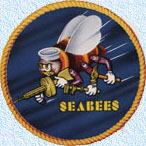
Recruitment
Recruitment of battalions and assignment of Civil Engineer Corps officer to them began as soon as the organization of units was authorized. Men already skilled in the various phases of construction work were enlisted. Recruits, representing about sixty different trades, were offered petty-officer classifications on the basis of their civilian construction experience and their age. The extra money which their rates assured encouraged them to enlist immediately - at the time they were needed most. In the early days of the organization, the average Seabee enlisted with a rate of petty officer, second class, equivalent to staff sergeant in the Army. Average pay and allowances totalling $140 a month made the Seabees one of the highest paid groups in the military service.
Direct voluntary enlistment in the Seabees came to an end on December 15, 1942, in conformance with a Presidential order requiring that the services procure their military personnel through Selective Service. By that time, about 60 battalions had been assembled. From that date until October 1943, it was possible for men to enter the Seabees by voluntary induction. Under this system, men between the ages of 18 and 38 were enlisted in the Navy and assigned to the Seabees upon request, provided their request for such placement was supported by a statement, signed by a recruiting officer, that they were considered qualified for such service. In October 1943, when most enlistments went under Selective Service control, the voluntary induction system was dropped as a means of recruiting men for the Seabees. It was resumed in December 1944, and continued in force until August 14, 1945.
Officer Procurement. - Available CEC officers were extremely limited, and it was therefore necessary to begin procurement of competent civil engineers to meet the battalion requirements as soon as the Seabee program was inaugurated. Civilian engineers were commissioned in the Naval Reserve, with rank in accordance with age and experience. On July 1, 1940, the Civil Engineer Corps had only 267 officers. As a result of the officer procurement program, there were 10,186 officers in the Corps in 1945. Most of these officers were assigned to duty with Seabee units.
As military operations in Europe and the Pacific progressed, the need for skilled construction units increased. One year after the first construction battalion was authorized, the Chief of the Bureau of Yards and Docks announced that the current authorized strength of the Seabees was 210,000 officers and men. This accounted for the major part of the ultimate strength of the organization, which reached a total of 247,000 men in July 1945. At that time about 83 percent of these men were serving overseas.
Seabee Military Organization. - The complement of a construction battalion was set originally at
____________________
3. SecNav ltr. to BuNav, BuDocks, BuSandA, BuMed, ComUSMC, OE/P17-1(420312)/Ca-1b, dated March 19, 1942.
--135--
32 officers and 1073 men. The enlisted complement was composed of carpenters, steel workers, plumbers, electricians, storekeepers, clerks, pile drivers, metalsmiths, wharf builders, draftsmen, steamfitters, and numerous other trades. Essentially, a battalion was composed of four companies which included the necessary construction trades for almost any construction job, plus a headquarters company.
It was found that there were not sufficient naval ratings to cover the various construction trades. For example, building carpenters, concrete workers, wharf builders, and surveyors were all classed as carpenter's mates. As a consequence, it was necessary that an experience record of each man be obtained when he reported for training so that each company might be composed of the proper trades.
The original officer complement for each battalion was one lieutenant commander as officer in charge, one lieutenant as executive officer, one lieutenant as company commander of each company, and four lieutenants (jg), six ensigns, and ten warrant officers (carpenters) for the headquarters and the four construction companies. All were to be Civil Engineer Corps officers. In addition, each battalion was to have two officers of the Medical Corps, one officer of the Dental Corps, two officers of the Supply Corps, and one chaplain.
The battalion was the fundamental unit of Seabee organization, having originally been constituted in such a way as to be self-sustaining in the
--136--
field. Seabee recruits were trained in battalions, and ordinarily were sent overseas in battalions. In the beginning, the construction battalion operated overseas as an independent unit, with the battalion officer in charge solely responsible for making all decisions of an engineering and military character.
As the number of battalions in a given area increased and as larger construction projects were undertaken, a higher-command echelon was needed to coordinate the work of several battalions in an area, to make work assignments to individual battalions, and to engage in overall planning. As a consequence, naval construction regiments were established to satisfy these requirements.
The first naval construction regiment was formed in Alaska in December 1942 by authority of the Vice Chief of Naval Operations. The duties of the regiment were to coordinate the activities of all the battalions in the Alaskan area and to administer the three battalions operating at Dutch Harbor. Battalions included were the 4th, 8th, 12th, 13th, 21st, 22nd, 23rd, and 32nd. The second naval construction regiment was formed at Noumea a month later, and included the 20th, 24th, 26th, and 27th Battalions, which were operating in that area. The third naval construction regiment, formed at Pearl Harbor, was composed of the 5th, 10th, and 16th Battalions. The first regiment to be formed in the Atlantic area was the 10th, which was formed at Argentia, Newfoundland, and included the 17th, 64th, and 69th Battalions. Altogether, 54 regiments were formed.
Naval construction brigades also were organized to coordinate the work of regiments and battalions in various areas. The first naval construction brigade was organized in Alaska on April 24, 1943 by order of the Commander, Alaskan Sector. The officer in charge of the brigade was assigned command duties for all construction regiments, battalions, and advance base depots, and was made directly responsible for the execution of approved construction projects in the Alaskan sector. The second construction brigade was formed at Pearl Harbor in September to fulfill the same purposes. By August 1944, three brigades were in operation in the Hawaiian area. By August 1945 a total of twelve brigades had been formed, although the 1st and 4th Brigades had been inactivated by that time. No brigade organization was set up in the Atlantic areas because of the relatively small number of battalions assigned there.
Ultimately it became necessary to establish a command echelon higher than the brigade. This need first became evident in August 1944, at Pearl Harbor, where 34 construction battalions were administered as three independent brigades. Since it was felt this system resulted in inefficiency, it was decided to form the Hawaiian Area Construction Brigade Command, including the 2nd, 7th, and 8th Construction Brigades. This command was inactivated in May 1945, after the 2nd and 7th Brigades had been transferred to Samar and the 8th Brigade had been transferred to Okinawa.
In April 1945 the 2nd and 7th Brigades were transferred from Pearl Harbor to Samar for the construction of Naval Operating Base Leyte-Samar. These two brigades, together with the second section of the 3rd Brigade, were consolidated to form Construction Forces, Samar. The officer in charge had the responsibility of supervising all construction in that area. In this capacity, he was under the administrative control of the Commander in Chief, Pacific Ocean Area. However, he was responsible to Commander in Chief, Southwest Pacific Area, for operations.
In the organization for the Okinawa movement early in 1945, the commander of the construction forces was also designated Commander Task Unit 99.3.5, with direct charge over all construction troops, including the 8th, 10th, and 11th Construction Brigades, together with all Army Engineer troops, which would have numbered 50,000 if hostilities had not ceased on August 14. In addition, he had slated for his command approximately 15,000 British engineering troops whose mission was to develop B-29 bomber fields at Kume Shima. These were on the water, some at the regulating point at Ulithi, when hostilities ceased. Altogether, approximately 110,000 engineers were involved, and were at the target or enroute when hostilities ceased. This was the largest group of construction battalions assembled for one movement during the war. A similar task unit organization was planned for the invasion of Japan, but its formation was rendered unnecessary by the Japanese surrender.
The formation of higher-command echelons did not destroy the character of the battalion as an operating unit or as a unit for maintaining discipline and exercising authority in matters relating to general personnel administration. Furthermore, the make-up of regiments and brigades tended to be flexible, since individual battalions were frequently
--137--
detached from regimental and brigade administration. This was particularly true in Hawaii, which served as a staging area for battalions being sent to advance areas in the Pacific.
Seabee Training
At the outset it was apparent that the formation of experienced construction workers, averaging more than thirty years of age, into efficient military construction units presented training problems both difficult and unique. Since recruiting was expected to produce a body of skilled tradesmen, there was little need for trade-school training, but the lack of military experience possessed by the new men indicated the phase of training which should be emphasized. In addition the military training which would be required for each Seabee unit, it was felt that training should be provided for small groups of specialists in each battalion on the operation and maintenance of such specialized advance base equipment as NL pontoon gear, stills and purifiers, and mobile generators.
First Seabee Training Camps
Camp Allen. - It was suggested by the Chief of the Bureau of Yards and Docks that the entire initial construction force be concentrated at one of the Navy's major training stations during the formative stage and until its units were moved outside continental limits to perform their functions. The training station at Norfolk, Va., was recommended because of the availability of suitable land there which could be used or purchased to permit the construction of the additional facilities which would be necessary to handle such an organization.
The construction of a camp at Norfolk, as requested, was authorized, and on March 26, 1942 the Commandant of the Fifth Naval District announced that the "U.S. Naval Construction Training Center, Naval Operating Base, Norfolk, was placed in commission at 1000 on 21 March 1942." This activity was named Camp Allen, in memory of Captain Walter H. Allen, CEC, USN, who had formed the construction regiment at Great Lakes during the first World War.
While waiting for the completion of Camp Allen, it was necessary that the men be trained elsewhere in order that the first battalion might be ready to leave the continental limits at the earliest possible date. The men of the first three battalions, after completing their recruit training at Great Lakes, Newport, and Norfolk, were sent to National Youth Administration camps for two weeks of military training under Marine instructors. These camps were located at Mattoon, Ill., Litchfield, Ill., Springfield, Ill., Verona, N.J., North Haledon, N.J., Manassas, Va., and Auburn, N.Y. At these camps, instruction was given in military courtesy, weapons handling, military drill, and other subjects commonly included in naval indoctrination training.
--138--
These men received their training with advance-base gear at Naval Air Station, Quonset Point, R.I. At this station, material-handlers, excavators, carpenters, mechanics, plumbers, and electricians were schooled in the use of the equipment likely to be employed in the jobs falling within their specialties. Instruction was given by CEC officers, line officers, and civilian contractors' employees. Upon completion of their military and technical training, the men were transferred to the still-incomplete Camp Allen. The first group of men arrived at Camp Allen on March 13, 1942, eight days before the camp was officially commissioned.
During the first weeks in the life of Camp Allen there were many problems to overcome. The camp was incomplete; it was rainy and muddy; the administrative personnel was new. The first two battalions were assembled and sent out from Camp Allen, and although they received no training there, they did get some actual construction experience by helping with the completion of the camp.
Camp Bradford. - As the rate of recruitment and induction of members of the construction battalions increased, it was found necessary to procure additional space for housing and training of new personnel. An additional area of 1600 acres at Little Creek, in the Norfolk area, was recommended, which with its waterfont on Chesapeake Bay and its isolated wooded terrain offered excellent facilities for technical training. The site belonged to the Bradford estate. It was purchased for the Seabees and named Camp Bradford, becoming a part of the Naval Construction Training Center. The rate of induction more than kept pace with the construction of additional facilities at Camp Bradford, and with the formation of the 6th and 10th Battalions it was again necessary to send the men to NYA camps for their primary military training.
Training Program at Camps Allen and Bradford. - Due to the urgent need for construction battalions in the spring of 1942 a training program of only six weeks was decided upon for NCTC, Norfolk, at best a short period in which to make a sailor out of a civilian. The battalions went through recruit training at Camp Allen. Certain
--139--
men were selected from each recruit battalion for specialist training, the purpose being to familiarize them with the type of equipment with which they would have to work at advance bases. It was an early policy that the number of men to be given specialist training would be based upon the battalion outfitting allowance, so that operating and maintenance personnel for full-time operation of all battalion equipment would be provided. Specialist training was given in various fields, as follows: boilers and heating, dynamiting, diesel and gas engines, evaporators and purifiers, generators and electricity, air-raid protection and camouflage, pontoons, propulsion units and drydocks, tanks and radio masts, refrigeration, welding, ordnance, concrete forms and carpentry, diving, excavation and earth moving, and hut erection and fire fighting.
The battalion's advanced training of three weeks was carried on at Camp Bradford, where there were ample facilities for the first battalions to be given technical military training and to engage in actual construction work. Usual assignments included practice landing operations, extended-order drill, quonset hut erection, laying of steel-mat roads, bridge construction, diving, welding, and pontoon assembly. This phase of training, although limited in time, served to "shake down" the construction battalions into organized military units.
--140--
Officer Training. - Since most of the officers who were to be assigned to construction battalions came into the Navy directly from civilian life, it was necessary to provide for an indoctrination course to acquaint them with the basic requirements of military life. As originally planned, the course covered a period of two weeks, but in practice the training period was varied, depending upon the immediate need for officers in the various battalions. The original course, given at Norfolk, consisted of classes in naval customs and traditions, courts and boards, marksmanship, physical training, naval correspondence, camouflage, chemical warfare, and military drill. The new officers completed the indoctrination course at approximately the same time that the men completed their basic
--141--
training, and were assigned to specific battalions to begin advance training at Camp Bradford.
Upon completion of training at Camp Bradford, the construction battalions were transferred to advance base depots for outfitting and further transfer to their overseas destinations.
The Advance Base Depots. - The first advance base depot was established at Davisville, R.I., on February 27, 1942. In May 1942, a similar activity was established at Port Hueneme, Calif., and a third was established at Gulfport, Miss., on June 2, 1942. The establishment of advance base receiving barracks for transient Seabee personnel was authorized for these activities on October 23, 1942. These barracks were named Camps Thomas, Rousseau, and Holliday in honor of outstanding Civil Engineer Corps officers who were no longer living. A fourth advance base depot was established at Tacoma, Wash., in 1944, but no facilities were provided for transient Seabees.
Later Seabee Training Camps
Camp Endicott. - Successive directives issued by the Chief of Naval Operations providing for the construction, maintenance, and operation of bases outside the continental limits made a further expansion of the training facilities for the construction battalions necessary. As a consequence, the Chief of the Bureau of Yards and Docks, made a recommendation to the Secretary of the Navy urging the expansion of Naval Advance Base Depot, Davisville, to provide additional training
--142--
facilities for construction personnel. This request was approved, and a camp was established on June 27, 1942. It was named Camp Endicott in honor of Rear Admiral Mordecai T. Endicott, the first Civil Engineer Corps officer to be appointed Chief of the Bureau of Yards and Docks.
After suitable arrangements had been made to transfer nucleus personnel for station operation from NCTC, Norfolk, the first battalion started training at Camp Endicott on August 12, 1942. The capacity of the station provided for ten battalions in training, totaling approximately 350 officers and 15,000 men. This capacity was reached early in November 1942. Both primary and advanced training were given at Camp Endicott.
Camp Peary. - As the Seabees proved their value in war operation, their authorized strength continued to increase. By August 1942, it became evident that Camp Allen, Camp Bradford, and Camp Endicott would not be sufficiently large [enough] to take care of the training of the rapidly expanding organization. Accordingly, it was decided to build a new camp on the York River, near Williamsburg, Va., to house 50,000 men. This vast training activity was officially established on November 4, 1942, and was called Camp Peary in honor of Rear Admiral Robert E. Peary, CEC officer of polar-expedition fame. The camp covered an area of about 11,000 acres and was a large edition of Camp Allen and Camp Bradford. It was divided into an administrative area and four regimental areas, each capable of housing ten battalions, and an officers' training area. A ship's company nucleus for the new activity was provided from the personnel at Camps Allen and Bradford. On December 1, 1942, steps were initiated to disestablish Camps Allen and Bradford, a process which was officially completed on March 17, 1943.
Later Training Programs and Facilities
With the establishment of Camp Endicott, primary and advanced training were increased to four weeks each, assuring at least two months of training for all Seabees before shipment overseas. The original plan for emphasizing military training and providing specialist technical training for all battalions continued to be the basis of the training program.
After Camp Peary began operation, the training program for Seabee personnel assumed a standardized pattern. Throughout 1943 and during the first half of 1944, the Seabees were given their primary training at Camp Peary. They were then shipped to Camp Endicott, where they received six weeks of technical and military training, and were permanently assigned to a battalion. The technical training at Camp Endicott was included in 27 courses in which skills ranging from diving to bulldozer operation were taught. Military training at Camp Endicott included judo, close-order drill and the manual of arms, and the use of various weapons. As battalions completed their training, they were sent to one of the advance base depots, where training facilities were provided to enable them to carry on tactical training while awaiting shipment overseas.
Officer training expanded in proportion to the enlisted training to meet the requirements of a corps projected to number around 10,000 officers in early 1945. When NCTC, Norfolk, was disestablished, officer training was transferred to Camp Peary where a large area was set aside for this purpose. Battalion officers were given approximately four weeks of indoctrination, four to six weeks with the "boot" trainees, and then were assigned to six weeks of battalion training.
Due to decreases in recruiting, Camp Peary was abandoned as a Seabee training center on June 10, 1944; thenceforth, all Seabee training, including officer training, was carried on at Camp Endicott.
Throughout the critical period of recruitment and development of construction battalions, the training of personnel came under the cognizance of the Bureau of Yards and Docks. However, in August of 1944 all Seabee training was placed under the cognizance of the Bureau of Naval Personnel.
The spring of 1945 proved to be a turning point in the basic concept of Seabee training. At that time the training of organized construction battalion units ceased and emphasis was placed on the training of individuals for replacements. The men received for training as replacements were generally young, Selective Service inductees. Due to their prevailing lack of construction experience it was felt that there was little to be gained by giving them short, specialist, training courses. The urgent requirement for replacements in the field did not allow time for extensive trade-school training to make up for the inexperience of the recruits; furthermore, it was possible to give effective "in service" training to the unskilled because of the large number of experienced personnel in the field. Consequently,
--143--
many of the specialist technical-training courses were discontinued and elementary military training of approximately four weeks was given.
Camp Lee-Stephenson. - In the fall of 1943 it was necessary to establish another training station to take care of the overflow caused by the rapid influx of Seabee trainees into the camps then established. Consequently, on October 2, 1943 a new Seabee training activity was established on the site of a former NYA camp at Quoddy Village, Maine. This camp was named camp Lee-Stephenson,4 in memory of the first two Civil Engineer Corps officers to lose their lives in World War II. Training at Camp Lee-Stephenson was limited in scope. Most of the men sent there had already been given their full quota of training and were awaiting shipment to an advance base depot. By 1944, Camp Lee-Stephenson's main value lay in its facilities for rest and rehabilitation of Seabee personnel returned from overseas.
Camp Parks. - At the close of 1942 a new Seabee activity was announced for the West Coast - a replacement and recuperation center for battalions returning from overseas. This activity was Camp Parks, 5 which was officially established on November 26, 1942. It was located near Livermore, Calif. Although Camp Parks was conceived as a station to be devoted primarily to the handling of personnel
_____________________
4. Lt. Irwin W. Lee and Lt. (jg) George W. Stephenson.
5. Named for Rear Admiral Charles W. Parks, chief of the Bureau of Yards and Docks in World War I.
--144--
returning from overseas, in practice the major service rendered there was the tactical training of organized CB units transferred from the East Coast for embarkation. As a matter of fact, Camp Parks was called upon from time to time to provide all phases of primary military and technical training for Seabee units.
Additional Seabee Groups
The advance bases which served as stepping stones to the final defeat of Japan were built by the regular construction battalions, the organization and training of which have been discussed. But as the war progressed, new needs developed, and specialized types of battalions and detachments became necessary. The new specialized units ultimately grew into a sizeable force, the largest group being the Special Battalions, used for stevedore duty.
Special Battalions. - During the late summer and fall of 1942, it became apparent that the Seabees would be called upon to perform another vital function in addition to construction work. Since the war was being fought on various fronts, thousands of miles from the United States, vast quantities of food, ammunition, and other supplies had to be transferred in ships to these far-distant points. Unloading these ships presented a major problem at most places because there were not enough trained men to handle the work. The nature of the Pacific war made stevedoring at the advance bases as difficult and as dangerous as construction work, especially in view of the fact that a ship being unloaded presented a good target for the enemy.
The Seabees were called upon to perform the desperately needed stevedoring. Authority for the organization of a number of special-duty battalions, composed of personnel well qualified in cargo handling and ship loading, was granted on September 18, 1942, and recruitment of personnel began immediately. The Bureau of Yards and Docks contacted the country's leading steamship and stevedore companies in search of men of the type required. An agreement was reached under which these companies released twenty percent of their trained men to the Seabees for organization into special stevedoring battalions for overseas duty.
Although the recruits for these battalions already were skilled in cargo handling at the time of their enlistment, they were sent to a stevedore training school at the Naval Construction Training Center, Camp Peary, where they were drilled in the methods they would employ while stevedoring for the Navy. To make the training as realistic as possible, a mock Liberty ship was built on dry ground and equipped with standard cargo-handling gear. The trainees practiced loading and unloading cargo under the direction of officers who themselves had been recruited from civilian stevedoring agencies.
On January 26, 1943 the Chief of the Bureau of Yards and Docks reported to the House Naval Affairs Committee that there were approximately 5,500 officers and men assigned to these special battalions, most of them then in training, although a few were already overseas. By August 1945 about forty of these battalions had been commissioned and were either in the forward areas or on their way there. These battalions were organized along the same lines as the regular construction battalions in that they had one headquarters company and four stevedoring companies. Each stevedoring company included one construction platoon in its complement, since it was assumed that the battalions would be required to erect their own living accommodations at their destinations. The officers of each battalion, numbering 32 in all, included 4 construction officers, 2 doctors, a dentist, 2 supply officers, and a chaplain, in addition to the 22 stevedore officers.
The training of special battalions organized for stevedoring duty was carried on at Camp Peary until that activity was discontinued as a Seabee training base. Stevedore training was then transferred to Camp Endicott, together with the other branches of Seabee training. The Camp Peary Liberty ship mock-up was moved to Davisville. Another station, Camp Rousseau, at Port Hueneme, also had a Liberty ship mock-up.
The CBMU's. - Another important type of Seabee special unit was the Construction Battalion Maintenance Unit (CBMU). These units consisted of approximately one-fourth of a construction battalion and were organized to take over the maintenance of bases on which the major construction had been completed, thus freeing full construction battalions for further moves forward. As the war progressed and some of the bases outlived their usefulness, the maintenance units were employed to dismantle the installations.
More than 100 of these units, variously constituted,
--145--
had been commissioned by August 1945. Some of them were trained and initially formed at the primary training camps, just as the regular construction battalions were. Others were taken from regular battalions, either at advance base depots in the United States, or at advance bases beyond the continental limits. By V-J Day, many had been inactivated or had merged with other CBMU's or with regular construction battalions.
The CBD's. - In addition to these units, other groups were constituted, ranging from 6 to 500 men. These units were designated Construction Detachments (CBD's) and were sent into the field to relieve, replace, or strengthen regular construction battalions. In most cases, the CBD's were formed at Camp Peary and Camp Endicott. Some of these units were formed to perform a specific function. Thus, CBD 1059 had as its principal task the operation of a large tire repair and recapping shop on Guam; CBD 1068 was commissioned at Guadalcanal to operate a Seabee dredge on that island.
Other Seabee Units. - Several other types of Seabee units were formed, some of which required highly specialized training in preparation for the performance of their functions. Pontoon assembly detachments of about 500 men manufactured the pontoons from plates and shapes which were sent to the forward areas where those detachments (PAD's) were established.
Also organized were pontoon operating battalions, composed of 24 pontoon operating platoons, each platoon capable of handling a pontoon causeway and maintaining it in service during an assault. Their garrison-phase function was to operate the assembled pontoon barges, pontoon piers, and warping tugs. There was sufficient personnel in the organization to operate upward of 200 barges on a 24-hour basis.
Truck Operating Battalions were established, at least one of which had 2,800 men. These battalions helped speed the flow of materials and supplies at large bases. Advance Base Construction Depot Units, varying in size form a full battalion down to units of 175 men, handled the warehousing and distribution of spare parts, supplemental equipment and materials at advance bases.
Other Seabee detachments overhauled critical items of construction equipment, conducted extensive
--146--
dredging operations, conducted oil explorations, and erected large diesel-electric generator plants. Still other detachments, trained at the factories where the generator sets were made, operated the electric plants.
The problem of spare parts distribution to the construction battalions was greatly aided by the creation of Spare Parts Units. These units carried stocks to keep a battalion supplied with spare parts for 180 days, of two-shift operation, after they began their work. When a battalion landed, it had with it a supply of spare parts sufficient to take care of the anticipated needs of the first 45 days of two-shift operation. Each battalion also had an automotive parts common and supply kit for each company. After a battalion was in working position, all parts were pooled to stock a battalion spare parts depot. Training for the personnel of the spare parts units took place at the Central Spare Parts Warehouse, at Joliet, Ill. The number of officers and men assigned to spare parts duty ranged from 15 to 130.
Seabees carried out one of the most dangerous assignments of the war as members of special Navy underwater demolition teams. These groups helped clear enemy beaches in front of troops making assault landings, by blasting paths through coral formations and mined barriers. Their work was responsible for the success of many landings and as such was an outstanding contribution to the successful prosecution of the war.
Seabee Units Attached to Marine Divisions. - Three construction battalions were attached initially to Marine divisions in the capacity of combat engineers. These battalions took their primary training at Norfolk, and received their tactical training with the Marines at Marine training bases.
Seabees in the Forward Areas
Before the first regularly constituted construction battalion was organized and trained, it was necessary to establish a fueling station on the supply line to Australia. Borabora, in the Society Islands, was selected as the site and coded Bobcat. A group of approximately 250 naval construction men was assembled at Quonset Point, R.I., organized hastily into a construction detachment, and shipped to Charleston, S.C., on January 17, 1942. The Bobcats, as this group later was called, after being reinforced with an additional fifty men at Norfolk, left Charleston on January 27, and arrived at Borabora on February 17. They were the first group of naval construction workers to go overseas. Not too well provided with food, clothing, housing, medicine, or construction equipment, the detachment set to work. Weather conditions were bad, and the threat of enemy action was constant. Nevertheless, in three months the group had completed a seaplane ramp, emplaced heavy guns, cleared a landing strip for the Army, and - most important of all - installed and camouflaged the oil-storage tanks which formed their original assignment.
The first battalion to work under combat conditions was the 6th, the first contingent of which went ashore at Guadalcanal on September 1, 1942. Work was begun the next day on lengthening and maintaining Henderson Field and on the construction of three adjacent fighter strips. Units of this battalion also engaged in waterfront construction, road and bridge construction, electric power installations, and tunnel construction on Guadalcanal.
Seabees Take Over From The Contractors
While the first four Seabee units were being rushed to the forward Pacific areas, other battalions were being readied to take over naval construction projects begun by private contractors. The first battalion to function in this capacity was the 4th, commissioned in May 1942. This battalion left Seattle on June 27, 1942 and arrived at Dutch Harbor on July 5.
The first battalion to be sent to the Atlantic area was the 9th, commissioned on June 6, 1942. This battalion departed for Iceland on August 5 and took over contract work on a Navy fuel depot, a fleet recreation area, ammunition storage facilities, a fleet air base, and an Army airfield at Reykjavik.
Other battalions relieved the contractors at Trinidad, Bermuda, and in the British Isles.
The 29th Battalion, the first Seabee units to arrive in Europe, was commissioned on October 4, 1942. It left the United States for the United Kingdom in two sections. The first section arrived at the U.S. Naval Base, II, Rosneath, Scotland, on November 30; the second section soon followed.
While some battalions took over the construction work begun by private contractors, other Seabee units went to work on new construction all over the world. Through the combined efforts of all
--147--
--148--
the Seabee battalions and specialized units, an unparalleled record of military construction and maintenance was accomplished, contributing in large measure to the successful conclusion of the war.
Demobilization
Demobilization of the Seabees followed the same rapid pattern as that which characterized other Navy personnel. From a Seabee strength of 8000 officers and 238,000 enlisted men on V-J Day, organized into 9 brigades, 31 regiments, and 338 battalions and smaller units, the number decreased to a total of 400 officers and 20,000 enlisted men, organized into 2 brigades, 2 regiments, and 40 smaller units, on June 30, 1946.
On V-J Day there were four Seabee training centers still in an active status - Camps Endicott, Parks, Rousseau, and Lee-Stephenson. By the end of 1945, all Seabee activities had been transferred to Port Hueneme, with the exception of the officers' training school at Endicott, which was likewise transferred to Port Hueneme, during the summer of 1946. The Construction Battalion Center, Port Hueneme, consisting of the Advance Base Depot and the Training and Distribution Center (formerly Advance Base Receiving Barracks) was established in December 1945 as the center for Seabee activity in the post-war Navy.
--149--
Chapter VII
Advance Base Equipment
Seabee construction of new sea and air bases was a vital factor in the success of American naval operations in World War II. As most of the bases were built in undeveloped locations, it was necessary for the construction battalions to bring all of their equipment and a large amount of their materials from the United States. Moreover, it was necessary, at least in the initial stages of each operation, to transfer equipment from ship to shore without conventional port facilities.
Advance base equipment fell into two main divisions, standard items available in the domestic market and special items which were developed to speed and ease construction in forward areas.
Developments in the second category ranged from simple adaptations of commercial items to the invention and exploitation of that wonder box, the universal steel pontoon. An example of simple adaptation was the addition of skids and lifting rings to increase the portability of commercial motor-generator sets. The pontoon was used to ramp construction machinery and fighting tools from LST's to primitive shores; it was powered to provide barge lighterage of goods across shoal water; it was assembled in many forms to perform a great number of indispensable services which could not have been performed as quickly by any other means.
These developments helped in the achievement of a first objective, to get the battalions in working position. Other developments, such as salt-water distillation units, were developed so that the battalions could continue working when they were in position.
The story of advance base equipment is told in three parts. The first part gives the details of the major items taken to an advance base by one battalion. The second part summarizes the extra equipment that was supplied to units organized to perform specialized work. The third part described the more important special items as they were developed by the Bureau of Yards and Docks at the Advance Base Proving Ground, Davisville, R.I., and at other places.
Battalion Equipment
Two factors influenced the nature of the equipment taken by the battalions to advance bases - the climate and advance base construction experience. The climate could be anticipated, and proper equipment to cope with that factor was provided from the start. Construction experience dictated some changes from the original equipment lists, which, in general, had been determined from stateside construction experience.
Early battalions were equipped with light-and-medium weight construction machinery, to ease the task of movement from ship to shore. It was found that the advantage of having the largest units available more than compensated for the difficulties of transporting the heavier items. This was especially important in the more advanced areas of the Pacific operations, where some of the fastest heavy-construction jobs in history were performed.
The first battalions sent into the Pacific were outfitted with "tailor-made" allowance lists. The battalion's complement of equipment and material was determined by the type of work to which it was assigned. The outfitting of a battalion sent to an island to construct a fuel tank farm with fleet fueling facilities would differ from that of a battalion assigned to the construction of an airport. It was soon found, however, that all battalions had similar basic requirements. In order to maintain an efficient working schedule on major construction projects, each battalion was obliged to construct its own camp with facilities necessary for reasonably comfortable living. Island commanders were constantly calling on Seabees for the erection of the living facilities for station personnel, Navy, Army, or Marine. The housing developments, although varying greatly in size, were always
--151--
similar in the type of utilities that went into their make-up - housing and messing, electrical, water supply, laundry, sewage disposal, and garbage disposal.
Although the primary functions of bases differed greatly, all bases had several facilities in common, such as roads, hospitals, offices, communications, waterfront structures, and storehouses. This fact was borne in mind in the organization of the regular battalions. The personnel complement for each battalion contained the same number of men in the various construction trades. To make it possible for a single battalion to cope with all types of construction jobs, and to utilize personnel as efficiently as possible, the standard battalion allowance list was developed. Whenever experience in the field showed a weakness in some part of the list, the list was changed accordingly. For example, the early battalions had two earth-moving cranes, with a total capacity of three and one-half cubic yards. This was increased, in later lists to six machines, with a capacity of four and three-fourths cubic yards. In graders two towed machines were supplied originally. Later, three mechanically controlled diesel-powered motor graders were supplied. In scrapers, the trend was to larger sizes with the same total capacity. The number of dump trucks was increased from 24 to 32. In the following paragraphs the more important items of the 1945 list are described.
In the matter of housing, equipment varied with the climate. The first housing units to be taken to the Pacific were prefabricated huts; later, because of the length of time necessary for the erection of huts, tents were substituted. In the northern regions, the quonset hut was in the original equipment. The construction of quonset huts was varied to adapt them to service in the various climates. The northern units had fixed wood bulkheads, insulation, and windows. The tropical hut had screen bulkheads, screen windows, removable side segments, and a lifting top section that provided additional ventilation.
The 343 tents provided for each battalion were used for all purposes: housing, messing, officers quarters, and storage. Specifically, there were 264 tents, 16 feet square; 21 tents, 17 by 20 feet, and 26 tents, 16 by 50 feet. The quonset hut housing consisted of 72 huts; 69 of the 20-by-48-foot size and 3 of the 40-by-100-foot warehouse size. Enlisted personnel were housed in 56 of the 20-by-48-foot huts, and 10 of the same type were used for officers. One double 40-by-100-foot warehouse was used for galley and messhall. The remainder of the huts were used for storage and utilities.
As the equipment finally evolved, mechanical subsistence equipment for each battalion included eight water purification units, a water supply and distribution system, and when needed, a water distillation system. The purification units had chlorination and filter elements which could provide up to 10,000 gallons of purified water in a day.
--152--
The water was stored in canvas or wood tanks. The fire-fighting system consisted of two 500-gpm centrifugal gas-driven trailer pumps and chemical fire extinguishers.
For electrical power, eight 15-kw three-phase 60-cycle gasoline-driven generators were provided. Communication was handled by a 50-circuit telephone system, a portable field telephone set, and a public-address unit. On special request an FM radio station of 30- to 60-mile radius was included in the equipment.
For transportation, 77 trucks, of various types, were included in a construction battalion's equipment. The light trucks were a 3/4-ton ambulance, eighteen 1/4-ton reconnaissance cars (jeeps), and four 3/4-ton weapon carriers. The heavy trucks included one 21/2 -ton, six-by-six, 750-gallon tank truck; four 11/2-ton, six-by-six, cargo trucks; four 21/2-ton, six-by-six, cargo trucks; thirty-two 21/2-ton, six-by-six, dump trucks; one 21/2-ton, oilfield body truck, and one 4-ton, six-by-six, cargo truck. In addition to the trucks, there were 20 trailers, of various types, and one fifth-wheel, 21/2-ton, six-by-six truck tractor.
The battalion's earth-moving equipment comprised 37 pieces of equipment. Six crawler cranes included: Two half-yard, 6-ton cranes, each with clamshell and dragline bucket attachments; three, 3/4-cubic yard, 13-ton cranes; and one, 30-ton unit of 11/2-cubic yard capacity, all with clamshell, dragline, and shovel attachments. One of the 3/4-yard excavators was provided with a backhoe attachment.
The tractors sent with a construction battalion were of four classes, ranging from 113-drawbar horsepower to 35-drawbar horsepower. Of the largest size, class one, there were eight. Of classes two and three, there were four each, and of class four, there were two. All these crawler tractors were equipped with either bulldozer or angledozer attachments. These tractors also were used with carry-alls, of which there were eight, four of 8- to 10-cubic yard capacity and four of 12- to 15-cubic yard capacity. In addition to these primary earthmoving-equipment machines, there were such items as eight pneumatic rock hammers; one 8-ton tandem and one 12-ton, 3-wheel, gasoline- or diesel-driven road rollers; one 3-tooth, extra heavy-duty, tractor-drawn rooter; three power graders, with 12-foot blade, 4-wheel drive, 4-wheel steer, hydraulically controlled, diesel engine driven; two 5-ton cargo cranes; two concrete mixers of 7 and 14 cubic feet capacity, respectively; and four portable diaphragm pumps of 3000-gph capacity.
In addition to the heavy equipment, some construction materials were taken for the housekeeping use of the battalion. A few of the more important items included the following: 1,000 bags of
--153--
portland cement, 328,000 board feet of lumber of assorted sizes, 2800 linear feet of angle and bar steel, 10,850 pounds of reinforcing steel, 14,000 assorted bolts, 65,400 feet of 6-by-19 assorted size wire rope, 120 oxygen cylinders, and 2,550 pounds of welding rod. Thousands of smaller items, hand tools for construction and repair, clothing, small arms, personnel services equipment, combined with the foregoing to make the total for transport.
The need for battalions specializing in stevedoring work has been described in Chapter 6. Because these battalions were to engage in construction only to a point of erecting their own camps, they did not need as much construction equipment as the regular battalions. However, their work demanded types of equipment peculiar to cargo handling.
Heavy transportation equipment issued to Specials for cargo hauling consisted of sixteen, six-by-six, 21 /2-ton cargo trucks; two six-by-six, 21/2-ton dump trucks; two six-by-six, 4-ton cargo trucks; six 25-ton trailers; and eight 10-ton fifth wheel-type trailers. For handling cargo on the waterfront and in warehouses, twelve fork-lift trucks were included in the complement. Lifting equipment was issued without earth-moving attachments and included four 6-ton and one 13-ton crawler-mounted crane and one 13-ton truck-mounted crane. Crawler tractors were limited to four, two of class one and two of class three, all of which were furnished with bulldozer or angledozer attachments. Eight pneumatic-tired industrial tractors with a load-pulling capacity of 20 tons were shipped for moving trailers.
Specialized Units
When the offensive in the Pacific took on larger proportions, the size of naval bases required to support the operations was necessarily increased. For the construction of the larger bases at Guam, Manus, the Philippines, and Okinawa, many battalions were working within close proximity to one another. Special units were set up to provide services which would normally be available to stateside construction forces. In order to avoid duplication of efforts to make major repairs on automotive and construction equipment, and to rehabilitate worn-out tires, specialized units were organized and equipped to handle all work of this type for the construction units in the areas. Dredging was a type of work performed at only a few bases, so a dredging battalion was formed, and detachments were sent where they were needed. Pontoon assembly detachments were developed to build the pontoons from shapes and flat plates.
Projects which were too large to be accomplished with the standardized equipment available with each construction battalion, or which needed special types of equipment, received the regular allowance, augmented by standardized amounts of equipment required. Components were prepared for heavy excavation, rock drilling and blasting, rock crushing and screening, asphalt mixing and placing, lumber production, and port development.
Units, consisting of 20 officers and 630 enlisted men, were provided with facilities for the overhaul of approximately 500 pieces of equipment per month. The shops, ten in number, were well equipped to perform a major overhaul job on all types of advance-base gear, such as trucks, tractors, and cranes. The major special equipment items included a compact trailer-mounted machine shop; a universal boring machine for line and camshaft bearings up to 4 inches in diameter; two clutch rebuilders; four dynamometers; 23 grinders for brake-shoes, crankshafts, cylinders, and valves; two brake-drum lathes; a straightener device for alignment of axles and frames; a test stand for diesel engines, injection pumps, and nozzles; a generator and starting motor test bench; a two-ton bridge crane; and a vertical 36-inch boring mill.
The tire repair units were designed to have a capacity for recapping and top-capping 1000 tires per week and to make sectional repairs to 1450 tires in the same period. To accomplish this work, the units were supplied with 20 sectional molds and 15 full-circle molds. The one unit that was put in operation, at Guam, was able to meet the design capacity even though it repaired all the various sizes of tires used on heavy construction equipment, trucks, and passenger vehicles.
One battalion, the 301st, was formed to specialize in dredging. Detachments, each consisting of one dredge crew, were sent any place in the Pacific where their services were needed. The battalion operated standard suction and dipper dredges and numerous smaller pontoon barge-mounted clamshells.
A pontoon assembly detachment, consisting of 17 officers and 418 enlisted men, was equipped to
--154--
manufacture about 1800 steel pontoons per month and to form them into any of the final assemblies. For the assembly of the pontoons, both rectangular and curved types, the detachment was equipped with two assembly lines, consisting of jigs and fixtures to hold the pre-cut plates and structural forms in place for welding.
The heavy excavating and hauling equipment component was designed to handle, under average conditions, 337,000 cubic yards of rock in 30 days. Transportation equipment consisted of four, dump-bottom, 13-cubic yard trailers, sixteen, 10-cubic yard, dump trucks; and twenty, six-by-six, 4-ton dump trucks. Excavation machines consisted of six 11/2 -cubic yard and three 21/2-cubic yard, crawler-mounted cranes, complete with clamshell, dragline buckets and shovel attachments.
The equipment for rock drilling and blasting was designed to produce approximately 650 cubic yards of rock per hour. The component was composed of seven pneumatic paving-breakers; thirty-two 315-cfm and severn 210-cfm portable, air compressors; thirty-five wagon-mounted drills; and seven, 50-hole, blasting machines.
The crushing and screening plant was a portable three-unit type, with two, jaw crushers and one, roll crusher, complete with screens, conveyors, bins, diesel-engine power units, and drives. The plant was designed so that a washing attachment could be installed in the third unit, if washed aggregate was needed. The approximate minimum capacity of the plant was 250 tons per hour, of 21/2-inch, maximum size product.
The asphalt plants had capacities of from 110 to 200 tons per hour. Equipment consisted of two 60-HP boilers; a control unit with a 4-by-8-foot vibrating screen; a 24-inch hot-aggregate belt conveyor; two trailer-mounted distributors; a dual-drum type, aggregate dryer; a paving finisher with a 10-foot width and a 1/4-inch to 6-inch thickness
--155--
working capacity; a crawler-mounted, 3-cubic-yard-per-minute aggregate loader; and a 1,500-gallon asphalt tank.
Five asphalt plants were used in the Marianas in the development of B-29 bomber bases.
The sawmill was a heavy-duty portable type and was designed for installation on permanent or temporary foundations. The complete installation was capable of producing 16,000 board-feet of 1-inch lumber per eight hour working day. The mill was equipped with a 60-inch, circular, inserted-tooth saw, 6-inch belt-feed type, driven by a 148-horsepower engine, underslung chain type sawdust conveyor and 20-foot headblock carriage. A three-saw edger, with 14-inch diameter, inserted-tooth saws, driven by a 100-horsepower engine, and a 42-inch diameter solid-tooth cutoff saw, driven by a 48-horse-power engine, supplemented the main unit to allow production of lumber for all construction needs. Special equipment was designed to augment the allowance of half of a standard battalion to enable it to undertake rapid development of a damaged or undeveloped port. The component supplied two 2-by-12 pontoon bridges, a 5-by-12 pontoon wharf, and a pile-driver attachment for a 13-ton crane.
Development of Special Equipment
To satisfy the requirements that advance-base construction imposed upon equipment, considerable experimentation was carried on at various locations within the United States. Most of the development in materials and equipment was carried on by the Advance Base Department of the Bureau of Yards and Docks in conjunction with the Advance Base Proving Ground at Allen's Harbor, Davisville, R.I.
The Advance Base Proving Ground was an outgrowth of the Quonset Pontoon Experimental Area, which was established before the war. The pontoon
--156--
area was under the direction of the War Plans Division of the Bureau of Yards and Docks. Prior to the establishment of the pontoon area, tests of pontoons had been conducted on the Ohio River, at Portsmouth, N.H., and in the Quonset area. In the fall of 1942, the need for a special station, to be devoted to the development and testing of equipment under consideration for purchase by the Bureau of Yards and Docks, became obvious. The pontoon experimental area was the logical site choice. The following objectives were set for the new Advance Base Proving Ground: (1) to assemble and test equipment; (2) to conduct field research of proposed equipment; and (3) to submit recommendations and suggestions for improvements in equipment.
Through the war years the Advance Base Proving Ground tested and developed hundreds of pieces of equipment for Navy use - distillation units, filtration units, laundry equipment, stoves, propulsion units, trucks and generators, and many pontoon assemblies. However, many improvements in equipment were initiated in the field, either by critical requests for development or by pioneer field improvisations.
Pontoon Gear
The pontoon assemblies were the outstanding items of specialized gear developed by the Bureau in conjunction with ABPG. Assemblies, in the form of causeways and lighters, immeasurably helped troop and equipment landings in Sicily, the Normandy beaches, and in the numerous Pacific islands.
The history of Navy lightering pontoon gear invention and development began in 1935 and 1936, when the War Plans Division of the Bureau of Yards and Docks was considering problems connected with the development of advance bases. An officer in the Bureau of Construction and Repair, on duty with a western steel company, observed the construction of a sectional barge for use by a dredging company. It occurred to him that this section idea might be of value in connection with the advance-base problem. He sent a drawing to the Bureau of Yards and Docks, showing his idea of how steel box sections might be fitted together to form a barge. These sections were 10 by 20 by 6 feet. The fastening scheme involved bolting adjoining sections together with heavy bolts through holes in the sides, close to the top and bottom plates.
In 1939, Capt. John N. Laycock, CEC, USN, who was on duty in the Bureau, gave the problem further study. As a result, he developed the idea of universal, or uniform size, units which could be fitted together, as needed, to form various items of advance base equipment. Such uniform pontoons might be assembled to form barges, seaplane ramps, and even floating drydocks.
Captain Laycock spent some time in experimenting with a pontoon assembly model made up of cigar boxes, joined together at the four corners by continuous wood strips. The model string showed surprising strength. The unfound key to the pontoon problem, became the system of fastening and assembling. This problem had two elements: first, it would be necessary to find some way to avoid the bending moments which would occur under beam-loading conditions, if the fastening bolts were offset some distance from the top and bottom plates. Second, it would be necessary to provide some means of making strings of the pontoons so that small assemblies could be launched.
The problems were solved by the use of continuous angles, analogous to the wood strips in the model, fastened to the boxes with bolts and wedges. Room for a connection between the angles and the boxes was made by cutting off the corner of the box and closing the triangular opening, thus made, with a plate. A punched connecting angle strap was then welded to the box at the lopped-off corner.
With the method of assembly adopted, the only feature which remained to be determined was the size and structural form of the pontoon.
The criteria established were as follows: (1) the width of the largest plate used could not exceed the width of plates usually rolled in large quantities; (2) the width of a string of pontoons would have to be great enough to allow stability when afloat; (3) the limiting light weight of a pontoon should be one ton; (4) the top surface of the pontoon should be capable of supporting a ten-ton load from each of two dual tires; (5) a pontoon when full of gasoline should weigh about 5 tons, the normal capacity of cargo booms on merchant ships; (6) there should be a total width of about 20 feet when three strings were assembled side by side; (7) the draft of a pontoon when unloaded should be about 16 inches. From these criteria, trial and
--157--
error studies indicated the dimensions should be 5 by 7 by 5 feet. The steel box was stiffened by 6-inch plates, welded together to form a T and welded girthwise to the interior of the pontoons.
The first test of a pontoon string used eleven pontoons, set up as a bridge simply supported at the ends, with a load concentrated upon the center pontoon. The test was carried out by using steel plates as the elements of the test load. Failure occurred when the load reached 55 tons, one of the lower angles failing in tension at that load. Other tests were conducted on a 3-by-7-pontoon barge, a small drydock assembly, and a seaplane-ramp assembly.
With the pontoon in satisfactory shape for use, there remained the development of some form of propulsion unit. Three possibilities were studied: A paddle-wheel unit, an outboard unit, and an inboard unit. The outboard unit was the one selected. An experimental model was made and given a performance test at Quonset Point.
From these basic beginnings, various assemblies were made, including net tenders, warping tugs, causeways, "rhino" ferries, 75-ton floating cranes, drydocks, finger piers, seaplane service piers and ramps, and an experimental aircraft landing field. The 1944 Pontoon Gear Manual, published by the Bureau of Yards and Docks, listed 31 standard assemblies.
The pontoon, in its final World War II form, had quarter-inch plates at the top and bottom, and 10-gauge metal (about one-eighth inch) for sides and ends. Inside, they were braced to withstand an internal pressure of 25 psi. The pontoon weighted 2000 pounds, and the various connections added 800 pounds. The net buoyancy capacity of each pontoon was about four tons, but the payload was limited to one long ton. There were three types of pontoons: the 5-by-7-by-5-foot, for universal use;
--158--
the curved-bow pontoon, for transport service; and the wedge-box pontoon, for landing use. The pontoons were assembled into three standard sizes of barges: three by seven, 50-ton; four by twelve, 100-ton; and six by eighteen, 150-ton. Other types were made as required. Cranes, gasoline tanks, drilling rigs, pile drivers, and similar equipment were mounted on these barges.
For PT-boat service a fixed-boom assembly was mounted on a 6-by-18-pontoon barge. This unit permitted a 66-foot, vertical, one position lift of 75 tons. It was used to lift PT boats from freighters.
The method of pontoon-causeway placement under fire was notable. Strings of pontoons were slung on either side of an LST, in a cradle that was secured by ropes. At the proper time during the vessel's approach to the beach, Seabees chopped the stay ropes. The strings plunged into the water and rode to the beach under momentum. For a 300-foot causeway, one string was beached and the other overlapped the outboard end of the beached string. In an experiment at Allen's Harbor, this complete operation took only seven minutes from the time the ropes were cut until the first vehicle rolled from the bow of the LST onto the causeway.
These pontoon causeways as a decisive factor in the Sicilian invasion are discussed in Part III of this history.
A pontoon experiment which did not reach combat use was the floating airfield. The experiment was conducted at Davisville, to develop an airfield for British use. The assembled flight strip was 1800 by 175 feet, with two, 50-foot parking strips. It was towed and anchored in a cove of Narragansett Bay. For a day, airplanes successfully
--159--
used the pontoon field. Then during tests in open water, damage occurred to minor parts, and experimentation ceased.
Pontoon drydocks were made in many sizes. Standards established for units varied from four strings of 15 pontoons to thirty strings of 12 pontoons, each. In assembling the drydock, the strings of pontoons ordinarily were connected to parallel the keel of the vessel on the dock. In the 30-by-12-pontoon dock, however, the string of 12 pontoons was placed at right angles to the keel line, thus giving maximum strength crosswise. Wingwalls were discontinuous towers of pontoons in some drydocks; continuous, in others.
When drydock pontoon strings were assembled, a short piece of 2-inch pipe was swiveled to an opening near the bottom of each pontoon by means of an ell. Standard airhose couplings were put at the top lug of each pontoon and connected to hose lines from a tender barge. When the drydock was to be submerged, the inlet pipes were lowered to a horizontal position in the water, and the dock was submerged by opening valves in the air lines and permitting the water to displace the air in the pontoons. When the drydock had submerged to the depth desired, the valves were closed. When it was desired to raise the dock, compressed air forced out the water. After the dock floor was above water, the mouths of the 2-inch inlet pipes were lifted to a near-vertical position, to avoid the possibility of unintentional flooding.
Adjustable boat supports were provided to fit the keels of small vessels, and catwalks were built across the spaces between the discontinuous tower pontoons, to facilitate handling of lines during the docking of a boat. PT boats and seaplanes were regular users of the smaller floating drydocks of this type.
Quonset Huts
The quonset hut, whose semi-cylindrical form was copied from the British Nissen hut, by the end of the war differed considerably in construction from its prototype. The original quonset hut was framed with arch-rib members of steel, T sections, 2 inches by 2 inches by 1/4 inch. The hut was 16 feet by 36 feet in plan. The members were formed to a radius of 8 feet and covered with corrugated steel sheets, borne by wood purlins. The principal improvements over the Nissen type were an interior pressed-wood lining, insulation, and a tongue-and-groove
--160--
wood floor. Innumerable detail problems were encountered in the development of the original T-rib huts, principally because of the necessity for developing types to care for 48 different needs, such as galleys, shower-latrines, dental offices, isolation wards, and bakeries. Each type required individual drawings and layouts for the interior setup, and in many cases it was necessary to develop special interior equipment, such as special ovens and beds, to fit the quonset-hut form. All huts were designed and detailed, using the original T-rib design.
The principal objection to this type of construction was that the curveline of the side walls began at the floor resulting in a loss of effective width of the hut. A more suitable structural rib was found in the form of a welded strip steel member, 2 inches by 35/8 inches. This member - actually, two light-weight channels welded back to back - contained a groove which held nails. The new rib was fabricated to provide a vertical side-wall, 4 feet high. This new hut was known as the quonset redesigned hut. Its floor plan was 16 feet by 36 feet. Standard hut drawings were remade, for both structural and facility details. As the necessity arose for adapting the huts to use as dispensaries, latrines, hospitals, and other special facilities, the details were worked out and checked by actually erecting units in the field at the proving ground, to determine the practicability of the design for field use. In all, 86 approved interior layout plans were prepared for the small hut and the large 40-by-100-foot arch-rib warehouse.
To reduce shipping space and tonnage a redesign, incorporating lighter, corrugated, galvanized sheets for covering and half-inch plywood floors instead of one-inch tongue and groove, was effected. The new hut was larger, 20 feet by 48 feet, and lighter, using 31/2 tons of steel instead of 4 tons. It occupied from 270 to 325 feet of
--161--
shipping space instead of 450 cubic feet. The arch-rib again became semi-circular.
Toward the end of 1943, continuations to each end of the hut added 4-foot overhangs to the 48-foot length. The addition was to prevent driving rains and sunlight from entering the hut through the end bulkheads. The total outside length of the hut became 56 feet, but the actual interior living space remained 48 feet. The official quonset hut dimension nomenclature then became 20-by-56. However, in the spring of 1945, it was determined that the 4-foot overhangs on the huts used in northern or temperate climates were unnecessary, and they were eliminated. In order to standardize the nomenclature for both the northern and the tropical type the dimension nomenclature was changed back to 20-by-48. This, of course, was based on interior, living dimensions; the exterior dimensions of the tropical hut remained at 20-by-56. Throughout this war history, with few exceptions, when quonsets are referred to they are of the 20-by-48-foot living-space size.
As finally developed, the quonset hut required less shipping space than did tents with wood floors and frames, when equal numbers of men were to be accommodated.
Originally, all huts had unpainted galvanized exteriors. To reduce the chance of enemy observation from the air, an olive-drab camouflage coat of paint was applied at the factory. After 1942 the factory service was extended to include packaging for overseas shipment. Before then, some plate bending, wood fabrication, and all packaging took place at Davisville.
The number of huts produced or procured by the Navy were as follows:
| T-rib quonset | 8,200 | |
| Quonset redesigned | 25,000 | |
| Quonset 20-by-48 and 20-by-56 | 120,000 | |
| 153,200 |
Larger warehouse structures also were developed for Navy advance-base use. The first were 40-by-100-foot structures with vertical sides. They used 20 tons of steel and about 650 cubic feet of shipping space. About 300 of these were procured. They were superseded by a quonset-type warehouse of the same floor plan. The steel weight was 121/2 tons, and the shipping volume was 350 cubic feet. If a concrete floor was required, 600 additional cubic feet of shipping space was required for portland cement. In all, 11,800 such warehouses were procured. For large advance base supply functions, multiple arch-unit warehouses were developed from the 40-by-100-foot warehouses, to furnish greater storage area under single roofs.
Water Treatment
The pontoon and the quonset hut were the most
--162--
spectacular of the Bureau's developments during the war. Many other developments also contributed to the efficiency of the construction battalions. Much of the work done at the proving ground was undertaken in an effort to improve on existing commercial equipment and to adapt it to advance-base use. Five outstanding types of equipment were adapted: Water-supply equipment, refrigeration units, laundry units, galley equipment, and electrical equipment. Most of the development was in the direction of making this equipment into portable units which would have sufficient strength to withstand the abuse of shipment and rough operation.
One of the most essential types of equipment was that used to produce pure water from surface water, ground water, and/or sea water. The water might be relatively free from contamination, salty or brackish, or high turbidity. Filtration, hypochlorination, or distillation were used, depending upon the type of water available.
The first of these treatment systems involved a process of coagulation and sedimentation, filtration, and chlorination. The coagulation and sedimentation unit was used to remove most of the turbidity and some of the disease-producing organisms; the filter removed the remainder of the turbidity and more of the disease-producing organisms;
--163--
chlorination destroyed remaining bacterial contamination.
The filtration equipment originally provided was of the rapid sand-filter type, working under pressure. Later, a portable diatomite-filter unit was developed, which produced a high quality of water with positive protection from amoebic contamination. The chlorination equipment was a positive-feed type, which applied a calcium-hypochlorite solution to disinfect the water prior to consumption.
The equipment for the first method was a combination of the three purification elements (settling tank, filter, and chlorinator). It had a total weight of 2176 pounds. The settling tank was a 3000-gallon canvas tank. The unit, 31 inches by 25 inches by 37 inches, incorporated a skid-mounted gas-driven pump and chlorinator. The filter was an 18-inch diameter tank, 36 inches high. The entire system was connected with linen hose. It could be operated by one man.
The second of the treatment methods, hypochlorination, was not intended to be used with water of high turbidity, because no settling or filtration was included. In its simplest form, lister bags or chlorine pills in canteens were used.
For a larger system, a hypochlorination unit was connected in the purification line at the entrance to storage tanks. The unit, 25 inches by 28 inches by 25 inches, was skid-mounted.
The distillation method was used where a sufficient quantity of fresh water was not available. In the early days of advance base construction the distillation equipment provided was of the double-effect type. These units, similar to shipboard installations, produced a pure water, but they were complicated to operate, had excessive weight and low economy. This type of distillation unit burned either diesel oil or gasoline. To overcome the disadvantages of the double-effect still, the Bureau sought a better unit. The result was the vapor-compression unit. The basic element of the new system was a gasoline or diesel engine which drove a vapor-compression pump, a condenser, and a flash tank. The distillation process used the engine heat to raise the temperature of the raw water to a point where it would flash into steam in the flash tank. From the flash tank the vapor was pulled into the compressor, which delivered the vapor to the condenser. After condensation the liquid was drawn from the system and stored.
This unit was particularly adaptable for use during landings, because of its medium size (about 5000 pounds), its simple operation, and its efficiency (150 pounds of water delivered per pound of fuel). The first of these models was produced
--164--
for the Navy in 1943. After 1943, it dominated the distillation picture as far as use in initial advance-base movements was concerned.
Refrigerators and Galley Equipment
For advance base purposes, two distinct designs of refrigerators were developed. The first was a self-contained unit with a storage capacity of 150 cubic feet. This box had plan dimensions of 6 feet by 8 feet 6 inches, and it stood 5 feet 6 inches high. It could be operated on gasoline or electricity; it was weatherproofed so that it could be operated in the open; and it was equipped so that it could be moved from place to place. The second type of refrigerator was the walk-in, knock-down type, 675 cubic feet and 6800 cubic feet capacity. The knock-down types were used in quonset huts and temporary buildings. These units were electrically operated; one-panel units were used on the small size (8 feet by 14 feet), and eight-panel units were used on the large one (12 feet by 96 feet). The knock-down refrigerator was pre-fabricated in sections which could be assembled in a large number of overall sizes, depending upon requirements. When it was necessary to move the knock-down refrigerators, Seabees disassembled them and reerected them at the new location.
In galley equipment, the picture was largely commercial. One change, however, was effected in coffee urns. it was found that the electricity consumption was too high for economical use with portable generating equipment. A gasoline-fired heating element was substituted.
The laundry equipment used by the construction battalions was also portable. Several types, all of which were adaptations of commercial equipment, were used in the field. The first of these units was a 75-pound-per-hour machine of three skid-mounted units. The first section was a power unit, a boiler that produced both steam and hot water, and a five-horsepower steam engine. The second was a washer and an extractor. The third was a tumble-drier unit.
This washer was satisfactory except that it was difficult to obtain accurate alignment of the driving shafts from the power unit through the other two
--165--
units. Another laundry unit was developed by a commercial concern and improved at the proving ground. It had separate electric drives for each of two units. One unit included the boiler and washer; the other, included the extractor and the tumbler. This design was lighter in weight than the first. It had an oil-fired tumbler, only two skids, and there was no alignment problem. It provided insufficient hot water, but an addition to the boiler filled that deficiency. Proving-ground development on this piece of equipment was the oil-fired tumbler.
Electrical equipment also was adapted from commercial items. In the case of the power-generating units, adaptation required construction of a portable skid base, a protective metal housing, hooks for lifting, and electrical coupling connections to meet the requirements of portable use. The sizes used at advance bases ranged in capacity from 1 kw to 300 kw.
--166--
Continue to
Part II: The Continental Bases

